Australian
and international
exploratory
performance and
media arts
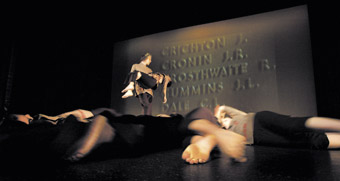
Quantum Leap, Reckless Valour
photo Andrew Campbell
Quantum Leap, Reckless Valour
WHATEVER THEIR EMERGENCY, WARS THE WORLD OVER CONSUME THE VULNERABILITY OF THE YOUNG—HARNESSING THEIR SUSCEPTIBILITY, MARSHALLING THEIR SUGGESTIBILITY, EXHAUSTING THEIR SHEER ENTHUSIASM FOR PARTICIPATING IN WORLD EVENTS. SUCH YOUTHFUL ENERGIES, RENDERED AESTHETIC, ARE ALSO APPARENT WHEN LARGE GROUPS OF YOUNG PEOPLE EMBODY THE WILL OF EMPOWERED ADULTS AND PERFORM WITH UNBOUND ENTHUSIASM FOR APPRECIATIVE FAMILY AND FRIENDS.
This ensemble aesthetic of unassailable pride fuels events like the Schools Spectacular, that apotheosis of the end-of-year concert, staged annually since 1984 with a cast of thousands in the cavernous arena of the Sydney Entertainment Centre, and now broadcast to the nation on ABC TV. Such an aesthetic—suitably cloaked in the drab garb of mutual respect—was also apparent in Reckless Valour, Quantum Leap’s homage to the Australian War Memorial and the nation’s war dead.
Quantum Leap Youth Choreographic Ensemble is an ongoing enterprise of the Australian Choreographic Centre in Canberra. This production from 2005 was made in partnership with the Australian War Memorial and with support from the Department of Veterans’ Affairs through the ‘Saluting their Service’ commemorations program. A revival was presented at the Adelaide Festival Theatre as part of Come Out 2007, South Australia’s biennial arts festival for young people.
Reckless Valour is a well-polished work of propaganda, wearing its production values with pride like so many medals on its chest. Producer Mark Gordon has enlisted a professional production team of 27 artists, administrators and technicians including four choreographers, five composers and a six member film unit. Thirty six young dancers appear in the work, most on stage, some on film.
The dancers—all of whom have come to social consciousness as future citizens in Howard’s Australia—may have contributed ideas, movement strands and stories to the creative process, as artistic director Ruth Osborne notes in the program, but their bodies articulate a discourse on remembering war, national honour and dutiful reflection which does not appear to originate with them. This discourse they perform with the docile conviction of devoted children, but without the authority that arises from creative autonomy.
Modern dance has lent itself to national promotion in the past. Rudolph Laban’s movement choirs, created for the spectacles of mass rallies in Nazi Germany, is an obvious example. Laban’s choral kinaesthetic is recalled in Reckless Valour—in Jodie Farrugia’s segment, Pool of Reflection, in Fiona Malone’s Roll of Honour and, most obviously, in the monumental body-architecture of awe and admiration in Ruth Osborne and Vivienne Rogis’s Hall of Memory.
Dissenting bodies make a brief appearance in Faces of the Enemy, Rowan Marchingo’s deconstruction of Australiana. Marchingo reveals the violence of the heel-and-toe in colonial bush dance, but sardonic references to Vegemite, Drizabones and kangaroos miss their target, overshadowed by the iconography of the unknown soldier, the war-time nurse, the Flanders poppy and the slouch hat which so dominates this work.
Midnight Oil’s Short Memory is used at one point in association with an audio recording of Howard’s announcement to the nation on joining America in the war against Iraq. But the problem here is not that we are short on memory. The work is awash with manufactured memories, drowning us and its performers in a flood of memorialisation. In a time of war and water shortage, when the civic fountains in our towns and cities are running dry, the pool of reflection in the nation’s capital overflows.
In the final segment, “a memorial for the future”, key words project the values of its young performers. Among the words are tolerance, respect, understanding, courage, faith, strength, trust and cautiousness—cautiousness? I am chilled by this.
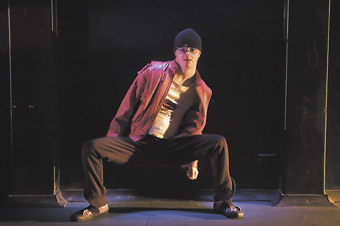
Lorcan Hopper, Restless Dance, Rebel Rebel
photo David Wilson
Lorcan Hopper, Restless Dance, Rebel Rebel
I am thrilled that Rebel Rebel, the new work from Adelaide-based Restless Dance, throws caution to the wind. Presented for Come Out at Norwood’s Odeon Theatre, this is Ingrid Voorendt’s first production as artistic director, though her experience as associate director and creator of five works for the company lends assurance. She describes Rebel Rebel as a rebellion against her previous work.
It has an urban, constructivist, junk yard aesthetic. It is built up from fragments of childhood culture, gruff snatches of music from DJ TRIP, and the frustrations of young bodies bursting out of their skins. It opens with the confusion of torchlight, a wind-up toy in a corner, a Bambi mural on the wall—while twelve young performers are locked up out the back, making a racket, yelling to get out.
As the work unfolds, a booth-sized box, squares of white light and the solid bulk of the theatre’s back wall give structure to a choreography of frustration as bodies perform actions that exceed their containment. Performers are chased, pathways are blocked. Bodies lash out to do their own thing. They try to escape, and get in each other’s way.
Restless Dance works with young performers both with and without a disability. One advantage of this—an advantage as rare in dance as it is in youth arts—is the resistance that the performers and their bodies present to uniform projections of corporeal capacity and the singular imposition of a director’s will.
We see this most clearly when the performers line up downstage as if for a chorus line, that most recognisable choreographic convention for synchronising uniformity. But as the impulse to move runs down the line, each performer responds in a manner as distinctive and unusual as it is authentic to the body moving. Near the end, the performers don headphones and the DJ retires. They dance to their own beat as we watch on in silence.
The sense that these twelve performers are the originators, the initiators, the creative generators of their movement is impressive. Voorendt meets the challenge of directing young people in the performing arts: how to chart an ensemble trajectory of aesthetic education that fosters authenticity of artistic expression. In the choreography of Rebel Rebel, I saw dancers becoming artists for the future. In Reckless Valour, I saw conscripts servicing their elders and the past.
Quantum Leap Youth Choreographic Ensemble, Reckless Valour, Festival Theatre, Adelaide Festival Centre, May 1-12; Restless Dance Company, Rebel Rebel, Odeon Theatre, Adelaide, May 11-19; Come Out 2007
RealTime issue #79 June-July 2007 pg. 29
© Jonathan Bollen; for permission to reproduce apply to realtime@realtimearts.net
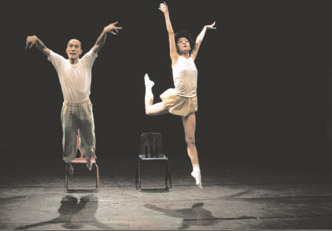
Jareo Osamu, Terada Misako, It Might be Sunny Tomorrow
photo Sete Tele
Jareo Osamu, Terada Misako, It Might be Sunny Tomorrow
AUTOMORPH, A DUET BETWEEN DANCER EMMA STRAPPS AND SOUND ARTIST DEAN LINGUEY WAS FIRST UP IN THE TRIO OF DUETS COMPRISING DYUETTO AT DANCEHOUSE IN MARCH. STRAPPS’ DANCE AESTHETIC SUGGESTS A BUTOH-STYLE OF WORKING. HER MANNER OF MOVEMENT IS VERY CONNECTED TO HER INDIVIDUAL CORPOREALITY, WHICH SHE CLEARLY DRAWS ON TO GENERATE A SINGLE, SUSTAINED PERFORMANCE QUALITY. THIS IS WORK THAT HAS BEEN CREATED FROM THE INSIDE, FROM FEELING RATHER THAN LOOK. THE MOVEMENT ITSELF WAS VERY JOINTED, OPERATING AT THE MEETING-POINT OF BONE AND BONE, EXTENDING TO THE LIMITS OF HER PHYSICAL RANGE. THE EXTREMITIES OF THE LIMB WORK—PARTICULARLY WHERE THE ARM MEETS THE SHOULDER OR THE LEG ENTERS THE HIP SOCKET—CREATED A RATHER NON-HUMAN ENSEMBLE, INSECT-LIKE AND REMINISCENT OF SUE-ELLEN KOHLER AND SANDRA PERRIN’S MEMORABLE BUG (1992).
Strapps created this movement state through a series of inhuman shapes, extending then collapsing them along a slow diagonal. At some point, she reconfigured her costume into a dress in which it was odd to see her moving, almost jarring. I’m not sure how or whether this transition into human form was reflected at the level of movement. After this point, there was a journey across space with an ending in the spotlight. Personally, I would have been happy to stay with the non-human part of the work, to go deeper into its nuances rather than be taken towards a resolution which evaded me. A good deal of investigation underlies Automorph. It will be interesting to see where it goes next.
My initial experience of N_TN_GLD was saturated by the power of its music. Zipper Sky artfully created a repetitive sound, like a car engine which never actually starts. Its effect was to create a series of anticipations: that the sound would progress, that the engine would actually start, alongside a succession of ‘disappointments.’ Against that background, Perth dancers, Sete Tele and Rachel Ogle, each in turn fronted the audience. Tele stood quite close, repeatedly digging into his torso, extracting invisible innards. Ogle’s work was more dancerly, working a kind of emotional communication. N_TN_GLD then became more mobile, more active, in the faster style of contemporary dance, engaging the two in spirals, rolls, twists and turns in and out of the floor. There was for me a slight ‘disconnect’ between the initial offbeat character of the work and its subsequent shift towards what felt like a familiar mode of dancing, a pattern and legacy of choreographic style which is already given. While Ogle in particular looked quite comfortable dancing in this style, I think the intention was to create something more out of the ordinary.
Jareo Osamu and Terada Misako’s It Might be Sunny Tomorrow was the most entertaining piece of the evening. Aside from the humour of the work, these two dancers had a wonderful sense of mutual and differential timing. This was achieved not via duplication or action and response but through an intriguing and subtle sensitivity. The relationship was enacted rather than expressed. They rarely looked at each other, performing mostly task-oriented actions without excessive adornment. Some abstract repetition occurred, for example, a slow leg split by Misako over and around Osamu’s back, but by and large It Might be Sunny Tomorrow evoked a sense of everyday life, of ordinary humans confronting expectations, not always managing to meet them but, at the same time, not necessarily caring. Osamu and Misako were fellow travelers here, collaborators in parody, sometimes dance partners but, more often than not, moving in a relation of difference. This gave a refreshing slant to the idea of duet, that proximity can be maintained without falling into sameness.
Although these three pieces were all duets, they were very differently realized. The connection is in part achieved because three institutions—Dancehouse (Melbourne), Strut (Perth) and Dance Box (Osaka)—are each taking it in turns to host artists from the other two cities. It’s the first season to be presented under the auspices of Dancehouse’s new artistic director, David Tyndall. Although Tyndall rightly acknowledged the work of former director Dianne Reid and recently retired general manager Michael Mitchener in developing this season, Dyuetto stands at the brink of Tyndall’s new curatorial outlook.
Dyuetto (Duet): Automorph, dancer Emma Strapps, sound Dean Linguey; N_TN_GLD, dancers Sete Tele, Rachel Arianne Ogle, music Zipper Sky; It Might be Sunny Tomorrow, dancers Jareo Osamu, Terada Misako; presented by Dancehouse, STRUT Dance, Perth, Dance Box, Osaka; Dancehouse, Melbourne, March 28-April 1
RealTime issue #79 June-July 2007 pg. 30
© Philipa Rothfield; for permission to reproduce apply to realtime@realtimearts.net
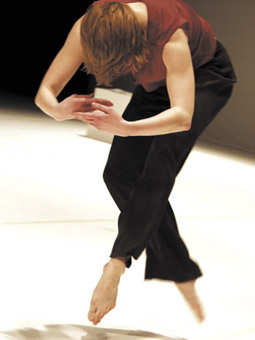
Antje Pfundtner, EigenSinn
photo Iris Terzka
Antje Pfundtner, EigenSinn
EIGENSINN WAS ANTJE PFUNDTNER’S FIRST BIG SUCCESS AND TOURED THROUGHOUT EUROPE AND ASIA. SHE RECALLS A JOURNALIST ASKING HER TO SUMMARISE HER WORK AND HER SINGLE SENTENCE RESPONSE WAS, “WHEN I WAS BORN, I COULDN’T MOVE AT ALL.” PFUNDTNER NOTES IN A CONVERSATION OVER EMAIL, “ THIS SENTENCE SUMS UP MY WORK PERFECTLY. IT HAS AN AUTOBIOGRAHICAL BACKGROUND. IT CONTAINS A STORY, A FAILURE, AND THE WORD ‘MOVE’.” PFUNDTNER PERFORMS THIS SOLO IN JUNE AT SYDNEY OPERA HOUSE’S STUDIO AND MELBOURNE’S ARTS HOUSE.
Pfundtner first visited Australia briefly in 2005, supported by Goethe-Institut Sydney to lead a research project with local artists at Critical Path. Performing excerpts of Eigensinn in an informal workshop setting to illustrate her practice gave rise to the invitation to perform the work in theatres in Melbourne and Sydney.
In our discussion about her return, Pfundtner elaborates on the special place this solo has in her rapidly increasing repertoire. “I made EigenSinn at a time when I was digesting the input I had received as a dancer and artist. I was travelling, working with different people, taking a lot of classes and workshops. The solo form seemed the most suitable way to process all that. EigenSinn is still my most personal work and reflects upon my life…as an artist, a human being, a woman. The main thread is the Brothers Grimm Fairytale, Das Eigensinnige Kind (The Willful Child), in which a girl is punished for developing her will. Nowadays this is the one thing everyone is trying to achieve, especially artists, for whom reflecting upon will and stand-point is crucial. EigenSinn also deals with three other stories from my experience. The first is the most personal, the story of my early inability to move.” (A rare and severe medical condition which Pfundtner overcame as she grew. )
Pfundtner’s work is warmly anticipated by her Australian presenters. Steven Richardson of Arts House writes, “Antje is a fantastically engaging and skilled performer who has a theatrical expressiveness which makes her a compelling, watchable dancer. Importantly, she is unafraid to use dry humour as a part of her performances and I experienced this first hand at her Critical Path residency showing. Hosting international artists is an important part of what Arts House does. International guests are invited into the program partly to provide audiences with an expanded context to the work of local artists, many of whom investigate the themes of self knowledge as Antje does. We are committed to performers who insist on interrogation of practice, culture or thematic concerns…and Antje certainly fits this bill. “
Just as she will give a workshop for professionals in Melbourne in association with Chunky Move and Arts House, Pfundtner will also accompany her Sydney Opera House Studio shows with a second research project at Critical Path. For three days she will work with 14 participants; several of these Sydney based artists were involved in Pfundtner’s original workshop. She writes, “I love it when things continue or leave a trace. With Critical Path I am again presenting my tools for getting to material and choreography in exchange with the participants. The last workshop maintained its own dynamic after I left, which made me very happy. As I heard from the participants, they made a performance night out of that workshop. What more could I ask?”
Since making EigenSinn Pfundnter has created four group works. The first, Selbstinschuld, has the English sub-title “If you can’t fix it—feature it” and is about being trapped in life. She followed this with a quirky piece for the students of her old school. She then created Outlanders with Beijing’s Living Dance Studio, a piece where, “misunderstandings became a form of communication.” Pfundtner’s latest work inDeckung, recently premiered in Germany. Dealing with wishing and wanting, fantasy and absurdity, this piece employs language once more and extends into singing.
Antje Pfundtner hopes that more of her work will be shown in Australia, and if her last voracious engagement with the scene is anything to go by, it seems that she will become a regular visitor.
Antje Pfundtner, EigenSinn, Studio Sydney Opera House, June 14-16, www.sydneyoperahouse.com; Arts House, North Melbourne Town Hall, June 22-24, www.artshouse.com.au
RealTime issue #79 June-July 2007 pg. 30
© Sophie Travers; for permission to reproduce apply to realtime@realtimearts.net
<img src="http://www.realtime.org.au/wp-content/uploads/art/12/1222_bailey_ot.jpg" alt="Katherine Tonkin, Philip McInnes, Luke Ryan,
OT: Chronicles of The Old Testament”>
Katherine Tonkin, Philip McInnes, Luke Ryan,
OT: Chronicles of The Old Testament
photo Jeff Busby
Katherine Tonkin, Philip McInnes, Luke Ryan,
OT: Chronicles of The Old Testament
THERE ARE, BROADLY SPEAKING, TWO SCHOOLS OF THOUGHT WHEN IT COMES TO THE READING OF SACRED TEXTS. THE FIRST IS A LITERALIST OR FUNDAMENTALIST APPROACH, WHICH TREATS A WORK AS A VEHICLE FOR THE TRANSMISSION OF A STABLE SET OF TRUTHS. THE SECOND, THE MODERNIST SCHOOL, EMPHASISES THE ROLE OF INTERPRETATION AS A DYNAMIC, FLUID AFFAIR, IN WHICH EVEN SCRIPTURE IS SEEN TO WORK ON THE LEVEL OF METAPHOR OR ALLEGORY, AND THE ROLE OF THE READER IS TO ARTICULATE MEANINGS TO THE GIVEN WORDS AND IMAGERY.
Two recent productions in Melbourne put these approaches into fascinating and provocative contrast. One took a religious text which forms the foundational myths for several thousand years of history and opened it up to interrogation, teasing it apart in order to question the assumptions that underlie its received wisdom. The other engaged a canonical text in the history of modern theatre but did so with a secular reverence to the transcendent, timeless psychological truths it found therein. Religion, it turns out, doesn’t hold a patent on the sacred.
uncle semolina’s OT
At Malthouse, Uncle Semolina (& Friends) presented OT: Chronicles of the Old Testament, a chaotic, hyper-kinetic rendering of a vast collection of stories drawn from the first half of the Good Book. It re-orders and revises its source material, attentive to the dramatic power of these tales—and they’re nothing if not spectacular—while maintaining a second level of engagement which allows its audience to assess the contradictions and problematic assumptions which underscore them.
Unlike the New Testament, the older tales are those of an ambivalent and at times terrible deity whose relationship with humanity is hardly as the loving father figure later scribes attempted to posit. This is a god who creates, but as often destroys. In OT, Yahweh is the central figure of interest but is presented as much in the form of what literary critics would term a structuring absence. Senile, slumbering, confused and eventually entirely absent, his omnipresence is refigured as a lack—he may be everywhere, but he is equally nowhere.
The work begins with the cardigan-clad, balding Yahweh sleeping on a chair as four performers race through various Testament stories. Their renditions are overtly, perhaps excessively performative, reaching deep into a grab-bag of theatrical tricks and styles, from Commedia-style farce and clowning to mime, video projection and puppetry. The Uncle Semolina style is strongly defined by this thrift-shop aesthetic in which found objects become props, biblical characters in this case played out by action figures and plush toys. When the performers take on roles themselves it is with an equally irreverent spirit: Samson becomes a “hard cunt”, handy with a shotgun, Job a nervous stand-up comic whose bad jokes gradually reveal the terrible treatment he suffered at the hands of a cruel God.
Early in the piece, there are strong hints that these stories are being played out in order to appease that God, who demands entertainment from his creations. At first, they are trying to keep him awake; later, after he begins to withdraw from the stage, they attempt to bring him back by recalling those moments in which they had pleased him. There’s a level of pathos to this reading, which suggests that the scriptures themselves, and our re-reading of them, are not simple descriptions of holy events but active attempts to recover a deity who has forsaken the world, and even whose crueler moments are preferable to his departure.
But even that God’s awful status is problematised as an issue of interpretation—after he wakes, but well before he assumes any kind of autonomous presence, he himself becomes a puppet to his subjects, who animate his limbs and speech in a grotesquely hilarious routine. Perhaps, finally, this is where OT is at its most impious, in offering the possibility that Yahweh is merely a result, and not the cause, of these stories. An effect of the creative spirit, rather than its inspiration.
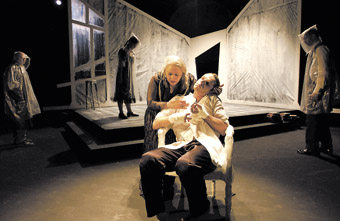
Andrea Swifte, Jay Bowen, Ghosts
photo Deryk McAlpin
Andrea Swifte, Jay Bowen, Ghosts
branch theatre’s ghosts
Branch Theatre Company’s production of Ghosts offers a curious counterpoint. Ibsen’s 1881 play was a shocking number for its day, its themes of incest, religious hypocrisy, sexual degeneracy and suicide a bold challenge to the mores of the period. Moreover, as a work by one of the founding fathers of modernist theatre, it was both a formal and thematic reaction against the comfortable dramas that worked to reassure rather than challenge audiences.
Curious, then, in that this production handles its material with a respectful care that sometimes jars with the more confronting aspects of the work. Certainly, the design of the piece is wonderfully non-naturalistic, a construction of stark, receding lines that form an almost expressionist series of slashes across the playing space. This set, along with the costumes, are all rendered in shades of grey, black and white with the occasional intrusion of striking reds. The ambience created is of a cold other-world, the ideal setting for a family drama revolving around a deceased patriarch whose monstrous legacy grips those he has left behind.
But beyond these elements, Ghosts is a devout and mostly realist attempt to access and purvey the profound interior truths of its characters. Certainly, it is a wonderfully realised and performed production of which Ibsen might well be proud, but its strangeness lies in precisely that fact. If Ibsen, like many of his successors, attempted to find new ways of expressing a psychological realism, these truths no longer appear so fresh a century or so later. Rather, Ghosts’ power is as a kind of riveting drama quite distant from the experiences of its contemporary viewer. It could be updated to add relevance, but I think that would be beside the point. But our very distance from the context of its first production could at least be acknowledged.
What unites both of these mostly successful works is, in the end, a humanist underpinning which seeks to speak directly to a common experience—in one case, by critically questioning the accepted interpretations of a canonical text, in the other by attempting to reaffirm them. That humanism, perhaps, is the ghost that most stubbornly haunts our theatre today.
Uncle Semolina (& Friends), OT: Chronicles of the Old Testament, devised and directed by Christian Leavesley and Phil Rolfe, performers Amelia Best, Philip McInnes, Luke Ryan, Peter Snow, Katherine Tonkin, lighting Paul Jackson, Malthouse Theatre, Melbourne, May 4-27; Henrik Ibsen, Ghosts, director Melanie Beddie, performers Jay Bowen, Ming-Zhu Hii, Bruce Myles, Andrea Swifte, James Wardlaw, design Emily Barrie, lighting Richard Vabre, Branch Theatre Company; Theatreworks, Melbourne, May 4-20
RealTime issue #79 June-July 2007 pg. 31
© John Bailey; for permission to reproduce apply to realtime@realtimearts.net
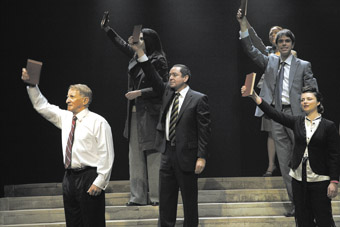
members of the STC Actors Company, The Art of War
photo Tania Kelley
members of the STC Actors Company, The Art of War
IN A NEWLY OPENED CREATIONIST MUSEUM IN THE US, RUN BY A FORMER AUSTRALIAN SCIENCE TEACHER, THERE ARE DINOSAURS ON NOAH’S ARK. ELSEWHERE A BABY ANIMATRONIC T-REX SITS DOWN WITH YOUNG CHILDREN BY A DIORAMA WATERFALL—LIKE THE LION WITH THE LAMB. FAITH IS EVERYTHING IN THIS 6,000 YEAR HISTORY OF THE WORLD, AND THAT FAITH IS BASED ON THE WORD. RECEIVED WISDOM EMBODIED IN BOOKS DOMINATES HUMAN CULTURES. ATHEISTS (DAWKINS, HITCHENS ET AL) NOW VIGOROUSLY CHALLENGE NOT ONLY FUNDAMENTALIST RELIGION BUT THE WHOLE SHEBANG, INCLUDING THE KIND THAT PROPELS THE AUSTRALIAN GOVERNMENT TO FUND THE PLACEMENT OF A CHAPLAIN IN EVERY SCHOOL (PERHAPS HE/SHE SHOULD ALSO RAISE THE COMPULSORY FLAG) AND TO TREAT EVERYONE WITHOUT RELIGIOUS FAITH AS MORALLY DEFICIENT.
At Belvoir St Theatre, Company B performs UK playwright Howard Brenton’s Paul, about one of the authors of the New Testament, while at Malthouse Uncle Semolina (& friends) present OT (for Old Testament; see page 31) and the Sydney Theatre Company realises visiting playwright Stephen Jeffrey’s The Art of War, based on the two and half thousand-year-old Sun Tzu classic, used also as a manual for strategies in business and sport.
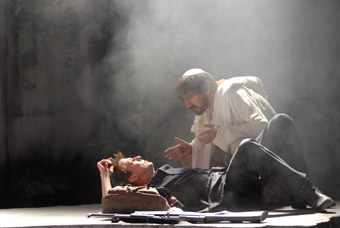
Company B, Paul
paul
In Brenton’s Paul, the proselytising saint (played by Robert Menzies) is depicted as wild-eyed, his head thrust forward, arms waving, movements discombobulated, every word an urgent thrust, a declaration of the man’s ineptness as a rhetorician. He’s an epileptic visionary (falling down often, not just the critical once), temporarily blinded by a vision of Christ that converts him from official persecutor of the new Christian sect to become one of its leaders, travelling the empire, spreading the word, establishing churches. In Brenton’s version of the life, Paul’s struggle is pragmatic, challenging recidivists clinging to Jewish custom (diet, circumcision etc) when he knows that the Christian creed will only spread if it tolerates the everyday habits of gentiles. But there is a greater challenge—Paul’s companions are uncertain of the miracle that has liberated him—is he simply ill; worse, some know that it was no miracle, Christ is alive and in hiding. Brenton opens out the narrow New Testament narrative, incorporating apocrypha like Christ’s marriage to an intelligent and cynical Mary Magdalene, along with references to the popular competing creed of Mithras, the bull god. Paul has to face the fact of a living Christ and not in the sense that he had hoped. But having travelled so far he is consumed by his own belief and passionately convinces his followers to take it up—their faith is a fiction but, as Paul sees it, a necessary one.
Wesley Enoch’s direction of this essay-as-play is straightforward, the performances suitably tough and tense, and the handling of the shifting time structure (offering something in the way of suspenseful propulsion) deftly handled. The war-torn setting, armed soldiers in 21st century garb and the grim prison camp scenes all evoke the Middle-East as it is now, although it’s a broad brush analogy, a conceit that is not really through-produced. What I found profoundly dissatisfying was the play itself. It’s extremely difficult to match the character as written and played with the Paul who so profoundly shaped the emergence of Christianity not simply as fervent missionary but as literary genius—cleverly melding Jewish, Greek and Roman epistolary formulae in the Epistles (“telegraphic sermons” one writer called them) that not only implicated his far-flung readers in the drama of imagined dialogues on morality and belief but mimicked the authority of empire.
This was the man who fused pagan, Christian and Greek philosophies into a workable whole for the Greco-Roman culture of the Roman Empire, who above all synthesised Platonism and a new creed into the Christianity we now know with its opposed worlds of flesh and spirit founded on the inherent imperfection, recast as original sin, of humankind. We see the driven visionary (the day of judgment is always nigh), glimpse the seductive poet and, occasionally, the wit: “You can’t build a religion by piling up foreskins.” Brenton is peculiarly restrained (“god fucked [Mary] in the ear” is a rare exception) although his portrayal of a Nero (Jonathan Hardy) who can see what’s coming (he has to execute Peter and Paul but knows that martyrdom will be the first step towards a new state) has some of the old Brenton bite. Like plays or films with artists as their subject where the art barely gets a look in, this play inclines to one dimension (faith overriding the facts in the wedding of vision and pragmatism), neglecting the man’s art and the range of his ideas. Of course, there’s a limit to what you can expect from a couple of hours of stage time, but it would have been interesting to see more of the dynamic between the man’s passion and his intelligence.
OT: chronicles of the old testament
OT, by Uncle Semolina (& friends), revealed a young Melbourne company in fine ensemble fettle using every lo-grade theatrical device in the book to remind us, as Brenton’s Paul does, that God is an invention of humans pretty much in their own image (here a distant, sleepy cardiganed old guy), but a construct that can get right out of hand. What begins as a series of skit-like re-tellings of Bible tales in no apparent order and desperately short on punchlines improves as we realise we are heading towards the moment of creation rather than away from it, and when the writers entwine stories in order to drive home issues of power, gender and faith with increasing irony, thus rescuing the whole from the sense of an undergrad atheist trip. The darker it gets, the funnier.
the art of war
In The Art of War, Stephen Jeffreys takes a classic Chinese text and applies it to the earliest stages of the war in Iraq, to business and personal relationships. While audiences doubtless know enough of their Bible to engage comfortably with Paul and OT, Jeffreys is faced with the challenge of filling us in on one-time general Sun Tzu’s epigrammatic thoughts. The cast, therefore, becomes a chorus (invoking another ancient practice) chanting from copies of The Art of War (bound in red and evoking yet another influential Chinese volume) and then, in the first scene, transform into the staff of a company being introduced to Sun Tzu’s wisdom via a motivational speaker. The book thus becomes a framework for and the subject of the drama. Throughout, the chorus in part or whole comments on the action, be it a business venture into modern China, heterosexual friction (complicated by various moral issues) or war (the inept handling of the invasion of Iraq: “There is no instance of a country having benefited from prolonged warfare”, writes Sun Tzu). In the case of General Garrett (Colin Moody) and journalist Crystal (Pamela Rabe), the most fully realised of the three couples, waging and reporting the same war and managing a mid-life romance crystallise the play’s alarming ethical complexities.
But as drama, there’s a plodding insistency to the choral device that, once established, is wearying along with a certain obviousness to the Iraq war material, and too many of Jeffreys’ characters are bland—although the members of the Actors Company all adroitly compensate. There are two notable exceptions in the writing. First there’s Jessica, finely realised by Amber MacMahon revealing the tunnel-vision intelligence of a woman seduced by the Sun Tzu ethic and its teacher, whom she stalks. Her disappointment that the Sun Tzu ethic cannot be lived as a totality turns her pyromaniac—in a magical moment the chorus open their books and they burst into flame. The other idiosyncratic character is Brian—Peter Carroll as an older businessman usurped by a new generation of reckless pragmatists. Apparently slow witted (Carroll’s restrained delivery is masterful) he wreaks vengeance with glee, having deftly deployed the deception recommended by Sun Tzu. It’s a moral victory, even if criminal. Once again the strength of the STC Actors Company is fully evident, doing more than justice to Jeffreys’ script with vocal and physical verve and an ensemble ease of playing.
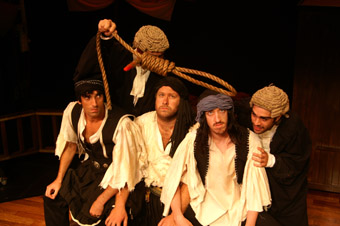
Sidetrack, Seven Pirates
seven pirates
Sidetrack’s Seven Pirates is a great antidote to the Pirates of the Caribbean movies, offering facts, politics and an Australian connection, as well as fun, in the telling of the story of some none too murderous Greek pirates in 1827 who seize the British merchant-brig Alceste with its load of tin plate. All of this is complicated by occurring in the middle of the war between Greece and the Ottoman Empire with Britain looking to assert its authority in the region and coming down strongly on pirates. Here was an opportunity to set an example by hanging the seven young Greek offenders (who claimed they were seizing cargo destined for Ottoman Alexandria).
Writer-director Don Mamouney frames the tale as a courtroom drama with action-packed reconstructions (boardings, sword fights, stunts, singing and belly dancing) set against epic video sea and sky-scapes and with much suspense (first hanging looms, then life sentences, then transportation to Botany Bay in 1829). Above all, writer and performers excel in their hilarious handling of varieties of English (including Maltese, Sicilian, French and Spanish) in the courtoom, climaxing in the meeting between a fantasist George III (who commutes the sentences) and the pirates’ dedicated Maltese defense lawyer. Adam Hatzimanolis as the pirate captain, Manolis, brings gruff humour and authority to his role (the character warrants more room in the first act to anchor the play) and all of the performers display great versatility, not least in their rapid role-changing. Seven Pirates is a joyful piece of historicising giving life to an incident and people we know little or nothing of—the word here has opened up awareness, not foreclosed it with legal, moral or tactical strictures.
Company B, Paul, writer Howard Brenton, director Wesley Enoch, performers Robert Menzies, Paula Arundell, Ewen Leslie, Jonathan Hardy, James Evans, Graham Rouse, Hazen Shammas, Jason Klarwein, Steve le Marquand; Belvoir St Theatre, Sydney, opened May 2; Uncle Semolina (& Friends), OT: Chronicles of the Old Testament, Malthouse, Melbourne (see page 31); Sydney Theatre Company, The Art of War, writer Stephen Jeffreys, director Annabel Arden, performers STC Actors Company, set Robert Cousins, costumes Tess Schofield, lighting Damien Cooper, sound Max Lyandvert; STC, Wharf 1, Sydney, opened May 19; Sidetrack, Seven Pirates, writer, director Don Mamouney, performers Adam Hatzimanolis, Alex Blias, Ben Adam, Ben Wood, Chris Pickard, Jason Stojanovski, Russell Smith, video Assad Abdi, lighting Jocelyn Speight, costumes Sue Liolio; Riverside Theatre, Parramatta, April 11-22
RealTime issue #79 June-July 2007 pg. 33
© Keith Gallasch; for permission to reproduce apply to realtime@realtimearts.net
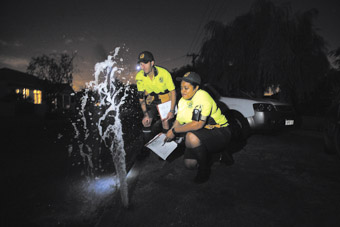
PVI, Inform
photo Bodan Warchomij
PVI, Inform
PERTH-BASED ARTS COLLECTIVE PVI HAVE JUST MOVED INTO A FORMER SCHOOL TO ESTABLISH THE CENTRE FOR INTERDISCIPLINARY ARTS (CIA). BETWEEN ORGANISING THE LAUNCH OF THIS NEW ARTIST-SUPPORT INSTITUTION, ARTISTIC DIRECTORS KELLI MCCLUSKEY AND STEVE BULL ARE PREPARING PVI’S LATEST PERFORMANCE PROJECT, INFORM. IT’S PLANNED TO BE AN UNSETTLING ROAD TRIP INTO THE SUBURBS OF PERTH TO CHART THE DISSIPATION OF A SENSE OF COMMUNITY AND THE ALIENATING SUSPICION WHICH HAS SPREAD OUTWARD FROM THE METROPOLITAN CENTRES OF GOVERNMENT.
Spectators for Inform will assemble at the Perth Institute for Contemporary Art before following the so-called Loyal Citizens Unit (LCU) as they drive into the suburban hinterland in search of minor criminals and social infractions to identify and halt. “I love this idea of a convoy of 15 cars driving into the suburbs”, Bull enthuses, “and the pressure of not losing the car in front of you.” Audiences travel in their own vehicles and tune in to the LCUs’ radio broadcast to listen to a soundscape by Jason Sweeney. Meanwhile live dialogue is picked up by radio microphone while the LCUs doorknock members of the public and ask for their help in catching offenders.
PVI are committed to directly engaging the audience in the events they manage. As McClusky explains, they are currently working on strategies that deal with questions such as “what can you do in your car? How can you assist what we’re doing—and how can we be inclusive?” Although Bull notes this will include some classic options such as “flashing the headlights, honking the horn—once for yes, twice for no!”, they are nevertheless keen to move beyond such simple relations.
Inform is a sequel to PVI’s 2006 show, Reform, which had the LCUs taking audiences on a walking tour of one of Perth’s busier urban areas, between nightclubs and restaurants, engaging both real members of the public and performers masquerading as bystanders, to issue infraction notices for everything from jaywalking to standing still while being dressed provocatively and carrying a condom in one’s purse (which can be legally inferred to be soliciting). Reform was an interesting work, but slightly naff in its execution, while Inform is likely to have a more sinister and ambiguous, eerie ambience, depending as it does on the audience’s sense of both engagement (being part of the convoy and hearing the speech of the LCUs) and distancing (the car turned into a kind of cinema space or radio play venue where spectators observe and listen to actions from behind a glass window).
As McClusky explains, audience “visual awareness will be restricted. A lot of the doorknocking they will be able to hear, but they won’t be able to see. It’s a very different treatment. So we started work with sound artist Jason Sweeney earlier for this piece. We want to give a lot more breathing space to the sounds this time around. It felt like the sound acted as an accompaniment to the dialogue in Reform, whereas this time that may flip at times and the sound will dominate.” Inform thus relies more strongly on the ambivalent pleasures of voyeurism and surveillance than the earlier spectatorial model, in which audiences generally maintained clear sightlines on the activities of the LCUs and had little beyond the streetscape itself to divide their attention.
Another interesting development in the progression from Reform to Inform is that whereas the LCUs in the former work predominantly came across with a sinister, invasive, paralegal or police-like association, in Inform one’s sympathies are more likely to be conflicted over the merit of the LCUs’ actions. In the suburbs, the LCUs will be on the lookout for such commonplace annoyances as “dog fouling, illegal parking, water cheats, and so on.” Especially with respect to responsible water usage, these are issues which increasingly galvanise householders with both left and right-wing sensibilities, determining to what extent such actions should be tolerated within the community. It will be hard not to empathise with someone finally punishing that bastard from two doors down responsible for dog shit on your verge every morning. Unlike the urban policing of Reform—the very title of the show suggesting an exterior, repressive force acting upon a recalcitrant subject—in this new scenario, one enters a suburban world where individuals are increasingly happy to self-regulate and prosecute.
Bull extrapolates: “We’re very interested in how communities are now policing themselves and with the mechanisms which are put in place to do that. There is a culture of dobbing now in Australia. The issues have overtaken mateship. Although it hasn’t quite hit here in Perth, with things like water wasting over east in Sydney, Brisbane or Melbourne, if someone misuses water, they’re going to be reported. Even if they’re not guilty and they have a tank in the back garden!” McClusky adds, “You hear reports of people having to put up signs saying they’re not wasting water so as to avoid prosecution.”
It is precisely this constellation of issues which lies at the heart of Inform—and indeed the PVI project as a whole. McClusky notes that the company is “tapping into those little niggly things in human behaviour that would drive you to respond a certain way. In the research we did for Reform, we came across all of these dob-in phenomena. There’s an organisation called Whistleblowers Australia. With the tests that we’ve done for Inform, the people in their homes are extremely welcoming. They invite you in and make you a cup of tea—and then proceed to slag off their neighbour!” The issue then is when does the vigilance of one’s neighbour become a sign of social dysfunction, and when is it a badge of responsible community behaviour? In 21st century Australia, we need, more and more, to determine whether we have become paralysed and hateful at the prospect of threats to us and our homes, or have finally found a way to generate a caring, cohesive community. Where better to highlight this issue than in a city all but defined by the car and the suburb?
PVI, Inform, Perth suburbs (departing PICA), June 20-30, www.pvicollective.com, www.ciastudios.com.au
RealTime issue #79 June-July 2007 pg. 32
© Jonathan Marshall; for permission to reproduce apply to realtime@realtimearts.net
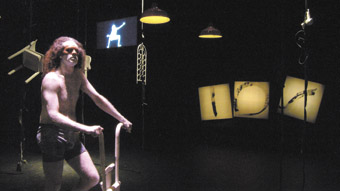
Zane Saunders, Being a Medium
photo Nicholas Mills
Zane Saunders, Being a Medium
ZANE SAUNDERS’ WORK SPRINGS FROM A SUBSTANTIAL VISUAL ARTS PRACTICE EMBEDDED IN FAR NORTH QUEENSLAND. HIS LATEST WORK, BEING A MEDIUM, IS PART OF AN ONGOING COLLABORATION WITH SOUND ARTIST FILE_ERROR (AKA NICHOLAS MILLS) ENGAGING WITH CULTURAL, SPIRITUAL AND SOCIAL CONCERNS WITH AN UNDERLAY OF RITUAL AND HUMOUR. BEING A MEDIUM SITS IN THE SPACE BETWEEN INSTALLATION AND PERFORMANCE, ENTERTAINMENT AND OBSERVATION, BODY AND OBJECT.
More accustomed to the white box gallery, this is Saunders’ first foray into the world of the theatrical black box. Spurred on by his flirtation with sonic interplay, the collaboration with File_Error has produced a lineage of short works. This latest piece was developed at the JUTE Theatre Centre of Contemporary Art in Cairns as a full-length work.
Enter a dark space. Saunders is clothed. He peels off, hanging up his shirt and trousers on a tall hat rack to reveal a completely painted form. He’s a commanding presence, painted white with a stripe of brown over his eyes, hair long and flowing. His towering form crouches till he’s eye-level with his audience. He weaves a ritualised procession from one installation to the next, his body bobbing, swaying and creeping to its unique tempo.
File_Error’s mix of sonic textures is rhythmic yet unsettling. Erks, squeaks and groans drive Saunders on. And then there is silence, his own and from sound departed. This crafted intermittence allows time for the viewer to reflect.
Illumination of a series of white installations sees Saunders interact and move through a collection of thoughts and feelings, amplified by carefully chosen objects but whose assembly appears random. A mangrove of black bungy cords suspends twenty four white man-made objects in varying degrees of repair: a couple of guitars, a miniature rubber figurine, a distinctive collection of chairs…The sense is of Saunders revealing an examined world full of objects familiar to him, and yet to the viewer, unknowable.
The residue of previous performance works informs Being a Medium. Three monitors of varying size emit sound and video. The largest projects white noise, or is it the internal workings of Saunders’ mind? The other two display edited documentation: one shows the performer’s back hovering over a spiral brick installation with a text message, “unlearn”; and in the other he’s wearing a suit jacket, lampshade head-wear and holding a light bulb, with the text “it was all too easy… consume.” The glitchy, looping messages suggest a certain urgency.
It’s a chairless environment. The audience—some unfamiliar with this kind of work—dance around the installations. Children scurry to position themselves, they want to be close to the action, but recoil when illuminated.
Saunders recycles pre-loved items and trash from the tip as dynamic craft. He is the medium in the moment, creating animated imagery through media integration. On two large canvases opposite each other are duplicate projections of Saunders warping, looping, shifting, re-focusing time. Three more canvases on the wall are treated with a flow of black paint from a dustpan brush. It’s immediate. Saunders glides by a speaker stack with its arhythmically throbbing neon light and punchy sound and it becomes a miniature urban sprawl. He tenderly massages plants in a cot, connecting with the natural environment.
I have been aware of Zane Saunders’ interest in performance for over a decade, and in the last few years I have observed his practice unfold into new territory. His interventions are evolving a kinetic momentum, which extends the object and installation. We witness a dance on an ageing treadmill, Saunders moving like a cross-country skier, his striding rise and fall implying an endless journey or walkabout.
His body is part of a living, breathing culture, not found in the museum of objects. Within the cultural protocol politic that Indigenous artists face, Zane Saunders is finding a language for the space between the contemporary and tradition through a deeply personal spiritual and physical journey. This is no mean feat considering prohibitive costs and the fledgling presence of performance and media practice in the region. Put that together with the lack of Indigenous live art role models and you have the enigmatic space between called Zane Saunders.
Image: Zane Saunders, Being a Medium, photo Nicholas Mills
Being a Medium, Zane Saunders, File_Error (aka Nicholas Mills), JUTE Theatre Centre of Contemporary Art, Cairns March 30, 31
RealTime issue #79 June-July 2007 pg. 34
© Rebecca Youdell; for permission to reproduce apply to realtime@realtimearts.net
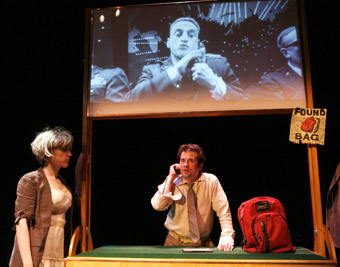
Maggie Hoffman, Steve Cuiffo, Major Bang, SOH
THE SYDNEY OPERA HOUSE’S ADVENTURES O7 IS THE SUCCESSOR TO 2006’S ADVENTURES IN THE DARK, THE BEST OF WHICH INCLUDED THE NETHERLANDS-BASED DANCE COMPANY, EMIO GRECO|PC AND TWO IMPRESSIVE AUSTRALIAN WORKS: NIGEL JAMIESON’S HONOUR BOUND (SOON TO TOUR TO EUROPE) AND BRIAN LIPSON’S A SMALL ATTENDANCE IN THE ANTECHAMBER. THIS YEAR’S ADVENTURES ARE ALL FROM OFF-SHORE AND INCLUDE THE ENTICING FUTURE TENSE AND BIG BANG, WORKS ABOUT CURRENT ANXIETIES AND PROBABLE HORRORS.
An eclectic Adentures 07 comprises “visiting international festival highlights.” It commenced with Cloudgate’s Wild Cursive in May and concludes at the end of the year with Peter Brook’s rendition of Athol Fugard’s gripping Apartheid-era drama, Sizwe Banzi is Dead, with actors from Mali and the Congo. In C-90, British stand-up comic Daniel Kitson is Henry, an archive worker who discovers new dimensions to life from a musicassette. A dance double bill, Future Tense, from Canadian choreographer Andre Gringas (CYP17, about future freaks) and France’s Pierre Rigal (Erection, tracing our evolution into techno beings), pairs dancers with projections.
Major Bang: or How I Learned to Stop Worrying and Love the Dirty Bomb, is the show RealTime readers will be eagerly anticipating. New York’s Foundry Theatre looks back to the future through, among others, the eyes and ears of Dr Strangelove and Lenny Bruce (riffing “upon the surreal semantics of the words, ‘war on terror’“). Written by Kirk Lynn, directed by Paul Lazar and performed by actor-magician and Wooster Group artistic associate Steve Cuiffo and Radiohole co-founder Maggie Hoffman, the work was described by the New York Times as “surely the happiest show to have been inspired by the horrors of 9/11.” RT
Foundry Theatre, Major Bang, Adventures 07; Playhouse, Sydney Opera House, July 17-29, www.sydneyoperahouse.com
RealTime issue #79 June-July 2007 pg. 35
© RealTime ; for permission to reproduce apply to realtime@realtimearts.net
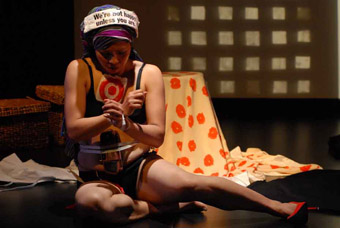
Valerie Berry, The Folding Wife
photo Heidrun Löhr
Valerie Berry, The Folding Wife
A DARK HAIRED WOMAN STANDS ON THE POLISHED FLOORBOARDS IN THE CENTRE OF THE NEW BLACKTOWN ARTS CENTRE PERFORMANCE SPACE. MUSIC PLAYS—NOSTALGIC MUSIC OF A FORMER TIME. THE WOMAN, VALERIE BERRY, UNDRESSES TO HER BLACK UNDERWEAR. TWO MEN APPEAR AND WITH THE FINESSE OF PUPPETEERS, BEGIN A LONG SLOW COSTUME COLLAGE.
They dress, drape and fold yards of fabric and clothing around the woman, morphing one costume into another—a peasant becomes a woman of class becomes a revolutionary becomes a political prisoner about to be executed. A machine gun strapped to a thigh, a radio spewing forth crackly sound is tied around her waist and her feet are forced into red high heels. Shoes, shoes and more shoes. We are in Imelda territory.
Paschal Daantos Berry and Valerie Berry, Australian artists, also siblings, born in the Philippines, first discussed a collaboration based on their shared history in 2002. Teaming up with Anino Shadow Play Collective from the Philippines, director Deborah Pollard and Urban Theatre Projects, they have produced a fine new performance work of biographical fiction called The Folding Wife.
Datu Arellano and Andrew Cruz, members of Anino Shadow Play and the men who have transformed Berry in chapter one, return to their workstation. As Valerie begins chapter two, they squat on the floor by an overhead projector and laptop and throw exquisite imagery onto the back wall. Like painters playing with liquid light, colour and form, they create the visual sensuality and texture of memory so powerfully evoked in the text by writer Paschal.
All I have is the view from this window. I have seen the century through this frame, seen them come and go…Our women have always been here sitting by the shadows waiting for new opportunities. Waiting for wars to finish…We can feign happiness with enough practice; it is in our blood, that’s how you become resilient—by bending and folding into recognisable shapes.
Valerie Berry’s impressively portrayed characters fold into one another through a non-chronological telling of chapters. Chapter two followed by chapter eleven, then by chapter five and so on. We meet Grandmother Clara, Mother Dolores and daughter Grace. We feel the heat and torpor of their lives as regimes and curfews come and go. It is a story of waiting: “…waiting for wars to finish. For our men to come home…” or a school child waiting for hours in the hot sun by the side of the road for a glimpse of Imelda Marcos, who never comes.
More ingenious shoe routines, and flags of different nations that spew forth from Berry’s mouth. Grandmother Clara pines for her Spanish past while urging her daughter Dolores to escape to America. Her advice: “If you have the misfortune to marry one of ours, always be a step ahead. Get to know the queridas (mistresses) and make their life a living hell.”
Dolores meets an Australian saviour instead: Arthur, who brings Dolores and daughter Grace, to a new land. “We are two, stepping off the Greyhound bus, wondering if the dust will ever settle. It is silent here. But if you prick up your ears you can hear blowflies.”
The atmosphere changes but loses none of its power. Dry yellows and sandy browns fill the screen as Grace describes arriving in a cultural desert. And yet in this barren place she blossoms and blooms. Here among the “rough and golden boys licking plates, cheeks varnished from lamb fat and tomato sauce, smelling of lanolin from the wool”, she becomes a woman, declaring, “I will never fold, I will never fold, I will never fold into my self.”
The length of gestation of the work and collaborative care director Deborah Pollard and team (including lighting designer Neil Simpson, production manager Alexander Dick and members of Anino) have given in creative development and production have yielded a delicious fruit. Sweet, sour, bitter—all the tastes of memory are present in this powerful work. The audience is left with sensual impressions of lace and blood, laughter and sorrow, “roasted corn on Sundays, coloured parasols reflecting the white heat of the sun” and a heritage of women, strong, beautiful and dignified, who have survived on memories of a glorious past or a projected future as they bent and folded into themselves a nation’s pain.
–
Urban Theatre Projects & Blacktown Arts Centre, The Folding Wife, performer Valerie Berry, writer Paschal Daantos Berry, director Deborah Pollard, design, multimedia Anino Shadowplay Collective, lighting Neil Simpson; Blacktown Arts Centre, Western Sydney, April 19-28
RealTime issue #79 June-July 2007 pg. 35
© Jan Cornall; for permission to reproduce apply to realtime@realtimearts.net
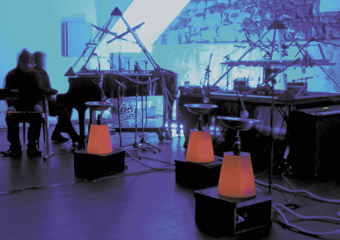
Jay Eusden, James Hullick, Cranky Robotics
photo Matt Murphy and James Hullick
Jay Eusden, James Hullick, Cranky Robotics
THERE ARE STRANGE NOISES EMANATING FROM THE STONE WALLED BASEMENT THEATRE OF THE FOOTSCRAY COMMUNITY ARTS CENTRE, PRODUCED BY AN ENIGMATIC ORDER SEATED IN HIGH-BACKED THRONES, GARBED IN HOODED BLACK JERSEY AND WIELDING MYSTIC POWERS OVER PRETERNATURAL CONTRAPTIONS. ENTER THE REALM OF JAMES HULLICK AND THE AMPLIFIED ELEPHANTS.
The Amplified Elephants have grown out of sound art classes run by Hullick for the ArtLife program which provides opportunities for people with perceived disabilities to experience a variety of artistic practices. Along with the Elephants, Hullick has invited instrument engineer Richie Allen and percussionist Eugene Ughetti to help bring the Cranky Robots to life.
The sound welcoming us into the space is a low machinic drone, like an insistent generator, shifting subtly through tones. Hullick and Liz Hofbauer approach the hitherto unattended mixing desk and start to tune the noise, releasing it to run wild, then catching and taming it, a tug-of-war between human and feedback revealing hypnotic drifting microtonal layers.
Hard on the heels of the sculpted onslaught, Enza Practico enters the space with wind chimes—the simplicity of action and sound working as an aural palate cleanser preparing us for the subtlety of Hullick, Ughetti and Jay Eusden’s study for microphones. Using feedback and effects, whistling, tapping and rubbing, the artists explore texture, surface and the tactility of the microphone, re-inventing it as a responsive poetic instrument, rather than a blunt tool.
These early pieces serve well as preludes to the Cranky Robots, defining an exploratory space where the behaviour of instruments is under serious scrutiny. The next piece, Secret Joy in the Wish Fulfilment of Love uses Whirling Dervishes—instruments made from a spinning metal bowl with a marble inside, activated by an adapted power drill mechanism. The sustained metallic resonance provides the bed for percussive exploration led by Ughetti. The piece, while subject to chance elements—like the marble flying out of the bowl and across the floor—is tightly structured, with Hullick conducting the action, teasing out pleasing layers from metallic drones and vibrations.
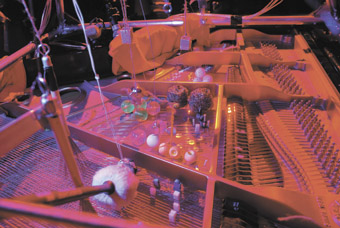
Cranky Robotics, prepared piano
photo Matt Murphy and James Hullick
Cranky Robotics, prepared piano
Particularly intriguing is the Pranky-Ano. Designed to annoy the ‘prima donna’ piano, this pyramidal structure is placed over the strings of the piano with a series of percussive objects strung from levers. Activated from a midi-keyboard, the levers—reminiscent of a giant old typewriter—lift and drop objects onto the strings. At the same time Hullick plays the piano creating delicate gamelan tones, rudely interrupted by percussive agitations. Together the artists and machines become the ultimate prepared piano, a kind of Cagean-cyborg.
The Pranky-Ano developed from the Crank-A-Maphone which, strung like a monster mobile with wind-chimes, wooden boxes, bowls and other resonant junk, has a percussive focus. It too is midi-activated for this concert, which allows each of the Amplified Elephants to play a section in the final work. The piece is tightly structured around sections of Cranka-A-Maphone semi-random cacophony, and the quieter explorations of Ughetti on percussion, the clarity of sounds creating a kind of acoustic pixelation.
Along with the ingenuity and engineering of the machines, Cranky Robotics was impressive in the attention to structure within each piece, utilising every artist’s ability and expression to its optimum and finding a fine balance between control and chaos. The imperfection and unpredictability of the machines offered challenges but also freedoms within compositional process as did the various abilities of the artists defining an intriguing space for exploration—a space for serious play and gentle provocation in which every action is guided by a genuine desire to engage, express and work together to create a little bit of magic.
Cranky Robotics (Jolt Concert 1), director, sound designer James Hullick, percussionist Eugene Ughetti, instrument engineer Richie Allen, Amplified Elephants June Bentley, Jay Eusden, Liz Hofbauer, Robyn McGrath, Enza Practico, lighting Geordie Barker; Footscray Community Arts Centre, Melbourne, May 6
The Jolt concert series continues June 24 with Ernie Althoff, Robin Fox and James Hullick and July 22 with Hullick, Fox, Philip Samartzis and Myles Mumford; bookings Span Community House 9480 1364
RealTime issue #79 June-July 2007 pg.
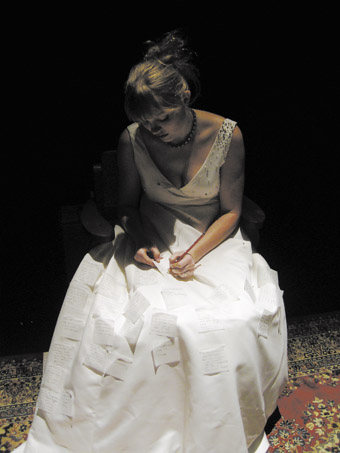
Rebecca Cunningham, Chambers
photo Rachel Cobcroft
Rebecca Cunningham, Chambers
CHAMBERS IS THE THIRD IN A SERIES OF EXPERIMENTAL HAPPENINGS ORGANISED BY THE ADVENTUROUS BRISBANE BASED CURATOR/ARTIST REBECCA CUNNINGHAM, EACH OF WHICH HAs SET CONTEMPORARY PERFORMANCE AND SONIC ART AGAINST AND WITHIN CAREFULLY DESIGNED CONSTRUCTS OF INTERVENTION, CHANCE, MULTIPLICITY, IMPROVISATION AND INTERACTION.
Musicircus in 2004 (RT 65, p43) emanated from Cunningham’s deep fascination with the music and philosophy of John Cage. Flux-US in 2006 similarly paid homage to avant-garde tradition, this time extending the scope further beyond sound into intermedia performance. Both shows hinged on often problematic processes of re-enactment, an especially difficult proposition when it comes to highly contextualised radical work. The results can be confusing and amusing; for instance, the classic piano chainsawing act in Flux-US was in reality a fairly tame gesture, but still garnered some requisite notoriety via an unintentionally hilarious piece of sensationalist tabloid moralising in Brisbane’s Courier Mail.
Chambers is Cunningham’s first event to shed the cover of historical precedent and focus exclusively on new work. It’s also the most controlled and exploratory event, structurally and spatially. In six discrete chambers, partitioned by heavy black curtains, six works take place simultaneously, with the audience free to circulate and interact in any manner. The only element formally common to all the works is the set of headphones required to enter each chamber’s distinct sound world.
Chamber 1: Alicia Jones
We enter a dimly lit backstage dressing room. Assorted costumes are hung on a theatre rack. An actress studies herself in a mirror, tries on this and that, and paces the space in dissatisfaction. The transient audience voyeuristically observes the self-consciously awkward nature of these physical transformations. Later I return to the scene: chaotically chopped hair tufts, a circle of bones, a sense of something magical occurring. I have no idea what has happened in the interim.
Chamber 2: Rebecca Cunningham
A video projection of blurred lights, a cityscape gushing smoke, flickering or shivering. This is a disaster scene, familiar enough to anyone who consumes such dystopian news images on a daily basis. Which city is this—could it be any city? This is a chamber without a performer. Empty. The detached, distant, almost anti-social atmosphere is both unsettling and somewhat of a relief.
Chamber 3: Jan Baker-Finch
An intensely focused hobo dancer is dressed in black garbage bags. Chalk-rendered memories or fantasies (in fact, three brief extracts from Samuel Beckett’s Worstward Ho) are scrawled along the floor. A grid of rabbit-shaped plastic moulds forms a wall. We hear the sound of the garbage bags swishing and rubbing, a melancholy sound that intensifies the schizophrenic intrigue of the scene. Inside the headphones, entrancing hypnotic piano pieces (compositions by Philip Glass) begin to generate a total perceptual transformation. In a place of unknowable dysfunction we clearly recognise a synchronous dance to the rhythm of death, loss and perhaps most pervasively, hope.
Chamber 4: Robin Fox
The silent flickering green lasers of classic science fiction. Without sound the eyes are free to absorb even more movement and scope within the impossibly complex and inventive shower of light beams transforming the space. Fox demonstrates the control he has over this stimulating process, creating morphing pulsating concentric circles of light which wrap around the bodies of those who enter, enclosing them in a translucent glowing capsule. Inside the headphones sound and image are re-united, the overarching synaesthetic structure of the contraption revealed.
Chamber 5: Richelle Spence
A pseudo-religious ritual of scrolls, candles, and symbolic costume, presided over incongruously by a power-suited woman, who occasionally breaks into a morose lament for something lost or absent. This spectacle sits uneasily between the private and public: are we voyeurs or participants? Headphones play the tweeting birds of the summer countryside. Later I return to find the performer with fingers spread, a prosthetic glove set alight at the tips. I read a scroll: “something we were withholding made us weak, until we realised it was ourselves.”
Chamber 6: Rebecca Cunningham
A room divided by displaced rolls of heavy grass on one side and scattered rocks on the other. A woman sits silently in a wedding dress; she inhabits this space as an object, but the space also feels constructed out of her ‘memories’—real or imagined? ‘Family history’ snapshots are pinned to a board made of wine corks. Snippets of incidental conversation and ‘forgotten’ pop music play inside the headphones. This ‘memory room’ is perpetually strung between poles, suspended in a unique tension. Social/isolated. Childhood/adulthood. Silent/sonic. Memory/artifact.
Chambers, curator Rebecca Cunningham; Judith Wright Centre of Contemporary Arts, Brisbane, March 5
RealTime issue #79 June-July 2007 pg. 36
© Joel Stern; for permission to reproduce apply to realtime@realtimearts.net
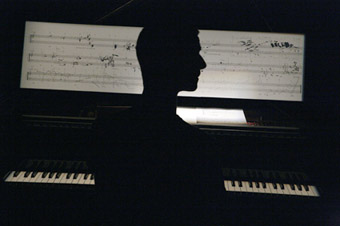
Mark Knoop, Val Camonica
photo Yatzek
Mark Knoop, Val Camonica
COMPOSER DAVID YOUNG HAS A PENCHANT FOR CREATING MULTIMEDIA WORKS INSPIRED BY INTERESTING LOCATIONS. SCALE WAS INSPIRED BY A DISUSED PUBLIC SWIMMING POOL IN BRUSSELS AND THOUSANDS OF BUNDLED STRAW BY A BUDDHIST MONASTERY IN JAPAN.
Aphids’ new work concerns Val Camonica, a valley in the northern Italian Alps, where thousands of rock carvings dating from 3,000 to 8,000 years ago record the life of the Camunni people—their hunting, tools, houses, rituals and lifestyles. The reinterpretation of the cultural history and imagery of Val Camonica through a suite of music, text and video is an ambitious project artistically, one which itself forms part of the cultural lineage that the site has generated.
The first of the seven Val Camonica Pieces, Incisioni Rupestri, is for solo piano. Opening with brief, quizzical motifs alternating with long pauses, the colour and intensity build, punctuated with percussive taps on the piano lid and the strumming of piano strings. Mark Knoop’s rendition is scintillating, and while the work might be understood as a programmatic reference to the initial archaeological recognition of the Camonica inscriptions, the writing and the pianism make for delightful music.
The second piece, Inventario, for strings, winds, brass and percussion, extends some of these ideas. The opening bass drum roll heralds a stop-start progression of motifs, each based around various instrumental combinations, suggesting categories of visual form. In the absence of melodic or rhythmic structure, the coherence of the work emerges from Knoop’s precise conducting, through which the inventory unfolds and which also suggests the march of pictorial and cultural categorisation. The Libra Ensemble’s fine playing articulates these musical ideas and Louise Curham’s grainy black and white footage of forest scenes hints at an alternative, cinematic archaeology.
Stile I, II and III, for guitar and cello, is quiet and introspective, dwelling conversationally on particular musical figures. By contrast, the next piece, Roccia, for violin, piano, clarinet and percussion, is energetic and dramatic, personifying the rocky landscape itself. Throughout the Val Camonica Pieces, strings are sometimes bowed so as to make scraping sounds, perhaps suggesting the chiselling of rock. When used with brass, basses and percussion, the scraping creates a gritty earthiness that evokes the harshness of early alpine civilization. In the fifth piece, Sarcophagus, for string octet, it is as if human figures are engaging in ritual exchanges.
Throughout the suite, Young makes frequent use of portamento—slurred or sliding notes and glissandi that might span one or two semitones and sometimes several tones. The effect is to suggest motion, as if the human and animal figures in the rock carvings are coming to life. In the strings, the frequent use of sliding notes together with rapid shifts between bowing and pizzicato, abrupt changes of metre, sudden accents and shifting dynamics create the consonants, vowels, syllables and even the flow of speech, and the listener gains the impression that Young has painstakingly decrypted and translated every detail of the site into note-by-note musical ideas, as if creating new words and phrases from a novel alphabet. This is especially so in the final piece, Animali, an extended violin solo, where Young adds double-stopping and sometimes requires the performer to hold one note while sliding another, creating an eerie multiple voicing.
However, while commencing with conventional notation, a score will typically conclude with graphic elements including transcriptions of the rock carvings. The final passages of the Roccia score comprise silhouettes of animals, requiring the musicians to respond directly to the Camonica imagery. The concluding piece, Animali, is accompanied by a projected image of the score scrolling across the screen, so viewers can see how notation segues into graphic material inscribed on the stave and can thus appreciate how different kinds of abstract markings might be interpreted. Animali draws together the musical ideas of the earlier pieces into an original and eloquent musicality. Violinist Yasutaka Hemmi’s realisation of this piece is breathtaking, and Animali is a significant musical achievement for both composer and performer.
Accompanied by video imagery from the site, the penultimate piece, Val Camonica: an Excavation, is a text written and read by Cynthia Troup that discusses the archaeological mapping of the site and the interpretation of its imagery, and reflects on the “continuity and consistency of human existence” it reveals. In considering how a public, visual record such as Val Camonica identifies and informs cultural evolution, Young and Troup reconsider the theoretical basis and cultural impact of archaeology itself.
Val Camonica Pieces: Aphids in association with the Libra Ensemble, composition David Young, film Louise Curham, text Cynthia Troup; Full Tilt, Arts Centre, Melbourne, May 10-11
RealTime issue #79 June-July 2007 pg. 38
© Chris Reid; for permission to reproduce apply to realtime@realtimearts.net
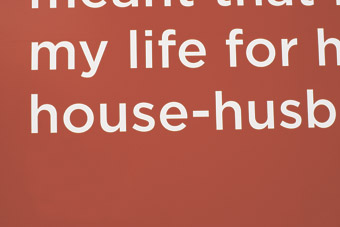 write/here project curated by
write/here project curated by
James Newitt and Justy Phillips
As non-fiction increasingly dominates the front shelves of bookshops, as documentary feature films fill cinemas and prime time television slots, as theatre reproduces significant events verbatim and reality TV lingers over its contrivances, we become increasingly aware of the art of non-fiction, the poetry and drama of the everyday and the creation of the shifting personae with which we present ourselves at home, at work and on YouTube. In the write/here project [page 13], part of Tasmania’s Ten Days on the Island festival, 27 billboards featured the anonymous poetry of the everyday, verbatim utterances from Hobart’s citizens, around which, like reading haiku, we read and built worlds. The quotations, all in white on red backgrounds, supplanted or were juxtaposed with the advertising we so often ignore, its creativity having only one goal. The lo-tech, labour intensive write/here offered much more, making everyday thought strangely more palpable. Everywhere in RealTime 78 writers and artists address observation and activism, art and the real.
RealTime issue #78 April-May 2007 pg. 1
© RealTime ; for permission to reproduce apply to realtime@realtimearts.net
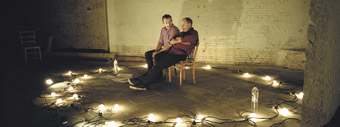
Forced Entertainment, Quizoola!
photo Hugo Glendinning
Forced Entertainment, Quizoola!
FORCED ENTERTAINMENT BEGAN IN SHEFFIELD, ENGLAND IN 1984 AND HAVE WORKED TOGETHER SINCE, BUILDING A BODY OF MORE THAN 50 SHOWS. THERE ARE DURATIONAL AND RULE-BASED PERFORMANCES; LARGE AND CHAOTIC THEATRICAL PERFORMANCES; SITE-SPECIFIC WORK; AND “FICTIONAL DOCUMENTARY” SUCH AS NIGHTS IN THIS CITY, A GUIDED BUS TOUR OF SHEFFIELD WHICH MIXES PERSONAL STORY, WORLD EVENTS AND ‘FACTS’ ABOUT OTHER CITIES. THEIR WORK IS “POSTDRAMATIC” IN THE SENSE HANS-THIES LEHMANN ELABORATES IN HIS BOOK OF THE SAME TITLE: IT “PROBLEMATISES ITS STATUS OF ILLUSORY REALITY”. THE FOURTH WALL ISN’T THERE—OR WHEN IT IS, IT’S TORN AND DIRTY, CONSTANTLY FALLING APART INTO REAL TIME.
Forced Entertainment shows take place in the shared space-time of both audiences and performers, and as such implicate the audience in the fiction-making machine of the theatre. There are certainly stories, fictions, dramatic tensions within these performances, but they tend towards the fragment, competing and colliding with other elements of the show rather than forming an overriding architecture. These performances are “shows” rather than “dramas” and as such, both cite and evoke popular performance forms and games.
quizoola
Forced Entertainment’s Quizoola! opened the 2007 PuSh International Performing Arts Festival in Vancouver festival at Ocean Cement—a large workshop space on a wharf that clearly still had a day-life. Entering a still-working space during its downtime to attend an arts show—the life-form superseding heavy industry on the island—was a little eerie, as if the past was dreaming its own future death. And yet the ‘art’ event (Quizoola!) also felt makeshift, industrial; showing its own bones. Metal fold-out chairs were arranged in rows; the performance area was delineated solely by a string of bare light bulbs laid on the floor. Two performers in ordinary clothes and smeared clown make-up were onstage; one was asking the other questions. A third sat on the door, reading and selling tickets. The space evoked cheap theatricality, grease paint and (uneasily, for us in 2007) an interrogation room.
Quizoola! is one of Forced Entertainment’s “durational performances”, lasting six hours. The three performers rotate roles; the audience is free to come and go. The interrogator reads and then riffs from a pile of 2,000 questions compiled by writer-director Tim Etchells and held in a messy sheaf by the questioner. When I walked in, long-time company member Cathy Naden was interrogating Kent Beeson, a local performer who joined the company for Quizoola!, Cathy asks Kent if he can count (Yes); Can he count really, really well? (Yes); How many people in the room? (103); How many men and how many women? (More men than women), I SAID How Many Men And… (Um, 52 women, 51 men); and on and on, until Kent has to calculate impossible mathematics (the number of cars driving by times the number of people wearing glasses divided by…). It’s a game; of course Kent fails, and it’s funny. Many of Forced Entertainment’s shows are based on rule-structures or games. This imposes a different dramaturgy than the arc of dramatic fiction and contains a lot of real-time tension, because things can always go wrong. The rules can be broken. Performers can fail at the “game.” The rules can shift and suddenly include the audience.
And yet it isn’t only funny. The sheer length of the event begins to reveal other rhythms, other temperatures. There’s a cooled-down space of durational performance which escapes the dramaturgy of beginning, middle and end. And in a different way, it’s fascinating—waiting to see what develops. There’s a set list of questions, but when the performers sense a groove, a line of questioning, they follow it. And always there’s the tantalizing possibility that we might be hearing home truths (“When did you cheat on your lover?”). Strangely, personal questions to do with sex are less charged here in 2007 than questions about war and television; people sat still and listened differently during the following sequence:
Did the Gulf War really happen? Yes. How do you know? I saw it on TV. Why does that make it true? Because I saw it on more than one channel. So? If something’s only on one channel, it’s probably made up. If it’s on two channels at the same time, it’s true.
Hours pass. I leave, have dinner, return. The interrogation continues. Paradoxically, a performance relentlessly dedicated to “truth” starts to produce a vision of the world that is utterly phantasmic and internally inconsistent. How to cook lasagna and what a tree is; what’s the history of the world; why milkbottle tops are made of metal; what caused the Balkan wars; and whether you cheated on your lover—all appear together like a mad live newspaper. Slowly, through these questions, the ghost-outline of everyday knowledge rises to the surface of daily life like some fabulous Elizabethan shipwreck. And, watching the actors struggle to survive this shipwreck (that is, the inconsistent knowledges that make up daily life) I’m reminded of Bob Dylan’s line: “All the truth in the world adds up to one big lie.”
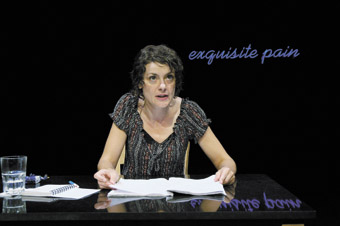
Forced Entertainment, Exquisite Pain
photo Hugo Glendinning
Forced Entertainment, Exquisite Pain
exquisite pain
Exquisite Pain was staged the following evening at Performance Works, a lovely intimate black box theatre, a hundred metres down from Ocean Cement. It’s based on artist Sophie Calle’s exhibition and book of the same name; the text and projected images are both taken verbatim from her book. It’s the first time Forced Entertainment has used another writer’s text. The company has recently moved towards these more intimate kinds of performance, involving direct address and a lack of theatrical effect.
Again, the set is bare: tables and chairs, bottles of water, glasses and unbound scripts. Above each table, a flat-screen video monitor. On the black upstage backdrop, in blue neon-sign cursive writing, the show’s title. Cathy and Robin walk out in everyday clothes (jeans, shirts). Robin tells us that Sophie Calle was to meet a lover in New Delhi; on the night of his expected arrival he broke up with her over the phone. Calle decided to tell this story to friends, acquaintances, and strangers for as long as it took for the story to lose its pain for her, and to ask each of them in turn for the story of their greatest suffering.
This simple process of exchange structures the show. Cathy tells the above story in some detail with the projected image of a red telephone in a shabby hotel room as background. Robin then reads his first story, one of the many demanded by Calle of others. Above him, an image of a white basin; the story is of a lover’s betrayal. We switch back to Cathy. She tells the same story as her first one, with almost identical phrasing and the same image. Then a different story from Robin, an image of a blue car. When we switch back to Cathy and there’s another minute variation and the same red telephone appears, there are ripples in the audience. We will be listening, then, to this story for the next two hours, counterpointed with the tales of strangers. Cathy begins each time, like Scheherezade, with a changing count of days: “Five days ago, the man I love left me….” “Twelve days ago, the man I love left me.”
From dread of impending boredom I move to a cool interest and then to fascination. Again, the effect is cumulative; Calle’s narrative/Cathy’s narration is not just moving its internal deckchairs, but in fact shifting, becoming less shock-laden, more wry. Pain is moving through narration into the kind of framing distance that might become, in time, an ironic anecdote. As with Scheherezade, storytelling and death seem to be the two sides of this flowing Mobius strip of narration, a process that—to paraphrase writer/director Tim Etchells—can’t declare itself either comedy or tragedy because in each is the seed of the other. Somewhere towards the end, as Cathy tells the story for perhaps the 50th time, she declares: “As suffering goes, nothing special. Nothing worth harping on about.” (We—the audience laugh. A lot. ) At 98 days she declares, “Enough.”
This show doesn’t produce empathy so much as a kind of cross-infection of experience. Even now I can summon that red telephone. Every detail of that photograph, and the room around it, glows as if it were my own memory etched in pain. And in a sense, of course, it is; these stories invite us to revisit our own.
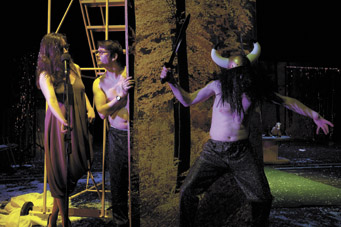
Forced Entertainment, The World in Pictures
photo Hugo Glendinning
Forced Entertainment, The World in Pictures
the world in pictures
While Quizoola! and Exquisite Pain incline towards to the rule-based, durational strand, The World In Pictures, which I saw two weeks later in Dublin, is theatrical with a vengeance. Fake snow, rampaging cavemen, multiple stage-deaths, group dance numbers, skeleton costumes—it’s all here, in chaotic surges of stage action interspersed with quiet, story-telling. It was a bit of a shock after first encountering the company through their less “theatrical” works.
The show loosely collides two strands—one is the History of the World, which the company attempts to act out in the manner of an amateur children’s pantomime complete with bad wigs, caveman outfits and ridiculous togas, while a Narrator struggles to remember what seems like English school book history. The other strand is a series of stories—low key, everyday—told by Jerry, who addresses us from his everyday persona and clothes. The set is again bare, at least to begin with (“that’s a real fuck-you set”, said someone behind me in the audience), and the cast comes out in everyday clothes. Jerry stands nervously to one side while the others give him acting advice in a sendup of the earnest Method-acting workshop. “Watch those hands in your pockets”, says one. “Just be yourself”, says another. “Try to keep it upbeat.” Then they leave him to it.
“You’re walking through the city with an hour to kill,” Jerry says. His story wanders through a city and takes its walker into a large public-housing tower. “‘You’ climb the stairs, and from the top, imagine what it might be like to fall…you slide over the edge…the ground rushes towards you…excitement, terror, regret…the cars are really close, the cracks in the pavement…I might pause here,” says Jerry, “this has got us into a good place to start the show.”
And with that, the actors charge on to perform a comical fake modern dance to Cecil B de Mille’s apocalyptic movie music (“the volcano scene” from The Last Day of Pompeii). The Narrator puts us through the Greeks, the Romans, the Black Plague, Knightly Love (much cavorting, fake snow, death, and some amusing anachronisms—cavemen masturbating to images on a laptop). “Stuff was happening in Bulgaria. Stuff was happening in Brazil. But here in Europe it was the Dark Ages.” I quite enjoyed the Dark Ages after all the chaos. The performers wander around slowly while the Narrator explains (I’m paraphrasing here), “They forgot everything. They forgot reading. And astronomy, and medicine. And painting. They forgot about government and how to read the time from the position of the stars. They forgot about Literature and the Greeks.”
Being the Dark Ages, the Narrator turns the stage lights off, while Jerry clicks through slides on a laptop and comments on them. Cling-wrapped meat in a butcher’s window. (Something you might have eaten). People on the street. (Someone you might have met). An empty hotel lobby with the furniture stacked in one corner. (Somewhere you might have been). A chair. (A chair). A café. (Somewhere you might have had coffee). A bunch of keys on a table. (Puzzled pause—I don’t remember). A milk bottle. (A milk bottle). A purse (I don’t remember).
The slow superimposition of personal memory onto a different fictitious space, that of History, slides them together into time’s ruins. We’re nearly in the present. The overarching umbrella of history is falling apart, confronted by the here and now. The Narrator loses her confident tone; there are stage-whispers of advice about what to include, what to leave out. She’s uncertain about the 1990s because (looking anxiously at us) “they’ve lived through that.” They decide they’re pretty much done, and leave the coda to Jerry—once again advising him to “keep it positive.”
In his final story, we don’t revisit the spectre of our death from falling—at least, not directly. Imagine (I remember him saying) that soon you’ll be leaving here. And how much of the show will you remember, do you think, in one week? Or in a month? And perhaps, in a year, you won’t remember much of it at all. And the other people here. In two years perhaps someone who’s here tonight might have died. And then, in five years, maybe a few more. Think ahead now…to five hundred years. Will anyone remember you at all?…Well. It’s been a lovely evening.
I loved the weave of personal time and history with the impossibly fictional History of the World. There were many funny and poignant moments, yet I felt being ‘about’ something hampered this show. In contexts where meaning develops associatively through the juxtaposition of many elements (Forced Entertainment’s Bloody Mess and Hidden J), silly theatrics and demonstrative acting can be very effective as one strand in a complex, world-building weave. Here they seemed corralled back into their traditional function in ‘bad’ theatre—illustrating a theme. Since postmodernism has already demolished the omniscient narrator, this aspect of the show seemed like a slightly patronising demonstration of something well established.
And yet Forced Entertainment’s signature elements—the threadbare theatricality that reveals its own means of production, the witty juxtaposition of unlike elements, the promise of stories that never quite deliver what they promise—meant that the show also lived on for me. This is one of the company’s most singular effects. In the hectic failure to stage what they promise (always a part of the comedy), their shows nevertheless weave personal and public spaces together into a kind of poetics of everyday life; everything looks different afterwards. Walking through Dublin for days after The World In Pictures, I was at once in Jerry’s story and my own—a folded fictional space imagined and material.
Forced Entertainment: Robin Arthur, Tim Etchells (artistic director), Richard Lowdon (designer), Claire Marshall, Cathy Naden and Terry O’Connor
Quizoola!, director Tim Etchells, performers Cathy Naden, Robin Arthur, Kent M Beeson; PuSh Festival, Ocean Cement Repair Shop, Ocean Construction, January 10; Exquisite Pain, director Tim Etchells, text and images Sophie Calle, performers Cathy Naden, Robin Arthur, design Richard Lowdon, lighting design Nigel Edwards; PuSh Festival, Performance Works, Vancouver, Feb 11-13; Forced Entertainment, The World In Pictures, direction Tim Etchells, text Etchells and company, performers Robin Arthur, Davis Freeman, Wendy Houstoun, Jerry Killick, Richard Lowdon, Claire Marshall, Terry O’Connor, Bruno Roubicek, design Richard Lowdon, lighting design, Nigel Edwards, soundtrack Found Sources; Project Arts Center, Dublin, Jan 19, 20
RealTime issue #78 April-May 2007 pg. 2,3
© Christine Evans; for permission to reproduce apply to realtime@realtimearts.net
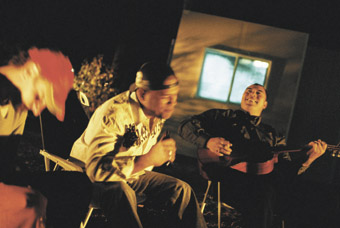
UTP, Back Home (2006)
photo Heidrun Löhr
UTP, Back Home (2006)
IN 2004, VALERIE BERRY MENTIONED TO ALICIA TALBOT, ARTISTIC DIRECTOR OF URBAN THEATRE PROJECTS (UTP), THAT HER BROTHER, WRITER/DRAMATURG PASCHAL DAANTOS BERRY, WAS WRITING A PERFORMANCE PIECE FOR HER INSPIRED BY THEIR EXPERIENCE AS FILIPINO MIGRANTS. TALBOT WAS IMMEDIATELY INTERESTED.
As one Australia’s leading social and political theatre companies (Talbot refutes the term “community theatre”) all of UTP’s work is concerned with contemporary Australian life and how we are navigating our way through complex urban society, particularly in Western Sydney where the company is based. Talbot had no idea whether UTP would end up being involved with the Berry project but felt instinctively it was something the company should support.
“It started out as simply giving them a week’s wages and rehearsal space as part of our support program so they could go through the script and see what they needed to do with it”, says Talbot. An Asialink residency then took Paschal to the Philippines to work with the Anino Shadowplay Collective, a group of young multimedia artists, who became involved with the project.
Three years on, UTP is presenting the resulting work, The Folding Wife, in association with Blacktown Arts Centre. “So it’s been a long process”, says Talbot. “The way that relationship evolved is completely different to others. But each is unique. The company is constantly responsive. It builds all kinds of very personal and idiosyncratic relationships but actually it’s about an artistic process and that’s exciting.”
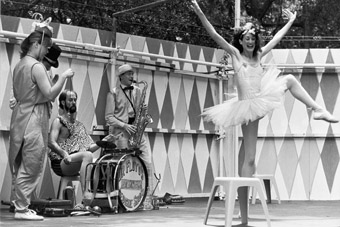
Dr Floyd’s Fly by Night Medicine Show (1982)
synthesis & difference
The productions that emerge are equally unique. Few if any other Australian theatre companies have consistently created such diverse work for so many different audiences. TrackWorks (1997) took people on a surreal journey performed on railway stations and trains. For Speed Street (1998) the location was an actual street in Liverpool and featured residents. brought Goths, revheads and hip-hoppers together on the roof of a Bankstown car park. For Asylum (2001) the company turned a disused wallpaper showroom in Lidcombe into a prison cell to tell refugees’ stories. Fast Cars & Tractor Engines (2005) saw three actors with headphones telling eight Bankstown residents’ stories by repeating interviews with them word-for-word. Last year’s Back Home was performed over a barbeque in a backyard in Blacktown.
As Talbot says: “There’s no aesthetic cohesion and there shouldn’t be. There’s a synthesis of ideas but in terms of how that manifests, it’s remarkably different [for each production].”
UTP defines its mission statement as: “making new performance works that engage in socially relevant questions and are intimately connected to specific sites and diverse communities. These stories and images of contemporary urban life are drawn from, and heavily influenced by, the company’s geographic and social location in the western suburbs of Sydney.
“In increasingly conservative times, one of the key roles for Urban Theatre Projects is to provide individuals, communities, artists and audiences the opportunity to engage in a meaningful dialogue about the world we live in.”
The company has done this so successfully that in 2002 it was presented with the Sidney Myer Award in recognition of its outstanding contribution to Australian theatre. Last year, UTP turned 25—a major achievement for any Australian theatre company, particularly in the small-to-medium sector—which gave it occasion to look back over its history. UTP published a book of commissioned essays about the company and its work, a project it continues to develop via its website, commissioning writing that examines the relationship between practice, critical thinking and contemporary culture.
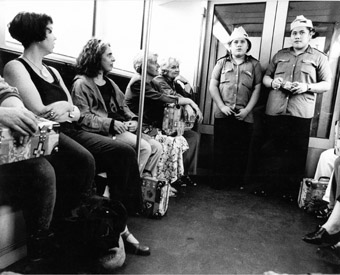
UTP, TrackWorks (1997)
photo Heidrun Löhr
UTP, TrackWorks (1997)
adaptation & transformation
The company began life in 1981 as Death Defying Theatre, formed by Kim Spinks, Paul Brown and Christine Sammers in order to challenge existing notions of theatre and existing relationships with audiences. In 1991, under artistic director Fiona Winning, it began the move west, relocating from Bondi to Auburn then Casula and later Bankstown where it is now based. In 1997, artistic director John Baylis changed its name to Urban Theatre Projects. Mentored by Baylis, Talbot became artistic director five years ago, joined a year later by Simon Wellington as general manager. Together they are a dynamic team.
Artists involved with the company over the years agree that the reason for its longevity and continuing relevance is that it has managed to constantly reinvent itself and re-evaluate its practices whilst retaining a strong sense of its original purpose. Says Winning: “There’s been a lot of redefining and rethinking around community and cultural practices in the last 20 years and I think the company has always kept ahead of that. The capacity to be able to shift and redefine contemporary ways of thinking has been very significant.”
Winning points out that the company has also moved with the times structurally, changing from an ensemble and adopting the model of shared artistic director/general manager leadership around 12 years.
The company has always attracted good cultural thinkers and cutting-edge artists, which has given it a significant creative capital and allowed it to move from strength to strength.
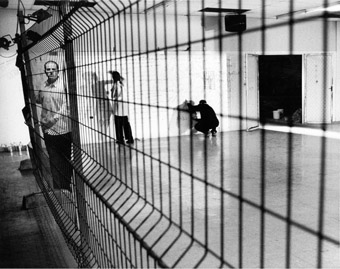
UTP, Asylum (2001)
photo Heidrun Löhr
UTP, Asylum (2001)
the folding wife
There are several strands to UTP’s work: productions; seeding and research work for the creative development of future productions; and the professional development of artists. Each year it runs a research development or master class that relates to the annual programming. In March, in the lead-up to The Folding Wife, UTP held a five-day intensive workshop called Unravelling the Bride that explored cross-cultural and cross-artform practices. Facilitators included Anino Shadowplay Collective, Australian-based Filipino installation artists Alfredo Juan Aquilizan and his wife Isabel, Paschal Daantos Berry and Deborah Pollard, who directs The Folding Wife.
The Folding Wife opens in the recently refurbished Blacktown Arts Centre, continuing a partnership that began with the production, Back Home. Blacktown is home to a large Filipino community, which makes the venue particularly appropriate. Valerie Berry plays three Filipina women—a grandmother, mother and daughter—each desperate to escape a different era and political situation in their homeland. Berry is joined on stage by two members of Anino, who create a metaphorical landscape with a blend of animation and projection that shifts and shapes before the audience’s eyes. The piece explores notions of nationalism, the reasons that propel people to migrate in search of a new home and its ramifications in terms of displacement and cultural identity.
back home to toronto
In June, UTP undertakes its first international tour when Back Home goes to Toronto in partnership with the Harbourfront Centre. The production will also tour Australia between August and November. Back Home features four men from different cultural backgrounds who are reunited after many years for a barbeque. What starts as a celebration, disintegrates as broken promises, old wounds and cultural differences emerge. Originally workshopped in collaboration with Indigenous and immigrant communities in Sydney’s west, Back Home is a powerful examination of masculinity, disharmony and reconciliation. UTP will do some free community showings in Toronto prior to performances at the inaugural Luminato Festival. The company will also undertake a community research and development process for a new work to be developed in collaboration with Harbourfront during 2008/09.
riots and shift work
Works in early stages of creative development, for production next year, include The Last Highway and Stories of Love & Hate. Set late at night in a service station, The Last Highway brings together the station attendant, a doner kebab salesman, two sex workers, a taxi driver and someone who has just wandered in. Directed by Talbot, it will be created through community consultation with late night shift workers using the model she employed for Back Home and The Longest Night. “In terms of the bigger picture it poses questions about land and territory, and navigating borders and terrain”, she says. “On the personal level it looks at how late night workers, who often come from different cultural backgrounds, navigate shift work and danger, so it’s about what gets us through the night.”
Stories of Love & Hate is being made by director Roslyn Oades in response to the Cronulla riots. Like Oades’ hugely successful Fast Cars & Tractor Engines, it will tell a series of personal stories of people directly involved in the incident through audio interviews.
In 2008, UTP is likely to move into a new venue: a multi-purpose arts facility being developed in partnership with the NSW State Government and Bankstown City Council, which will also house Bankstown Youth Development Service and Citymoon, a company of Vietnamese-Australian artists, with whom UTP shares its current premises.
As for future work, reinvention remains a given. “As I always say, the company makes work based on sets of questions and the relationship between site, artist and community, and fuelled by ideas. That is a really potent combination and it can’t be stagnant and it can’t be contained. It has to transcend funding and political environments,” says Talbot.
“In the current Australian context where we’re not telling that many stories about ourselves, I think the importance of images and words and visions of contemporary Australia, told by artists with urgent social and political agendas, become more and more pressing. So if you ask me what the future is, I go—well 25 years ago that was agenda and it still is now.”
The Folding Wife, Blacktown Arts Centre, April 19-28, www.urbantheatre.com.au
RealTime issue #78 April-May 2007 pg. 4,5
© Jo Litson; for permission to reproduce apply to realtime@realtimearts.net
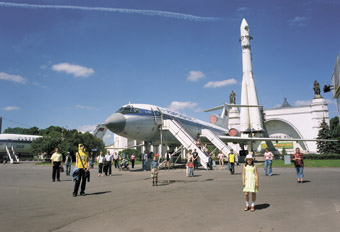
Melanie Manchot, Aeroflot 12.36 (2004) from 1+1=3
I MEET FOSTER AND DEAN IN THE SMALL ATRIUM OF THE AUSTRALIAN CENTRE FOR PHOTOGRAPHY. HE’S SURFIE BLONDE AND LIGHTLY TANNED, BEEN ON THE ROAD, HAS A SORE LEG AND “FEELS A BIT ROPEY.” SHE’S BRUNETTE AND ALABASTER-SKINNED, JUST BACK FROM TOURING AN ACP VIDEO SHOW TO AUCKLAND, AND IS LIKEWISE TIRED. ALL THIS ASIDE THE EMINENTLY QUOTABLE PAIR ARE ENERGISED BY A MISSION.
We're sitting in the realisation of one part of the vision where a digital monitor will soon join the tables and chairs, the magazine rack and the view into the new “event space”, formerly a restaurant the rent from which helped pay off the ACP mortgage on the building by the end of last year. It's clear from the start that we won't be talking about what's current in photography or what it's all about (same as it ever was, it seems)—that's just content. Conversation is the matter at hand, metaphorical and actual, as an ACP vision of opening itself and photography out to the greater public through various forms of engagement (exhibitions, magazine, website, classes), not the least of which will be talk.
If you want to talk seriously you need to be visible and accessible. The ACP now has an extensive Oxford Street shopfront that looks into the event space and there’s a more welcoming, capacious entrance (still doubling as an exhibition space). There’s also a stronger sense of welcome, of an offer to sit and browse and wander into the exhibitions as you feel so moved. The windows, says Foster, “are soundproofed, big double-glazed vitrines. They were put in primarily because you have to suppress the low reverberation from buses. They also create this sense of almost being able to walk in. We have noseprints on the glass every morning.” Dean adds, “It feels like our eyes are open to the street and the street is looking back.
There’s been an almost instantaneous change in the audiences coming through.”
The event space is also used for exhibiting but principally it’s a place for dialogue. Foster explains, “Some of our artist talks are about particular practices and some—like the Talking Shop series—are about approaches to making work. We have lunchtime films, which are a mixture of biopics and experimental films, generally of the type that don’t get into theatrical release or TV. One of the formats that works really nicely in terms of bringing people together in a conversation is a kind of Parkinson-style chat show and an afternoon tea afterwards. Martin Jolley’s done one, I’ll do them sometimes. The first one on April 1 was titled Photography and the Law: Panic and Paranoia. Three guests come up one at a time and are interviewed then they start to interact collectively and then with the audience and then on a more one-to-one basis afterwards. I wanted to follow television formats, not academic ones.
You can’t underestimate how empowering it is for a broader audience to have things delivered in ways where they feel ownership. Audiences want to see something happen. A paper isn’t something happening. It’s just something being repeated, whereas a conversation is always new and you never quite know what’s going to be asked and how it’s going be answered.”
To keep the talk going, you have to be available: “We don’t like to be closed at the weekend because we get very many more people coming in on Saturday and Sunday than any other time”, says Foster. “We’re also opening in the evening now, on weekdays till 7pm, which allows people to come in after work. We want to reach people when they’re available so we hold our events at 6.30pm not 7pm because at 6.30 you can come for an hour and go away and you’re not fainting from hunger. It’s the natural space between working and eating that can be stimulating for the rest of the evening, something to talk about over dinner.”
exhibition as conversation piece
But how do you stimulate that conversation in the ways you frame your exhibitions? The recent, amusingly spooky Olaf Breuning show comprises one room installed with a crowd of life-sized ghost figures, another room with a video dyptich and a third with large photographs—all the spaces are dark and the imagery links one to the next. It’s typical of the considerable effort that ACP goes to engage its audiences. Foster says he aims for “the whole experience—I’m quite happy to call it ‘theatrical.’ I know some of my colleagues thumb their noses at it but for me it’s one of the most powerful forms of interpretation you can offer.” Foster argues that it’s vital to “create an atmosphere in which people feel a discontinuity with the bright street life outside and in which they will slow down, open up and begin to feel differently when they look at the works…I have this phrase I’m fond of: ‘Exhibitions should be easy to get into and difficult to get out of.’ And I think if you make an exhibition too difficult to begin with people won’t cross the street to come in—it’s essentially gagging yourself.
“With our approach you have the potential to be surprised. You don’t walk in and see the same white box with various rectilinear things on the wall. You’re never quite sure where it’s going, what you might see, and that means you go in with a more open mind rather than thinking, Oh, it’s only art, I’ll just consume this in a fairly superficial way. Unfortunately, for all the self-aggrandising rhetoric we use in the arts, something that is only ‘art’ is actually a way of diminishing it. If you say it’s not just art, it’s an experience, it’s something that will speak to you, people are more opened up to it.”
worlds beyond
The ACP connects with a world beyond its own building. Foster and Dean make sure that they visit Australia’s major cities every year to talk to artists. As well, in 2006, says Dean, “we had eight shows touring to 17 venues, this is in Australia. I also took Trent Parke’s Minutes to Midnight, which Alasdair had curated, to the biannual Chobi Mela Festival of Photography in Bangladesh. That show’s touring the region now through Drik, the agency that runs the festival.”
Video is also part of the ACP travelling repertoire. Dean has just returned from showing Mirror Worlds (2005), works from Asia, in New Zealand. Again the work was engagingly installed: “Zoe [Butt] and I were very conscious of trying to make it an enjoyable, quite vibrant experience so that people had a sense of being in an Asian urban environment and experiencing the sound and frenetic activity. We were quite conscious of looking at this explosion, the economic boom in Asia, and going after artists that were dealing with these issues on the same heightened level. The experience in Auckland was quite amazing. About 14 new immigrants arrive there every day, so it’s a very multicultural city. People were really engaged by the work.”
talking print
Photofile magazine, published by ACP, is about to go through a transformation, again with the aim of stimulating a wide audience. Given the long turnaround of print publishing, Foster is keen to generate immediacy through a companion website which will have moderated artist profiles, comprehensive previews and eventually reviews concurrent with showings. He says it will free up the revamped Photofile “to concentrate on the experience of looking at photographs, well-reproduced images and more substantial texts.” He will also have “more artists writing than in the past as well as the verbatim interview—we now have 13 standard questions we call the Third Degree.”
working with the artist
“At the moment”, says Dean, “I’m working towards a show for the end of the year—it involves playfulness, the adopting of performance personas, costuming and staging. But then again I was just as excited working with Ben Bohane last year on his documentary exhibition and with Paul Knight and the kind of psycho-geography he creates in his work.
Foster declares, “Our involvement with art is through the process. It was an incredible experience working with Trent Parke for so long on Minutes to Midnight from half way through the shooting right through to the exhibition and I’m still working with him and how he gets that work out into the world. In one way that’s a very privileged position, but one needs to learn that. It’s not just looking at art on its own but actually understanding how it’s made, how it lives, understanding that when you meet it it’s like meeting a person. There’s a life before and a life after.
now and next…
With expanded space, a technical centre to drive it, a program of events, accessible opening hours, a reconceptualised Photofile in print and online, along with the ACP’s classes in photography and various touring engagements, Foster’s “multi-vocal approach” can be more fully realised. But what’s next for the ACP and its prodigious output and consistent melding of Australian and international work, often provocative and ever shape-shifting?
While Dean curates, Foster sees himself moving more into forward planning, “as part of ACP’s evolution”, focusing on “the empowering of audiences and the personalisation of experience. I only have to look at my kids, how they engage with the world and how much more empowered they are to naturally produce and make and interact. They don’t think about mashing and that sort of thing as some specific activity. It’s like breathing. You just pick stuff up and move it around. It’s only people of my age who have to keep reconceptualising. So that’s what I’m really getting into.”
1+1=3, Collaboration in Recent British Portraiture is the ACP’s next show, Apil 20-May26; Australian Centre for Photography, Paddington, Sydney, www.acp.org.au.
Image: Melanie Manchot, Aeroflot 12.36 (2004) from 1+1=3
RealTime issue #78 April-May 2007 pg. 6
© Keith Gallasch; for permission to reproduce apply to realtime@realtimearts.net
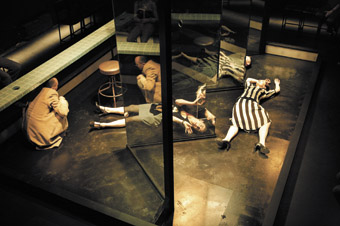
Black, from left James Wardlaw, Moira Finucane, Caroline Lee
photo Jeff Busby
Black, from left James Wardlaw, Moira Finucane, Caroline Lee
THE LITERARY CRITIC BRIAN MCHALE WAS THE FIRST TO SUGGEST THAT THE SHIFT IN A POETICS OF MODERNISM TO ONE OF POSTMODERNISM CAN BE TRACED TO PROBLEMS OF EPISTEMOLOGY SUPPLANTED BY THOSE OF ONTOLOGY. THAT IS, THE GREAT MODERNIST WORKS WERE ONES WHICH ASKED “HOW CAN WE BEST REPRESENT AND INTERPRET THE WORLD?” A POSTMODERN WORK, ON THE OTHER HAND, ASKS THE ANTERIOR QUESTION: “WHAT IS A WORLD?”
Concerned less with finding a more truthful, accurate form of expressing “all that is the case”, to appropriate Wittgenstein’s phrase, a postmodern work instead tremulously queries the very existence of a knowable, retrievable reality—or at least questions an art work’s ability to reproduce it. This seems to me the dominant characteristic of Anna Tregloan’s Black.
Tregloan’s performative installation takes as its ostensible subject the notorious 1947 “Black Dahlia” murder of Elizabeth Short in Los Angeles, establishing expectations of a kind of True Crime theatre of reconstructions, drawing on the many texts which have attempted to ‘solve’ the famously enigmatic killing and presenting something which attempts to make sense of the panoply of conflicting evidence. But of course, theatre cannot solve a murder, and Black turns out to be something very different indeed.
Tregloan is an inspired installation artist and set designer, and the piece is very much of the character of a living exhibition. The space is exquisitely designed: the audience navigates separate rooms, staircases, a balcony overlooking the main playing space—itself a beautifully crafted folding screen of glass panels which multiplies perspectives.
Four performers (Caroline Lee, Moira Finucane, Martyn Coutts and James Wardlaw) inhabit this central area, speaking snatches of text which sometimes coincide and are sometimes more opaque. As the viewer navigates the space, they are offered different sightlines on the unfolding drama, no one vantage point allowing a total perspective. And the glass panels, visited by a constantly changing lighting rig, magnificently reflect and refract the images of those passing by, at times dividing them but more often allowing them to occupy several spaces at once, ghostly images interacting with more corporeal presences.
Tregloan doesn’t make sense of the drama, at least on the level of narrative. Rather than offering a movement from mystery towards some kind of resolution, even on the psychological level, the performance is cyclical, roughly 40 minutes long, repeating without pause over three hours. Phrases recur, and thematic motifs (ice, salt and sugar) offer teasing but ultimately unedifying hints at an underlying structure inaccessible to the observer. The audience comes and goes, constructing their own beginning, middle and end dependent not on the assimilation of a pre-existing narrative structure but on the simple storyline traced by their roaming, their interest or boredom, tired feet or restlessness. The always partial perspective afforded by the spectator’s position is temporal as well as spatial.
All of this works to implicate the viewer on that ontological level. Though we may initially look to the piece for a solution to a classic mystery, we soon cannot help but realise the ways in which our own position as observer will necessarily not merely distort the truth, but construct it.
Similar ontological questions are evoked by GoD BE IN MY MouTH’s Grace, a spare performance both confounding and transcendent. It is deeply indebted to a surrealist or absurdist tradition but maintains enough of a linear narrative to leave audiences dissatisfied with the whole—or at least those audience members I spoke to afterwards, along with a swag of ambivalent reviews. The problem seems to me to be one of interpretation: it is entirely unclear what kind of ‘reality’ the piece presents, and therefore how we are to read its various competing elements.
There is a story, certainly, and characters, and a movement which echoes a traditional narrative structure. Long-separated and recently orphaned siblings Serbia and Wade arrive at the rooftop dwelling of their eccentric uncle, who lives with the half-human/half-pigeon experiments he has been working on since his disgraced departure from street-level existence. He holds the key to their inherited fortune, but is also embroiled in their puzzling past more profoundly than they realise. Though far from a naturalistic work, Grace still suggests enough realism to rouse those parts of the mind which look to establish a meaning behind a tale’s telling.
But there are aspects which actively work against such a reading—those overtly surreal moments—but also a seemingly deliberate attempt to stonewall interpretation, render uncertain any definite reading of the work. It is a theatre of moments, of dazzling soliloquies touching on mortality and redemption, and equally of inane pop dance routines enacted by ridiculously attired feather-heads. The final poser is not “what is really being said here?” but “is anything being said at all?” Which might well be the most challenging question a theatremaker can dare to ask.
Black, created by Anna Tregloan, performers Caroline Lee, Moira Finucane, Martyn Coutts, James Wardlaw, sets & costume design Anna Tregloan, composition & sound design David Franzke, lighting design Paul Jackson, dramaturg Maryanne Lynch; Tower Theatre, Malthouse, March 17-April 1; GoD BE IN MY MouTH, Grace, writer-director James Brennan, performers Katrina Miilosevic, Luke Mullins, Brian Lipson, Gary Abrahams, Ivan Thorley, Carla Yamine, designer Adam Gardnir, lighting designer Nik Pajanti, sound designer Peter Brennan; Theatreworks, St Kilda, Melbourne, March 8-25
RealTime issue #78 April-May 2007 pg. 7
© John Bailey; for permission to reproduce apply to realtime@realtimearts.net
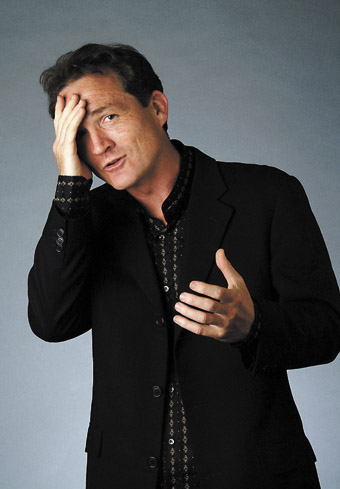
Michael Keiran Harvey
photo Simon Cuthbert
Michael Keiran Harvey
WHEN I SPOKE TO PIANIST MICHAEL KIERAN HARVEY, WHO HAS RECENTLY RECORDED LARRY SITSKY’S THE WAY OF THE SEEKER, ABOUT THE CONCEPT OF MYSTICISM, HE SEEMED WARY: IT’S NOT A NOTION THAT GIVES HIM MUCH CONFIDENCE. A SELF-PROCLAIMED SCIENTIFIC MATERIALIST, HE ISN’T INTO “PRODUCING SOMETHING MYSTICAL FOR THE SAKE OF PRODUCING SOMETHING MYSTICAL.” I PAUSED MOMENTARILY—WHERE TO GO FROM HERE? BUT HIS VOICE, SUDDENLY ENERGISED, CHANGED TONE: “THE REAL MYSTICISM FOR ME IS MAKING MUSIC OUT OF SOMETHING”.
Inspired by ancient Sufi wisdom, Larry Sitsky’s solo piano work The Way of the Seeker celebrates the mystical journey towards enlightenment. The virtuosic work draws on direct quotations from the 11th century texts of Hakim Sanai, considered to be one of the three great Persian Sufi poets.
I was intrigued—if mysticism is the pursuit of ultimate reality, did this mean that Kieran Harvey seeks insight and meaning through his chosen art? He elaborated: “In the bad old days one could quite easily get hold of mercury. This element is most peculiar—it is a metal and a liquid—very difficult to handle, yet fascinating. There are so many things in the universe we don’t understand. Some people give up and pass over responsibility to something or someone else as a way of coping. Other people are motivated by curiosity to find out as much as possible in their short span. This latter attitude is my approach to music, but—like mercury—the essence is very difficult to pin down and is constantly shifting. I relish this insecurity—it’s exciting for me.
“I maintain my sense of awe in the creative process by attempting to compose—this keeps my respect for real composers very high (even though I pretend to be disrespectful to them on occasion. Can’t have them acting like Beethoven can we?).
One gets a feeling of awe or mysticism from the natural world constantly. Look at those astonishing pictures of Saturn with our world reduced to a speck, or Bryce Canyon in Utah (no wonder whacko sects flourish in such landscapes)—far more mysterious than man-made shrouds, weeping plaster statues, faceless fakirs or transubstantiations. The ability to interpret our reality through music is profoundly useless, yet satisfying, and I’ve found it to be completely unpredictable.”
For Michael Kieran Harvey, meaning in music is derived from “getting into the mind of the composer.” And—with regard to The Way of the Seeker—it is Sitsky’s own curiosity that is inspiring: “Sitsky has an amazing intellect, is fascinated by different approaches to composition and his own ways to enlightenment…Forever researching and reinventing, he isn’t closed but open to disparate styles and the whole gamut of human experience.”
While the search for personal enlightenment is a prominent theme in many of Sitsky’s works, it is interesting that he chose to celebrate the writings of Sanai in the midst of the ‘war on terror’ (Sanai was born in the province of Ghazna, which lies in what is now Southern Afghanistan). And given the incessant propaganda currently fed to us by the federal government, a different perspective on this culture is refreshing.
Kieran Harvey agrees: “…every sane person knows how ludicrous war is and how cynical this one is in particular. Genetically speaking, we are slaughtering brothers and sisters. Does this help enlighten people about their religious memes? Of course not. Do we have more to learn about overcoming our genetic destiny? Of course we do. We are bludgeoned into apathy by paid-off corrupt governments and corporate interests are rampant accordingly. Science is under attack by morons. One doesn’t have to accept this.
“Larry has paid homage to the tremendous insights of the Sufis instead of simply writing off this sect as an enemy. Wisdom is achieved through time and by maintaining an open mind. The major human dilemma is balance and control of oneself. War, of course, shatters this and reinforces propaganda, greed, a state of constant hypocrisy, newspeak and mass memory lapses. We should be more concerned with the consequences of corporate disregard for human life—for example, the road toll, global warming, the arms trade, poisoned groundwater and the Catholic Church—than terrorism because these are responsible for much more human suffering and the end of life itself.”
art does what?
So what then of the role of art in this declining world? One immediately imagines a world where art serves to challenge the atrocities of power hungry governments—a struggling voice embodying the essence of humanity. But Kieran Harvey thinks otherwise: “Unfortunately, I don’t think what Larry or I do is important to society at all.
This is liberating of course because it is unlikely to attract the spin doctors and corruption of the mainstream, and we can just get on with things we find meaningful. I think it’s a waste of time and money to try to sell something so sophisticated to dim Footy Show viewers merely to justify funding.”
Socio-political comment through art is, of course, widespread, and I wondered further about its importance and how it reflects on Kieran Harvey’s role as an interpreter. But even here he is a little sceptical: “It is easy to write or perform something political—mostly the [target’s] a sitting duck because at least half your audience will agree with you. There’s so much that is an outrage going on—not least of all our imminent demise—that it’s surprising that not all creative works are socio-political. It’s difficult to write a Magic Flute though—something that will retain layers of insight and fool all sides. Once you realize that the concept of a meritocratic democracy is bullshit, you tend to strip away the distractions in your own life. Those not used to this tend to opt for some type of ‘spirituality’, which is just the same illusion as capitalism. My role is not readily discernible to me. I reject the notion of an ‘industry’ which was imposed on my artform and consequently upon me as a cog in this corporate structure. But I don’t give a damn about my own survival as a musician. So, although it’s getting increasingly difficult to live, I am still able to do what I really want, irrespective of audience response, management monopolies, disgruntled pollies or CD sales. But I don’t think anyone notices what I do whatsoever or, if they do, then they’re as misguided as I am.”
choice, curiosity, defiance
Of course, one thing that is difficult not to notice is that Michael Kieran Harvey has played a hell of a lot of Australian music in the last few decades. But he doesn’t think he specialises in Australian music. It’s all just music to him: “Call it lack of direction, serendipity, laziness, a low threshold of boredom, I don’t know. I don’t trawl through repertoire making up marketing strategies or seeking out names to sponge off. I think it’s more important to have a reputation based on word of mouth [rather] than advertising. I don’t pay a manager or publicist and I refuse to be sucked in by the same when making decisions about my performances, whether it be content or presentation. The decisions I make about presenting new music are diverse because I’m not sure about what might or might not work in a concert, and yes sometimes I accept an outside suggestion or dare—I would never have played Messiaen in the Concertgebouw or my next program at the Brisbane Festival otherwise.”
However, given the amount of repertoire Kieran Harvey has trawled through, performed or commissioned, I was curious about whether he thought Australian piano music has a distinct sound. I received a flat no, although he does believe that “bits of it in the past have shown an information lag and cultural cringe or an unscrupulous ripping off of less wealthy cultures, but I think as art music is increasingly ignored in Australia and we realise that posterity as a concept has disappeared, the urgency will return and replace most of the charlatanism”.
Kieran Harvey’s motivation for choosing repertoire is clear: he performs only what interests him. Curiosity is his driving force. “I’m like an entomologist”, he says. “Or at least I think like that—a scientist in the field…I lift up a rock and see what’s there.”
Again, he stresses that he makes no distinction between Australian music and other music: “The piano is just an ancient computer for realising ideas. I don’t think Australian intellectual life is dead, yet, so I find that composers based in Australia are at least as interesting as composers elsewhere.
I used to think I’d like to contribute something to the country I was privileged enough to be raised in. Seeing it overrun by red-necked morons now makes me more determined to work with the few remaining enlightened and endangered individuals who are left. I sort of agree with Patrick White’s observation about it being more difficult here than elsewhere for those not part of the mainstream, which is a good reality check.”
life as experiment
Obstacles won’t deter Kieran Harvey from his passion: he seems to thrive on a life of instability, challenges and continuous exploration. “I regard my life as an experiment—I’ve sort of already thrown it away on an obviously useless pursuit—and I’m comfortable in my skin”, he says. “So far I’ve managed to keep doing what I like doing, which is really an accomplishment for me—it took me a hell of a long time to realise this. I’m very uncomfortable in this society, but it’s where I was born, and I know it could be a lot, lot worse. I studied for three years in a communist country.
There I learned from various scientific contacts that the things of the mind are the truly sustaining interests, not material things or ideologies. I’m fascinated by the universe, and I want to live to see what will happen once the LHC [Large Hadron Collider, Geneva] kicks in this year, and the Singularity event occurs somewhere around 2030—to name a few things I’m looking forward to. Perhaps my archaic piano playing may be re-invigorated by such events.”
See page 41 for Chris Reid’s review of Michael Kieran Harvey’s CD of Larry Sitsky’s The Way of the Seeker, and page 48 for giveaway copies courtesy of Move Records.
RealTime issue #78 April-May 2007 pg. 10
© Danielle Carey; for permission to reproduce apply to realtime@realtimearts.net
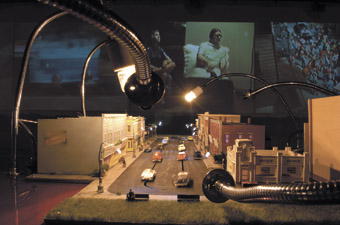
Jennifer & Kevin McCoy, Traffic Series
THE LONDON DEBUT FOR TWO WORKS FROM KEVIN AND JENNIFER MCCOY SIGNALS THE FAR-REACHING AMBITIONS OF THE BRITISH FILM INSTITUTE’S RECENTLY LAUNCHED BFI SOUTHBANK. A REFURBISHED BUILDING, A NEW NAME AND AN UPDATED REMIT ARE PROPELLING THE BRITISH FILM INSTITUTE TOWARDS A FRESH APPROACH TO AUDIENCES AND TO THE RAPIDLY EVOLVING FORMS OF CINEMA CULTURE. ARTISTIC DIRECTOR EDDIE BERG OUTLINED THE AIMS FOR THE NEW CENTRE: “WE PLAN TO BUILD ON THE TRADITIONS AND HISTORIES OF THE BFI WHILE ENGAGING WITH NEW TECHNOLOGIES AND AESTHETICS AS THEY UNFOLD. BFI SOUTHBANK AIMS TO REFLECT ALL OF THESE DEVELOPING INFLUENCES ON THE CINEMATIC FORM AND EXPERIENCE. WE WANT TO HELP ESTABLISH NEW AGENDAS FOR THE FUTURE.”
Alongside the BFI’s National Film Theatres, known for their repertoire of world cinema programming, BFI Southbank is extending the institution’s cinema remit. There’s an intimate 38-seater studio for free daily screenings, talks and education programs; the Mediatheque—a David Adjaye designed space with individual booths for accessing curated selections from the BFI national archive; and a dedicated gallery space for media and video art. The soaring, light filled foyer is set to be a prime meeting place for hip Londoners with a very glam café/lounge bar and a much needed shop for the extensive collection of BFI publications. BFI Southbank has created a street-level cinema, geared to drawing new and younger audiences who are more familiar with the personal and immediate access to media provided by expanded forms of digital distribution.
Central to the venture is the opening out of the BFI archive, a major and growing collection of over 900,000 film and television titles. Programming for BFI Southbank evolved directly out of a rights holding issue: the structure of ownership means that the archive can be made more widely available only within BFI premises and at no charge to the public. The new venue has made a challenge an advantage, offering the collection as a resource to be accessed and interpreted, building awareness of the representation of our media histories. Perceptions of the archive are evolving—we’re accustomed to the personal collection and exhibition processes flickr and YouTube now offer, and responsiveness to these changes is shaping the functions of public media institutions.
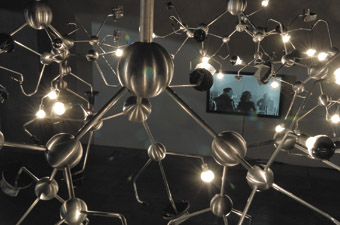
Jennifer & Kevin McCoy, The Constant World
the virtual mccoys
Exploring an expanded future for cinema and the archive is what BFI Southbank is about, and the choice of US artists Kevin and Jennifer McCoy for the launch exhibition is an inspired one, tapping into their continuous examination of ideas around the elemental structure of cinema and the role of the viewer as a creator of meaning in the cinematic experience. The show was curated by Head of Exhibitions Michael Connor, for whom the McCoys’ Tiny, Funny, Big and Sad “marks a watershed moment for the BFI: the opening of a new gallery dedicated to artists’ film, video and new media. The gallery will present exhibitions that bridge the worlds of film and visual art, exploring the blue sky between the black box of the cinema auditorium and the white cube of the art museum.”
Tiny, Funny, Big and Sad presents two works: the critically acclaimed Traffic Series and a newly commissioned work, The Constant World. The pieces traverse the territories of both sculptural form and cinematic screen, exploring the pathways by which an image comes to life, through production, the viewing experience and through personal memory.
The Traffic installation offers the viewer a series of four physical and filmic spaces that represent the couple’s own relationship within the context of their cinematic memories. Four tabletop miniature ‘sets’ recreate specific moments from films that have marked key moments in their personal history. In Traffic 1: Our Second Date, the iconic traffic jam scene from Godard’s Weekend (1967) *is depicted with an endless lineup of toy cars, trucks and gawking spectators set in a bleached (fake) grass landscape. Around the table snake the extended arms of spotlighting fixtures and miniature cameras, picking up static shots from the handmade set that are edited via computer into sequences projected onto the adjacent wall. The artists themselves are depicted seated in the plush surrounds of a movie theatre, watching live video feed of this filmic recreation on a tiny cinema screen. They are subject to the camera’s gaze too—their ‘close-ups’ inserted within the projected narrative.
In another miniaturised tableux Traffic 2: In the Cardiac Ward, the tabletop film set is recreated from George Lucas’ American Graffiti, and appears on a tiny television in the hospital room where Kevin recovers from an illness. Not only are the artists recreating and replaying their own versions of the films, but also taking ownership of cinema as a personal space, determined by the deep and memorable associations we have with particular film moments. In a time when personal appropriations and archives of media are increasingly prevalent, the McCoys cause us to reflect on the multiplicity of images and narratives surrounding us and to acknowledge the inherent creativity involved in the act of viewing. These are works that can be accessed on a range of levels—from the sheer childlike pleasure of peering down upon these detailed miniature worlds to a deeper realisation of the viewer’s implication in the construction of meaning.
The McCoy’s new work, The Constant World, continues to develop these concerns. Hanging overhead in the main foyer is a vast, many armed structure, stylistically quite at home in a 1980s two-star hotel lobby. Each arm is made up of a self-contained set enclosed in perspex and steel, spotlight and miniature camera. The movie is played out on a plasma screen below, edited using a similar technique to previous works.
The scenes and sets refer to the ‘New Babylon’ visioned as a situationist city throughout the career of Dutch artist Constant Nieuwenhuys. Countless models, drawings and manifestos document Nieuwenhuys’ dream of this city of total automation, where a nomadic life of creative play arises as society is absolved from the need to work. Every aspect of the architecture can be altered spontaneously according to the mood of its inhabitants. In the piece text elements appear randomly throughout the narrative: “relaxation”, “anxiety”, “leisure” etc. Divorced of any direct context, the words become propaganda for the fleeting moments and associations of experience that Nieuwenhuys tried to make concrete, and that the McCoys understand of the cinema as a space of personal engagement.
the art of databasing
The role of the computer is also highlighted in both works. Lev Manovich in his 2001 The Language of New Media writes, “After the novel, and subsequently cinema, privileged narrative as the key form of cultural expression of the modern age, the computer age introduces its correlate—the database.” Throughout their practice the McCoys have constantly examined ideas of narrative mechanisms as structure rather than story.
In their Every Shot, Every Episode, 10,000 shots from the Starsky and Hutch series are databased into key categories—every sexy outfit, every yellow Volkswagen for example. In Traffic and also The Constant World the computer controls the stitching together of shots behind the scenes, turning the narrative into a database stripped of the passage of time and the logical connection of ideas.
Just as the McCoys create through their practice windows onto wider aspects of the moving image, so BFI Southbank is exploring new forms of exhibition, presentation and preservation and, in the attempt, polishing up a somewhat dated image. Interestingly, the building itself will become unusable by 2012 when new tramlines are planned for Waterloo Bridge—the pressure is on to develop a significant national film centre. Perhaps it is the temporary nature of the space that has allowed the BFI to be a little riskier and explore the edges of moving image culture.
The next artist to be featured in the gallery is Australia’s Lynette Wallworth, commissioned to create two new works in her Hold: Vessel series to stand alongside the widely travelled 2001 orginal. As a living archive of a changing ecosystem, the new projections record how certain marine environments have altered significantly in recent years. The exhibition will run from June 23 until the end of August and follows on from Wallworth’s premiere UK solo exhibition now showing at National Glass Centre, Sunderland
See RealTime 79 (June-July) for an interview with Lynette Wallworth.
Jennifer & Kevin McCoy, Tiny, Funny, Big and Sad, curator Michael Connor, BFI Southbank, London, March 14-May 28, www.bfi.org.uk; www.mccoyspace.com
RealTime issue #78 April-May 2007 pg. 8
© Fabienne Nicholas; for permission to reproduce apply to realtime@realtimearts.net
<img src="http://www.realtime.org.au/wp-content/uploads/art/9/906_gallasch_seasonatsars.jpg" alt="The Season at Sarsaparilla, Peter Carroll,
John Gaden, Dan Spielman, Hayley McElhinney”>
The Season at Sarsaparilla, Peter Carroll,
John Gaden, Dan Spielman, Hayley McElhinney
photo Tania Kelley
The Season at Sarsaparilla, Peter Carroll,
John Gaden, Dan Spielman, Hayley McElhinney
FOR PATRICK WHITE’S THE SEASON AT SARSAPARILLA, DIRECTOR BENEDICT ANDREWS AND DESIGNER ROBERT COUSINS HAVE WONDERFULLY CRAFTED A COMPLETE CREAM BRICK HOUSE PLACED IT ON A REVOLVE SO THAT IT CAN BE SEEN 360 DEGREES AND EACH ROOM PEERED INTO BY THE AUDIENCE. EITHER SIDE OF THE HOUSE ARE TWO LARGE SCREENS THAT OPEN UP OUR OCCASIONALLY LIMITED VIEW OF WHAT’S GOING ON INSIDE. THE PERVERSITY OF OUR CURIOSITY (AND ITS REALITY TV CORRELATIVE) IS BROUGHT LOVINGLY HOME BY THE CAMERAS INSTALLED WITHIN. LEFT OF THIS FRAME, COMPOSER ALAN JOHN (ALSO PLAYING DEEDREE AND MR ERBAGE WITH VERVE) SITS AT AN ORGAN PLAYING EERIE NEAR-SUBLIMINAL MINIMALIST PATTERNINGS THAT INITIALLY EVOKE SOAP OPERA BUT AMPLIFY ANDREW’S DREAMLIKE VISION OF WHITE’S UNDERRATED PLAY.
There’s something very, very real about White’s version of 50s-60s Australian suburbia, for those of us who lived through the period, captured here in the solidity of this house and the acuity of the costume design (Alice Babidge). But White’s is a naturalism seen through the eyes of a poet and satirist who happened to write great novels. Andrews and Cousins aptly counter the solidity of the real by merging the lives of the three families at the centre of The Season at Sarsaparilla into one house, all going about the domestic business of family building and disintegration side by side, each oblivious to the other. The device underlines the mundane uniformity of suburban life but equally, and powerfully, amplifies stark differences of social origin, standing, expectation and personality. Above all, the atomisation of social life is acutely felt—all these people living so near and yet so far apart. Yes, there is social contact, but much of it is provisional as individuals bump into each other outside as the house turns or an incident yields a temporary gathering. Outdoors has an air of the illicit, and it’s where the bitch in heat, in the midst of a heatwave, yowls generating a moody oppressiveness and much discussion from the play’s beginning.
Once again the STC Actors Company proves itself a formidable team, here realising the characters who populate White’s Sarsaparilla with finely modulated performances aided in part by the intimacy of delivery enabled by head mikes and video closeups. The result is an intense interplay of innocence, cynicism, detachment and sensuality and subtle revelation of character. Andrews has, as well, been adept in addressing the structure of the play. In an important move, he reduces a potential imbalance in the relative weight of the characters by shifting some focus away from Roy Childs (Eden Falk) in the merging of the households and, as Sydney reviewer James Waites has noted, keeping him off-camera, making him just another character rather than a dominant commentator (www.sydneystage.com.au, March 9).
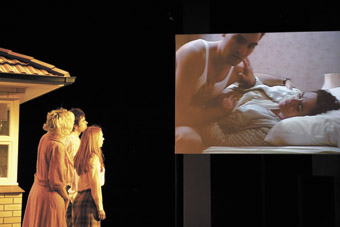
The Season at Sarsaparilla; Pamela Rabe, Eden Falk and Hayley McElhinney, on screen – Martin Blum and Emily Russell
photo Tania Kelley
The Season at Sarsaparilla; Pamela Rabe, Eden Falk and Hayley McElhinney, on screen – Martin Blum and Emily Russell
The growth towards adulthood of Judy (Hayley McElhinney) and especially Joyleen ‘Pippy’ Pogson (Amber McMahon) provides the production a clearly articulated emotional and thematic trajectory. It’s a dark education which in Pippy’s case becomes entwined, if at a distance, with the potentially tragic relationship between the sanitary worker Ernie Boyle (Brandon Burke), his wife Nola (Pamela Rabe) and a seducing interloper, Ernie’s old army mate, Rowley ‘Digger’ Mason (Colin Moody). The emerging friendship between Nola and Pippy provides one of the production’s most poignant scenes, here framed by a wirescreen door, the girl lying across the woman’s lap, not long before the most emotionally demanding moment in the play—the reconciliation of Ernie and Nola. McMahon portrays Pippy’s growth with a determined curiosity at odds with a child’s physical awkwardness. Rabe evinces the terrible weight of Nola’s self-knowledge about her moral weakness as near tragic. Moody’s frighteningly manipulative Digger is also self-aware, but too late. Burke, plays the reticent Ernie to perfection, revealing enough sense of betrayal and the white heat of anger to unnerve Nola, Digger and us without, in the end, losing the man’s dignity.
No less important, but providing rich context and revealing counterpoint, are the parent Pogsons, Girlie (Peter Carroll) and Clive (John Gaden), the quietly determined Ron Suddard (Dan Spielman) in pursuit of Judy, the soon-to-be-parents the Knotts (Martin Blum and Emily Russell), the sad Julia Sheen (Helen Thompson), pregnant to Mr Erbage (Alan John) and, of course, Roy Child. Carroll’s Girlie is one of the production’s surprises. Never a monster (David Marr describes Robyn Nevin’s version as a ‘monstrous’ figure in Jim Sharman’s 1976 production), Carroll’s Girlie is certainly not harmless but is too lost in fantasies of what she might have been to be really dangerous. Girlie is the downside of 50s optimism. White celebrates the era’s hopefulness ironically with bursts of “razzle dazzle”, intermittent celebrations of Sarsaparilla life. To Roy’s final account of the flowers, colours, births and dramas of this little world, the house sweeps around and outsize confetti falls like a summer shower (magically lit by Nick Schlieper).
Benedict Andrews once again displays continuity of vision and extends his exploration of theatrical possibilities in creating a Sarsaparilla that is real, that is dream and nightmare. Without mimicry, he creates a dream aura by working the cinematic possibilities of the stage, shifting point of view with the revolving stage (in a striking passage Nola runs through the turning house), provides closeups and frames action in doors and, as in Eldorado for Malthouse, through windows, here the kitchen through which we witness most of the play’s action—watching meals served and eaten, papers read, dishes washed and bodies looking out and pushed against glass. Likewise, the gold that rains down in Eldorado’s dream of wealth becomes the razzle dazzle of Sarsaparilla’s ordinary hopefulness.
White’s play is essentially comic, stopping just short of tragedy, and Benedict Andrews is true to the playwright’s vision. There’s plenty of humour (Girlie: You can’t be too careful! You can’t call your teeth your own once you get inside a hospital), there’s a new baby, marital reconciliation, Roy sets out for a new life, but above all there’s a joyful theatricality implicit in the text and made explicit here—a magical set, cross-dressing, music, special effects—and a truthfulness (with words, images, cameras) to a play about what you see, or think you do:
Judy: We shall never see anything through each other’s eyes.
Roy: Nobody does…really. That doesn’t make it tragic.
Judy: Oh, but they do! Some people do! I’m convinced.
10 days on earth
Hearing that Ronnie Burkett was to operate his marionettes from above in the classic manner for 10 Days on Earth, I was apprehensive having so enjoyed his presence onstage amidst his creations in Tinka’s New Dress on an earlier visit to Australia. I need not have worried, for although the focus was very much on the marionettes, Burkett remained visible throughout the performance, providing all the voices and a few quips direct to the audience. After a while a double enjoyment developed, a freedom to absorb the onstage action and be simultaneously alert to Burkett criss-crossing the top of his set-cum-marionette theatre, stepping over large gaps in the structure, choosing from multiple versions of his charges from their racks, later replacing them and, above all, generating the most nuanced gestures and moods in his puppets with the slightest of movements.
In 10 Days on Earth, Darrel, a simple minded middle-aged man lives with his mother and knows nothing of his father. His mother dies and for ten days, without being aware of her departure, indeed thinking she’s punishing him, Darrel re-lives the past and escapes into the fantasy world of his favourite storybook characters Honeydog and Little Burp, a duckling. Compared with Darrel’s old, Edwardian, timber-lined home, this fantasy world (a theatre within a theatre) offers Burkett free range for puppet magic and a riot of colour and campery—including a wonderful sheep, Blanche de Baa. Back in the real world, Darrel encounters a woman from the Salvation Army and Lloyd, an eccentric who lives on the street and thinks he’s God (and is an education in himself). In one way or another all of these characters help deliver Darrel enough reality for him to cope with a new life, although the resolution is surprisingly sudden for such carefully developed plotting. As always Burkett’s writing is as expert and as inventive as his puppeteering. 10 Days on Earth is a very complete, affecting work, offering insight into a very different experience of life and time.
Patrick White, The Season at Sarsaparilla, director Benedict Andrews, performers STC Actors Company, set designer Robert Cousins, costumes Alice Babidge, lighting Nick Schlieper, sound David Gilfillan; Sydney Theatre Company, Drama Theatre, Sydney Opera House, opened March 2
Ronnie Burkett Theatre of Marionettes, 10 Days on Earth, marionettes, costumes and set designed by Ronnie Burkett, lighting Kevin Humphrey; Playhouse, Sydney Opera House, Feb 15-March 3
RealTime issue #78 April-May 2007 pg. 11
© Keith Gallasch; for permission to reproduce apply to realtime@realtimearts.net
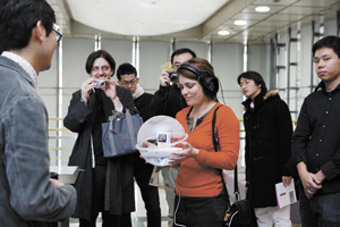
Hide Andrew, Save Yourself!!!
IN SAVE YOURSELF!!!, ONE OF THE MORE INNOVATIVE WORKS IN THE 2006 JAPAN MEDIA ARTS FESTIVAL (STAGED IN EARLY 2007), THE PARTICIPANT HAS THEIR PHOTO TAKEN AND THEN FLOATED ON A FRAME INSIDE A FISHBOWL FULL OF WATER. THEY ARE HANDED THEMSELVES IN THE BOWL AND DON SPECIAL EARPHONES THAT TOUCH A SPOT ON THE NECK JUST UNDER THE EARS. THE WORK IS TURNED ON AND SUDDENLY, AFTER A PRICKLING IN THE EARS, THE PARTICIPANT FIGHTS WAVES OF SEASICKNESS AND LOSES ALL BALANCE WHILST TRYING DESPERATELY NOT TO SMASH THEIR FLOATING SELF ALL OVER THE FLOOR. THE VISCERAL AFFECTS LAST ALL DAY while the concept evaporates in a few minutes.
The Japan Media Arts Festival (JMAF) is competitive, international and centred on the exhibition of Award Winning Works held at the Tokyo Metropolitan Museum of Photography. The spatial design of the exhibition is based on origami, the concept that the unexpected can be made from a common sheet of paper. Entry plaques to the exhibition state that the aim of the festival is to promote the popularity of media arts and describe the growing cultural currency of Japanese media art, games, animation and manga as ‘Japan Cool.’ The festival is definitely achieving its aim of popularising media art with audiences growing from 2,000 to 68,000 in the 10 years since it began.
The exhibition comprises three floors of screened, documented and installed work grouped in the submission categories Art, Entertainment, Animation and Manga. The festival includes Symposia, the 12th Computer Graphics Contest for Students, the Leading Edge Technology Showcase and a Manga Library. The week-long screening program is made up of long and short animation and Manga sessions, documentaries on the festival’s award winners and compilations from international festivals—SIGGRAPH, Seoul International Computer Animation Festival (SICAF), Ars Electronica and Australia’s Electrofringe.
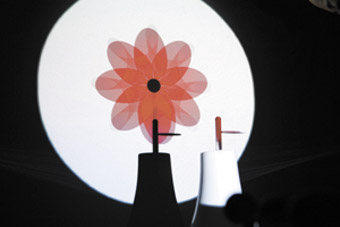
plaplax, hanahana
The selected works in the Art and Entertainment divisions are focused on technology, technique and aesthetic. Innovation in this year’s festival lies mainly in the perfecting of these elements rather than in conceptual content, perhaps because the festival is funded and partly run by the Japanese government’s Agency for Cultural Affairs, perhaps because entries are selected with no distinction between professional, amateur, independent or commercial production, and the Japanese term “media geijitsu” can be translated as art or entertainment. If Australia chose to develop the commercial growth of the media arts industry this way perhaps we could invent a new label. Australian Cool could be known as ‘artertainment’ or even ‘artattainment’ for the art consumers out there. It’s an odd idea for a director of Electrofringe, Australia’s Festival of Uncool, to take away.
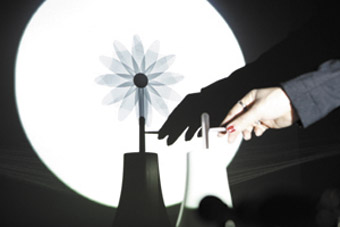
plaplax, hanahana
The Jury for the eclectic Entertainment Division claimed they saw no innovation this year, only refined applications of known forms and the expansion of content—important in increasing public access to digital entertainment. There was a clear inclination to link traditional aesthetics with digital entertainment in Japanese works such as Shaberu! DS Oryouri, a voice activated cooking navigator, and PaperCraft Modelling Software. Novelty was certainly evident in Katsumoto Yuichiro’s invention, Amagatana, a plastic umbrella fitted with a set of earphones and an acceleration sensor that transports the playful brolly wielder to a solo sword fight (and a new wave of fad toys?). The trailer for this work features the artist travelling through city and country playing air sword. Aiming to be a winner, this young artist’s business card is printed on sandpaper and designed to, over time, scratch out the name on the card kept behind it.
Works in the Art Division, which includes the fluid categories of Installation, Interactive Art, Visual Image, Still Image and Web Works largely lacked emotional content, focusing instead on the mechanical actions of viewers and often with geometrically abstract visual manifestations. A trend appears to favour translating scientific phenomenon over commentary on human relations. The influence of artificial intelligence research is evident with many artists exploring notions of the individual and the group, the part and the whole.
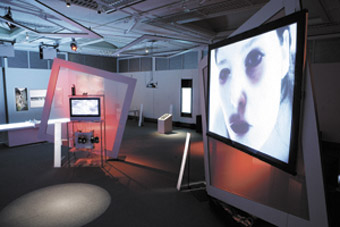
Johanna Reich, front
The one work with emotional depth (albeit uncomfortable) was Johanna Reich’s front (Germany), a video of a young woman fighting an unseen opponent whilst bruises and wounds appear on her from the invisible strikes she receives. The festival chose not to install the sound aspect of front, a language duel that carries the work deeper than the image.
The use of technology by Japanese artists is noticeably rigorous—the best, the latest, the simplest and the most aesthetically pleasing—but many of the interactive forms are by nature rational, employing familiar domestic devices. In contrast, Jonathan den Breejen and Marenka Deenstra’s PingPongPixel ([Netherlands] represented by a video documentary) is completely irrational. It creates an image made of ping-pong balls from any digital image loaded by the viewer. Software analyses and converts the image into black and white pixels. The data of each pixel (colour and position) is represented by an individual ping-pong ball. The software then activates a ping-pong ball feeder (that looks like a huge backyard experiment made of tubes and buckets) and loads the balls into a perspex frame to create a large scale ping-pong pixel image. It appears to take a day for the ping pong balls to load and this grossly delayed satisfaction combined with the sloppy, clunky mechanics of the ball feeder, seems to make a comment about the ‘advance’ of technology. It’s bizarre and hilarious.
Without a strong media dramaturgy that rigorously connects content with forms of interaction and the behavioural psychology of the viewer, interactive art can easily be reduced to mere game play and novelty. Sosu Hockey by Takano Jiro is a prime (bad joke) example of this—a tabletop game in which the player aims to collect as many prime numbers as they can whilst repelling the rest. Why is it in the Art Division? Who can say?
The two works most innovative in form are hanahana by plaplax and Save Yourself!!! (see opening paragraph) by Hide Andrew. hanahana is an interactive scent project where animations of flowers and butterflies, bees, cats, dogs and noses are triggered by an aromatic sensor when viewers squirt aromas on paper leaves.
The beauty of some immersive interactive works is in allowing the viewer to create their own experience or even narrative. Tablescape Plus by Y Kakehi, T Naemura and M Matsushita does this, if nothing else. A white box with a tabletop screen is set with white pieces on which little projections evoke a park scene. There are people, trees, a bench and the sounds of birds, crickets, crows, and trees moving in the breeze. The pieces are movable and the images animate according to the direction, location and quality of movement. The park people turn their backs if moved away, and break into a trot if moved fast.
I create an average day at the park. When I accidentally bump the edges of two park people they bow and greet each other in a high pitched conversation that only stops when they separate. A balding man in an ill-fitting suit and sporting a large moustache bumps into a bench and is immediatly seated on it. I fetch a friend for him to chat with but she chooses to stand behind him. I coax her to sit. She eventually concedes as long as the distance of a scaled meter is maintained. Only silence here—no chatting—and only two at a time on the bench, please. Meanwhile I take a tall blond man as far as a copse where he frightens a flock of birds that erupt across the park. He loiters there for a minute to see if the moustached man will join him. He does, frightening another flock of birds. A lady approaches but turns away when it looks like the blond man is going to pee in the bushes. When I shift a piece quickly the characters get snappy and a heated exchange ensues. It takes a little while for them to settle down and apologise but eventually I leave them bowing eternally to each other.
Japan Media Arts Festival (JMAF), Feb 24-March 2007http://plaza.bunka.go.jp
RealTime issue #78 April-May 2007 pg. 12
© Cat Jones; for permission to reproduce apply to realtime@realtimearts.net
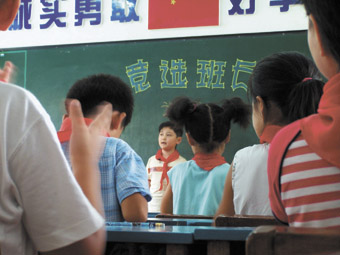
Please Vote for Me
IT’S BECOME SOMETHING OF A CLICHÉ TO SAY THE MOST INTERESTING CINEMA IN THE PAST 15 YEARS HAS COME FROM ASIAN FILMMAKERS, BUT JUDGING BY THE SELECTION AT THIS YEAR’S ADELAIDE FILM FESTIVAL (AFF) THE WELLSPRING OF FERTILE IDEAS, INNOVATIVE STYLES AND DISTINCT SENSIBILITIES SHOWS NO SIGNS OF ABATING. KEY AUTEURS OF THE 1990S SUCH AS TSAI MING-LIANG GO FROM STRENGTH TO STRENGTH, WHILE A STEADY STREAM OF NEW DIRECTORS WORKING IN BOTH FEATURES AND DOCUMENTARIES PROVIDE INSIGHT INTO CULTURES MANY OF US STILL KNOW LITTLE ABOUT, WHILE CONTINUALLY PUSHING THE BOUNDARIES OF CINEMATIC FORM. AS THE SMALL SAMPLE OF THE AFF PROGRAM REVIEWED HERE SHOWS, IT’S NOT THE SENSE OF ANY COHERENT MOVEMENT THAT MAKES THESE FILMS SO EXCITING, BUT RATHER THE PLETHORA OF STYLES AND APPROACHES ON OFFER.
please vote for me
This extraordinary one-hour observational documentary by Chen Weijun looks at the introduction of democracy into a primary school classroom in Wuhan, central China. For the first time, the eight-year-old children are given a choice of three nominees for their class monitor, a position previously appointed by teacher’s decree.
The most charismatic of the three nominees is the chubby Cheng Cheng. By turns underhand, attractively roguish and endearingly vulnerable, he appears to be leading the race for most of the campaign. His main threat is Luo Lei, the son of a local police chief and a former class monitor with a reputation for violence and dictatorial rule that puts most of the children off. His parents aren’t going to let that stop him however, and when his campaign is going badly his father arranges for the entire class to take a free ride on the town’s new monorail, conveniently administered by the local police. The sweetest of the three candidates is Xu Xiaofei, the daughter of a single mother. Annihilated in pubic debates with the more aggressive boys, Xu is reduced to tears when Cheng’s supporters heckle during her first speech.
After a fortnight of speech-making, plotting, free monorail rides and constantly shifting alliances, the candidates make their final statements. Cheng delivers an outstanding performance and looks a shoe-in. In contrast, Luo’s speech is short, abrupt and distinctly unconvincing. But in a stunningly savvy political move reminscent of our own Prime Minister’s Machiavellian cunning, Luo ends by giving individual gifts (provided by his parents) to every child in the class, ostensibly for the following day’s Autumn festival. As an appalled Cheng looks on, Luo is swept to power in a landslide minutes later.
It would be comforting to think Please Vote for Me is about the birth pangs of democracy in a nation that has never known such a concept, and the film does reveal much about the changing face of Chinese society. Cheng sells himself, for instance, as “a manager, not a dictator.” The immense pressure placed on the kids also reflects the repercussions of the one-child policy for a generation of Chinese children. But Chen’s film is so funny and frightening for viewers in the West primarily because it correlates so closely with our own experience of democracy. The blatant manipulation of political players and voters alike is laid bare, and made all the more disturbing for being enacted by children unselfconsciously taking their cues from adults. Please Vote for Me is a small gem which will hopefully get exposure well beyond the AFF.
i don’t want to sleep alone
On the drama front, the AFF was fortunate to have all seven of the films commissioned by Peter Sellars in his role as director of Vienna’s New Crowned Hope Festival. Several of these films were by key Asian auteurs.
I Don’t Want to Sleep Alone sees Taiwanese director Tsai Ming-liang working in his birthplace of Malaysia for the first time, but retaining his trademark narrative minimalism, long takes and fixed frames. The film traces the quietly intense emotional ties that develop between a Chinese-Malay domestic helper and two labourers (one Malay, the other Bangladeshi) living in Kuala Lumpur. Tsai’s stories demand a particular kind of meditative engagement, developing through subtle shifts in the interpersonal relations between characters, and the characters’ relationship to their environment. What initially feels like narrative inertia becomes a slow build towards a breathtakingly moving finale. Tsai’s earlier films such as The River saw his characters trapped in a prison of alienation, but I Don’t Want to Sleep Alone holds out the possibility that meaningful connections are possible—even if they are always fraught with emotional risks.
syndromes and a century
Quite different in style and tone, Apichatpong Weerasethakul’s Syndromes and a Century represented one of the AFF’s most startling experiences. The film begins in a rural Thai hospital, tracing various relationships and emotional cross-currents through a meandering narrative as languid as the tropical setting. After a time, the story unexpectedly starts again, this time in an urban environment. Reflecting the more nervous, dispersive energy of the city, this time the tale takes a more fragmentary course involving many more characters, culminating in a series of puzzling final shots in which the narrative disappears altogether.
Weerasethakul constantly undercuts any sense of forward motion, evacuating all narrative drive with a creeping entropy that sees his characters drifting apart almost as soon as they meet. Yet Syndromes and a Century also displays a distinct lightness of touch and an attractively good-natured quality, creating a unique combination of narrative dispersal with a strangely uplifting tone. The result is so unlike anything I’ve seen before it’s hard to say more after only one look, except to concur with the Special Mention afforded the film by the AFF Jury for its “sheer beauty and radical approach to cinema.” An intriguing work that demands multiple viewings.
feet unbound
Two films at the AFF that were flawed but deserving of mention were Feet Unbound, the debut documentary by Perth-based Singaporean Khee-jin Ng, and How is Your Fish Today?, directed by the UK-based Chinese novelist and filmmaker Guo Xiaolu.
Feet Unbound sees director Ng tracking down six women who took part in the Chinese Communist’s Long March of the mid-1930s, contrasting their stories with a present day retracing of their steps by a young Beijing journalist named Elly. Unfortunately Elly’s presence is somewhat detrimental to the film: we never really get a sense of her investment in the Long March and she comes across as a somewhat superficial character. But the vigour of the ageing women is truly inspiring. It’s a moving testament to their toughness and will to survive that they have managed to outlive their tormentors—‘friends’ and foes alike—and tell their stories with such vitality and force.
how is your fish today?
How is Your Fish Today? is a strange, Pirandello-like work focussing on the rather banal life of Beijing scriptwriting Hui Rao, who ‘plays’ himself on screen. All of his film scripts have been banned by the censor, so Hui makes a living writing TV soaps. He escapes his solitary existence by living vicariously through one of his characters, who is fleeing across China in a script inspired by long-running TV series, The Fugitive. How is Your Fish Today? is an odd mix of documentary, hesitant drama and essayistic self-reflection, although it’s unclear how much of the scriptwriter’s situation is based on his real life. The film is certainly intriguing, but undermined by the fact that Hui ultimately seems to have very little to say, other than expressing a rather common place desire to escape his mundane daily routine. But perhaps this is the film’s point—more than anything it seems to be about the frustration of longing for transcendence through art, but remaining firmly grounded through sheer lack of talent.
The films mentioned here represent only a fraction of the quality works on offer in Adelaide this year. Over the course of three festivals, director Katrina Sedgwick and her team have built one of the most innovative film programs in the country—a selection that places unusual, eye-opening works by emerging talents alongside the latest features from cinema’s contemporary masters. On both counts, the endlessly diverse works coming from Asia continue to challenge audiences’ conceptions of what cinema can be.
Adelaide Film Festival, director Katrina Sedgwick; Adelaide, various venues,
Feb 22-March 4
RealTime issue #78 April-May 2007 pg. 17
© Dan Edwards; for permission to reproduce apply to realtime@realtimearts.net
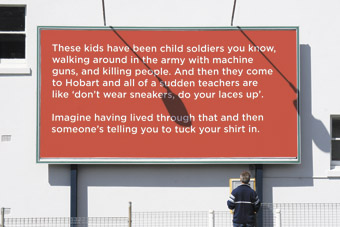
the write/here project, Justy Phillips, James Newitt
Ten Days on the Island is an engaging and entertaining aesthetic experience that brings together hundreds of local artists and reflects on the lives of many more Tasmanians. Dream Masons, the magical spectacle that took over the Salamanca Arts Centre revealed the possibilities of large scale performance with committed volunteers working with professional artists. The write/here project with its 27 billboard works across Hobart gave voice to some of the city’s inhabitants. The Port Arthur Project saw 25 visual artists respond to a morally and aesthetically complex historical site. Homage was paid to lives in remoter parts of Tasmania in Big hArt’s Drive-in Holiday, Silkwood’s Maria Island of Dreams and is theatre’s Queen of the Snakepit (about Flinders Island). An Other Place in the Long Gallery revealingly juxtaposed works by Tasmanian and Irish artists. And the Tasmanian Art Gallery & Museum celebrated the work of one local artist Leigh Hobba—a rewarding show that demands to be seen elsewhere in Australia.
As in all festivals, some works fared better than others, but few appeared short of audiences. Some, like Tasdance’s Mercy seemed oddly conceived but proved curiously memorable. An eccentric new work like Queen of the Snakepit has plenty of room to develop while Robert Jarman’s Spectre of the Rose could have been all the more powerful had the performer-audience relationship been more precisely addressed. Once Dream Masons got past its long, sluggish scene setting, it accelerated into the work we were hoping for, where its virtuosities were not lingered over and the pace matched its cartoonish conception. Hopefully it will prove a model for ambition in Hobart’s performing arts scene.
It’s easy to think of Ten Days as a string of one-person or small cast shows in theatres and intimate gallery showings and the Spiegeltent-style Crystal Palace cabaret events, but artistic director Elizabeth Walsh has cleverly contrived to bring many into the festival’s fold with the large scale works mentioned here and seen in streets, in galleries and across the island. The RealTime team enjoyed contributing to Ten Days with our admirable team of five emerging reviewers who worked day and night to produce reviews indicative of the range and quality of an idiosyncratic festival. Eds.
RealTime issue #78 April-May 2007 pg.
© RealTime ; for permission to reproduce apply to realtime@realtimearts.net
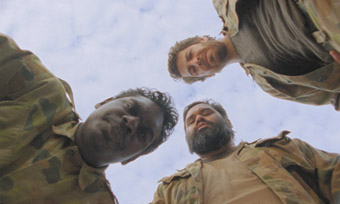
Lucky Miles
THERE WAS A HEALTHY SLICE OF AUSTRALIAN FEATURE FILM PROGRAMMING AT THE ADELAIDE FILM FESTIVAL WITH SOME HEARTENING PRODUCTIONS SUGGESTING AN ACCEPTABLE VINTAGE FOR THE INTERNATIONAL FESTIVAL CIRCUIT: INDEED, THERE HAVE ALREADY BEEN SOME NOTABLE AUSTRALIAN PREMIERES AT BERLIN AND SUNDANCE.
While there was no evidence here to hint at a box office breakout hit (admittedly I missed Cherie Nowlan’s Clubland), a film festival working to an art cinema agenda is unlikely to unearth another Kenny (Clayton Jacobsen, 2006). It is also worth noting that the scheduled release date for many Australian features again seems to be August-September. Local distributors appear to be still pushing for a crowded schedule to gain some exposure prior to the AFI Awards, risking several films being lost in the mass. However, if I can generalise, there is a continuing steady incline in overall quality and a wider and more pragmatic acceptance of low budget methodologies, both in the agency funded programs and privately financed projects.
lucky miles
The festival opened with Lucky Miles with first-time director Michael James Rowland staking a claim for a new genre, at least in this country: the refugee road comedy drama. The premise of the film—an Iraqi, a Cambodian and an Indonesian trekking across Western Australia in search of civilization and sanctuary after being smuggled and dumped on a remote bit of coastline—doesn’t exactly drip with commercial potential, but is an intriguing platform for some piquant social commentary. Tonally, the film walks a line between mild farce and emotional drama and for large sections runs the risk of turning into a twee, old fashioned quirky romp. Ockerish whimsy is too prevalent in the Army Reserve unit on the tail of the refugees, while the fugitives themselves engage in occasionally predictable cultural clashing (both with each other and their new landscape) and lessons in harmonious team work. In the end, some assured filmmaking and a satisfying climax take Lucky Miles a notch above a “comedy of issues” to be a warm, engaging film.
west
Although Dan Krige’s West is a product of the AFC’s high profile, low budget development and production laboratory Indivision, the script’s incubation stretches far beyond the recent workshopping environment. Having written a first draft in 1986 and completing something approximate to the shooting script in 1994, Krige’s tale of two male cousins clashing over the same girl in Sydney’s western suburbs is his self-described “baby.” Beneath the drug deals, teen sex and street violence, West is another coming-of-age story, albeit in a much more interesting milieu than, say, the sleepy coastal town of Indivision sister project Caterpillar Wish (Sandra Scriberras, 2006). West is a good account of the genre, frankly portraying limited life options given to the characters whilst gaining the most production value possible out of the budget (approximately $1.2 million).
boxing day
As discussed in the RealTime interview with director Kriv Stenders (RT 77, p17), his new production, Boxing Day is unusual in two key facets: the film was solely financed by a state government funded event (AFF) without a marketplace attachment in place, and was shot based on an outline and an intensive rehearsal period rather than a full draft script. The finished film, about a man on home detention attempting to reconcile his shattered family, is highly effective in its authenticity and sustained heavy drama. The cast of non-actors are credible with sensitive subject matter, and the experiment of shooting the film ostensibly in one extended handheld take contributes to Boxing Day’s relentless drive.
court of lonely royals
Yet another debut feature, this time from Melbourne-based Rohan Michael Hoole, is the dystopian hitman film Court Of Lonely Royals. Emerging from the private finance route, the film has a stylised storyline and heavily aestheticised visuals, heavily channeling the spirit of Wong Kar Wai’s Fallen Angels (1995). Hoole happily confesses to adoring Wong and Chris Doyle’s work, and should be commended for the energy and talent on display here; Melbourne’s streets and cafes host a hyperrealist nightmare populated with young nihilists.
the home song stories
The Home Song Stories, Tony Ayers’ second film, is a combination of heart on the sleeve autobiographical indulgence and sluggish melodrama. Loosely based on Ayers’ childhood, the film is about a dysfunctional Chinese family with an unpredictable matriarch. The story is bookended by the ham-fisted cliché of having Ayers’ alter ego, a middle aged writer, type out his life story as a nostalgic voice over launches the extended flashback sequence that forms the main narrative. While it is good to see a rare mainstream artistic space for the Chinese-Australian experience, and the setting of seventies suburbia is lovingly recreated, The Home Song Stories never gets beyond the dramatic gear of a mid-range telemovie.
dr plonk
Prolific low budget auteur Rolf de Heer launched Dr Plonk, a silent, black and white sociopolitical satire as the closing night film. In an environment where even raising soft money for safe projects is a major stumbling block for local producers, it is a mark of de Heer’s current standing within the industry that he can make a freewheeling Chaplin/Keaton homage. It is fitting that Dr Plonk closed the festival, as it is very much an ‘event’ film, celebratory, light-hearted and in this instance invigorated by live music accompaniment composed by Graham Tardif and performed by Stiletto Sisters. A mad scientist from 1907 turns doomsayer when his calculations predict the world to end in 2008, and he builds a time machine to acquire proof. What follows is well-timed slapstick, much more difficult than it sounds, as Plonk travels to and fro throughout history, but the satirical elements of the film regarding environmentalism and political commentary are a little straightforward and overt. Nevertheless, Dr Plonk will go down as one of the genuine curios of the Australian canon.
AFF has a vested interest in showcasing Australian film: they have a literal stake in some of the projects in the form of their equity investment. Compared with other national festivals where the local content is sometimes marginalised, the 2007 AFF program is rigorous and inclusive, and the crop of low budget fare displays, on the whole, an array of promising talent.
Cherie Nowlan’s Clubland will be reviewed in a future edition of OnScreen. Ed.
Adelaide Film Festival, director Katrina Sedgwick; Adelaide, various venues, Feb 22-March 4
RealTime issue #78 April-May 2007 pg. 19
© Sandy Cameron; for permission to reproduce apply to realtime@realtimearts.net
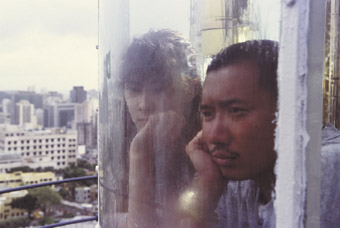
Isabella
INVIGORATING IN THEIR ENERGY AND ECLECTICISM, THE BATCH OF FEATURES FROM ASIAN FILMMAKERS AT THIS YEAR’S ADELAIDE FILM FESTIVAL ORIGINATED FROM A WIDER GEOGRAPHICAL REGION RATHER THAN FROM A SPOTLIGHT ON ONE PARTICULAR NATION. TO MATCH THIS DIVERSITY THE FILMS THEMSELVES CAME FROM ALL GENRES AND WERE AIMED AT VARIOUS AUDIENCES. THE PROGRAM INCLUDED SOUTH KOREA’S BIGGEST EVER BOX OFFICE SUCCESS ALONG WITH SOME GENUINE ESOTERICA. IT IS PERHAPS UNSURPRISING THAT ONE OF AUSTRALIA’S CHIEF CHAMPIONS OF NEW ASIAN CINEMA AND LONGTIME REALTIME CONTRIBUTOR, MIKE WALSH, HAD SIGNIFICANT INFLUENCE IN SHAPING THE PROGRAM.
invisible waves
Pen-ek Ratanaruang’s new feature, Invisible Waves, was always going to be compared with his breakout hit, Last Life in the Universe. Another collaboration with Australian cinematographer Christopher Doyle and Japanese star Asano Tadunobu, it’s startling in its own fresh way. Straddling locales in Macau, Hong Kong and Phuket, Ratanaruang has constructed a low-key surrealist film noir about karma. Balanced by Tadunobu’s portrayal of a criminal who is also a chef and epitomises existential cool, Invisible Waves is a contemporary Dante’s Inferno infused with Asian art cinema aesthetics and the downbeat mystery of 50s gangster productions. It sounds a heady cocktail, and it is: the story of a low life who murders his boss’s wife and then goes on the run takes on the symbolism of a descent into hell when the gangster uses a derelict cruise ship as his mode of escape. There are bizarre passengers and mysterious malfunctions, walls smeared with mould and blood, and strange hummings that permeate the cabins. Combined with Doyle’s lush compositions and elaborate, smooth camera movement the world Ratanaruang constructs is completely transporting.
isabella
One of the brats of Hong Kong cinema, Pang Ho-cheung, has produced his most mature work to date. Although the premise sounds tawdry—a prostitute wakes up in bed with a hard-living cop and promptly announces that she is his daughter—the film shifts direction altogether to become an interesting inversion of the family melodrama. Featuring Cantopop star Isabella Leong in the lead role, this is no exploitation piece, but an assured relationship study that reveals the emotional underbelly of the archetypal hard-boiled policeman. The backdrop of the handover of Macau’s handover to China lends a sense of confusion and displacement to the main action.
the host
If you needed a reprieve from the contemplative pacing of the rest of the program, Bong Joon-Ho’s The Host was a stiff antidote: an enjoyable monster movie with some intellectual layers. While it doesn’t quite have all the allegorical properties others claim for it, there is no doubt about its visceral thrills, and it bears all the hallmarks of a project that will have an immediate remake in California on ten times the budget. Many years after a US chemical facility dumps hazardous waste in the Han River a mutant creature emerges to wreak havoc and spread a deadly disease. Something like a tooth-and-taloned tadpole the size of an elephant, Bong’s monster’s lithe initial appearance on the riverbank will be a cherished scene for many of the genre’s fans. Apart from the environmentalist, anti-American themes running throughout, the film becomes what Bong considers a family drama after a young girl is abducted by the monster and her father, uncle, aunt and grandfather embark on an amateur vigilante mission.
still life
OnScreen has already dedicated extensive coverage of Jia Zhangke’s masterwork Still Life (RT76, p22), and politically and critically, one of the most important films of the last year. The inaugural jury for the AFF Natuzzi Prize agreed, awarding the $25,000 to the Chinese director. Jury president and co-director of the Toronto Film Festival Noah Cowan stated that the film was selected “for its bold, powerful artistic vision. It asks an urgent question: How do we value human life in the face of economic and cultural upheaval?”
exiled
Johnnie To has constructed a career on making Hong Kong action genres palatable to the tastemakers of European festivals, and also manages to produce multiple projects each year. While his latest film, Exiled, could be considered a reprise of his 1997 classic, The Mission, it is probably not as strong an example of the craft of the hitman film. However, there is much to savour here for connoisseurs. While the setup is familiar, a man is targeted by two assassins for failing to complete a hit on a local crime boss while two other hitmen set out to protect him, what follows is not. After a brief gunfight, all of the men, who turn out to be longtime friends, prepare an elaborate dinner together and sit down to talk through their issues. When they eventually band together to challenge Macau’s gangland leader, the film becomes a stylised aria on friendship, with several operatically arranged action sequences.
woman on the beach
Hong Sang-soo has established himself as one of Asian cinema’s more reliable auteurs, producing consistently high quality work on similar themes. Woman On the Beach continues his preoccupation with sexually predatorial males coming face to face with their own superficiality. Set in the foggy, spectral western coast of South Korea, Woman on the Beach follows a film director who goes to a seaside resort ostensibly to finish his latest script but ends up pursuing two women who are also staying in the town, one of whom is his best friend’s girlfriend. As his journey unfolds it becomes apparent that the women are the richer, more complex characters. Shot with almost exclusively long takes and making best use of the soft white light of the coastal area, this is an elegantly told film punctuated with moments of playfulness.
opera jawa
In a timely reminder that Western narratives often dwell in narrowly confined spaces and that there are many alternative modes of storytelling, comes a dazzling musical from Indonesia in the form of Opera Jawa (Garin Nugroho, 2006). Although using traditional puppetry and folk theatre, the film is never less than extremely cinematic in a chain of colourful set pieces marked by intricate set design and staging. The story, a reinvention of an ancient Indonesian tale, is universal: two men from different classes are in love with the same woman. How the story is presented here via gamelan music, acrobatic dance and puppetry is unique in global cinema, and while the film is overlong, its sheer spectacle is continually impressive.
These are just some of the films in a strong collection, a healthy mix of genre films and art cinema fare providing a well rounded representation of the Asian cinema zeitgeist, The blend of festival-favourite auteurs sprinkled with the less experienced directors felt about right.
Adelaide Film Festival, director Katrina Sedgwick; Adelaide, various venues, Feb 22-March 4
RealTime issue #78 April-May 2007 pg. 18
© Sandy Cameron; for permission to reproduce apply to realtime@realtimearts.net
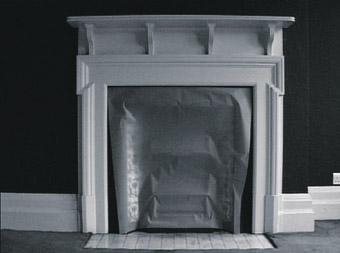
Draw (fireplace), 2005, video still, Anna Barriball (UK)
Courtesy the artist and Frith Street Gallery, London
Draw (fireplace), 2005, video still, Anna Barriball (UK)
MOVIES AND FLICKS COME FROM THE REALMS OF SUNDAY AFTERNOON, FROM THE WORLDS OF DATES, DISTRACTION AND TRANSPORT FROM THE EVERYDAY. THIS EXHIBITION OF VIDEO WORKS AT THE CONTEMPORARY ART CENTRE OF SOUTH AUSTRALIA, FRAMED BY ITS TITLE, SCARY MOVIE, AND PRESENTED AS PART OF THE ADELAIDE FILM FESTIVAL, MAY FRIGHTEN VIEWERS IN ITS DISTANCE FROM SUCH PLEASURES. TAKEN TOGETHER, THE WORKS IN THIS EXHIBITION RUN FOR NEARLY THE LENGTH OF A MOVIE. I STUMBLE INTO THE SUNSHINE WITHOUT A HAPPY ENDING.
First up is Mark Boulos’ Gates of Damascus (UK), a documentary following the experience of Mayrna Nazzour, who regularly manifests stigmata over the Easter weekend. The occasional wobble of the camera suggests that we are watching real events, captured as they unfold. Mayrna addresses us directly only once, and then we take our place amongst the hordes who have come to watch, record and feel some connection. The recording of the miracle on video gives us some contiguity to a moment (a scraping of the experience, recorded and hoarded like those of the oil and sweat that are carefully harvested from Mayrna’s skin). I wonder if I can claim to have experienced a miracle. Is a miracle only real when viewed with faith?
In contrast, Anna Barriball’s Draw (UK), a projected image of a fireplace, has a specificity that could have come from an old house much like the gallery in which it is situated. The only movement involves a semi-transparent sheet of paper hung over the mouth of the fireplace. It is sucked in and out, accompanied by the amplified sound of its regular, crumpled breathing. The quiet whimsy of this work snares me. Is the fireplace breathing? Is the whole house alive? Is it the house I walk through now? The whole gallery? The strength of the work is in its unwillingness to fully settle into any of these possibilities and thus it quietly tears at certainties we might have about the space through which we are moving.
Erik Bünger’s Gospels (Sweden/Germany) presents a stream of documentary-style talking heads (predominantly American celebrity actors) who one after the other exult a mysterious ‘he’ in an endless tirade of praise. Each describes ‘his’ qualities, with unwavering belief in the goodness of ‘him.’ The religious overtones extend to the actors’ body language of closed eyes and raised hands. This is the gospel according to Hollywood, pointing its funny, cynical finger at those who hand down truths in a screen media saturated culture. Shot at various times, only changes in video quality and fashion subvert the work’s almost seamless construction, allowing the possibility for artifice to creep in—how are we to know if they’re sincere? They’re actors after all.
The artifice in Mark Wallinger’s Sleeper (UK) seems clearly spelled out: a man in a bear suit wanders through an empty urban space at night; we watch him through glass. His patchy ill-fitting suit shows all its stitching; socked feet poke out. Similarly, the grainy hand-held camera work proclaims that this is not a filmic experience constructed for the viewer, but the recording of a ‘real’ event; the wanderings of a fake bear. The footage is from a real-time stream between the German Embassy in London and the Neue Nationalgalerie in Berlin, where Wallinger donned the suit. The bear seems beaten down by the weight of references he carries: German history, mysticism and a small nod to Joseph Beuys. For twenty minutes Wallinger perseveres with his lacklustre impersonation, putting the viewer in the awkward position of simultaneously suspending disbelief and accepting the artifice.
In his curatorial essay Richard Grayson references the work of Georges Méliès, magician and filmmaker, whose early experiments delighted and terrified viewers. Méliès wrote, “when anyone can photograph the ones dear to them…then death will no longer be absolute.” Scary Movie uses the screen to expand the boundaries of lived experience by disrupting and re-defining the absolutes conjured by the very existence of the moving image. By the end of my viewing of Scary Movie, the ‘real’ in its old solidified, embodied form shifts and flickers uncomfortably.
Scary Movie, curator Richard Grayson, artists Mark Wallinger, Anna Barriball, Mark Boulos, Erik Bünger; CACSA, Adelaide, Feb 23-April
RealTime issue #78 April-May 2007 pg. 20
© Sasha Grbich; for permission to reproduce apply to realtime@realtimearts.net
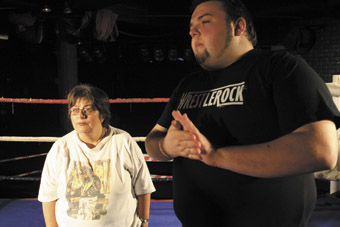
Sue Chuter with Bulldog, Lovestruck
photo Eron Sheean
Sue Chuter with Bulldog, Lovestruck
THE SILVER SCREEN GLOW OF 1960S WRESTLING FOOTAGE, THE ELEGANT RASP OF JACK LITTLE’S COMMENTARY (A GRAHAM KENNEDY ERA CHANNEL 9 STALWART OF US ORIGIN) AND PHILIP BROPHY’S REFLECTIVE SCORE (RECASTING THE LYRICAL GUITAR STYLE OF DUANE EDDY, THE SHADOWS ET AL FROM THE SAME PERIOD) PROVIDE AN IMMERSIVE OPENING TO MEGAN SPENCER’S 52-MINUTE DOCUMENTARY WHICH PREMIERED AT THE PERTH AND MELBOURNE INTERNATIONAL FILM FESTIVALS IN 2006, AND IS NOW ENJOYING CINEMA RELEASE.
Watching wrestling wasn’t my thing as a kid—there was a short-lived foray into stock cars and motor bike racing at Adelaide’s Rowley Park—but Megan Spencer’s Lovestruck about one woman’s proud, obsessive fandom for American wrestlers certainly begins with a subtly nostalgic arm-twister, a certain distance created by holding back the crowd noise and allowing the guitars to drift dreamily alongside the theatricalised violence…But then we’re plunged into the world of Sue Chuter, the images raw, handheld, immediate and interspersed with wrestling footage.
We see Chuter at home with friends: the subject, her wrestling obsession. “I’m the craziest of the bloody lot.” Later we’ll take in more of the house: wall to wall wrestling clippings, photographs and posters in every room including the toilet. Asked about having access to the phone numbers of her American heroes Chuter asserts: “it’s a personal relationship…I’m not just a fan.” It’s this that becomes a Lovestruck theme: just how meaningful is Chuter’s connection with these famous men. But first cut to Mick Foley being brutalised with barbed wire in a TWA Japan broadcast match (part of her voluminous watching, seen here with a large group of friends). Cut to Chuter phoning birthday wishes to her ‘king’, the American Jerry Lawler, former champion and now commentator and writer. A message machine responds. Spencer asks if the wrestlers ever call back. Chuter chortles, “No! I’d totally freak out!”
Chuter is revealed to be a successful fan: yes, she too must on occasion queue for autographs, but the champions mostly recognise her, are often affectionate and Lawler announces her presence to the match crowd. This fandom is a totality and, for all its gutsiness, an almost atherial lifestyle—how Chuter can afford it (including a trip to the US, investment in memorabilia), whether or not she works, these are not addressed Spencer compounding a sense of a self-contained world. But there are many fascinating, palpable details.
We glimpse Chuter at a small local match, on her feet between the ring and the crowd, yelling. Later she’s in the ring and then hurling something at the crowd. These are the only moments we witness some of the aggression which must surely be part of her fandom. But Spencer leaves it at that while busily capturing the sweep of everyday wrestling life—and it’s often funny. We see Chuter at workouts, at press calls (mini-matches in themselves) wielding her own camera and at post match raps—the poetry of defiance and defeat. Old footage is inserted of a young, bloodied Playboy Gary Hart (“Sue once thought he was the only man she ever loved”) threatening to set his mother on his defiler. We learn too that in the 70s Sue became a ‘ring rat’, wrestling parlance for groupie. It’s not returned to, becoming subtext perhaps for the intimacy, albeit limited, she shares with some of her heroes.
As in many a documentary, from the clunky outpourings of the Biography Channel to the measured formulae of Australian Story, we’ve got a pretty good idea that in Lovestruck first up we’ll get a slice of the life, a solid impression of the subject before the voiceover or the intertitle anounces, “So and so was born in X on…” and the life narrative kicks in. Here it’s “1996 World Championship Wrestling, Festival Hall Melbourne, where it all began for Sue Chuter.” Second tack: something psychologically contrapuntal. Is Sue Chuter’s fandom, which she sees as providing ‘family’, a real life given that she lost her chance at actual family many years ago, leaving her daughter with the husband of a short-lived marriage? And with the commencement of the life story somewhat melancholy, aetherial female voices wordlessly chorus against rippling guitars.
The daughter, now 21 and with a child of her own, seeks out Sue (significantly it’s not the other way round) and there’s a happy enough reunion for several years. But now the film, and Chuter’s life, has entered a melancholy phase. Sue throws Rhonda a 21st birthday party, a happy occasion for the daughter, but Sue herself is emotional, largely detached from the other guests in the pub and mostly ignored, interrupted even, when she delivers her prepared, heartfelt birthday speech of reconciliation. This doesn’t feel like family. Rhonda believes her mother has immersed herself in wrestling as a substitute. We suspect otherwise: in the 1973 marriage her husband banned her from going to wrestling. Later it’s mentioned, without explanation, that Sue and Rhonda have separated again.
In the meantime, Sue’s been to America. We sit through her video of snowy Hartford, New York, Memphis etc, wondering why (a rare moment of repose perhaps) until she reaches LA, meets her always respectful heroes, all pictures of unbattered, glowing good health, and experiences her first WrestlingMania match, with a 16,000 strong crowd. It’s here we see another of Lovestruck’s ‘face in the crowd’ motifs. The image of the crowd darkens and a small circle of light wanders across the screen to pick out Sue. She’s well behind Lawler at his commentary desk, but as ever, very well placed for the big show. It’s a poignant if loaded moment—and we don’t know if it’s Spencer’s contrivance or Chuter’s own, given that the highlighting device is otherwise atypical of the film.
In the one sustained scene with a Chuter hero, we join Spencer and Sue at Melbourne airport to meet Jerry Lawler. There are repeated hugs, he seems genuinely affectionate, and prefers to see her as devoted rather than obsessed, but there’s clearly a limit to the time he can spend with her. She cries in Spencer’s arms. Is she momentarily overwhelmed or, as the film’s contruction hints, is there a limit to how much meaning fandom can offer? There’s the bouyant moment when Lawler singles her out at the match where she stands amidst the media mob, but soon we see Chuter married, this time to a UK wrestling fan. A compensatory act? Maybe, but he lives in the UK. They apparently keep in close touch by phone and text messaging.
Even though conventional family life has evaded Chuter, or she it, and a certain melancholy is sensed about the later years of her commitment to wrestling, Spencer is portraying a life still unfolding and it’s certainly one in which being a fan is, in the end, paramount. If there are complexities in Chuter’s personality, we don’t witness them. Her utterances about her life are blunt and, like wrestling lingo, doubtless oft repeated: “I’m rebellious in my own way…I’m eccentric….moreso since I met the wrestlers…otherwise I would have had a boring life…I like the blood and guts and the solidly built men…the wrestlers have a strong sex drive and they need comfort and companionship.” Lovestruck’s air of escalating pathos simply and effectively says that no state of being, be it fandom or fame, can completely satisfy, and is always subject to other forces. We are, however, left in no doubt about Chuter’s ongoing passion and we guess that she wouldn’t want us to feel sorry for her—as she adamantly declares earlier in the film when asked about the 1973 rape that was prelude to her marriage.
Asked about fandom, the late Vern Sundfors, an independent filmmaker whose footage is used in Lovestruck, comments in words to the effect that there’s not a lot to be said, but if it’s somewhere you “prosper in” and brings calm, that’s enough.
Lovestruck, director, camera, producer Megan Spencer, editor Julie-Anne De Ruvo, composer Philip Brophy, producer Rosemary Blight, RB Films, 2006
RealTime 79 will feature an interview with Megan Spencer, now director of Revelation, the Perth International Film Festival. Former director, Richard Sowada is moving to Melbourne’s ACMI.
RealTime issue #78 April-May 2007 pg. 20
© Keith Gallasch; for permission to reproduce apply to realtime@realtimearts.net
IF THIS YEAR’S AUSTRALIAN INTERNATIONAL DOCUMENTARY CONFERENCE (AIDC) LACKED SOME OF THE UPBEAT BUZZ OF THE EVENT IN ADELAIDE TWO YEARS AGO, PERHAPS IT’S BECAUSE MANY OF THE PROFOUND CHANGES TO THE DOCUMENTARY SECTOR PREDICTED IN 2005 NO LONGER SEEM QUITE SO RADICAL. NEARLY EVERY PROJECT IN THE PITCH SESSIONS, FOR EXAMPLE, TOOK AN ONLINE COMPONENT FOR GRANTED; THE MORE SAVVY PRODUCERS WERE TALKING OF MULTI-PLATFORM EXTRAVAGANZAS INVOLVING FILMS, WEBSITES, GAMES, REAL-WORLD COMPONENTS AND VIRAL MARKETING CAMPAIGNS.
Whether the possibilities of this brave new digital world are actually being realised in Australia is another matter, relating back to two depressingly familiar concerns that kept cropping up at this year’s conference: a lack of funds in the documentary sector and the claim that too much power rests with a handful of local broadcasters.
terms of trade controversy
The friction at the conference was set in the opening keynote by UK PACT Council Chair Alex Graham (PACT is Britain’s producers’ association). Graham outlined a drastic shift in the terms of trade between independent producers and broadcasters that has underpinned a recent boom in UK documentary production. Since 2004 UK producers have retained most rights on the programs they make—investment now simply gives broadcasters UK television rights for five years. This has provided producers with a financial incentive to actively sell their programs across different platforms and territories, as well as pursue spin-off products such as books. According to Graham, the new terms of trade have seen £500 million flooding into UK independent documentary production, fuelling an annual sector growth rate of seven per cent. The arrangement has had a positive effect on Britain’s terms of trade, fostered the accrual of capital for producers and increased employment—all at virtually no cost to government.
As Graham pointedly noted, this is a fundamentally different model from the one used in Australia, where funding bodies and broadcasters generally take all rights in all territories in exchange for investment that rarely covers the full cost of production. Using Film Australia’s terms of trade as an example, Graham argued that the philosophy underlying Australian funding models was more suited to the UK of the 1970s, or even the Soviet Union! He pointed out that project-by-project funding in exchange for universal rights simply provides no means for producers to build sustainable businesses.
Needless to say, a model which shifts power away from broadcasters and government agencies was always going to ruffle feathers, and the ABC’s Head of Television Kim Dalton made a stinging rebuke to Graham’s keynote in a speech at the AIDC opening drinks. It was unclear why Dalton thought the UK approach would be incompatible with the Australian production sector, although he later stated in The Australian that the tax rebate currently being considered by government to attract greater private investment in the local film industry would have been a more appropriate keynote topic (Sandy George, “Filmmakers edged out of the picture”, March 1).
Perhaps the most important lesson for Australia in Graham’s keynote was the fact that the UK terms of trade are the result of years of patient, sustained lobbying by a unified industry. In contrast, the ‘Great Debate’ immediately following Graham’s speech brought all the familiar fault lines running through the local industry to the surface. The topic was “Is government agency delivery of public funds stifling Australia’s content creation industry?” The attitude of Nick Murray of Cordell Jigsaw Productions, opening speaker for the affirmative, revealed why coherent industry lobbying is difficult. Murray argued that government bodies not only stifle creativity, they suck the life out of producers and embalm them. His proposed solution—shutting down all the funding bodies and giving the money to the broadcasters—ignored the fate of the non-documentary sector in such a model. Producer Michaela Perske, as the second affirmative speaker, passionately echoed Alex Graham’s keynote in proclaiming that “content providers need to be set free.” Meanwhile, the negative team of the FTO’s Tanya Chambers, the ABC’s Dasha Ross and the FFC’s Brian Rosen ran a routine set of ripostes, which at least made the point that the main factor stifling the industry is a basic lack of funds. The suggestion was made by both sides that there are simply too many filmmakers—hardly helpful since New Zealand manages to sustain a similar-sized documentary sector with one-fifth of our population, as the final affirmative speaker Chris Hilton pointed out. Nobody got to the core problem of a fundamental lack of investment in the Australian creative industries.
small voices, prophetic films
After the drama of AIDC’s opening day, it was deeply refreshing to begin day two with some films and a panel of filmmakers. The Podlove launch saw five five-minute documentaries examining the impact of technology on our lives and relationships. The series is a joint initiative between SBSi and the Australian Film Commission. The standout Podlove project was Virtual Freedom by Gef Senz, a simple but heart-wrenching story about a Burmese dissident living in Melbourne. While Senz’s film was a personal favourite, all the Podlove works were surprising and highly entertaining.
In contrast, most of the other sessions at AIDC 07 were dominated by commissioning editors and agency representatives—a sign of the conference’s increasingly market-orientated tenor. One important exception was the Perspectives on Alternative Voices session on day four. Filmmakers Dan Monceaux and Khee-Jin Ng (whose Feet Unbound screened at the concurrent Adelaide Film Festival) showed excerpts from their work and discussed how they produced their self-funded low-budget films. However, it was Safina Uberoi’s input that was most revelatory. She screened segments from a film that grew out of her attempts to make a documentary in the early 1990s about Islander youths living in the Sydney suburb of Macquarie Fields. She eventually decided to give the camera to the boys and let them represent themselves, resulting in a fascinating and disturbingly prescient depiction of life in a suburb recently racked by violent social unrest. Yet when Uberoi took the film to the ABC, they rejected it on the grounds that they “couldn’t understand the boys’ accents.” Uberoi concluded her talk with a five-minute work made by a child in a refugee camp in Lebanon, one of nine films made by children there with the help of an aid worker using low-cost technology. Uberoi summed up the feeling of the session by concluding that digital technologies are allowing the articulation of “small voices to which we need to become much, much more sensitised…these people are prophets.”
limited means, internecine struggles
If there was an overall impression created by AIDC this year, it was of an industry hamstrung by limited means, but also perhaps limited in its ability to find more effective ways of operating and lobbying for change. Space precludes further discussion here, but there were several sessions following on from Alex Graham’s keynote that gave the sense that Australia is increasingly falling behind the rest of the world in building sustainable creative industries in the digital age. Unfortunately, rather than fuelling a coherent push for change, the lack of capital in Australia’s creative sector all too often generates internecine struggles that do little to address the fundamental issues holding us back.
Australian International Documentary Conference, Adelaide, Feb 23-26, 2007, www.aidc.com.au
RealTime issue #78 April-May 2007 pg. 22
© Dan Edwards; for permission to reproduce apply to realtime@realtimearts.net
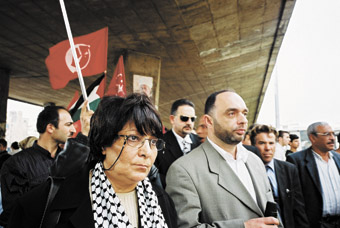
Leila Khaled: Hijacker
WE'VE HAD TO WAIT ALMOST TWO YEARS SINCE THE LAST CURATED SHOWCASE OF FILMS FROM THE ARAB WORLD TO TAKE PLACE IN SYDNEY. A MONTH-LONG PROGRAM OF SUNDAYS IN PARRAMATTA, WITH AN EXUBERANT SELECTION OF PARALLEL EVENTS, THE THIRD SYDNEY ARAB FILM FESTIVAL DELVED DEEP INTO THE RELATIONS BETWEEN FILMMAKING, POLITICS AND THE ART OF SELF-REPRESENTATION. ORGANISERS PLAN FOR THE FESTIVAL TO EMERGE INTO A STRONG AND SUSTAINABLE ENTITY IN ITS OWN RIGHT, AND A HIGH PROFILE EVENT ON SYDNEY'S ANNUAL CULTURAL CALENDAR.
Incubated and driven by Information and Cultural Exchange (ICE), the festival upheld an impressive array of partnerships and a feast of offerings with everything from Bedwin Hacker, the low-budget chick flick from the Maghreb, to Ghassan Salhab’s Beirut-bound allegorical thriller The Last Man. There was an exuberant Egyptian showcase in partnership with the Egyptian Consulate. There were audio-visual experiments at the Liverpool Regional Gallery curated by Khaled Sabsabi in association with Casula Powerhouse. There was even a matinee program for schools featuring the very Aussie comedy Jammin in the Middle E, about growing up Arab in Western Sydney, starring local hip hop artists Matuse and Nomise.
Notwithstanding all this diverse and stimulating work on show, we were left in no doubt that the curatorial heart of the Sydney Arab Film Festival lay with the documentaries. Central to the impact of this work on the festival as a whole was the decision to bring Nizar Hassan and Eliane Raheb, two key figures fostering documentary filmmaking practice in the Arab world to Sydney for the festival.
Hassan, an established Palestinian filmmaker, presented two works at the festival. Ostura/Fable collected the astonishing, fragmented and everyday stories of three brothers dispersed by the creation of the state of Israel. Hassan spoke about his decision to regularly enter the scenes he was shooting, alerting the audience to his own subjectivity, and stressed the necessity of a documentary filmmaking practice that allows the film’s subjects to lead the way.
In Ejteyah/Invasion, Hassan entered his own scenarios under different conditions. For this film, he shot and edited footage of the last days of the 2002 Israeli invasion of Jenin, meeting many of the refugee camp’s inhabitants. He then invited an Israeli soldier who had been driving one of the bulldozers during the incursion to be filmed viewing this footage. In the viewing room with the soldier, Hassan sat just behind his spectator, pausing to ask questions as the frame of Ejteyah/Invasion kept shifting between them watching and a full screen presentation of the astonishing footage taken in Jenin.
Foregrounding the act of spectatorship, not only the Israeli soldier’s but also his own, Hassan opened a space in which the audience could begin to judge not just the soldier but the filmmaker too, making himself a character in his own film. By extension Hassan was asking us to examine the impact of viewing his incredible footage.
Investigating the effect of being a spectator to the documented suffering of others lay at the heart of the two documentaries presented by Lebanese filmmaker Eliane Raheb, the first of which also dealt with the situation in Palestine.
So Near, Yet So Far explored the impact of the broadcast death of a Palestinian child, Mohamad al Durra, on children in the Arab world. After pursuing a young Jordanian boy who went to fight with the al-Aqsa Intifada and a group of children on the Lebanese-Israeli border who stole an Israeli cow, Raheb tracked down a childhood friend who had, in their youth during the Lebanese civil war, suddenly disclosed her Palestinian identity to her young Lebanese peers.
In Suicide/Intihar, Raheb started from her own escalating compassion fatigue and uneasy sense of consumer participation, to propose that the media coverage of the war on Iraq placed the Lebanese people watching it into a state of confusion akin to a strange suicidal inertia—essentially, a state of alienation. From here she explored suicidal acts in Lebanon that had been connected to the war in Iraq, including the disappearance of young Lebanese men who had spontaneously set off to fight in Iraq and never returned. She investigated the suicide of Edgar Aho in Lebanon when the local media broadcast images of his death soon after he jumped claiming he had suicided for Iraq. Raheb met Aho’s family, who learned of his death from television, and was prompted to confront and then deconstruct her own camera’s intrusion into death and grief she had sought to critique.
In a parallel festival event, visiting Lebanese journalist Bilal Khbeiz likewise presented a fascinating apprehension of the temporal logic of TV coverage of the war on Iraq. Khbeiz’s headed up Pressure Points, a forum curated by Mireille Astore, presented in partnership with The Writing and Society Research Group at the University of Western Sydney.
Khbeiz set up a bleak contrast. He positioned the “high-resolution blurs” of the American photo-journalist embedded with the US Army, unburdened by recognisable victims, as achieving a perverse temporal logic by becoming images of things to come, a warning of future death and destruction. Meanwhile, the “excessive clarity” and “tireless repetition” of images of Iraqi casualties broadcast by Iraqi stations had the temporality of death—of a past without a possible future.
In contrast Khbeiz proposed that the Israeli attack on Lebanon was so relentless as to postpone mourning until the end of the war. Thus, for Khbeiz, the war on Lebanon became marked for the Lebanese people by the strange temporality of living in a post-death era.
Short works screened with the Khbeiz paper continued to investigate the logic of mediation so central to the work of all the festival guests. In particular, Khaled Ramadan’s short film Wide Power told the story of the filmmaker’s struggle to come to terms with the conundrum of feeling that he was behaving like an Orientalist when behind the lens of the camera in his own country. This concern was at the centre of the festival’s other forum, Under Siege, presented in association with Casula Powerhouse, featuring Hassan and Raheb.
Hassan spoke about his refusal to participate in any dehumanising attempt to convince the so-called ‘other’ of his humanity. Instead, in response to what he perceived as the often objectifying and universalising strategies deployed by many documentary filmmakers, Hassan discussed his strategies for allowing his subjects autonomy and for making plain his own agendas and the apparatus with which he works. By entering the frame and by interrupting key moments of spectatorial identification with shots of his crew at work, Hassan established a self-reflexive documentary practice now seen as a common trend in Arab documentary filmmaking, albeit with varying degrees of success.
Such a strategy was also at the heart of the Australian premiere at the festival of Leila Khaled: Hijacker. This documentary investigated the aura surrounding the beautiful and armed young 24-year-old who gained international headlines in 1969 as the first woman to hijack a plane and put Palestine on the global agenda. Meeting with the now middle-aged Leila, Swedish born Palestinian filmmaker Lina Makboul placed herself and all her concerns inside the frame, establishing a self-conscious almost whimsical dialogue, opening up new possibilities for thinking with Leila Khaled.
At Under Siege, Raheb, spoke about the impetus for co-founding the cultural cooperative for cinema, Beirut DC, where she organises the Arab Film Festival, Ayam Beirut al Cinem’iya. Her discussions centred on Beirut DC’s efforts to open up otherwise unaddressed questions about Lebanese national identity, to foster an audience for independent Lebanese filmmaking, and encourage exchange between filmmakers and audiences across the Arab world, bringing to light the overlapping agendas of her own self-reflexive filmmaking and the work of Beirut DC. Evidently, Raheb and Beirut DC have been of crucial assistance to the Sydney Arab Film Festival as it strives to nurture its own agendas and audiences.
Festival co-directors Fadia Abboud and Mouna Zaylah, the organising committee and the festival’s associated partners did much more than present alternative stories to the stereotypes that tend to hold the balance of power in our public spaces. The festival opened up an intense critical space out of which emerged vital tools to apprehend the films on show, their intersections and the significance of screening them together, here, in Australia in 2007.
Hassan, who had refused an invitation to attend in 2005, said of the third Sydney Arab Film Festival and its future (recalling a central tenet of his own filmmaking philosophy), “I hope that they use the relationship between us and our films and the rest of the films to maintain their identity and not to convince the rest of the Australians that we have culture and that we are human beings.”
My prediction is that, with these criteria, the feisty and uncompromising Nizar Hassan will have no excuse for not coming back.
Sydney Arab Film Festival, directors Fadia Abboud, Mouna Zaylah, Information and Cultural Exchange (ICE); Riverside Theatres, Parramatta, Liverpool Regional Gallery, Liverpool TAFE Education and Training Centre, Sydney, Feb 22-March 18
RealTime issue #78 April-May 2007 pg. 21
© Megan Carrigy; for permission to reproduce apply to realtime@realtimearts.net
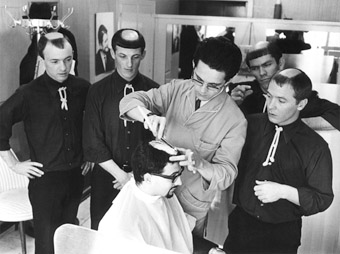
Monks – Transatlantic Feedback
ONE OF THE MUST-SEES AT THIS YEAR’S FESTIVAL OF GERMAN FILM HOSTED BY THE GOETHE INSTITUT WILL BE THE MUSIC DOCUMENTARY, MONKS-THE TRANSATLANTIC FEEDBACK, WHICH CHARTS THE HISTORY OF THE MONKS, THE AVANT-GARDE ANTI-WAR ROCK GROUP FOUNDED BY FIVE WORKING CLASS AMERICAN FORMER SOLDIERS STATIONED IN COLD WAR GERMANY.
The Monks released their first album, Black Monk Time in 1966, appearing onstage wearing black cassocks, their heads appropriately shaved. Filmmaker Dietmar Post who worked with co-director Lucia Palacios for eight years on the film which was released this year combines rare archival footage of the band’s live performances on the popular German TV music show Beat-Club with contemporary interviews with band members and music commentators. “The footage from Beat-Club shows confused audiences standing around while the Monks smilingly sing ‘People cry, people die for you/People kill, people will for you.’ It’s the strangest thing I’ve ever seen”, Post admits. The documentary traces the evolution of a combo determined to expand the frontiers of popular music. What emerges is a picture of German-American cross-cultural experience, and a tribute to genuine rock and roll pioneers. The Monks reformed recently, releasing a tribute album in 2006. The group performed their first show in Germany in 40 years and went on to play London and Zurich. The filmmakers will be in Sydney for the festival.
The festival also offers the opportunity to see some of Germany’s other up and coming cinema talent. Opening the festival is Marcus H Rosenmuller’s satire of the heimat genre, Grave Decisions. Writing in Goethe Institut’s Kultur magazine, Oliver Rahayel talks about the word “heimat” as untranslatable, describing “unique feelings and attitudes.” Nevertheless, German Film Festival regulars are familiar with the genre. “Since the early 80s”, says Rahayel, “filmmakers have increasingly avoided the bitter tone of left wing heimat films, increasingly trying to reconcile social criticism with lighter, more playful treatments of the genre’s stylistic elements, often in combination with autobiographical approaches.” Rosenmuller, whose Heavyweights is also showing at the festival, counters: “I think every movie is a heimat film in some way. In mine, it’s just more obvious because of the dialect (Bavarian). Apart from that, Grave Decisions is about sin and forgiveness.”
Emma’s Bliss is a comedy/drama about a “pigwhisperer” from Sven Taddicken, one of Germany’s idiosyncratic young directing talents. There’s the psychological thriller on the theme of male friendship, A Friend of Mine, made by Tom Tykwer protégé, Sebastian Schipper. Valerie is the debut feature from Birgit Möller who graduated from dffb film school in Berlin in 2006 and who credits her first film’s success to Agata Buzek who plays the title role, Valerie, a model stranded penniless at the Hotel Hyatt in Berlin on Christmas Eve. Moller will attend the festival in Sydney. Best actress at Berlin Film Festival last year went to Nina Hoss for her performance in Christian Petzold’s Yella, which also screens. In a fresh spin on the theme of German reunification, Hoss plays a put-upon woman who develops a taste for the ruthless business world. Chris Klaus’s Four Minutes has an intriguing premise that brings together a savage young woman (Hannah Herzsprung), in prison for a brutal murder she may not have committed, and an 80 year old (Monica Bleibtren) who has taught piano in prison for years and believes she has discovered a prodigious talent. Herzsprung is a festival guest. Eden, by Michael Hofmann, tracks a failing relationship revived by gourmet food and jealousy, while Matthias Luthardt’s Pingpong observes a 16 year-old boy moving in with his emotionally detached relatives after his father’s suicide and focusing his sexual drive on his aunt.
The “controversial” film is WUT by Züli Aladag recounting the escalation of a conflict between a young self-confident Turk and a liberal teacher at a Berlin school, using an actual case to show the difficulties of an inter-cultural dialogue between two people whose worlds hardly ever come into contact. Summer 04, about a German family on a sailing holiday on the Schlei, an inlet of the Baltic Sea, is described by The Guardian’s film writer, Peter Bradshaw, as reviving the spirit of Polanski’s Knife in Water. “Summer 04 has a confrontational, forthright clarity, and an edge of cold steel. (It’s) a very distinctive kind of movie: sexually candid, scary, playful in a sadistic sort of way, yet not ironic or romantic. It is a style which does not exist in our Anglophone cinema, on either side of the Atlantic.” If we needed an excuse for another film festival, there we have it—they offer us a chance to see films we’re unlikely to see on the commercial circuit, to map trends of thought and styles of presentation that might otherwise escape our view.
Festival of German Films: Sydney, April 19-29, Melbourne 19-29, Brisbane 26-29, and Perth 26-29. For updates and complete program: www.goethe.de/ozfilmfest
RealTime issue #78 April-May 2007 pg. 22
© RealTime ; for permission to reproduce apply to realtime@realtimearts.net
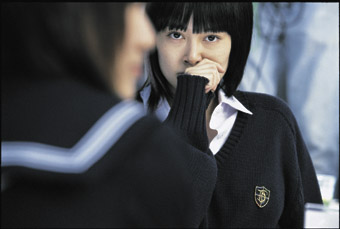
Rinko Kikuchi, Babel
BABEL TAKES ALEJANDRO GONZALEZ INARRITU’S FASCINATION WITH INTERWEAVING NARRATIVES TO ANOTHER LEVEL BY MAKING THE WORLD HIS PLAYING STAGE AS A SINGLE GUNSHOT AFFECTS THE LIVES OF SEVERAL PEOPLE IN THREE CONTINENTS.
In one strand of the story Cheiko (Rinko Kinkuchi) is a rebellious deaf Japanese teenager, traumatised by the recent suicide of her mother. She is bitter towards her father, Yasujiro (Koji Yakusho), and boys in general. It would appear she is sexually frustrated, engaging in provocative behaviour with a series of men. She attempts to initiate sex with her dentist who is horrified. She meets with her friends and in an abandoned playground hooks up with some young men who give them drugs. While her deaf friends are easily able to connect and make out with these young men, Cheiko finds she is rejected by the one she likes because, she assumes, she is deaf.
At home Cheiko encounters two detectives looking for her father. Finding one of them, Kenji Mamiya, attractive, she invites him home. Wrongly supposing that the detectives are investigating her father’s involvement in her mother’s suicide, she tells the detective that her father was asleep when her mother jumped off the balcony and she was the only witness.
Cheiko reveals her real motive in inviting Mamiya to her home. She approaches him naked and attempts to seduce him. He resists but is compassionate when she breaks down at this latest rejection. Cheiko writes him a note, indicating that she doesn’t want him to read it until he is gone. Leaving, the detective crosses paths with her father. When Mamiya offers condolences for the wife’s suicide, Yasujiro is confused by the mention of a ‘balcony’ and says angrily, “My wife shot herself in the head. Cheiko was the first to find the body.”
This issue of conflicting stories is never resolved. The note’s contents are never revealed. However parts are momentarily visible when the detective stops to read it in a bar. The following is an approximate translation of the Kanji script that can be seen at the edges of the pages: “…I wanted… myself…that’s why…connected…that is…although I cannot…I have to find out…message from my mother…I was not sure if I was loved by my mother…but that’s not the case…thank you.”
While the link between Babel’s first three stories is quickly established, it takes some time to work out why this fourth strand belongs at all. I wondered while watching the film if the Japanese story would have an overt link, except for the fact that the central character is deaf, and therefore takes on the symbolic representation of miscommunication and dysfunction of all the stories to the nth degree.
It’s interesting that Innaritu has said, in an interview with Todd Gilchrist, “people confuse what the girl in this story is doing with some kind of sexual addiction, but that is not the case. I think that when you can’t communicate or express feelings with words, the body then becomes your tool of expression—a weapon or an invitation. That is the tragedy of this girl” (movies.ign.com).
Inarritu’s assumption is that Cheiko can’t communicate or express feelings with words, conveniently forgetting that she is fluent in sign. She is also able to write fluently, the note suggests she has full grasp of written Japanese. Because signing is ‘silent’ and mysterious to those who don’t use it, it becomes easy to project onto deaf people a universe of pain and exclusion if they don’t speak.
Many people have said they found Cheiko’s story the most moving in the film. I would argue that has more to do with how it has been shot and the nature of the soundscape than any representation of reality. Inarritu states: “We used anamorphic lenses [in the Japanese story], because the depth of field is minimal—the character is in focus and everything else out of focus. That isolates the character.” Filmically it is an arduous process, but often produces images of great beauty. One of the most powerful sequences is in the disco where Cheiko goes with her friends and the film switches perspective—from the blast of surround sound disco music to a subterranean thump as we move into her almost silent headspace. It becomes an exotic journey for the hearing audience.
And that is what it is, an exotic representation of deafness that has been very much framed in a hearing perspective. When we first meet Cheiko she is taking part in a competitive deaf team sport, volleyball. It becomes clear very quickly she is part of this group, she socialises and has close friends however badly she is behaving. The hidden (and I would suspect, unintentional) subtext is that this woman is actually an integrated member of her society, however much she may be lashing out against the death of her mother and her difficulties in communicating with her father (who also appears to have a good grasp of sign
language).
Here, Innaritu infers that signing is a language where not very much can be said. So rather than exploring the truth behind what a character like Cheiko might offer, the disability of deafness becomes a convenient storytelling shorthand to stand as metaphor for the film as a whole. This could have been a compelling comparison, except the filmmaker chose to skim the surface of what it’s like to be a ‘sign language girl.’
“Stereotyping cultures—that’s what is spoiling the world, I think”, Inarritu has claimed. I can understand he is speaking from his experience as a Mexican, but he too is guilty, of stereotyping the deaf experience, reducing it to an experience of sound and imagery rather than paying attention to the stumbling attempts we make to communicate, and ignoring the riches of other modes such as sign language.
Babel, director Alejandro Gonzalez Inarritu, writer Guillermo Arriaga, Paramount Films, 2006
RealTime issue #78 April-May 2007 pg. 23
© Sofya Gollan; for permission to reproduce apply to realtime@realtimearts.net
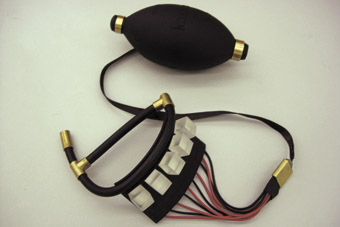
Embracelet, Jonathan Duckworth (with Catherine Truman)
ON FEBRUARY 27 THE HAIL-CLOGGED GUTTERS OF THE AUSTRALIAN NATIONAL UNIVERSITY’S SCHOOL OF ART GAVE OUT. IMPROMPTU WADING POOLS ACCRETED AMONGST THE VENT-PIERCED ART DECO ROOF, SAGGED, SEEPED, THEN DRAINED, BATHTUBS FULL OF DIVERTED STORM WATER FUNNELLING THROUGH LIGHT SOCKETS AND AIR VENTS INTO CORRIDORS, WORKSHOPS, STUDIOS…LIGHT TABLES, PROCESSING EQUIPMENT, COMPUTERS, CAMERAS AND ENDLESS FOLIOS OF STUDENT WORK WERE STEEPED INTO ONE ICY MIXED MEDIA GAZPACHO.
And so it came to pass that decades of careful technology acquisition were rendered nothing but an insurance claim in the course of an hour. Not many media can handle that kind of rough treatment (the sculpture department was noticeably smug in the aftermath), but new media art in particular seems prone to disastrous malfunction at every variation in ambient humidity or operating system version number. ANAT’s WearNow symposium and reSkin workshop, hosted at the ANU in the month before the catastrophic storm, faces that risk, exploring the new hybrid field of “wearable technology”: electronics robust enough to carry the sophistication and subtlety of technological installation in the rough and tumble of every laundering.
In the WearNow symposium, which followed on from the 3 week practical lab titled reSkin, Los Angeles designer Elise Co carried the flag for the water-resistant team, presenting Puddlejumper, a raincoat whose surface lights up in response to embedded water sensors. Like much of the work on display here, not being quite as high tech as you’d think, this piece has negligible digital processing power. It’s simply a raincoat with some wires in it. You might even say that was the whole point, that’s what makes this design elegant. We could call Elise’s corner of the ring ‘industrial design.’ It’s a corner I would put her in with well known cyberpunk object designer Susan Cohn, also presenting—although Cohn could also be filed under ‘craft.’
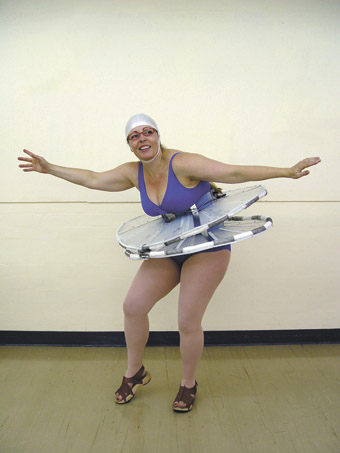
hipDisk, Danielle Wilde (demo 3)
photo Cinnamon Lee
hipDisk, Danielle Wilde (demo 3)
In the ‘technologist’ corner, CSIRO’s Robin Cranston has a load of speculations about the properties and potentials of future nano-technologically produced materials that will hypothetically revolutionise textiles as we know them. Most of his subject matter is as yet outside the powers of cheap mass production, existing largely in electron microscope screen shots. Damn pretty ones, mind. Joey Berzowska and High Tea with Mrs Woo hold the ‘fashion’ corner which would, for argument’s sake, put SymbioticA’s Oron Catts in the ‘high art’ camp.
Stephen Barrass’ background paper quilts these pieces together. His is a neurobiologically motivated talk unifying the low and high technology works under the protective umbrella of augmented reality. The skin is a sense organ, his argument runs, and the tactile experience of wearable objects places them in the camp of your general hyperreality experiences. Insofar as ideas of augmented reality interfaces are a re-invention of ‘virtual reality’ and bionic human machine hybridisation that we envisioned for ourselves in the 80s when trying to imagine the present, the intimacy of wearables places them closer to the latter; wearable technology is a cybernetic intervention in your own direct sensory experience. To paraphrase, bionic interaction has been with us all along, and we call it fashion. Only now we notice that it’s technology because it stops working when the batteries run out.
It’s a noble attempt at unification in a singularly patchy situation. But a bold unifying idea is one thing; for the speakers themselves to engage is another. ANAT’s background papers are excellent and comprehensive, including articles by most of today’s speakers, and free to boot. But what we want from the symposium is more than background briefings: we want dialogue between the amazing authors of all these papers. Instead, we get show and tell sessions whose diverse notions blend into a turbid soup of dot point presentations. Some firmer steering from the ofttimes tepid panel chairs might have been in order, or perhaps a less conference-like format for the whole symposium, to free us all from the spectatorial paralysis more suited to watching Beyond 2000. It jars to use such a staid, uninteractive format for a conference on the most interactive technology imaginable.
The most pertinent missed conversation, for me, is the one about the intersections between “wearable technology” and the do-it-yourself movement. The majority of the works being presented don’t involve a huge amount of high technology; if anything is driving wearables as a medium right now it is not the invention of any new technology per se but the plummeting affordability of so many old ones, and the upsurge in disseminating the skills to use them. Internet-based collaborative skillsharing such as Instructables and MAKE magazine pop up in the workshops more than once; huge portions of the works created are driven by the community generated open source code of the Arduino circuit board, and when those run out there is a basket of plastic toys by the door awaiting circuit jamming. All manner of formerly technical specialised knowledge is becoming democratised and communal, and knowledge is being shared in all directions as artists from different fields get with the new media rhetoric and hybridise their artforms.
This do-it-yourself-then-tell-everyone-else is the trend whose effects suffuse the workshop—the blogging generation is turning their media-making prowess on the physical world. The reSkin Lab is bang in the middle of that movement—promiscuously multi-artform and multimedia, and multi-aesthetic, spanning industrial design, craft and good old fashioned high art. The laureates of this workshop stalk sleeplessly around with a damn good idea of precisely how easy (or not) all this newly accessible technology is. And for three weeks they have ruled the Art School like the coolest kids on summer camp, descending on the final exposition in a surging wave of lurid enthusiasm, adorned concept sketches spilling out of their sleeves, with unfinished LED-specked breadboards taped to their bodies. It’s messy, unfinished, and unapologetically half-arsed, but it doesn’t claim to be otherwise, and there are enough great ideas amidst the crazy ones to fill the butcher’s paper of a hundred brainstorm sessions. Highlights: Elliat Rich’s breath activated transpiration vest…Danielle Wilde’s splendidly undignified hula hoop musical leotard…the High Tea With Mrs Woo/Keith Armstrong collaboration, a contraption to transpose the impact of one person’s foot binding to spidery electrical actuators pressing another’s hand…
“So how do you wash it?” I ask Rowena Foong of High Team as she unwraps her foot from the delicate wiring of bandage wrapped pressure sensors. “You don’t. It’s not waterproof.” Participant Somaya Langley confirms: “Nothing here’s washable.” And so we all stumble off down the road for dinner, praying for dry weather.
Australian Network for Art & Technology: reSkin, Wearable Technology Lab, Jan 15-Feb 1, Australian National University; WearNow Symposium , ANU Gallery Feb 2, National Museum of Australia, Feb 3; presented by ANAT, the Australian National University School of Art, the Centre for New Media Arts (CNMA), Craft Australia
reSkin: www.anat.org.au/reskin
Arduino physical computing: http://www.arduino.cc/
Instructables: http://instructables.com
Make: http://makezine.com
RealTime issue #78 April-May 2007 pg. 24
© Dan MacKinlay; for permission to reproduce apply to realtime@realtimearts.net
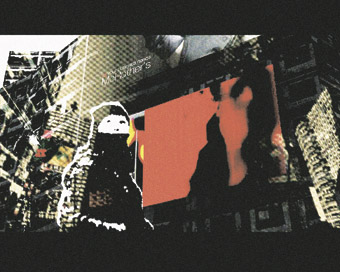
Freidrich Kirschner, Person2184
THE ORIGINAL AIM OF THIS SYMPOSIUM EXPLORING ART, CULTURE AND NEW MEDIA WAS TO DEFINE CONCEPTS AND PROCESSES CHARACTERISTIC OF THE BEGINNING OF THE 21ST CENTURY. SOME OF THE TOPICS THAT EMERGED IN RESPONSE TO THIS PREMISE MIGHT HAVE BEEN ANTICIPATED, SUCH AS INTERACTIVITY, WHILE OTHERS MIGHT NOT, SUCH AS FASCISM.
Asked what the decisive theoretical and practical developments of this decade are (if we consider that the discourses we are using in 2007 are quite old, postmodern at best), the broad range of speakers, from disparate specialities and geopolitical/cultural backgrounds nibbled at the question and shared portions of their own specialist knowledge. Definitive new developments, concepts or ideologies however, were elusive. It seemed instead that ‘old’ ideas, modern and postmodern, were being utilised—but in a new way.
Finding a common language, for this assortment of specialists, was at times difficult and reaching a consensus was impossible (there were even occasional intellectual fisticuffs). This doesn’t diminish the relevance of the symposium (or others like it). The significance perhaps resides in the importance of what Andreas Ströhl described as ‘dialogues’—two way communication—in contrast with discourses, which are one way, continually raining down upon us.
Ströhl (Director, Munich International Film Festival) presented the ideas of Vilém Flusser, a philosopher (1920-1991), not well known in the English-speaking world but increasingly influential in Europe. Ströhl discussed Flussers’ ideas of the apparatus (technology producing technical images), the apparatus behind the apparatus (put simply, the systems that determine which of these images appear—from broadcast media to art galleries) and the operators of the apparatus. He suggests a war between art and the apparatus; the apparatus digests art and reproduces it as aesthetic output. Art can struggle with the apparatus by creatively abusing the technology and putting the apparatus to use against its own program. In more simple terms, Ströhl suggests “the apparatus produces pictorial diarrhoea,” or, in a way, “David (art) challenged Goliath but Goliath simply ate him up.”
Debate about the possibility or the failure of the internet to operate as a dialogical medium and the ‘disappearance of interactivity’ in new media art underscored some of the discussion which ensued. There were those who did see the internet as a dialogical medium, with the possibilities and potentiality of interactivity (another David perhaps), while others viewed it as fascistic. Meanwhile Paul Majkut (investigative journalist, professor of literature, USA) pointed out that ‘a Coke machine is interactive’ and argued that interactivity in digital art is an impostor, posing as intersubjectivity and unable to carry empathy.
The obvious limitations of 90s-style interactive art were easily identified: that interactivity required two individuals rather than an interaction between machine and individual. No one could determine the agency of new media or networked technologies in the interaction between two individuals, precisely relocate ‘interactive art’, nor determine why it may have ‘left the building’. However, Eddo Stern’s art practice, which had traversed various approaches to interactivity, provided some kind of practical response.
Stern, an artist and computer game designer, had shifted from producing ‘interactive’/virtual reality works in the 90s to machinima works, which translate ‘interactive’ computer games into linear video works. (Put very simply, machinima is filmmaking in a virtual environment). Stern presented Sheik Attack (1999), a machinima piece, which juxtaposes edited scenes shot in war games with a soundtrack of traditional Israeli songs. He tackles both the debate on the Zionist ‘ideal’ and the relationship between the ‘fantasy of war’ and its real life counterpart. (Stern is Israeli and has done military service). Also picking at the seams between the politics of the game, the screen and the world, was Death Star (2004), an edited series of sequences shot in different games devoted to violence against Osama Bin Laden, screened along with the soundtrack from Mel Gibson’s The Passion of Christ.
Stern’s practice has now returned to interactivity with works such as the Tekken Torture Tournament Performance, where participants receive electric shocks corresponding to the injuries sustained by their onscreen avatars. Having variously interacted with interactivity in both his art practice and gaming passion, Stern perhaps provided the last word on the topic: “not playing massive multiplayer games now is like going through the 60s without taking drugs.”
I suspect Paul Majkut disagreed. He advocated that spoken language is truth and mediated language is not. He saw a delineation between analogue and digital media, arguing that the speed, power and illusion of simultaneity characterising the digital renders it fascistic—that it is a quantitative exchange of information rather than a qualitative exchange of knowledge. Majkut reminded us that the map is not the territory and confessed that he was proud to be a loser (taking sides with some of the other important losers, art and Marxism).
The discussion that followed moved from the word fascism to the ‘aestheticisation of politics.’ Whilst not everyone agreed with all of Majkut’s ideas, notions around the aestheticising of politics seem pertinent as we watch global warming finally reach the tipping point into mainstream political debate, only to be neutralised and aestheticised on programs such as Channel 10s’ one-off overview program, Cool Aid: The National Carbon Test.
If the ideas of Ströhl and Majkut seem reminiscent of those produced in the 20th century, perhaps this relates to the similarities in the contexts of these times—rapidly developing new technologies and horrendous aggression. In her examination of the political motivations for constructing the crowd as dangerous and the role of new portable technologies in the development and psychology of the crowd, Sydney-based media artist and theorist Anna Munster also considered whether we need new concepts for the new millennium or make do with older unfashionable ideas, looking for what is new in the old.
Whilst there were no definitive answers to the symposium topic, Freidrich Kirschner’s art practice provided the best response that could be hoped for. Kirschner, a filmmaker and visual artist, also creates machinima works. In Person2184 and The Journey, he uses the framework of Unreal Tournament 2004 to run beautiful film sequences he has constructed, creatively capitalising on the technology of the game and offering a critique of the game from within. Kirschner is also responsible for creating moviesandbox, a kind of movie-making toolkit, which allows the user to create and animate characters and scenery and also film them, to produce movie type sequences within the Unreal Tournament game. In a sense, Kirschner limits the limitations of the game, so that the character options, movements and rules are more open. For example, he has developed the milkscanner, a device that uses—amazingly—milk, a Tupperware container, Lego and a webcam to scan objects to adapt them as characters to be used in a ‘movie.’ The possibilities for developing a character explode with this clever and quirky device. The incorporation of everyday materials and the availability of instructions make the works freely accessible (see Kirschner’s website, www.zeitbrand.net).
Kirschner described his approach by comparing the board game Risk and playing with Lego. In Risk, a war game where players aim for world domination, the rules are derived from a previous reality, the game is determined by the rules and the space of the game is fixed (the board). With Lego, the rules, if there are any, are formed by your own perception of reality and the space of the game is any environment into which you put it. The former is simulated play, the latter, creative.
Maybe Kirschner could be considered a little ‘David’, struggling against the ‘apparatus’ with his art. If so, he does it in a new way, both critiquing and constructing from within, from a position of knowledge and passion about new technology, rather than from without (taking an oppositional position of deconstruction from outside the medium).
I hope Goliath doesn’t eat him up.
Experimental Art Foundation, The Ideology of the Imaginary in the 21st Century; Mercury Cinema, Adelaide, March 1, 2
RealTime issue #78 April-May 2007 pg. 25
© Christine Collins; for permission to reproduce apply to realtime@realtimearts.net
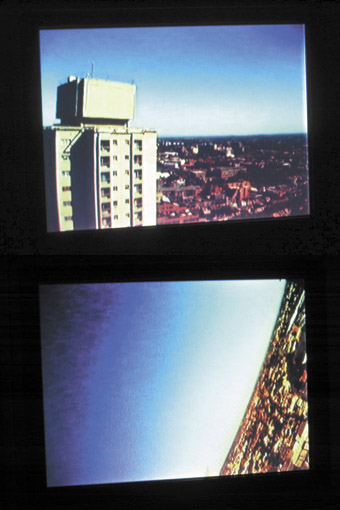
The Terminal Vision Project, Denis Beaubois
LIKE IT OR NOT, WE ARE ALL MEMBERS OF AN IMAGE-OBSESSED SOCIETY, INHABITANTS OF A MEDIATISED WORLD WHERE ALMOST EVERYTHING IS SEEN, TRACKED AND RECORDED. LIVING IN AN ERA CHARACTERISED BY YOUTUBE, MYSPACE AND REALITY TELEVISION, THE ACT OF CREATING A MEDIA IMAGE IS PROGRESSIVELY EASY WHILE, AT THE SAME TIME, INCREASED LEVELS OF SURVEILLANCE MEAN THAT MORE AND MORE IMAGES ARE BEING GENERATED THAT REMAIN INACCESSIBLE TO ALL BUT A PRIVILEGED FEW.
Three very different video and new media artworks recently exhibited in Sydney explore issues surrounding the contemporary image, in particular investigating the politics of tracking and the poetics of imaging and imagining the invisible.
In terms of imaging technology, surveillance cameras are a particularly insidious presence. These ubiquitous devices are continually recording our image, each person effectively leaving a trail of data that they will most likely never see. And perhaps it is my anxiety over the invisibility and inaccessibility of these highly personal images that made watching Denis Beaubois’ provocative video work The Terminal Vision Project (2007) such a cathartic experience.
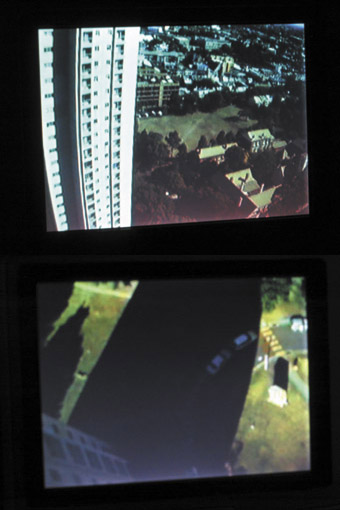
The Terminal Vision Project, Denis Beaubois
the camera suicides
In Terminal Vision, exhibited at the Performance Space’s fabulous new CarriageWorks home, the wireless camera technology that is used in much surveillance is literally and figuratively turned on itself. In an anthropomorphic sense cameras are made to suffer, as they are hurled full tilt off a tall building, and all the while made to unwittingly broadcast their own, unceremonious demise.
In the massive grey exhibition space, a row of five huge video projections completely covers the length of one wall. Stepping inside you are immediately struck by the sound, loud throbs of pounding static fill the room. Grungy images flicker in and out of visibility, messy and unstable, haphazard movements captured by the frame are repeatedly interrupted by interference and static. In a time of plasma screens and HDTV, these glitchy images reveal themselves as being something covert, they are too dirty and the signal far too weak to be anything but undercover, and it is as if we are witnessing someone or something being caught in the act. Through the grunge I make out a close-up of a wall with concrete cancer; wisps of the artist’s very recognisable dark hair quiver in shot. A windowsill appears and we glimpse a private room, a kitchen perhaps, with daggy old linoleum. Then the image degrades, we loose visibility to static, colours bleed into each other and interference takes over. I begin thinking about a secret agent who can’t work their pinhole camera, and as if replying to this thought I hear a muffled voice on what sounds like a walkie-talkie. Unexpectedly a finger probes the lens repeatedly, squashing the image away into flesh and darkness. Then I see the familiar shape of the infamous high-rise ‘suicide towers’ in Waterloo, as the signal weakens again. I begin thinking, we are in a precarious position up here on top.
Suddenly we are falling, the sound changes to a loud humming drone. I think about an aeroplane crashing, the black box recorder and what remains when everything is destroyed. Windows are spinning past and the horizon is in the wrong place. After a moment I start laughing, the dizzying image of the ground hurtling up towards us as this tiny wireless camera falls at breakneck speed from the top of the building is hilarious and exhilarating to watch. I imagine how much fun it must have been to throw these little mechanical guinea pigs off the edge. And then abruptly we hit the ground—thud—more static, a person walks by, we are in the grass, left for dead, then everything turns black and silent.
As audience members watching this defiant act on video we are presented with an unusual point of view. It’s an angle and trajectory of vision that we know will remain inaccessible to us, unless we too decide to end it all, flinging ourselves off the edge, but even then it is unlikely we would be around to remember, let alone record the experience. In this sense then the video image is one of impossibility, a terminal vision. Through the broadcast of these images Beaubois allows us to vicariously participate in his rebellious act. The ubiquitous cameras that are insistently pointed towards us, incessantly recording the banal details of our daily lives are suddenly made the instrument and target of some long deserved ridicule and physical abuse.
data lives
Two artists who for some time have also been concerned with surveillance and more broadly the politics of tracking human data are Josephine Starrs and Leon Cmielewski. Their concerns are once again raised in Seeker (2005), recently on show at Artspace. Seeker is a conceptually rich and aesthetically striking piece that is immediately engaging on a number of levels. In its most recent incarnation it comprised three large video projections displayed on hefty angled screens. The central image consisted of an animated, interactive world map. Using a simple touch screen interface, visitors could enter their family migration history. This data is shown as a trail on the map and then re-visualised as a series of curves representing each family’s generational movement throughout the world.
The other two screens are more mysterious. On one, colourful vectorgraphic curves dance across the surface of beautiful, desolate landscapes. These animated abstractions describe the relationship between an assortment of statistical factors and variables, often as depressing statistics. What is “coltan” [a rare mineral found in Africa, eds.] I wondered, to be included on a scale that reads “the Congo resource wars”, “3 million dead” and “3.5 million displaced…” and what is its connection with “every mobile phone” and “every computer”? Glancing to the other screen I see aerial imagery of suburbia overlaid with a thin strip of fast moving, news bulletin-style text: “a man has frozen to death on a plane…on a boat three stowaways die…landmines kill Pakistani refugees…23 Pakistanis drown in river on way to Europe…” This procession of death and despair seemed in marked contrast with the fun everyone was having inputting their family histories. I was reminded of how easily some of us can move in the world thanks to the luck of our birth, and the immense difficulty others face when attempting to escape places of unfathomable hardship and danger. However Starrs and Cmielewski’s background in creating humorous and entertaining artwork inspired by computer games still manages to seep through this conceptually solemn work. The power of Seeker seems to derive mainly from its ability to stimulate intimate and often politically charged dialogue between gallery visitors.
diagnostic mysteries
Modern images are no longer simply representations; they are also dynamic, interactive processes that form an integral part of contemporary medicine, weaponry, communication, movement and politics. Many of the images we see today are not discernible to our naked senses and we rely upon a range of scientific instruments for their continued visibility. Michelle Barker and Anna Munster explore this problematic in Struck (2005), recently shown at the Art Gallery of New South Wales, by taking viewers on an unsettling journey into the largely invisible world of neurological disease. Through a disturbing array of black and white medical imagery Struck evokes an uncomfortable awareness of the body’s powerlessness in the face of debilitating illness, and explores the equally difficult experience of finding oneself under the probing eye of medical science that attempts to treat it.
Watching this piece brought back memories of long hours spent in a hospital waiting room. It triggered powerful feelings of sadness and helplessness, emotions that were intensified by the work’s soundtrack—electronic noises, punctuated by the mournful notes of a piano and a childlike wailing. Surrounded by three giant video projections, as inside a hospital I felt like a small, insignificant presence within a complex and confusing, technologically driven world. As in a waiting room, a strange sense of timelessness pervaded the in-between space of the gallery where the work was installed. My thoughts were drawn to the similarities between the art world’s sterile ‘white cube’ and the sanitised, often unwelcoming environment of contemporary medicine.
Struck immerses viewers in a disconcerting realm of medical traces and unfamiliar diagnoses, confronting us with lingering images that, like the nebulous shapes burnt in to your eyes after looking into a bright light, are not easily erased. The most recognisable image in Struck is the now familiar medical trope of the brain scan slice, a highly detailed form contrasted in the work with the blurred images of a naked woman. Who is this faceless figure, I kept wondering, so vulnerable yet resolute within this alien medical world? Occasionally text appears, sometimes distant and clinical, seemingly transcribed from doctor’s records, sometimes comprising poignant, personal anecdotes: “People tell you how well you look—it makes you feel worse”.
At certain points an antiquated, stop-frame animation appears of a writhing female figure made, I later read, from the drawings of Jean-Martin Charcot, the influential 19th century French neurologist. It is hard to believe that these clumsy images were once contemporary medical documents, and the idea that someone could be diagnosed using them sends shivers down my spine. On the other hand, I realise that while I am comforted by the scientific validity of the relatively more sophisticated Magnetic Resonance Imaging (MRI) its images are still for the most part beyond my understanding, I cannot relate my thoughts or my feelings to their intricate electrical signals and I have no idea what they really mean. Essentially this is the core issue of Struck, the increasing visibility of the material human body made available to us through scientific imaging and the problematic relationship these images have with our ongoing embodied experience.
RealTime issue #78 April-May 2007 pg. 26
© Anna Davis; for permission to reproduce apply to realtime@realtimearts.net
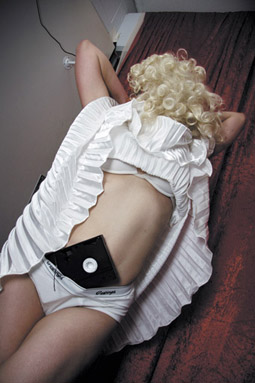
Tanja Visosevic, Peepshow, Rated VHS, photo Fiona Morrison
EVOLUTION IS A TERM THAT HAS NOT BEEN USED LIGHTLY IN DARWIN’S CONTEMPORARY ART SPACE, 24HRART IN RECENT MONTHS. VIDEODROMO 1.5, CURATED BY WA ARTISTS LEON MARVELL, TANJA VISOSEVIC AND YOLANDE PICKETT, AND DAWN OF REMIX BY SYDNEY’S SODA_JERK & SAM SMITH, ARE TWO EXAMPLES OF REFLECTIVE PRACTICES WHICH AIM TO QUESTION EVOLUTIONARY TECHNOLOGIES THAT BURST ONTO THE MARKET ONLY TO CONVERGE WITH THE VERY DEVICES THESE TECHNOLOGIES HAVE OSTENSIBLY SUPERSEDED. BOTH GROUPS ACTIVELY USE CONTEMPORARY MIXED MEDIA TO COMMENT ON OUR SOCIAL AND CULTURAL PRACTICES; HOW DOES THE LATEST, MUST-HAVE UPGRADE DEFINE WHO WE ARE BOTH IN OUR PERSONAL AND PUBLIC LIVES?
Videodromo 1.5, a restaging of the 2006 Perth event held at Spectrum Project Space, included local artists Elka Kerkhofs, Marko and Brandon Williamson for the Darwin performance. Profoundly interactive, the installation plays with the procedural aspects of modern technologies: TVs are made for passive viewing; video monitors are made for covert surveillance; still images should hang decorously on living room walls. Even the sound sculpture is hidden, heard but not seen, like so many in-built home sound systems today.
This was an experimental zone where the viewer was asked to respond to the familiar setting of a lounge room. Almost subconsciously the role of engagement expected of gallery goers is subverted and takes on a personal tone as we instinctively search out creature comforts: our sound system; our TV; our DVD/Video; our home theatre—the waves of successive technologies that have cemented their place in our lives.
Yolande Pickett’s still monitor images decorated the wallpapered walls of the Screening Room like TV screens. They provided an unsettling stillness which was dramatically juxtaposed with Marvell’s garbled projections. His central interactive exhibit was as unconscious as sleepwalking. Triggered by a motion detector between the monitor and projection screen, the viewer may or may not be aware of their participation in the show as the computer’s software generates alchemical images that flash, glide, fade in and out.
Marvell views this interplay as an act of meta-psychological creation in which our lost understanding of hermetic scripts is rediscovered with new and original meaning. Technology combines with human interaction as a form of artificial intelligence.
In addition to the Screening Room, VIDEODROMO 1.5 provided the audience with an opportunity to view one of Tanja Visosevic’s Peepshows, Rated VCR. Prompted by an advertisement in the local NT newspaper, the show attracted ‘standing room only’ queues on opening night. Visosevic’s staged Duchampian readymade used the site of the gallery toilets for a series of montages ranging from video porn to mobile phone mini-dramas.
This was a powerful piece as it used the theatrics of pubic toilets to expose our hidden and highly emotive interactions with technologies. Our emotional reliance on abbreviated language and the complex semiotic platforms which form the basis of mobile phone voice/text/video messaging has blurred the boundaries between public and private.
Visosevic’s Dadaist performance component transmitted fragmented moments of her peepshow sessions to the waiting crowds via a surveillance monitor within the gallery space. In one instance a mother viewing the peepshow (recognised only from the back of her head) was being watched by the general public on the black and white loungeroom monitor while her sons, unsupervised in the lounge and oblivious to the monitor above their heads, were playing on their mobile phones. This clearly was an environment which taps into our deep rooted psychological relationship with technology.
Soda_Jerk (Dan and Dominique Angeloro) & Sam Smith re-edit Stanley Kubrick’s 2001: A Space Odyssey using sequences from the “First Lesson” to convert the hominid awakening to the use of tools into a discovery of scratch, beat and dance. The “Dawn of Remix” is a humorous sleight of hand which lays memories open to a new narration of events. Kubrick’s ‘cube’ enlightens mankind to the hip hop culture of audio remixing.
Well positioned in the Monitor Space of 24HrArt, this re-edit was seen by crowds of passersby on the busy market days allowing for quick grabs or extended viewings. Memories are reconnected to the original film or mashed with the kaleidoscope of the everyday on the street, film present and past. The Beastie Boys and LL Cool J’s track Can’t Live Without My Radio could do no better for a new video clip.
Videodromo 1.5, curators Leon Marvell, Tanja Visosevic, Yolande Pickett with Elka Kerkhofs, Marko, Brandon Williamson; Soda_Jerk & Sam Smith; 24HR Art, Darwin, Feb 16-March 24
RealTime issue #78 April-May 2007 pg. 27
© Sarah Pirrie; for permission to reproduce apply to realtime@realtimearts.net
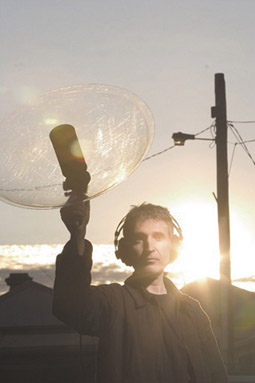
Philip Samartzis on location, Northern Void
IT USED TO BE CALLED THE TOP. IT WAS LITERALLY THE END OF THE LINE FOR THE TRAM SERVICE THAT SNAKED ITS WAY THROUGH THE INNER CITY TO THE NORTHERN MELBOURNE SUBURB OF PRESTON. THE CULMINATION OF THIS JOURNEY WAS A TERMINUS LINED WITH SHOPS, A PLACE OF CONCLUSION AND WAITING, OF BROWSING AND PURCHASING. IN NORTHERN VOID, A REPRESENTATIVE STRETCH OF PLENTY ROAD, PRESTON IS IMAGINED AS A VAGUE, ANACHRONISTIC TIME WARP SPANNING A THOUSAND YEARS, WHERE PEOPLE STILL HANG AROUND THE STREET OUTSIDE EMPTY AND DERELICT SHOPS, WAITING FOR TRAMS THAT NEVER SEEM TO ARRIVE.
Northern Void ostensibly explores the notion of what suburbs might look like in the future. For Philip Brophy there is no such thing as the end of the line. Social and urban decrepitude, like rust, never sleeps and in Brophy’s universe the future ain’t rosy. Here is an anti-pastoral, dystopian world of breakdown and decline, where once thriving, reliable local shopping strips have yielded to the forces of time and the irresistible gravitational force of the mega-malls. Preston and its neighbouring Reservoir were once frontier suburbs, outposts of civilisation on the brink of the sprawling wastelands of rock and thistle that led the way to Sydney. Brophy’s northern void is not out there. It is the very fabric of suburban progress, a condition of place as much as time. Suburban corrosion is implosive, impacting inwardly as large centres such as Northland, offering glamorous ‘one stop shopping’ and ‘worlds of entertainment’, drew custom away from the archetypal “High” street. Since opening in 1967, Northland became an alternative place to hang out and by the early 80s the Top became a kind of fossilised badland, a ‘desolate plain’ that you passed through on the way to somewhere else.
The work is structured around a series of three stylised tableaux vivants, depicting the present (2013), future (2085) and post-future (3079). In each sequence the same strip of road and shop frontages is revisited, as if to chart the progress of suburban decay over time. We witness Plenty Road’s disintegration as a body slowly dying in a persistent future tense. Its zombie-like inhabitants mirror this dismemberment as they become ever more spectral, eventually resembling vapour more than flesh.
For me the least dramatic thing about Northern Void is its visualisation of what a post-apocalyptic world might look like in the next millennium. The present, 2013, looks uncannily like 2007. We are already the dead. The full-on compositing and digital effects of the third age strips out windows and leaves buildings barely standing as fragile shells. Harsh solarizing effects transform the sky into a sterile nothingness. These scorched and garish tonings may signify ‘the future’, but it is the unadorned photographic glimpses in the opening sequence that are more suggestive of the sedimentary quality of the street as an archive of past, present and future devastation. You can’t simulate that kind of brutality.
The repetitive, looping structure of Northern Void stands out as the work’s most remarkable and, for many viewers, troubling feature. Here is an unforgiving abstraction that tests the patience of its audience. Brophy never allows us to become complacent, to simply ‘get it.’ His vision of Hell resembles Dante’s: it is the tedium of repetitive cycles, rather than fire and brimstone, that torments protagonist and audience alike. There are also strong echoes here of Samuel Beckett’s more severe stage and video works, such as Play (1964) and Arena Quad (1980), which is included in the touring Centre Pompidou collection of video art, currently on at ACMI. In these arid, mathematically precise works, action is reduced to the serial repetition of minimalist gestures that don’t have any obvious reference other than relentless adherence to unseen and forbidding rules. We see this in the tics, abrasions and crutches of Brophy’s characters that, like those of Dante and Beckett, are indicative of their fall.
Northern Void begins and ends with swarms of bats and flying foxes, creatures of the night that see through sound. This is an apt framing device for a collaboration between Brophy and Philip Samartzis, whose sonic imaginations interpret the visual world through a mix of sampled, electronically produced sounds and natural and industrial field recordings. Performed live, the score animates the atrophying world on the screen, sculpting the theatre into an immersive audiovisual space of terminal conditions. My only criticism was that the amplification was no way near loud enough on the night. If I am to spend a season in hell, I want to feel it tear through every sinew. The live orchestral quality of Northern Void enables us to experience the visceral audiovisuality of the terminus as a state of things endlessly winding down. But be warned, it’s going to be a long wait to the top.
Northern Void, Philip Brophy and Philip Samartzis, Australian Centre for the Moving Image, Melbourne, Feb 17-18
See RealTime 77, p28 for Philip Brophy’s personal account of the creation of Northern Void
RealTime issue #78 April-May 2007 pg. 27
© Darren Tofts; for permission to reproduce apply to realtime@realtimearts.net
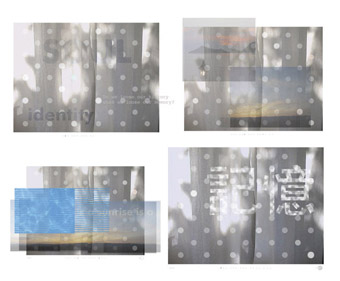
Rainer Strasser and MD Coverley’s ii—in the white darkness
IN ONE OF THE KEYWORD DESCRIPTIONS BURIED WITHIN THE ELECTRONIC LITERATURE COLLECTION THERE IS A SENTENCE WHICH I THINK SHOULD APPEAR AS A WARNING BEFORE ALL ATTEMPTS TO DEFINE ELECTRONIC LITERATURE: “WRITING NATIVE TO THE ELECTRONIC ENVIRONMENT IS UNDER CONTINUAL CONSTRUCTION (POIESIS) BY ITS CREATORS AND RECEIVERS.” THIS COLLECTION IS SO LARGE AND HETEROGENOUS THAT IT IS ALWAYS ONE STEP AHEAD OF ATTEMPTS TO DESCRIBE IT.
There are 60 individual works here, many of which you could spend over an hour with. Most kinds of e-lit are represented: hypertext writing, kinetic poems, codework (writing which incorporates programming languages), interactive works, as well as expanded forms of the traditional genres of fiction, poetry, memoir, comic, and non-fiction. Early exponents of the form such as Shelley Jackson, Phillipe Bootz, and Talan Memmot are represented alongside lesser known writers. Helpfully, each work is tagged with keywords, allowing the reader another way in to what is a daunting amount of material. The subjects are often imaginative, from an exploration of the connections between concrete poetry and subliminal advertising to an interactive graphic based on a story of demonic possession. Across the works there are themes which recur: an interest in systems and viruses, in memory, and in the process of translation and recombination.
People tend to read more distractedly on the internet than they do in print. Intentionally or not, the writers and artists counter this tendency in different ways. In some of the interactive works the response time is slower than broadband users have come to expect (that is, not instantaneous) forcing the reader to slow down and enter the work rather than wildly clicking to get to the “end.” Others exaggerate this tendency towards distraction by throwing at the reader more information than they can process at once. Generally, the pieces are as much about how you are reading as what you are reading.
Rainer Strasser and MD Coverley’s ii—in the white darkness: about [the fragility of] memory visualizes the experience of memory in people with diseases such as Alzheimer’s. We see a gauzy white curtain with shapes of light wobbling on it, and behind this a blurred sky that could be dawn or dusk. The image appears drained, somewhere between a photograph and a watercolour. Across this curtain a pattern of perfect white circles pulses. Clicking on them makes stark images appear: a canal, a wooden walkway, a crisp blue square of swimming pool water. Occasionally fragments of text appear. Sometimes parts of images bob at the bottom of the frame, frustrating the reader who is unable to decode them. The work responds slowly to reader input, mirroring the experience of trying to recall a memory that has been misplaced or distorted.
Jean-Pierre Balpe ou les Lettres Dérangées by Patrick Henri-Bergaud is what typographers see when they close their eyes after a long day. Within a black and white interface that mimics a page of print, serifed letters sit across the screen in the shape of a poem with most of its letters missing. Other letters drift around the screen in determined courses, spinning and swivelling until they catch on another nest of letters. Minute movements of the mouse dislodge the letters from their position, and they spin off again in various directions. Suddenly the mouse is energised, tense with potential; I nudge it along with two fingers as if it were an egg. The screen itself starts to seem delicate; I realise that if I banged my desk with my fist it would disturb the mouse enough to send the letters cascading. The “aim” of the work is to rebuild the poem by putting the letters in place, yet after twenty minutes trying I was no closer to doing this, and possibly further away.
Mary Flanagan’s The House, built with an open source programming language, Processing, is digital as it was once thought of: crystalline and inviolate. We see a cluster of cubes and three-dimensional lines from a poem; zoom in and you are inside the transparent structure, zoom out and it resembles a model of a chemical compound. As the reader turns and rotates the structure the lines of the poem change. Contained inside a small square roughly a quarter the size of the screen, it is an intentionally claustrophobic work, reflecting the stuck nature of the relationship talked about in the poem.
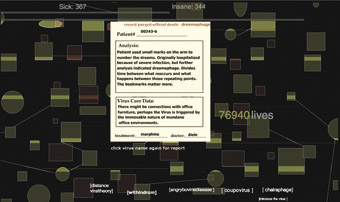
Jason Nelson’s Dreamaphage
Poet and digital artist Jason Nelson’s aesthetic is the opposite. Poem fragments and chopped up, scanned pictures from old science textbooks float through his works like space junk or objects in dreams. In the two drafts of his 2004 work Dreamaphage included here, he explores the equivalences between viruses and dreams. The reader seems to fall into the work, passing books whose pages can be turned and read by clicking and dragging the mouse. Nelson’s magpie approach to words, pictures and sounds creates an immersive, authentically strange world.
Perhaps the most recognised form of e-lit is hypertext. Shelley Jackson, the author of the early and influential 1996 hypertext, Patchwork Girl, is represented here with her hypertext memoir from the following year: my body, a Wunderkammer. The first thing we see is a lino block print of a female body divided into sections that link to different beginnings to the story. The interface is simple—once you are inside it is mostly text—leaving the lucid prose free of distractions. Jackson’s memoir shows that hypertext, with its fluidity and the way it compels the reader to move laterally across a work, is well suited to writing memory and
history.
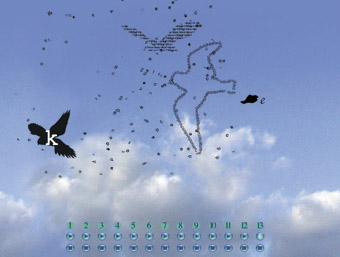
Maria Mencia’s Birds Singing Other Birds’ Songs
Maria Mencia’s Birds Singing Other Birds’ Songs uses thirteen separate looped birdcalls which the user can switch on or off to create and oversee their own soundscape. Along with a birdcall each button releases a calligramme bird, which flies back and forth across the screen in a vision that would have made Apollinaire swoon. It is a gorgeous work. William Poundstone’s Project for Tachistoscope [Bottomless Pit] is not gorgeous, from the difficulty of actually watching it to the unfashionably loud colours of the interface. The central idea explored in an essay within the work is the fact that subliminal advertising and concrete poetry were invented at the same time in the early 1950s. The work itself is a digital version of the tachistoscope—a machine which flashes projections at a specified speed, often used in market research to test image recognition. Viewing the work feels like undergoing a kind of Pavlovian conditioning experiment; the eyes are constantly recouping, trying to stabilise a relentless, strobing afterimage.
One of my favourite works is Reiner Strasser and Alan Sondheim’s Tao. A poem of less than twenty words scrolls across the screen like a news bar below two looped shots of a road and a mountainous landscape slipping by outside a car door. It is a momentary work, all over in 38 seconds. The different elements—cinematography, interactivity, poetry, and soundtrack—are combined as subtly and carefully as those of a Zen garden.
The editors have stated that one of the purposes of putting the collection together was to expose the work to people who may not have seen it otherwise. To this end, a CD-ROM of the collection was produced—available free from the publishers—in addition to its online publication at http://collection.eliterature. org/1/. Licensed under Creative Commons 2.5, which allows it to be copied and shared, their hope is that libraries and schools will install it on their computers, teachers will use it in lessons, and people will share it among their friends. In the breadth of work contained in it, as well as the innovative way the editors and authors have made it available, this is a generous collection.
Electronic Literature Collection, Volume 1, editors N Katherine Hayles, Nick Montfort, Scott Rettberg, Stephanie Strickland; published by the Electronic Literature Organization, October 2006http://collection.eliterature.org/1/
The Collection includes works by Australian artists Melinda Rackham and geniwate.
RealTime issue #78 April-May 2007 pg. 28
© Tim Wright; for permission to reproduce apply to realtime@realtimearts.net
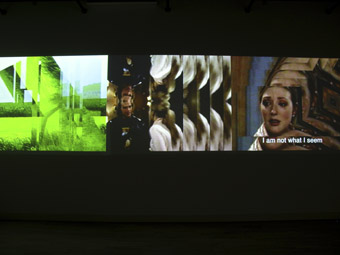
Linda Wallace, LivingTomorrow (2005)
THE GALLERY NEWYORKRIOTOKYO IS A TYPICAL INDEPENDENT ‘PROJECT’ SPACE IN BERLIN, DIRECTLY ACROSS FROM THE FORMER NO MAN’S LAND THAT SEPARATED EAST FROM WEST. BUT FOR THE EXHIBITION BACK TO BERLIN, AUSTRALIAN-BORN ARTIST AND CURATOR LINDA WALLACE TRANSFORMED IT INTO A SUBURBAN LIVING ROOM THAT OFFERED UP A CHALLENGING THREE-CHANNEL VIDEO TAKING ON MULTICULTURALISM, MEDIA AND MURDER AS THE EVENING’S ENTERTAINMENT.
Back to Berlin also presented earlier works, entanglements (2004), first shown at the Adelaide Biennial, and LivingTomorrow (2005) alongside a new work, TOR (2006), and a selection of silk prints of video stills. The show’s title refers to the fact that the Amsterdam-based Wallace lived in Berlin for a year recently, and that her mother’s family can be traced there from around 1650 to 1850.
Wallace works as a video artist utilising diverging, interweaving narratives created from found and self-made media-text, images and sound—all reworked and combined to reveal weighted meanings within the new structures.
In her earlier works Wallace played with digital and analogue textures. Lovehotel (2000) combined the cyberfeminist poetry of Francesca da Rimini with Wallace’s own video, and in eurovision (2001) reworked film and TV footage were displayed on various interfaces. Framing devices also made reference to emerging online environments of the web and the interplay of concurrent storylines.
LivingTomorrow goes one step further into narrative complexity. Here, the way the source material is viewed over the three screens is determined by a database, designed by Wallace while artist-in-residence at Montevideo in Amsterdam. While the Berlin version was exhibited as a three-channel DVD, the original was exhibited running from an archive of video clips and subtitles sent by the database to the screens and potentially in any order. The ‘story’ had to be written to accommodate randomness and still make sense to a viewer.
In Berlin, LivingTomorrow was viewed from the comfort of a well-worn couch, the white cube rejected for the wohnzimmer. It’s the familiar TV experience, whether located in former East Berlin or southeast Queensland, a universal ritual or, as Wallace says, “our window on the world.” The way the work is installed also gives permission to spend time with it, allowing the visual medley to wash over the viewer in an almost hallucinatory way. But if video art is the bastard child of TV, this work would have to be the mongrel half sister. Images of soap opera, wars, headscarves and the Dutch countryside merge with disjointed and repetitive subtitling to form unnerving storylines. While definitely a televisual experience, the images on the triptych of screens are digitally manipulated, creating an eerie reflection of the already mediated media image.
It’s a cut-up screen, the blonde American idols slashed and deformed, their overbearing silences and stares emphasised to the point of extremity, their repetition driving home the sheer banality of the confined spaces and studio sets so much a part of daytime soap opera. The Bold and the Beautiful is reputably the most popular TV series in the world, viewed by over 450 million people a day. Wallace herself became interested in the show while in hospital during the birth of her son.
But like a fractured mirror or a kaleidoscope, other images appear—a woman with a headscarf, machines of surveillance, a technology park and a corporate logo: “Living Tomorrow—Where Visions Meet.” Occasionally there are glimpses of beautiful naturescapes. The Dutch countryside of fields and open blue skies offers a wake up call to those locked in claustrophobic interiors.
Subtitles appear randomly, suggesting further narratives. Wallace has combined her own scripts with extracts from “The Coming Wars” in the New Yorker, “New Breed of Islamic Warrior is Emerging” in the Wall Street Journal, and Osama Bin Laden’s 2004 speech.
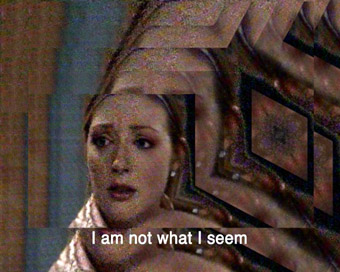
Linda Wallace, LivingTomorrow, detail (2005)
The subtitles written by Wallace herself carry the main ‘storylines.’ They involve a girl wanting to wear the headscarf, various murders and refusals of marriage. None is from The Bold and the Beautiful, but by their nature we are lead to trust their authority.
While The Bold and the Beautiful is glaringly distant from European life and a changing world, Wallace, with her foreigner perspective, creates a palpable reality, tackling a multinational Europe and conflict based on religious beliefs. Her images have a damaged tangibility: the transmissions of the soap opera were disrupted by a series of electrical storms which interfered with the reception. So although resembling analogue decay, the images were partly created by nature thus emphasising the materiality of the medium of television. Wallace describes the effect as “the weather hacking into the work”.
And this is not the only ‘reality’ injected into Wallace’s artmaking. While she was working on the project, the vehemently anti-Muslim Dutch filmmaker Theo van Gogh was assassinated near her home in Amsterdam. The realities of ethnic and religious conflict were literally brought to her doorstep. The initially abstract narrative for Living Tomorrow grew to include this event, yielding a visceral sense of place, abstracted in the soap, abstracted in nature, but rooted in the real.
The work’s landscape images also speak of place, and the difference between Dutch countryside of planned agricultural development versus the Australian bush. An Albert Namatjira print framed by curtains also hangs on the wall of the gallery. For Wallace, this print speaks primarily to Aboriginal Australia but is also reminiscent of the photographs of the outback in the Women’s Weekly she grew up with, a reminder of the bucolic and provincial nature of a ‘wild’ Australia but from a sanitised viewpoint.
Also hanging on the walls are silk prints of video stills from the works. One series is from LivingTomorrow. Another of a dead female Chechen militant, lying in the theatre seats after the tragic Moscow Theatre Siege of 2002, is from the work, entanglements, a montage of Australian news footage relating to war in the Middle East—the living room idyll shattered by actual political consequences.
In a corner is a short work called TOR (meaning goal), shot on the evening that Germany beat Argentina in the 2006 World Cup. Wallace’s take is once more a strangely multilayered grappling with what nationalism and identity mean today in a mixed Europe.
In TOR, German fans of all races, dressed in the yellow, red and black team colours, are euphoric with what can only be described as out-of-control, sports mania. They scream into Wallace’s camera, dance in the streets, harass drivers. A mother in camouflage pants dances wildly around her parked car while her children sit, bored, on the car roof. The spirit is of spectacle, but in Wallace’s showing it’s also silent. In a country where cultures clash, they are connected by the recognisable ensignia of a team, united by a tradition and rites different from their own.
The overlapping images and text in Back to Berlin allow the audience to walk in at any time and bear witness to the myriad meanings present in the global televisual world. LivingTomorrow is constantly generating something new, the story lines merging to create new realities and reflections on a world in flux.
Linda Wallace, Back to Berlin, NewYorkRioTokyo Gallery, Berlin, Jan 1-Feb 11; http://machinehunger.com.au
RealTime issue #78 April-May 2007 pg. 29
© Joni Taylor ; for permission to reproduce apply to realtime@realtimearts.net
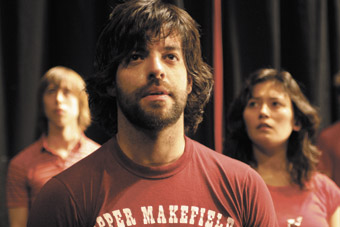
Daniel Linehan, Miguel Guiterrez, Michelle Boulé, from Everyone
photo Alex Escalante
Daniel Linehan, Miguel Guiterrez, Michelle Boulé, from Everyone
WHEN I ASKED AMERICAN CHOREOGRAPHER MIGUEL GUTIERREZ WHAT HE HOPED TO ACHIEVE ON HIS FIRST VISIT TO AUSTRALIA HIS EMAIL READ: “ ONE OF MY RECENT GOALS IS LEARNING HOW TO OWN THE EXPERIENCE THAT I HAVE GATHERED FROM MAKING PIECES OVER THE LAST SIX YEARS, YET AT THE SAME TIME LEAVE MYSELF OPEN TO CHALLENGE AND DISCOVERY… THAT SOUNDS VERY GIFT CARD I KNOW…”
This reaching for insight whilst deflating any emerging pomposity was what originally interested me in connecting Gutierrez to Australian artists. I saw him perform an excerpt of Retrospective Exhibitionist & Difficult Bodies at Danspace Project in New York in January 2005, during a visit for Critical Path to the annual Arts Presenters conference. I was struck by his self-mocking yet moving performance to a recorded after show-talk. Gutierrez’ notes were disarmingly honest:
I looked at that video of a show we’d done at Jacob’s Pillow and just laughed at how I sounded like a retarded valley girl. How can anyone (including me) believe any of this shit? It suddenly occurred to me that artists’ ideas are so important and meaningless at the same time.
Whilst in New York, I also heard about Shtudio, the weekly performance night Gutierrez was curating in an off-the-beaten-track Brooklyn studio. I was intrigued by the buzz he managed to sustain in a city burgeoning with artistic output. So when I heard, almost a year later, that Melbourne based choreographer Phillip Adams was keen to invite Gutierrez to choreograph for BalletLab, things began to fall into place.
With support from NSW Ministry for the Arts and The Australia Council, Gutierrez will lead a five-day workshop in May for ten NSW based choreographers entitled, What you think what you feel what you know to be real. He will also give a talk at The Drill in Sydney. Gutierrez’s original description of the project for participants read:
Creating performance is a way of tapping into how we locate ourselves in our lives and in the world. As such we attempt to find out what our own personal ‘truths’ are and make them known in our work, or sometimes they seem to emerge from our creations. In this research workshop we will look at the idea of what it means to be ‘real’, ‘natural’, ‘authentic’, ‘free’ and ‘open.’ We will work with a variety of methods of improvisation that valorize these terms and see how they relate to our understanding of the conditions and contexts of our work as makers and performers.
Now that he is approaching the engagement he is again disarmingly open:
I am a bit intimidated by my own language in the description of this workshop, but I think that is a good thing. I have led tons of workshops but I have a feeling this one will be quite different…I always like to use workshops as an opportunity to explore something new and unknown to me. In this case I feel like I’m a sort of ‘bridging space’ trying to understand methods and ideologies that I have worked inside of but move into the next phase of my own work.
In Melbourne, Gutierrez will join BalletLab’s third stage of creative development for their production, Brindabella, to be presented by Malthouse. He’ll create a short work that will sit, as a tableau, within Brindabella. Phillip Adams writes of Gutierrez’ intervention:
I am not interested in Miguel reacting directly to what has been previously conceived. He will take a section of our source, La Belle et La Bête, and re-position the story with his own interpretation. Miguel’s interpretation is silhouetting and contouring the evolution of Brindabella—helping to shape the artistic process towards a more refined and symbolic work. Additionally, I am interested in allowing the BalletLab Company dancers the experience of working in a dual choreographic situation. The experience of forming new relationships with international artists will enrich their artistic and professional development within and beyond the project.
Gutierrez is equally inspired:
This is an unusual proposition and, coming out of just making two evenings of work, I’m relieved to have the context for this piece already set up. It’s an exciting exercise. Also, I’m intrigued by the fact that Phillip’s work and my work don’t really look anything alike, so I feel like this gives us the opportunity to articulate what we’re doing more clearly.
Representing a new generation of American choreographers, rarely seen in Australia, Gutierrez is well established in his hometown, New York. As well as his work as a curator for Dance and Process at The Kitchen, he is also on faculty at the American Dance Festival, is frequently resident at the Ensemble Studio Theater’s Lexington Center for the Arts, and Danspace Project is co-producing his new work. He was a Movement Research Artist-In-Residence from 2001 to 2003. He has danced with Joe Goode, Sarah Michelson, Jennifer Lacey, John Jasperse, Jennifer Monson, Juliette Mapp and Ann Liv Young. In 2002, Gutierrez won a Bessie for his performance work with John Jasperse Company. He recently performed in Deborah Hay’s O.O and in June 2007 will dance in French choreographer Alain Buffard’s (not) a love song. Gutierrez was named as one of “25 to Watch” by Dance Magazine and “2005 Artist of the Year” by New York’s Gay City News. Quirky projects such as his creation of the dance video Deceptacon for electro music outfit, Le Tigre, add to Gutierrez’ appeal.
Since forming Miguel Gutierrez and the Powerful People in 2001, Gutierrez has created a series of productions with a critically acclaimed signature style. In 2002, the group presented 31 performances of its first evening-length piece, enter the seen, at Aqui the Bushwick in Brooklyn. The next production, I succumb, was presented to sold out audiences at Dance Theater Workshop’s Splitstream series in 2003.
dAMNATION rOAD premiered in 2004 at The Kitchen, sold out for eight nights and won a Bessie for visual designer Christoph Draeger, an artist who had never worked in theatre. In addition to collaboration on these group works, Gutierrez and musician Jaime Fennelly performed their improvisation-based duo, Sabotage, at a variety of venues along the eastern seaboard and in Europe. Retrospective Exhibitionist & Difficult Bodies premiered at Dance Theater Workshop in 2005 and was the work which established Guitterez’ name internationally at such prestigious festivals as Holland’s Springdance. Springdance has co-commissioned Gutierrez’s Everyone, which features nine performers and a new collaboration with musician Chris Forsyth. Everyone will premiere in April 2007. Gutierrez writes:
Everyone is about the world right now and right now and right now. Nothing is interesting. Everything is interesting. This is a huge failure. Nothing works. Nothing is going anywhere. There is nowhere to go. Everything is perfect. Everything is a perfect mess. I know now. I know who this is for. This is for us. This is for me. This is for everyone.
Alongside touring Gutierrez hopes to record the music he has been neglecting of late and talks about the need to “take a step away from creating to assess what to do next. I want to travel a lot and take in other ideas and questions and be released from my own…I want to learn again what it is to have an adventure.” An Australian adventure beckons.
–
Miguel Gutierrez Critical Path workshop, May 21-27, www.criticalpath.org.au.
Information on Brindabella is available at www.balletlab.com/news.
RealTime issue #78 April-May 2007 pg. 30
© Sophie Travers; for permission to reproduce apply to realtime@realtimearts.net
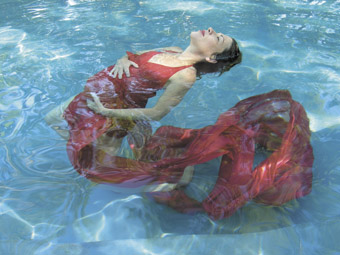
Rapt
THE NEW YORK DANCE ON CAMERA FESTIVAL IS ONE OF THE OLDEST CONTINUOUSLY RUNNING DANCE FILM FESTIVALS IN THE WORLD. AS SUCH, IT HAS HAD ENORMOUS INFLUENCE OVER THE DEVELOPMENT OF THE FORM: PROVIDING AN EXHIBITION SPACE, A PORTAL TO THE WORLD, A FORUM FOR CREATIVITY FROM TIMES WHEN DANCE ON SCREEN WAS BARELY EVEN KNOWN TO EXIST, THROUGH TO ITS CURRENT BOOM IN THE CONSCIOUSNESS OF DANCE CULTURE.
The Artistic Director of Dance on Camera, Deirdre Towers, bristles a bit when she hears people talk about dance on camera as ‘new form.’ It is a newer form than dance, but it is as old as cinema, older than contemporary dance, and much, much older than the ‘brat pack’ currently energising and expanding screendance creation and exhibition.
In fact, for Towers, dance on camera is not a new form but at least two old forms—and she struggles to straddle the divide in audiences and aesthetics for these two versions. To put it colloquially, there is an ‘uptown’ form and a ‘downtown’ form of dance on screen, and the venues for the New York Dance on Camera Festival play out and play on this divide. The festival is supported by the Lincoln Center Film Society, so one of its major screening venues is the Walter Reade Theater at Lincoln Center, a distinctly uptown venue with a 300 seat cinema, a 35mm projector, ushers and a popcorn vendor that also sells cappuccinos and ginger pistachio tarts. The regular crowd for this venue expects to see one of two things: documentaries about dance, preferably about famous dancers or choreographers, but possibly some ethnographically unusual mix, or dancefilms by firmly established names, Mark Morris, William Forsythe and Gene Kelly, for example, all of whom featured on this year’s calendar.
The other, the ‘downtown’ form of dance on screen is what we would call here the ‘independent’, but I hate this name because it implicitly creates a divide in legitimacy along the lines of infrastructure rather than approach. The other tags, ‘new’ or ‘experimental’ are also inaccurate: it is neither new nor experimental. The creation of a dancing screen—a screen work that emanates from a choreographic sensibility and combines the available manipulations of time, movement and energy in dance with those in cinema—is not new. It just wavers a bit in and out of cultural consciousness, and in so doing loses its history and knowledge base. Therefore it is also not experimental because the creative artists rarely test their ‘experiments’ against a stable control group or against documented knowledge or theories. What it is, this other form of dance on screen, is a working through of the possibilities of cinematic and choreographic properties towards the realisation of an image or idea. The subjects of these creations are not external, as they are in documentary—the films are not about something but are themselves the subject, they are dances in light and sound.
So, being old and venerable, and presenting both documentaries on dance and dances in light and sound creates some very interesting problems and equally intriguing possibilities for the Dance on Camera Festival. Towers and the new festival coordinator, Anna Brady Nuse, came up with some excellent lateral strategies for reaching each of their audiences, pushing perceptions of the form to cross out of their comfort zones and still allowing the festival to break even. Their energy and openness were rewarded with huge media coverage (the festival made regular appearances in the pages of the New York Times, the New Yorker, et al), strong audience attendance and a thought provoking festival.
One of Towers’ strategies was to open a third venue and present work under the title “Program devoted to dance narratives.” This screening was at the Maya Deren Theatre in Anthology Film Archives, which is downtown, yes, but it has proper seats and a 35mm projector, too. The program featured the 54-minute film I produced and edited, Thursday’s Fictions (directed and choreographed by Richard James Allen), which was my excuse for attending the festival, and two narrative shorts—Flying Days by Pablo Diconca and Another by Helena Jonsdottir. All three are works on screen that live in the space between dance and cinema to create what we at The Physical TV Company call “stories told by the body.” The audience that filled the house seemed to come from uptown and from downtown for this kind of experience, which plays with conventions to reach across the divide between character-driven drama and abstract movement to make a truly kinaesthetic cinema.
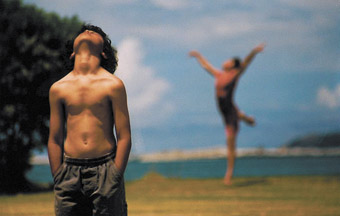
Break
Other festival strategies for pushing audiences across the divide included programming dance made for the screen as shorts preceding documentaries about dance, and presenting a rigorously curated evening of international shorts in the uptown venue. Two films from our region, Sue Healy’s Will Time Tell and Shona McCullagh’s Break, the festival Jury Prize winner, were on this program which, together with Thursday’s Fictions, made Australia/New Zealand a very well represented region. Surprising as it may seem to us, as we struggle for funding and screenings, the world thinks there is a lot happening down here in dance on screen and that it is leading stuff. The region’s representation at this festival certainly demonstrated that, especially when compared to some of the work I saw from the US.
The American Shorts program on the closing night of the festival was not just a strategy to include the ‘downtown’ in the festival, though it was held at a venue so far ‘downtown’ that it is was in Brooklyn, in a converted warehouse performance space with a gallery, a bar and a lived-in grunge that made me feel right at home. It was also a strategy to boost American production and visibility in a field dominated by Britain, Europe and Australia/New Zealand. I wanted the films on this program to prove Towers wrong when she said the history of dance on film is a history of men and technology and women in nature. Maybe it was just coincidence, but in the program, films that used technology—digital effects toys—were by men and the productions set in nature—trees, sunsets, water—were by women. None was especially well developed but the festival is acting in a catalytic capacity by creating this new program, hoping to stimulate the thinking and production values in its home country.
Also designed to stimulate thinking and production were the two free panels held in conjunction with the festival. There was “Meet the Producers”, where the powerhouses of dance on screen production from Britain (Portland Green of Capture) and Canada (Judy Gladstone of Bravo!FACT), talked about their organisations’ impact on dance on screen in a session moderated by newcomer Hélène Lesterlin, the curator in charge of a new American dancefilm commissioning fund, DANCE MOViES, at the Experimental Media & Performing Arts Center (EMPAC). And there was “From Cutting a Rug to the Cutting Room”, a panel moderated by Special Projects coordinator, Kelly Hargraves, which brought together three dancers who work professionally as editors—not just of dance films, but of all kinds of things—Monica Gillette (Sopranos, Law & Order, Progressive Coma), Robbie Shaw (Bittersweet) and myself. Or were we editors who dance? Either way, the sense that editing is a form of choreography came out with overwhelming force. We all agreed we work the edits through our dancers’ kinaesthetic intelligence—and it is in the edit suite where the two arts, cinema and dance, whether documentary or the other, cross the divide and both begin to dance.
35th Annual Dance on Screen Festival, New York, Jan 3-14
RealTime issue #78 April-May 2007 pg. 31
© Karen Pearlman; for permission to reproduce apply to realtime@realtimearts.net
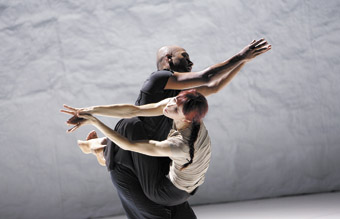
Akram Khan, Sylvie Guillem, Sacred Monsters
photo Tristram Kenton
Akram Khan, Sylvie Guillem, Sacred Monsters
AS WE’VE REPORTED IN REALTIME OVER RECENT YEARS, THE SINGAPORE ARTS FESTIVAL CONSISTENTLY BRINGS TOGETHER A FINE MIX OF LOCAL, REGIONAL AND INTERNATIONAL WORKS, OFTEN ON THE CUTTING EDGE AND IN A CITY IDEAL FOR AN EMBRACING FESTIVAL.
Just some of the artists featured in this year’s Festival include ballerina Sylvie Guillem performing with choreographer and dancer Akram Khan in Sacred Monsters, a dazzling duet which initially builds on childhood reflections in which the dancers dialogue with their respective danceforms. Elsewhere on the dance program, Michele Anne De Mey (Charleroi/Danses, Belgium) presents Sinfonia Eroica and Japan’s Saburo Teshigawara and his company, KARAS, perform Bones in Pages and New York’s Bill T Jones and Arnie Zane Company does Blind Date.
Among theatre productions from Singapore and China, Lee Breuer and his company Mabou Mines from New York will bring their DollHouse, a hit at the 2006 Brisbane Festival. Local company, The Finger Players, presents Wong Kar Wai Dreams in which a woman dreams of the famous filmmaker dreaming of her. Checkpoint Theatre will explore “how technology changes everything, except the strength and fragility of the human spirit”, in Cogito.
The music program includes Singapore’s own T’ang Quartet collaborating with Theatre Cryptic from Scotland on a new work, Optical Identity. Composer Tan Dun continues his exploration of organic music that incorporates elements of the natural world in Paper Concerto for Paper Percussion and Orchestra in which papers of different sizes and strengths are variously manipulated as percussion instruments, including paper cymbals, wax paper bags, and a ‘paper thunder tube’ invented by Tan.
There’s also a workshop program where you can wrestle with Meyerhold, Stanislavski and Brecht combined in a master class with Lee Breuer or get really physical with Breuer and Mabou Mines performer Maude Mitchell, or with Janet Wong in a workshop exploring the Bill T Jones’ repertory. Singapore beckons.
Singapore Festival May 25-June 24 www.singaporeartsfestival.com
RealTime issue #78 April-May 2007 pg. 30
© RealTime ; for permission to reproduce apply to realtime@realtimearts.net
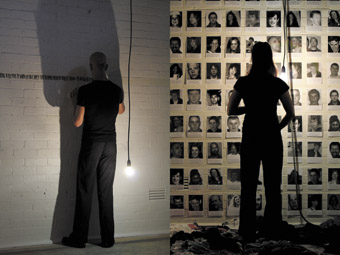
Brian Lucas, Avril Huddy, absence(s)
photos Fiona Cullen
Brian Lucas, Avril Huddy, absence(s)
ABSENCE(S) CROSSED THE BOUNDARIES OF DANCE, INSTALLATION ART AND PROMENADE THEATRE. THIS HAUNTING WORK CARRIED ALL THE METAPHORICAL FREIGHT OF ‘MOVING’, AND AIMED WITH PRECISION TO INCULCATE AN EXPERIENTIAL AUDIENCE REACTION. IT DID SO BY RISKILY LOCATING THE CENTRE OF THE WORK IN AN ABSENCE, IN THINGS UNSAID AND UNSPECIFIED. ADORNO INSISTED THAT “INTELLIGENCE IS A MORAL CATEGORY.” IN THAT SENSE, IT WAS THE SHEER INTELLIGENCE OF ABSENCE(S) THAT TRIUMPHED OVER POTENTIALLY ENNERVATING MATERIAL, OVER THE ACHING SADNESS OF THINGS.
The production played on our anxieties by immersing us in the concept. We were first separated from whoever we came with, then taken from the Judith Wright Centre in a group of strangers to an undisclosed destination and asked to remove our shoes and personal belongings. We moved through dim rooms constructed from plastic drops, through which we discerned dim traces of movement, heard faint echoes of voices. An entrapped performer, Avril Huddy, transfixed us as if we were sadistic voyeurs. Brian Lucas monstrously loomed, nastily reminding us in classic Lucas style that we, too, were being watched. We encounter a loft with a well full of shoes. Teetering amidst the debris, Vanessa Mafe-Keane, as a survivor, sought equilibrium. Rules were set in a prelude to a larger movement as the space gradually opened into its entirety. A panoramic shot of the last group seen through the plastic dividing the length of the space was breathtaking, a tyro effect of lighting design and placement straight out of Schindler’s Ark.
Barred windows, stark walls, the audience as crowd fixtures in the installation. Reproductions of the missing along one side, inadequate descriptions of the appearance of somebody already disappeared. The Freudian concept of introjection tells us that in mourning the loss of a loved one the ego is also mourning the loss of a part of itself. This was made graphic by the excruciating tension of Huddy attached to Tammy Meeuwissen by cotton strings, by the heart piercing declaration that “it hurt.” Rumours of knives, memories are scars, projections into the future stymied in one of the most disturbing interludes between Lucas and Mafe-Keane: she wondered if she should change ‘his’ room, while Lucas performed a mad tarantella as he moved into her empty spaces. Dyson choreographs possessed people with the mordancy of an angel. Slide projections transversed the space with unnerving lucidity.
The environment, created by Brett Collery’s darkly ambient sound, Mark Dyson’s filmic lighting and Bruce McKinven’s installation, simply but powerfully evinced what Frederic Jameson has called (in relation to postmodernism) “the displacement of time, the spatialization of the temporal.” The mass produced, black and white photographs of missing persons irreducible to individual identities suggested the phenomenon of a human consciousness likewise unsituated, unlocated. The pit of shoes, the clothing beneath our bare feet, threatened to inundate us, to engulf us in a chaotic miscegenation of all identities by insisting on the subject’s necessary relation to death, to corporeality, to the abject materiality of shoes and clothes. History was invoked but only as a residue, or a deposit, of imagery and association (the Nazi death camps, the ‘disappeared’ in South America), signs that floated free from what they designated in a way that constantly threatened to open into a void. This was a vertigo-inducing theatre of traces, lines, demarcations. No redemption.
Nevertheless, Clare Dyson seemingly holds to the feminist belief that the ‘personal is political.’ Even if interpretation was a relative exercise, or subjects had little authenticity, there was a structural clarity that spoke well, that clung to an ethic of speaking well in times that enforce us, in Dyson’s words, “to segregate, to isolate, to dislocate.” The decentralisation of theatrical presence forced us to abandon a fixed, fetishistic attention to the performers’ bodies, forced us to move, to cease to be spectators, to find our own psychological and moral truths. We were constantly being invited to look elsewhere, to make choices, to become part of the performance, to absent ourselves.
In this first stage of a compelling new site-specific project Clare Dyson and her scintillating team created a hyperbolic, fractured space of uncertainty, of disconnection, disappointment and loss. But exhilaration lay in the artful play with boundaries, the risks taken with the Janus nature of disappearance and appearance, and in the constant swing between visceral agitation and mental reflection. Dyson has said that she wanted the audience to feel that the concept was in everything, but this was surely a way of saying that the concept was nowhere, neither in the theatre nor out of it; it was more a matter of positioning. In her theatre of revenants, of invisibles, of alarming traces, it was we who were at stake. We who will one day disappear.
Absence(s), created by Clare Dyson in collaboration with performers Avril Huddy, Brian Lucas, Vanessa Mafe-Keane, Tammy Meeuwissen, lighting design Mark Dyson, design Bruce McKinven, sound design Brett Collery; Judith Wright Centre for Contemporary Arts, Brisbane, February 21-24
RealTime issue #78 April-May 2007 pg. 32
© Doug Leonard; for permission to reproduce apply to realtime@realtimearts.net
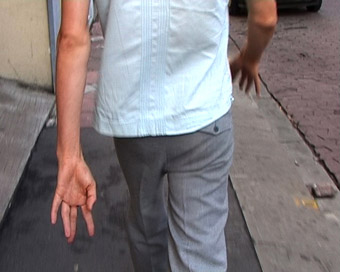
Se Fondre
NURIA FONT, THE FORCE BEHIND IDN FESTIVAL IN BARCELONA, HAS PLAYED AN ACTIVE PART IN DEVELOPING THE PROFILE OF DANCE AND MEDIA OVER THE PAST DECADE OR SO, CURATING PROGRAMS THAT SHOWCASE THE MORE EXPERIMENTAL WORK IN THE FIELD FROM SHORT FILMS TO INTERACTIVE INSTALLATIONS AND PERFORMANCE. AFTER SOME LOGISTICAL PROBLEMS THAT PUT HER ANNUAL EVENT ON HOLD, FONT WAS BACK THIS YEAR WITH A NEW ORGANISATION, NU2, WORKING WITH AN AUSTRALIAN BASED IN BARCELONA, NURIA RODRIGUEZ.
The festival was split into 3 parts: Enscenes Interactive, a program of stage works “that generate a dialogue between choreography, staging, performers and digital tools”; VideoDansa Barcelona, an international dancefilm competition; and Installations where the body “becomes the common ground between dance and the visual arts.” The expansion of dance screen festivals to encompass related work in the visual arts and performance is clearly the next step in bringing screen culture into a novel relationship with dance communities and audiences. As screen culture develops, so too must these festivals if they are to accurately reflect the interface between the moving image, the body and performance.
Recently, there has been a new level of investment in the work being done at the interface between dance, the screen arts and visual arts through initiatives such as the Arts Council of England’s CAPTURE program and organisations such as FORMA (UK), KKM (Germany), The Wellcome Trust (UK) and EMPAC (NY), and increasing opportunities for presentation in galleries as well as venues like Sadler’s Wells Theatre (UK) and specialist events such as Monaco Dance Forum. And the use of new media in dance performance seems to be finally coming of age, apparently nowhere more so than here in Australia. The jury for the competition, of which I was a member, were involved in an open forum where many of these issues were discussed, along with the state of the art of dancefilm production specifically and the network of supporting organisations worldwide.
As a model for an expanded dance and media event, iDN was ambitious. The performance program included 4 works, one being a double-bill. Apparition by Austrian Klaus Obermaier was an empty display of technology with projections of geometric patterns onto a screen at the back of the stage contrasting with images projected on two dancers downstage who functioned as small moving screens. The effect was as dazzling as fireworks and as void of meaning, especially toward the end where tiny dots of light filled the screen and bounced off the bodies performing banal gymnastic choreography. Returning to Australia to see Chunky Move’s excellent Glow, which used similar technology to much greater effect, certainly put Obermaier’s work in its place. Para_site by K.Danse in France was a monotonous demonstration of interaction between a sensor laden dancer and sound and image. Surrounded by multiple small screens, the dancer’s movement suggested struggle and frustration, with little variation for performer or audience.
T.P.O. Company from Italy, seen at Melbourne Festival last year, presented Il Giardino Giapponese, an interactive performance for children and adults. Based on a Japanese fairytale, the performance begins with the story before we are moved to a large touchscreen mat where the performers act out the journey in the tale before inviting audience members to participate. The ease of the interface and the performers matching of tasks to age-appropriate children created a smooth and absorbing experience, not least of all for a passive spectator observing the tentative, quick and curious immersion of the kids in the virtual environment.
Font’s own Arbraçada, created with collaborators, was presented as the first half of a double bill with Hiroaki Umeda’s While Going to a Condition. Arbraçada featured a solo dancer moving in a fluid and low-key way through a ‘forest’ of papery sculptures in the shape of bustled Victorian skirts. At times she stops and moves her arms only, at one stage with her waist perfectly matched to a ‘skirt’, a match that would alter with each audience member’s perspective. A curved screen behind the dancer is then filled with the image of a forest, a point-of-view shot that shifts to take in symmetrical rows of trees planted for logging. The dancers’ actions appear on the screen/in the forest like a ghosting effect, but the technology jars with the serenity of the performance and landscape, seeming out-of-step. Umeda’s solo performance is a slow build, beginning with a still dancer onstage, a minimal electronic score and bold black and white rear-projected graphics, and climaxing with the dancer frozen in a lunge, face to the sky, with a blinding strobe and ear-splitting white noise. Umeda’s dance-style combines the control of Japanese dance techniques with the sharpness and musicality of hip-hop. (A video re-work of this solo, Montevideoaki, was screened at ReelDance 2006.) The simple, striking and perfectly synched visuals and sound provide a perfect backdrop for this riveting performer.
For the international dancefilm competition, VideoDansa, 77 films were shortlisted by the festival organisers from submissions and nearly twice as many screened continuously throughout the event in a cinema and on monitors. An international jury of five then selected around nine films from which the winner and special mention were selected. The winner of 6,000 euros was Se Fondre by Belgian filmmaker Antonin de Bemels. This half-hour film is a progression of de Bemels’ investigation into the obscuring of body parts through repetitive movement and rapid editing, placing these moments of corporeal misbehaviour into a narrative context. The triangle of characters in the film is trapped by an immobility that echoes their thwarted attempts at communication.
Miranda Pennell (UK) was awarded a special mention for You Made me Love You [RT77, p35], in which a class of young dancers follow the gaze of a camera at close range as it shifts randomly, as the sound of shuffling feet accelerates and slows with the gliding frame. Other finalists included ReelDance 2006 People’s Choice winner, Break (Shona McCullagh, Australia), ReelDance 2006 winner, Nascent (Gina Czarnecki, ADT, Australia) and shortlisted films Swift (Margie Medlin, Ros Warby, Australia), Soma Songs and Seismos (Daniel Belton, New Zealand), Once in a Blue Moon and Will Time Tell? (Sue Healey, Australia) and Pod (Narelle Benjamin and Samuel James Australia).
This festival was inspiring in its vision and scope and the international award for dancefilm with a cash prize is an exciting addition to the numerous awards worldwide that now provide support for artists in the field. Once it has had time to settle, NU2 will no doubt continue to help define a still nascent but growing field of practice and, in the process, help to bring recognition to artists bridging disciplines.
iDN Imatge Dansa i Nous mitjans; Caixa Forum and Mercat de les Flors, Barcelona, March 1-4
RealTime issue #78 April-May 2007 pg. 32
© Erin Brannigan; for permission to reproduce apply to realtime@realtimearts.net
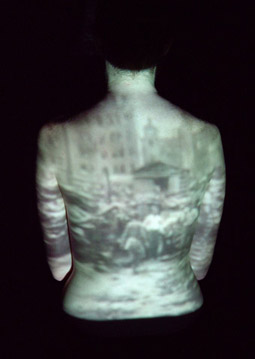
Aisling Donovan in Aimee Smiths’ Courageously Heroic Gallantry, Four on the Floor
photo Aimee Smith
Aisling Donovan in Aimee Smiths’ Courageously Heroic Gallantry, Four on the Floor
four on the floor
STRUT DANCE’S FLOUR ON THE FLOOR OPENED WITH BIANCA MARTIN’S FUN, BOUNCING LIVE MUSIC VIDEO, DIVERTISSEMENT, TO SPIDERBAIT’S SHAZAM, A TONGUE-IN-CHEEK PIECE OF YOUTHFUL SEX APPEAL AND SIMPLE BUT SHARP, COORDINATED POSES.
Phillippa Clark presented projections and a duet accompanied by Steve Reich’s edited interview with a rabbi, scientist-commentators Richard Dawkins and Stephen Jay Gould, and others, about the implications of genetic engineering, taken from Three Tales: A documentary video opera. This concert performance of Reich’s music with Beryl Korot’s images was in the 2003 Perth Festival. Clark, however, jettisoned the documentary premise whilst also avoiding narrative, building instead close, formal partnering at times segueing into moments of overt emotional expressivity, and even snatches of obtuse mime. The interest of Clark’s interpretation lay in this curious exchange between these two approaches, never quite becoming dance theatre nor allowing the hieroglyphics of body shapes and their placement in space alone to tell the story. The poses were generally wide dominated by full limb extensions and careful angularity. Jacqui Otago—a regular collaborator with Clark—was particularly adept at maintaining this balance of the formal and the expressive, her body perfectly occupying a space between the hard tension which a solely formal approach would require, versus the curved suppleness of the body on the edge of melodrama typical of much Expressionist dance. Otago’s was a thoughtful yet soft embodiment, consciously negotiating her way through space and feeling. Clark’s projections were also tightly crafted, acting as the lighting (although this sometimes flattened the choreography) and consisting of black blocks slashed by white and red, as well as text from the score. For all her achievements though, Clark could not compete with the quality (nor the logistical support) of Reich and Korot.
Four on the Floor’s highlight was Aimee Smith’s Courageously Heroic Gallantry, a follow-up to last year’s work with WAAPA’s Link Dance Company, Alpha Beta. Both pieces staged a series of disconnected, illogical acts using props and objects in a fashion reminiscent of Phillip Adam’s schizoid creation of theatrical ruin in pieces like Endling (2002). Smith’s last work, 53 (2006), was a fascinating if uneven meditation on time, repetition and memory, and Gallantry demonstrates her increasing mastery of a varied choreographic and scenographic palette.
Where the music for Alpha was a pastiche of clinical yet aggressive sounding, decontextualised nouns taken from George W Bush’s State of the Union address, Smith’s latest work employs US rock’n’roll classics from Elvis Presley and Otis Redding in an overtly militarised fashion, including references to Guantanamo and other topical issues. Dancer Aisling Donovan features just the right mix of po-faced roboticism in becoming subject to outside forces, whilst allowing a sense of horror and exhaustion to creep into the increasingly demeaning (or simply bleakly insane and funny) twisted poses she offers—all under the projections of Bush et al. Donovan poses behind a plant and snaps in front of a desk before turning her back to the audience, undoing her top, and standing mute while footage of war plays across her torso. Although the use of black and white combat film (presumably from the Korean War) seemed inconsistent, the music and costuming (a khaki green mini) evoked the obscene conflation of logic, violence and sex in that other great US military adventure—Vietnam—and its ambiguous fictions like Apocalypse Now. With Courageously Heroic Gallantry performed in a setting reminiscent of a senior bureaucrat’s office, such disorders constituted a seductive and disorientating spectacle “in the middle of all this shit”, in the words of Coppola’s film.
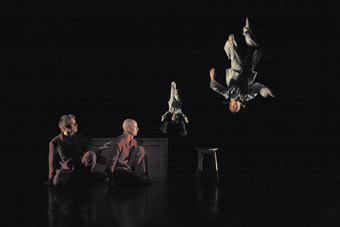
skadada, aureo
photo Danny Khoo
skadada, aureo
aureo
Skadada’s Aureo from Jon Burtt and Katie Lavers was an episodic, almost vaudevillian circus show distinguished by virtuosic young performers and projected images from aerial landscape photographer, Richard Woldendorp.
Aureo’s acts were linked by the motif of a large child’s trunk from which the protagonist imagined producing spectacles for her nocturnal amusement. This dramaturgical conceit wore thin with performers entering and exiting off stage as well as via the box. Also inconsistent were the types and moods of the acts, with striking, slowly posed aerial sequences (the strongest elements in Aureo) replaced at one point by an almost ballroom-dancing-style solo. The use of black theatre techniques was reminiscent of the illusionism and surrealism of Philippe Genty with the same tendency to feel laboured. Likewise, the protagonist spinning 180 degrees in the air many times was a mundane effect which did not merit such repetition. A mock conflict between Burtt and another male over the affections of the dancer was also awkward.
Nevertheless, the aerial work was exceptional, skirting the pseudo-eroticism of female contortionism common in traditional circus and Cirque de Soleil, whilst revelling in the sensuality of bodies bent, twisted and balanced upon each other or coiled about ropes and fabric before dropping down in long falls—all within a design glowing with reds, greens and blues. The inclusion of grotesquely manipulated bodies—notably a trinity of women who, when rolling on the ground, morphed into a multi-limbed torso—echoed the tendency in circus towards monstrosity and impossible, non-human bodies—an aspect of Skadada’s Electronic Big Top (1999).
Although I found the use of World Music fusions culturally objectionable, and little better than playing clichéd ‘harem-music’ behind Hollywood dancing girls and rope tricks, Aureo nevertheless constituted an interesting statement about land and identity. Woldendorp’s images are iconic of not just Australia but also WA. His use of aerial photography, though, often turns his works into abstract studies of form and colour with an ambiguous connection to specific locales. Aureo was suffused with this sense of displaced nationalism, of the Australian, athletic body-beautiful rendered strange and even vaguely threatening. Freud claimed such uncanny spectacles represented the “return of the repressed” and it is this manipulation and interpenetration of the familiar and the strange which is Skadada’s strength.
Strut, Four on the Floor, curator Sue Peacock, choreographers Bianca Martin, Phillippa Clark, Gary Lang, Aimee Smith; PICA, March 8-11; Skadada, Aureo, director Katie Lavers, director, choreographer, performer Jon Burtt, music John Patterson, Lo Key Fu, lighting Andrew Lake, images Richard Woldendorp, costume Karen Keeley, His Majesty’s Theatre, Jan 17-20
RealTime issue #78 April-May 2007 pg. 33
© Jonathan Marshall; for permission to reproduce apply to realtime@realtimearts.net
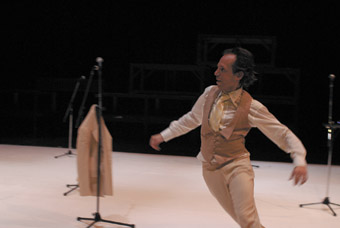
Martin del Amo, Never Been This Far Away From Home
photo Heidrun Löhr
Martin del Amo, Never Been This Far Away From Home
IN THE HIGH TECH, HIGH ART, HYBRID TREND OF CONTEMPORARY PERFORMANCE, PERFORMER MARTIN DEL AMO IN HIS LATEST SOLO PIECE, NEVER BEEN THIS FAR FROM HOME, BRINGS IT ALL BACK TO BASICS—VOICE, MOVEMENT, A BARE SPACE AND GOOD OLD FASHIONED MICROPHONES WITH CHORDS AND STANDS. SOPHISTICATED SOUND AND LIGHTING DESIGN SUPPORTS THIS WORK, BUT NO VISUAL FX MEANS STORYTELLER DEL AMO CREATES A LANGUAGE OF IMAGERY AND LEADS THE AUDIENCE INTO A WORLD OF THEIR OWN IMAGININGS.
The work of the solo performer is always risky. What if the telling fails, what if the audience doesn’t get it, what if they fall asleep—“what if they want me to shut up and just dance?” Del Amo doesn’t falter over such concerns, but methodically carries out his set task—to share with us the journey of his explorations: notions of home, the void of fear, danger and the unknown, where the edges of dreaming and reality meet.
A man in a white suit seems to hover in the space. As our eyes become accustomed to the dim light we see he is moving towards us across a white floor, his slight frame strangely trapped in the formality of his dress (aptly designed by Virginia Boyle). Carrying his polished brown shoes, he is barefoot, as if he has escaped—crept away from somewhere. Behind the white performance square, sitting at a table, sound artist Gail Priest ‘plays’ a laptop, feeding the buzzing soundscape into the air. To his left, also just outside the square, lighting designer and technician Clytie Smith watches intently for his next move. In darkness, barely noticeable around the square, the shapes of large crates and scaffolding loom. Mirabelle Wouters’ set is deceptively simple—speakers, back stage gear, and on the edge of the mat, 10 microphone stands, like metallic one legged birds, wait to take flight.
The man makes himself tall and puts his shoes down at the edge of the white floor. He walks back to a microphone and begins to speak. “What most people are afraid of is the void, nothingness”, he tells us, “but the void can be taken literally—take silence for example.”
The series of tellings begins, punctuated by voiceless dance pieces and slow, deliberate placings of microphone stands about the square. Following him all the way, the under pattern of electronic sound and subtle lighting supports the progression of his journey.
He walks to the edge of the white square and brings a microphone stand onto the space, placing the chord carefully in a straight line. Speaks. Brings in another—its chord in a diagonal line meeting the first at a triangle point.Then another, and another. Gradually, the performance square is crisscrossed with chords like lines on a map—countries perhaps, or sections of a brain. At each microphone he tells us of his fascination with expeditions and the failures of explorers; of danger and of a torture witnessed by a friend in a childhood forest. There’s the story of the philosopher Walter Benjamin who committed suicide at the French/Spanish border during WWII when he really didn’t need to, and a retelling of how to use word association to escape the recurring dream of a white room with no windows and doors. There are tips on how to survive a crocodile attack and the tale of a friend, Sylvia, who went off to play Russian roulette with women she met on the net and hadn’t been heard of since. “If someone doesn’t speak to you it’s as if a void opens up. It reminds you how disconcerting silence can be.” Back to the silence.
Slowly, the man unplugs all the microphone chords and reels in the leads. Released from its criss-cross of lines and sections, the soundscape soars as del Amo runs, skips, twirls and skates his euphoric dance across the white—fearless, borderless and free.
If the structure of story/movement/story/ movement feels a little predictable at times, by the end it seems to fit the setting of boundaries needed to combat fear. Breaking free requires courage, strength, skill—all of which del Amo displays in his choreography and in the execution of Never Been This Far From Home. And yet there is a vulnerability in the performance of his man/boy stage persona that you sense his creative collaborators (all women) have encouraged and made possible. With their help, it seems Del Amo’s refugee from other worlds, other feelings, behaviours and longings, has finally arrived home.
Never Been This Far From Home, devised and performed by Martin del Amo, sound design Gail Priest, set design Mirabelle Wouters, lighting design Clytie Smith, Performance Space, CarriageWorks, Redfern, Sydney, March 7-17
RealTime issue #78 April-May 2007 pg. 34
© Jan Cornall; for permission to reproduce apply to realtime@realtimearts.net
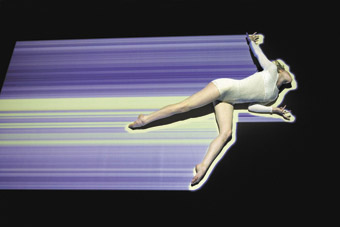
Kristy Ayre, glow, Chunky Move
THEATRE LIGHTING ELUCIDATES MOVEMENT AND GENERATES MOOD. DESIGNER MAGICIANS SEDUCE YOU INTO BELIEVING THAT LIGHT EMANATES FROM THEIR SUBJECTS OR THAT DANCERS MOVE AND SHAPE THE LIGHT ABOUT THEM.
In Chunky Move’s Glow we are moved onto another stage in illusion-making: the dancer really does determine the extent and patterning of the light field.
We’re positioned around and above the dancer, her floor is the screen. That which lights her—video projections doubling as light source—is also moved by her. The machinery responds intelligently. Light trails behind her in painterly sweeps as she drags herself across the floor, shoots out grids around her supple frame from moments of tiny movement, and forms shadows from which, remarkably, she walks away.
We’ve seen performers trigger sound and light before, but not like this. As with such demonstration model stuff, you need a bit of sturm and drang to show it off. Glow offers just that in its dynamically immersive 26 minutes. The emergent art tool is at one with the dancer’s body in an account of an emergent organism, a huddled in-human shape inching across the screen-floor pulsing out colour and light and gradually assuming human proportion as it stretches and unfurls. The imagery it generates is initially a clean geometry but, once the evolved woman stands and walks, the floor blooms into dark shapes beneath her. These are the shadows she leaves behind. But she is no longer alone as they threateningly glide up to her. No longer the sole generator of light and life, fangs bared, she unleashes a guttural primeval cry. Evolution is suddenly more complex, as frightening as it is beautiful.
Glow, created for Chunky Move by artistic director Gideon Obarzanek and German interactive software creator Frieder Weiss, and with an engrossing score from composer Luke Smiles, was performed nightly by three dancers in turn (Kristy Ayre, Sara Black, Bonnie Paskas) for the Sydney season. The demanding choreography is at its best in the early stages of creature emergence where every nuanced movement of limb, torso or hand yields subtle transformations in the world around the dancer, the very world she is also creating.
–
Chunky Move, Glow, The Studio, Sydney Opera House, March 21-25
RealTime issue #78 April-May 2007 pg. 34
© Keith Gallasch; for permission to reproduce apply to realtime@realtimearts.net
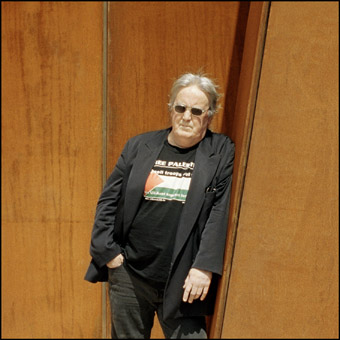
Lindzee Smith, photo Rod McNicol
LINDZEE SMITH FELL INTO A LONG SLEEP ON FEBRUARY 24 2007, SURROUNDED BY FRIENDS AND FAMILY AND, AFTER WEEKS IN HOSPITAL FIGHTING THE INCREASINGLY INEVITABLE, RAGING AGAINST THE DYING OF THE LIGHT, DIED FROM WHAT IS CALLED ‘POSTOPERATIVE COMPLICATIONS’, HIS LEFT LEG AMPUTATED, HIS BODY DIABETIC, LUPOID, ULCERATED, MEDICATED FROM LEFT AND RIGHT, HIS MIND PLANNING UNTIL THE END HIS PRODUCTION OF A JACK KEROUAC PLAY, LYING ON HIS BACK LISTENING TO THE SCREAMS OF ARTAUD READ TO HIM FROM HIS BEDSIDE BY THIS VISITOR OR THAT. HE SUFFERED UNTO DEATH FROM A DECADES-OLD IMMUNE DISORDER, BUT HE LIVED DESPITE THIS WITH A MONSTROUS HUNGER FOR EVERYTHING ABOUT LIVING AND AN UNQUENCHABLE THIRST FOR SHARING ALL THE SPOILS ON THE TABLE.
Lindsay Brian Smith—Lindzee, Ironman, Captain, the old L-dog-theatre director, actor, artistic terrorist, urban cowboy, vagabond, tuning into the world by working on the Nightshift, the Falstaff of late 20th century Melbourne theatre. Like Falstaff disdaining the seat of power but claiming through sheer force of energy, artistic vision and quality of presence the role of power generator for a generation of alternative theatricals, fringe dwellers and subversives. Lindzee, co-founder in the late 60s of the Australian Performing Group (APG) and at the same time always its sharpest critic, the one who embodied and accepted the consequences of his vision: life as art and art as life and both at the edge of death—a vision that felt like it was at the soul of the ten years of existence of that extraordinary and culture-shifting theatre collective. Lindzee inspired us all with his resounding answer to Beckett’s haunting question: “is it not better to abort than to be barren?”
Lindzee Smith’s list of productions speaks for itself: putting onto stage for the first time, as either actor and/or director, the early work of Romeril, Hibberd, Buzo and Williamson. With these writers and alongside Blundell, Dwyer, Hawkes, Finney, Davies etc, Smith launched a body of work that brought into the theatre a contemporary urban Australian life and language of word and action unseen before. Nothing in theatre, film or TV has been the same ever since. In the new home of the Pram Factory, Smith continued working, particularly on John Romeril’s plays, directing three of that writer’s most powerful texts: Chicago, Chicago, The Floating World and The Golden Holden. But it was also around this time, in the mid-70s, when the APG was arguably at its most successful peak, critically and with the public, that Lindzee became dissatisfied with the epic historical direction of the company’s work, its attempt to find for an Australian public its homegrown heroes and legends. He introduced into the repertoire plays by Brecht and Handke. And then he disappeared overseas on the first of his many forays to New York, which increasingly became his home over the next two decades.
The next phase saw Smith at his most active, alternating between New York and Melbourne. In Melbourne he built around him the group Nightshift in order to produce works by playwrights whose work he brought back from New York: Kroetz, Fassbinder, Shepard, Heathcote Williams and Handke. Nightshift included artists such as actor/ designer Carol Porter and the playwright/actor Phil Motherwell, with whom Smith was most closely linked artistically for this phase of his career. Its work cut a new image within the Australian aesthetic: that of the theatre terrorist—which reached its climax with the production of Motherwell’s Dreamers of The Absolute, about a group of young Russian terrorists, presented in the late 70s. It set a precedent from which many successive theatre artists have drawn.
In New York, Smith worked his way into the resurgent Off Off Broadway scene, directing plays by James Purdy, Tennessee Williams and Sam Shepard, and becoming part of the Squat Theatre Collective with whom he toured Europe. Most significantly, he brought to New York the works of playwrights Motherwell and Daniel Keene and along with them a particular brand of courage and effrontery that secured him a strong place within the post-punk scene.
Lindzee Smith worked and lived with humour and gusto. He had moments of bitterness in his last years at his lack of recognition in the Australian social and cultural scene. His was a star that burned white-hot and was destined to extinguish early. He gave to his friends, his fellow workers and his audiences a glimpse of fine madness transformed at its best into unforgettable art. His family perhaps were the great losers in his commitment to the wider world and he knew and regretted that. But they gathered around him at the end: his wonderful Mum, Maisie, brother Garth, ex-wife Margot, sons Andrew and Danny and three grandchildren whom he adored.
Hasta la vista, Lindzee Smith.
RealTime issue #78 April-May 2007 pg. 35
© Richard Murphet; for permission to reproduce apply to realtime@realtimearts.net
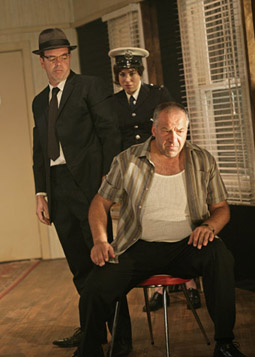
Kevin Harrington, Alison Bell and Tony Nikolakopoulos, The Spook
photo Jeff Busby
Kevin Harrington, Alison Bell and Tony Nikolakopoulos, The Spook
ONE OF THE UNEQUIVOCAL RESULTS OF THE’ WAR ON TERROR’ HAS BEEN THE NORMALISATION OF AUSTRALIA’S INTELLIGENCE AGENCIES AND THEIR ACTIVITIES. IN THE PAST, THE EXISTENCE OF AGENCIES SUCH AS THE AUSTRALIAN SECRET INTELLIGENCE ORGANISATION (ASIO) AND THE AUSTRALIAN SECRET INTELLIGENCE SERVICE (ASIS) WAS BARELY ACKNOWLEDGED. NOW, ON THE SURFACE AT LEAST, THEY LOOK AND ACT LIKE ANY OTHER PUBLIC SERVICE AGENCY.
In some ways this might seem like progress. Stripping intelligence agencies of their James Bond mystique is long overdue and, in theory at least, ought to promote more accountability. Less reassuring, though, is the way intelligence agencies and their activities have become entrenched as part of the social fabric. No longer seen as exceptional, they are fast becoming just another arm of police enforcement.
This development is particularly disturbing given that Australia’s intelligence organisations have been given wide-ranging new powers that seriously erode freedoms and rights, and they are significantly increasing their personnel. ASIO alone has embarked on a massive recruitment drive—2000 new staff are currently being recruited—aided by slick press ads and regular posts on Seek.com.
Melissa Reeves’ The Spook looks back to a time when recruitment was a more cloak and dagger affair. Based in fact, The Spook tells the story of Martin Porter who as a young man is recruited at a local football match by an ASIO controller to spy on the South Bendigo branch of the Communist Party of Australia. Martin ingratiates himself with the other members, in the process becoming alienated from his mother who believes him to be a bona fide Communist and, eventually, his wife who, though aware of her husband’s double life, tires of their alienation from the local community. Martin ends up befriending—and betraying—those he spies on.
There’s a lot that’s likeable about The Spook. The scripting is tight and well paced and the performances are uniformly strong. Kevin Harrington is perfect as the bland and officious secretary of the Communist Party branch, Frank Nash, for whom sales figures of The Tribune are as important as world historical events. Tony Nikolakopoulos and Maria Theodorakis are warm and passionate as George and Eli Tassekis, who extend their friendship to Martin.
Even some of the minor characters are brilliantly observed. A particular highlight was Alison Bell’s portrayal of one of the members of the communist party branch who routinely arrives late to branch meetings and sits there, frowning and fidgeting, as if caught in history’s headlights. In only a few lines, she manages to create a complex and layered character.
Despite some nice performances and subject matter dealing with an intriguing and largely forgotten episode in Australia’s political history, The Spook, for the most part, contents itself with nostalgia, frolicking through Australia’s past, rather than actively engaging with it.
That’s not to say there is no commentary on the present. For example a reference to Maoists in the classroom is a neat sideswipe at Federal Education Minister Julie Bishop’s recent claim that Maoist ideology is rampant in our schools.
Similarly, after his arrest by Immigration for using a false name on his passport, George is asked about his views on the Berlin Wall in an interrogation. “Do you think we should have a wall like that around Australia?”, he’s asked by the defenders of freedom—a deft counterpoint to our own defenders of freedom who seem relaxed and comfortable about erecting bureaucratic walls to keep out all those pesky asylum seekers.
And, after expressing some doubts about his own spying activities, Martin’s ASIO controller exclaims there’s “no room to make niceties…this is a war Martin”, the echo of which can be heard in the pushers of the ‘war on terror’ whose defence of ‘our way of life’ extends to destroying some of the very things —freedom and the rule of law—that define that way of life.
But these are brief, passing moments of reflection that are not sustained. Rather than meditating on the role of intelligence communities in a society that professes to live by the tenets of liberal democracy, The Spook opts to take a light romp through this episode of Australia’s history. When the narrative does shift into a more serious register, any sense of drama is quickly dissipated by a quick return to gags.
One of the final scenes, for example, sees Martin confessing his double life to his mother who, recovering from a stroke, no longer knows who he is. It’s a potentially tragic and poignant moment, but the comic situation created by Martin’s mother’s failure to recognise her son or the seriousness of what he’s saying undercuts the drama. Though far preferable to an earnest and didactic treatment, the light-hearted, nostalgic treatment of Martin’s fate dampens any dramatic potential.
In part, the potential of The Spook is let down by a weak central character. Martin is intended to be an everyman: the uncomplicated country boy who loves his country, is in the local football team, plays trumpet for the CMF and is a member of the air cadets. He’s also uncompromisingly dull. He starts out as optimistic, if pathetic and inconsequential, and ends up as pessimistic and even more pathetic and inconsequential. It’s only at the play’s end, when he questions his double life that Martin shows the kind of psychological complexity that might enable deeper reflection on the past, present and future. But he’s too slight and bland a character to carry anything more momentous.
One of the unintended consequences of this lack of drama is that The Spook, in spite of portraying the betrayal and the deportation and the forced separation of an immigrant family and the destruction of people’s lives through the banal workings of bureaucratic machinery, leaves the impression that the activities of spy agencies are all a bit of lark. In smothering the dramatic potential of the material, The Spook leaves the impression that the past was a more innocent place.
And what of the present and the future? The Spook seems to have little to say about who we are now or what we might become, ending up a lost opportunity to use history as a way of shedding light on where we are and where we might be headed.
The Spook, writer Melissa Reeves, director Tom Healy, performers Alison Bell, Kevin Harrington, Margaret Mills, Denis Moore, Tony Nikolakopoulos, Luke Ryan, Maria Theodorakis, set & costume design Anna Borghesi, lighting design Richard Dinnen, composition, sound design David Franzke; Malthouse Theatre, Melbourne, Feb16-March 10
RealTime issue #78 April-May 2007 pg. 35
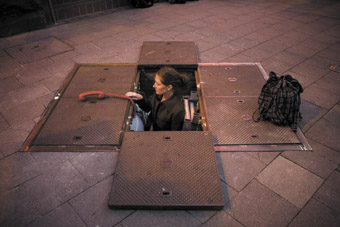
Lucy Wilson, Underwhere
photo Peter Mathew
Lucy Wilson, Underwhere
A WOMAN APPEARS ON A STREET CORNER IN THE MIDDLE OF THE HOBART CBD. SHE STANDS NEAR THE BUS MALL. BENEATH A BROWN TRENCH COAT, SHE WEARS TROUSERS AND A YELLOW VEST TRIMMED WITH FLUORO SAFETY TAPE THAT SWINGS AND FLASHES. IT IS 8.30 PM AND LUCY WILSON’S PERFORMANCE AND VISUAL INSTALLATION SITUATED AROUND A MANHOLE COMMENCES.
“Don’t talk to strangers”, her mother said, stepping off the curb and under a bus. Longing for reconnection with her lost mother’s voice becomes the imperative for Wilson’s journey.
She stands on the manhole cover wrought in a recurring pattern. Her soles seem imprinted with a grid motif which works as a shadow overlay to her mind’s incessant question of who is responsible for her mother’s death. Wilson frequently confronts her unresolved grief through introspection and blame.
She lifts the cast iron manhole lid and descends into the underworld. Joey Ruigrok van der Werven’s set design taunts with a blaze of light revealing an underground network of cables, pipes, and tunnels. We peer in, fascinated with this revelation. Above ground, interconnecting roads, footpaths, dreams, desires and loss impress our shoe soles like ley lines—the intersection of Wilson’s quest with our own.
Red, yellow, black and white phones appear and are placed like compass points around the manhole pit. The phones ring. Cradling each in turn, the performer listens and redials. Her desire for connection with the irretrievable rings out to silence.
A ladder emerges guided by pale arms. Piece by piece the extensions snap-lock into place ascending toward the sky. Wilson climbs from her pit of despair with a radiant orb of light snaking from her body. The silver ladder becomes a locale for reclamation of ordinary acts as she cleans her fragile world. Underwear is draped across the ladder, fingernails are shaped, a light is switched on, a tap buffed.
Wilson produces a silver kettle, a heating ring and a plumbing line complete with tap. A piano mood-scape tinkles and light refracts from shiny surfaces and safety gaffer tape. She makes a cup of tea, then sips—a homage under lamplight. Her slow deliberate drinking is a re-enactment of her last treasured memory, sharing tea with her mother.
Above our heads an advertising sign reads, “Capture the Spirit”, as Wilson navigates her way through, under and over worlds, seeking, searching, and trying to link with her lost mother. Tik-tokking traffic lights and frenetic ‘safe to walk’ pitches are amplified and echo through Matthew Dewey’s sound score.
Finally the phone is answered offering communication with an ethereal world and, for the performer, redemption. She draws a tear-shaped crystal from her mouth. This crystallisation of sorrow enables Wilson to resolve her loss and to relinquish her constant questioning.
Peering into the crevasse of both street and self, Lucy Wilson’s strong performance offers a portal to hidden worlds. It is the journey of a woman seeking connection through the interstices of self, a street corner, a manhole and a city.
Lucy Who Productions, Underwhere, performer Lucy Wilson, director Robert Jarman, writer Willoh S Welland, composition and sound design Matthew Dewey, costume design Hanna Pärssinen, set construction, design Joey Ruigrok van der Werven, prop design, construction Bruce Hay; CBD, Hobart February 15-17, 22-24
RealTime issue #78 April-May 2007 pg. 36
© Sue Moss; for permission to reproduce apply to realtime@realtimearts.net
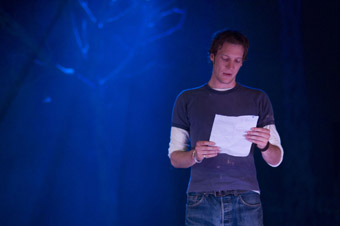
Nathan O’Keefe, The Unchartered Hour
photo Shane Reid
Nathan O’Keefe, The Unchartered Hour
THIS UNCHARTED HOUR IS A HOME-GROWN CULTURAL PRODUCT, NURTURED THROUGH CREATIVE DEVELOPMENT BY DIRECTOR CHRIS DRUMMOND AND PRESENTED BY BRINK PRODUCTIONS AND THE STATE THEATRE COMPANY OF SOUTH AUSTRALIA IN ASSOCIATION WITH ADELAIDE-BASED CHAMBER MUSIC COMPANY, THE FIRM, AND THE ADELAIDE FESTIVAL CENTRE’S INSPACE PROGRAM. ALONG THE WAY, PLAYWRIGHT FINEGAN KRUCKEMEYER WAS AWARDED ONE OF THE 2006 PREMIER’S LITERARY AWARDS—THE JILL BLEWETT PLAYWRIGHT AWARD—FOR THE CREATIVE DEVELOPMENT OF A PLAYSCRIPT BY A SOUTH AUSTRALIAN WRITER.
The mechanisms of creative development demand cultural recognition of a project in advance of its production. What is recognised as ‘cultural’ in the process of development is a project’s pitch and promise, its core components and key personnel. Program notes from the playwright recall the process of the work’s projection as akin to the rise and fall of civilisation. “Great walls of ideas once set in stone would crumble and be rebuilt”, wrote Kruckemeyer of the developmental process he undertook with Drummond and the artistic team assembled by Brink Productions.
The world premiere of This Uncharted Hour bears the hallmarks of a striving for cultural recognition. The play tells an intense family story of assured appeal. A son relives the trauma of growing up in a family stricken with grief. His mother lost a baby, then her husband’s love. The set, designed by Gaelle Mellis with lighting by Geoff Cobham, has an elemental, existential feel: a bare tree stripped of its leaves, a park bench and a pool of water, a kitchen table and some chairs, a telescope for stargazing at the night sky.
The music, from composers Raymond Chapman-Smith and Quentin Grant of The Firm, is ensconced in European tradition. Their notes record how, in their composing, they embraced the lieder of Franz Schubert and the German poetry of the Romanticist Novalis and the modernist Rainer Maria Rilke. Schubert’s ‘Nacht und Träume’ (Night and Dreams) is performed in the production by soprano Emma Harwood and pianist Jamie Cock, along with music composed by Chapman-Smith and Grant.
The two musicians and a baby grand are elevated inside a box cut into one of two walls which frame the set. At one point, the musicians are amusingly treated as recorded music. “Shut the fuck up”, yells Nathan O’Keefe as Luka, the troubled son. Harwood stops singing and turns to leave. “Turn it back on”, yells Elena Carapetis as Penny, the grieving mother. With a musician’s patience, the soprano returns to resume her song. For much of the production, however, the mood is mournful and melancholic.
In her persistent grieving, Penny is attended by an ineffable Young Man, the dead infant had he grown up. Played with abstract clarity by Lachlan Mantell, the Young Man also haunts Luka, shadowing the living son’s insecurities with moving precision and elusive poetry. Paul Blackwell plays Adam the husband who withdraws from his wife’s grief by having an affair with Sarah, a single woman he meets while out jogging.
Michaela Cantwell’s Sarah is enjoyably neurotic. Her breathless excitement at Adam’s heaving attention, her experience of self-identifying frustration at the video shop and the singular solace she finds in eating chocolate ground her character amongst everyday things. Sarah’s appearance in a peach-pink party frock with striking blue handbag and chunky blue shoes strikes an image more moving in its materiality than the poetry of the kitchen table and broken plumbing in the bathroom through which the breakdown of Penny and Adam’s relationship played itself out. It led me to wonder about the production’s aesthetic strategy of appealing to the poetry and music of European Romanticism while seeking to articulate modernist intensities of everyday experience.
Without the Romantic night-dreaming of Schubertian lieder to elevate the production’s claim to cultural recognition, the everyday intensity of Luka’s opening story about running over a dog may have led the production to more credibly aestheticise its sentimental investment in the cult of cuteness, that formidable cultural industry of babies and pets, of innocence lost and unconditional love, which now so pervasively promises delivery from moral distraction.
The production diverted this aesthetic challenge into the backwaters of Romanticism. In securing cultural recognition, its cloying sentiments languished exposed and unassailed. The Stillbirth and Neonatal Death Support Service lent to the production this little epitaph: “Some have a lifetime/ Some just a day/ Love isn’t something/ You measure that way”.
jet of blood
Antonin Artaud, whose celebrated idea for a theatre of cruelty has long rattled the presumptions of literary theatre, wrote just three play scripts. His first, Le jet de sang (Jet of Blood) from 1925, remained unperformed during his lifetime. The script is short: it takes about five minutes to read aloud. According to one source, its first production, for Peter Brook’s and Charles Marowitz’s Season of Cruelty in 1964, ran for just three minutes.
Olivia Allen’s rare production of Jet of Blood for Ignite won the Best Ensemble award at the 2006 Melbourne Fringe and recently had a season in The Space for this year’s Adelaide Fringe. Allen milks some sixty minutes of theatricality from the surrealist succession of images in Artaud’s script.
A young man and his doll-lover torn from their bed. A scatter of body parts crash to the floor. A warrior cry-baby babbles away. A giant spider dances. A bird-lady feeds the young man mouth-to-mouth. A sex-starved priest feeds his ravenous dog-servant. A plague of scorpions escapes from beneath a woman’s skirt.
Allen literalises each image within a hyper-theatrical flurry of cabaret makeup, costume changes, puppetry and running props, lighting shifts and scenic revelations. It is the remarkable sound design with live audio processing from Hayley Forward that gives coherence, zoom and focus to the flow.
The cumulative effect is rather cute, not cruel. This is game-play surrealism, recalled with fond nostalgia from our avant-gardist past and served up as sweet confection within the safety of a virtual world.
The Uncharted Hour, writer Finegan Kruckemeyer, director Chris Drummond performers Paul Blackwell, Michaela Cantwell, Elena Carapetis, Lachlan Mantell, Nathan O’Keefe, singer Emma Horwood, pianist Jamie Cock, designer Gaelle Mellis, lighting Geoff Cobham, composers Raymond Chapman-Smith, Quentin Grant; Brink Productions, State Theatre Company of South Australia, in association with The Firm and the Adelaide Festival Centre’s iNSPACE program; The Space, Adelaide Festival Centre, Feb 9-24
Ignite Productions, Jet of Blood, by Antonin Artaud, director Olivia Allen, performers Amelia Best, Roderick Cairns, Grant Cartwright, Austin Castiglione, Julian Crotti, Simon Stone, Katherine Tonkin, Lara Tumak, design Adam Gardnir, lighting Luke Hails, sound design Hayley Forward; iNSPACE, The Space, Adelaide Festival Centre, March 8-11
RealTime issue #78 April-May 2007 pg. 36
© Jonathan Bollen; for permission to reproduce apply to realtime@realtimearts.net
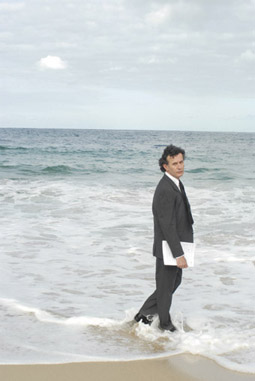
photo Heidrun Löhr
Photographed recently on Coogee Beach, on approach he spoke a patois of musical memes, adolescent delusions, political spin, sound grabs, punch-lines and pedagogy and hummed bytes from what a local lifesaver identified as The Goldberg Variations.
Though he could not confirm it, passers by felt he bore a striking resemblance to man of the theatre, Nigel Kellaway whose Sleepers Wake (Wachet Auf!), a chamber recital for amnesiac performer and three musicians is scheduled for performance sometime soon.
Nigel Kellaway, Sleepers Wake (Wachet Auf!), Performance Space, CarriageWorks, Sydney, June 7-9, 13-16
RealTime issue #78 April-May 2007 pg. 37
© RealTime ; for permission to reproduce apply to realtime@realtimearts.net
KIT LAZAROO’S ASYLUM BEGINS LONG BEFORE THE HOUSE LIGHTS DIM. THE AUDIENCE CANNOT HELP BUT PONDER THE BUREAUCRATIC WALL CONFRONTING US INSIDE LA MAMA. FILING CABINETS, RELICS FROM A BUREAUCRATIC PAST, ARE VAULTED ALONG A REAR WALL. WHEN PSYCHIATRIST LALLY BLACK ENTERS, SHE IS DWARFED BY THE DATA OF THOSE WISHING TO FLEE PERSECUTION AND BEGIN A NEW LIFE IN AUSTRALIA. ASYLUM, KIT LAZAROO’S PLAY IMPLIES, IS AN ISSUE CONFRONTING US ALL, YET SOMETIMES IN THE MOST UNEXPECTED WAYS.
Black sits at her desk reading reports, and watching a mechanised tortoise creep along the floor. When asylum seeker Yu Siying enters demanding a letter of recommendation, the progress of the tortoise resonates as an image of bureaucratic inefficiency and evolving psychosis. All four characters in Asylum are going stark raving mad. But Siying is alone in having an obvious reason for doing so. Under surveillance by the Chinese government, her paranoid delusions extend toward those she now relies upon to remain within Australia. But psychiatrist Black, her deaf brother Smudge and barking immigration bureaucrat Turlough Dando are also hallucinating. Apart from some unconvincing childhood trauma, there is no obvious reason for their unsettled states of mind. This maybe a flaw in Lazaroo’s script, but it also hints at a power psychosis: a collective madness residing among politicians, bureaucrats and the general public too as we wrestle with current government policy on asylum seekers. In this play, the lunatics have indeed taken over the asylum and we have all become prisoners behind a bureaucratic wall.
Paradoxically, the filing cabinets that imprison the characters in Asylum are also gateways to memory and dream. A fit of compassion toward the plight of asylum seekers results in cabinets flinging open their drawers. Siying’s traumatic past, during which she is forced to provide sexual favours for her father’s friends, is played out by marionettes; an adroit choice of form in a play about bureaucratic manipulation and state tyranny. Yet this alliance between the actual and the magical is uneasy. The production’s ‘kooky’ tone does not take into account that asylum is not a kooky place to be, either for those seeking it or those forgotten behind its walls.
When Turlough Dando spreads margarine over white bread while delivering a tirade about his personal life, his psychosis (its subjective roots in fear, its explicit manifestation in public policy, and a crazed desire to both feed, and feed upon asylum seekers) becomes clear. But even this scene is restrained as if Asylum’s creators insist that madness must be made palatable by forcing it to reside within a one-dimensional framework of quirkiness. The upshot is that some striking and original imagery does not resonate poetically. At play’s end, when Siying is stuffed into a filing cabinet and entrapped in a bureaucratic maze, the audience should feel great sympathy. Instead, I left the theatre wondering whether kooky was the right theatrical framework for a play about bureaucracy gone mad, and the dire consequences of a psychotic immigration policy.
Asylum, writer Kit Lazaroo, director Jane Woollard, performers Glynis Angell, Tom Considine, Fanny Hanusin, Tim Stitz, design Amanda Johnson, sound Peter Farnan, lighting Richard Vabre; La Mama, Melbourne, March 15-April 1
RealTime issue #78 April-May 2007 pg. 38
© Tony Reck; for permission to reproduce apply to realtime@realtimearts.net
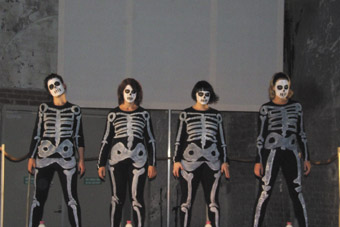
Night Time #1, Brown Council
photo Caitlin Newton-Broad
Night Time #1, Brown Council
ON SUNDAY AFTERNOON, THE FIRST OF APRIL, I WAS NEARLY WIPED OUT FROM BEHIND BY A RED HOLDEN SS SEDAN. IT RIPPED PAST ME AT THE LIGHTS WHERE KING STREET BECOMES THE PRINCES HIGHWAY, DRAGGING OFF A HOTTED UP BLACK UTE (ALSO A HOLDEN) IN THE LANE NEXT TO IT. I HAD JUST ENOUGH TIME TO SEE THE UTE SPIN OUT OF CONTROL, MOUNT THE KERB AND WRAP ITSELF AROUND A TELEGRAPH POLE. IT WAS FAST, BRUTAL, AND OVER INCREDIBLY QUICKLY, AND WITH A CLEAR WINNER AND A CLEAR LOSER.
Something similar must have been envisioned by the Performance Space conveners of Night Time #1, the first in a planned cycle of events structured as a head-to-head contest between krumping skeletons, folk troupes, VJs and interpretive dancers in the cavernous foyer space of the recently opened CarriageWorks.
The stage was a boxing ring, each round was limited to a breakneck three minutes, and winners were garlanded with medals by Zoe Coombs-Marr, who was both umpire and commentator to the public gallery. However, one of the things that differentiated this night of performance art from a brutal car crash is that everyone came out a winner. All the participants were awarded trophies, and a general atmosphere of courtesy prevented anyone from getting heckled, in spite of the frail separation between the audience and the stage.
Unconditional love is damaging. It results in a weak constitution at best, and suffocation at worst. So I’m going to mark out my own exclusive set of winners. The clear audience favourite in the first half was Poss + The Frank, who performed a riveting duet dance to the song “Wait till you see my dick, bitch” with one performer in swimmers and the other in a giant pink octopus suit. Honourable mention also goes out to Renny Kodgers’ karaoke cover of “We’ve got tonight”, to Shane Haseman and Agatha Gothe-Snape’s dance with suprematist signal flags to the constrained fury of Suicidal Tendencies’ “Institutionalised”, and to a convulsively controlled Matthew Day. Tony Schwensen, all the while, was pelting a tennis ball repetitively down a hallway, with thwok and grunt amplified through the foyer. The piece was perhaps best described as a sort of marriage of 70s conceptual art with contemporary Australian suburbia, and very fitting for a sports night.
During half time, cheerleaders handed out oranges, although vodka would have helped, and participants and spectators smoked nervous cigarettes. Then Regina Heilmann told a funny story about road rage and a chicken that could speak German, and everyone laughed. This was topped by Martin Del Amo and Julie-Anne Long doing an incredible drunk dance. It takes a lot of sober field research to do a good drunk dance. You can’t actually be drunk when you do it, because the gestures have to capture not just how people look, but also how they feel when they’re burning up the dancefloor at three-thirty in the morning. Del Amo did it so well I kept thinking I could smell the spirit in his sweat.
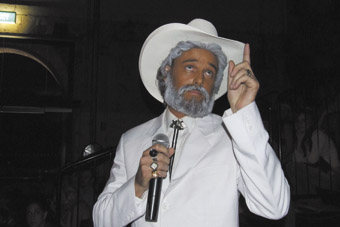
Night Time #1, Renny Kodgers
photo Caitlin Newton-Broad
Night Time #1, Renny Kodgers
Best and Fairest goes to Brian Fuata and Agatha Gothe-Snape respectively, or the other way round, for amicably ending their collaborative career in public. Legends of the Folk Tradition sang a song. Four women (Brown Council) in skeleton leotards drank a litre of milk each to the Kelis’ hip hop hit “Milkshake” and then gyrated violently until they puked milk, really. Karen Therese and Lizzie Thompson got a lot of people to kiss in public, which was gross but fascinating, but not nearly as gross as Brown Council who blinded us with their brown-eyes from a panel van that slowly cruised past the entrance—not once but several times.
Brecht once said that his ideal stage would be a boxing ring: a combative space in which anarchy is played out in a square of light, people become performers by climbing through the ropes, and the public shout and shake their fists at the stage. Night Time #1 offered all the trappings of an elimination boxing match, but the audience was too damn nice to respond off cue. It’s a pity that the former workers of the Eveleigh Street Rail Yards weren’t there to take in the show.
Night Time #1, A Night Of Short Works, coordinators Lara Thoms, Trevor Brown, Rosie Dennis; Performance Space, CarriageWorks, Sydney, April 1
RealTime issue #78 April-May 2007 pg. 38
© Adam Jasper; for permission to reproduce apply to realtime@realtimearts.net
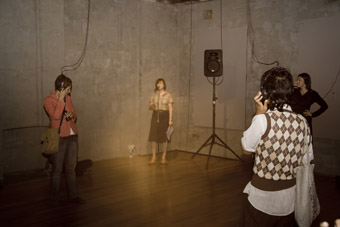
Mimic Mass, photo Ben Mastwyk
SPLIT RADIO IS THE LATEST IN A SERIES OF VOCAL PERFORMANCES BY THE ENSEMBLE MIMIC MASS THAT UNPICKS THE CONVENTIONS OF THE POPULAR SONG IN CONTEMPORARY CULTURE. SPLIT RADIO IS HOSTED BY CONICAL INC AS PART OF ITS SOUND SERIES WHICH, THE PROGRAM STATES, IS INTENDED TO EXPLORE THE DISRUPTION OF TEMPORAL AND SPATIAL SYNTAX TYPICAL OF MUSICAL PERFORMANCES. IT CERTAINLY DOES.
The Mimic Mass performance takes place in Conical’s main gallery and a smaller inner room. In three of the four corners of the bare main gallery, a singer sings unaccompanied at a microphone connected to its own PA speaker. The singers each cover pop hits from recent decades, and the audience, hearing three songs simultaneously, initially tune in aurally to one or other, depending on personal curiosity and taste, or try to take in all three. It’s like listening to three radio stations at once.
You can also hear each voice alone through one or other of the many pairs of headphones in the gallery and entrance hall. The voices are then transmitted via a mixing desk to a PA in a smaller room, which is completely darkened. Here the voices are variously morphed, fragments are repeated serially and effects such as drum and bass accompaniment are added. Later, the remixed sound is transmitted into the main room over the top of the singers, and the unmixed voices are then heard in the darkened room. The whole work lasts about 40 minutes, during which the very capable singers rarely pause, covering numerous songs.
The audience patrols the spaces and tries different headphones to hear the evolving variations in this condensed and remixed classic hits selection. The effect musically is to create several binaries: accompanied/unaccompanied, mixed/unmixed, transmitted/direct. Listeners not only shape their reception by moving between listening positions; the work’s formal development requires listeners to move through sequences of positions. Aural awareness is heightened in the darkened space that’s not unlike a club chill-out room or a meditation cell, suggesting further binaries: light/dark, sighted/unsighted and inner/outer. We’re also reminded that music is affected by studio recording and broadcasting—to transmit is to transmute.
The melodies and lyrics of the songs trigger the listener’s verbal and musical memory, the effect of which is heightened if the memory is also an emotional one, perhaps of a love song that recalls a close relationship. But you can only hold a feeling momentarily before it merges into the overall musical/textual picture, creating an emotional roller-coaster ride. The listener experiences a kind of hypertext, as fragments of song lyrics coalesce into new text, the content of which depends on the mixer’s mixing and the listener’s listening position: “I’m too sexy for my car…and the white knight’s talking backwards…I love you, I really do…it’s just an old war, not even a cold war…and say-ay that you love me.” The tradition of the pop idol as heroic storyteller is undermined, and meaning emerges fleetingly and speculatively to be transformed and annihilated. You might sing along or dance to rock music, but here the rhythms and lyrics are too elusive, so your response is cerebral rather than visceral as you wander through this soundscape.
The work recalls the emphasis in Fluxus events on text and idea, playfulness and the disruption of normal reception and understanding. Singer Madeleine Hodge, a performance artist who has previously appeared in Liquid Architecture and Electrofringe, says that the intention is to break down the normal audience/performer relationship. Split Radio cannot be recorded—in the tradition of performance art it must be experienced live. No two listeners will hear exactly the same sounds, and the range of listening options extends the range of possible listener experiences.
Conical states that its Sound Series, subtitled “A poke in the eye is a good distraction from a ringing ear”, is intended to address “the expanded nature of current art practice”, and Mimic Mass nicely fulfills the contract. This expansion, in which art encompasses and reconsiders multiple cultural forms and traditions and involves audiences more actively, has evolved into a broad genre. Mimic Mass’s Split Radio could be described as a performance-installation involving the rendition and electronic mediation of iconic musical and textual material within an overarching compositional structure that unfolds exponentially and that requires the listener to be a mobile, active interpreter. It references DJ-ing that melds musical fragments into a new whole, and mimics the cultural and mental saturation of contemporary life. It breaks the spell of pop music, offering an alternative, oblique aesthetic. It’s iconoclastic and demanding but ultimately it’s a fun event. We love the nostalgia of catchy old tunes, and subverting them like this is “…too sexy by far…”
Mimic Mass, Conical Inc, Fitzroy, March 9, 10, 15-17; Conical’s Sound Series also includes performances by The Spheres, Mark Brown & David O’Donoghue and The Glass Percussion Project
RealTime issue #78 April-May 2007 pg. 40
© Chris Reid; for permission to reproduce apply to realtime@realtimearts.net
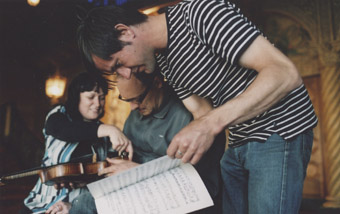
Dead Horse Productions
DEAD HORSE PRODUCTIONS’ GROUND ELASTIC SOUND IS THE LATEST IN A SERIES OF MUSICAL EVENTS THAT INCLUDES THEIR MEMORABLE CONCAVE CITY OF 2006. DEAD HORSE GOES FOR UNUSUAL VENUES AND THE FABULOUS FORUM CINEMA, DECORATED WITH NEO-CLASSICAL FACADES AND SCULPTURES, CREATES AN EPICALLY MYTHOLOGICAL BACKDROP FOR THIS ENGAGING CONCERT.
The evening is introduced by a cheery voice from an old vinyl record—“Are you ready? Let’s get going!”—and Biddy Connor’s tongue in cheek Ground Elastic Sound Fanfare commences with the clarinet and brass players performing in the theatre’s aisles. The crackly narration (the recording is of whistling) later returns, the fanfare concluding with the performers on stage whistling the fanfare theme—music of the mouth.
Peter Knight’s more cerebral Spirals Part 1, in two contrasting movements for clarinet, trumpet and string quartet, opens with a slow, dramatic cello note. A dialogue between winds and strings develops, sharp gestures overlaying a steady rhythm that builds towards an unfolding melodic line late in the first movement. In the program note, Knight outlines the mathematical basis for the work’s form, a numerical spiral. The short second movement is angular, atonal and gestural. The piece is accompanied by imagery projected on the cinema screen—a slowly evolving abstract form in the first, and latticed sticks in the second, personifying the music.
Light-heartedness returns momentarily with Wally Gunn’s Formwork for tape, which sounds like a theatre organ dubbed over industrial noise and played on a slurring gramophone record. It’s heard while the stage is rearranged for his Eleven Fifty-Five, a strongly coloured work for clarinet, brass, string quartet and contrabass that opens with declamatory gestures from the brass and clarinet. All the musicians are miked for the evening, and the mix for Eleven Fifty-Five foregrounds the brass. The piece develops in motoric passages with a thriller movie feel. The visual imagery is of stylised figures running aimlessly, trapped behind a grid of lines, evoking a struggle between the enclosing industrial world, represented by the overwhelming brass, and humans, represented by tremulous strings. Gunn states in the program his concern that “the world is close to apocalypse”, hence the work’s title.
Kate Neal’s Semaphore, also for winds and strings, is preceded by a video of her own hand writing out the lines of a TS Eliot poem, Chorus VII, from The Rock. Opening with brass layered over glissandi strings, the work is a meditation on semaphore signalling as a form of communication. A vocalist is positioned next to a statue under one of the theatre’s arches. Tristram Williams’ fine trumpet is given scope in this piece, in which the brass again dominates the mix. The work progresses steadily and rather introspectively within a restricted tonal range, and concludes over the projected cartoon of a flag-waving signalman. Biddy Connor’s second work for the evening is Into Hundreds, written in 2000 and performed here to mark the 10th anniversary of her father’s death. Arranged for this performance for clarinet, tenor and baritone saxes and violin, viola and cello, it is a short but eloquent elegy, slow, lyrical and melodic, with combinations of strings and brass producing some delicious moments. Into Hundreds feels like it could be the middle of a three-movement work but is delightful as is.
The final work is David Chisholm’s Ikebana, for live and pre-recorded string quartet (the Silo Quartet). This unusual arrangement must have been technically demanding for the four performers on stage, as the work is in effect an octet and they are cued both through headphones and by a conductor. But the result is impressive. The muted sound of the recording hangs like a ghost over the performers, suggesting a kind of inner dialogue. The solid writing provides a welcome opportunity for leader Miki Tsunoda to showcase her talents. Originally scored to accompany Phillip Adams’s dance work Origami, this vibrant, pulsing work hints at a range of musical forms and flavours, especially mid-20th century. In the absence of the dance, the listener is left wanting more, perhaps a finale movement.
Dead Horse events are a complex blend of innovative composition, performance and visuals, tinged with social observation and curated with an eye to theatrical presentation. At times it can seem contrived but when the blend works, there is magic. There is not quite a house compositional style but, with the exception of Chisholm’s piece, the instrumentation for this concert created a house texture and feel, leaving a memory of solid rhythmic structures, strong instrumental colour and dissonant, edgy lyricism. The longer pieces are 10-12 minutes, absorbing enough but sometimes leaving a feeling of incompleteness. The strength of the Ensemble’s performers shines through.
Ground Elastic Sound, Dead Horse Ensemble, conductor Benjamin Northey, visuals Nina Gonzaga, Robin Fox, Forum Upstairs, Melbourne, February 23
RealTime issue #78 April-May 2007 pg. 40
© Chris Reid; for permission to reproduce apply to realtime@realtimearts.net
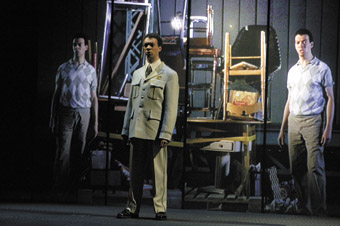
After Life
DUTCH COMPOSER MICHEL VAN DER AA VISITED AUSTRALIA IN 2000 WITH HIS FORMER MENTOR LOUIS ANDRIESSEN AND DIRECTOR PETER GREENAWAY TO WORK ON THE GREENAWAY OPERA, WRITING TO VERMEER. VAN DER AA’S OWN PIECES FEATURE PRE-RECORDED SOUNDTRACKS OR VIDEO PROJECTIONS WHICH DOUBLE THE LIVE PERFORMERS, CREATING A DYNAMIC INTERACTION BETWEEN THE TRAGIC, HARRIED, ONSTAGE CHARACTERS AND THEIR TECHNOLOGISED OTHERS. VAN DER AA IS A KEYNOTE SPEAKER AT THE 2007 TOTALLY HUGE NEW MUSIC FESTIVAL CONFERENCE WHERE SELECTED SCORES AND FILMS FROM HIS OEUVRE WILL BE PRESENTED.
How would you characterise your aesthetic?
I often work with electronics or soundtrack, combining pre-recorded samples and live music, which lets me stretch the sounds of the ensemble or the orchestra, or put them in a different context. The soundtracks are closely related to the live sound, so they act as an alter ego for the live players. In the operas One (2002) and After Life (2005), the singers on stage are also singing in the projections—they do duets with themselves. They finish each other’s sentences and movements. It’s almost an extra set or layer of musicians. The use of a visual alter ego in the projections and an electronic alter ego in the soundtrack—both of which I do in One—is another way of stretching the personality on stage and of providing insight into the mind of the protagonist. It becomes an internal dialogue.
In terms of video and multimedia in opera, Greenway and Andriessen—together with Steve Reich, Robert Wilson and Philip Glass—are key figures.
I was here for Adelaide [with Vermeer]. At that point Louis collaborated with Peter Greenaway and with me, and now I’m trying to do it myself. The important difference between us is that we have a different starting point. In One and in After Life, while I was writing the music I was also thinking about what would happen in the projections and on stage. By writing all three layers in one I could decide—for each moment—which of these elements would be foregrounded. The shifting of weight to and from the music also influences the musical structure and the phrasing.
Mischa Spel describes your doubling of the performers as being like “freezing” sections of the music, which then “thaw out” as they are repeated or extended. The metaphor which I would prefer, however, would be to call this a kind of “blurring” or “smudging” of material, like charcoal on a page, so that it becomes not just an opposition between two things—two musical lines, or the live singer versus the filmed one—but that there is also a spreading of these opposed elements, and an exchange of sounds and rhythmic elements between the two lines.
[Freezing] is something that I often do with the soundtracks, though. The ensemble stops playing and the tape echoes the last chord they played. With a dry cut between them, the reverb or the echo is cut open and the new part is then played live with that reverb in the background. In that sense time is stopped and then a new time axis is shown through that echo.
So it’s not so much that time stops, but that another time opens up.
Yes. That’s the way I use polyphony.
Michiel Cleij notes that in many of your works there exist what he calls musical or “aural images”, which might be considered as blocks within a collage of elements, structured together, and which then recur or are worked through over the course of the piece.
I don’t see it so much as that montage style of music. It’s more like you cut open the music and you look through and see what is happening behind it or underneath it—and then that original musical element continues again. That use of polyphony is quite different from the postmodernist montage technique where things are cut or stopped and then a new thing simply happens.
Samuel Beckett’s Krapp’s Last Tape seems an obvious comparison with your work, not only because of the sense of identity which Beckett develops—of tragic individuals dealing with their past and the fragmentation of their identity—but also because Krapp records his own voice and then plays it back over the course of a dramatic scene.
You are the first one who has pinpointed that work, but some people have made the Beckett comparison before. I had never heard of it before I wrote Here—in circles (2002), in which the soprano uses a tape recorder during the performance. I know Beckett, of course, but I’m not that familiar with his work.
Here—enclosed (2003), in which the soprano is meant to be locked inside an opaque box, reminds me of those 19th century seances where a medium would be locked in a box in order to prevent them from tampering with what was going on outside.
The soprano is not actually there, though, in Here—enclosed. It’s a dress dummy which the conductor reveals at the end. But theatrically, she’s there [and is heard in the soundtrack]. The text which I wrote for the Here trilogy [and for One] is about a woman who is completely lost and who tries to find herself again. The box emphasizes the sense of confinement which she feels and you hear this musically. The conductor walks to the box twice. At first he doesn’t do anything. Then the live ensemble gets ‘stuck’ in the soundtrack; the soundtrack encloses the ensemble. At the climax, the conductor hits a light switch on the side and you see the silhouette of woman in a dress. The ensemble then starts miming and you hear the sound coming from the box. So the music is captured and enclosed acoustically within this box.
Are these some of the things which you will be talking about in your keynote ddress?
I will talk about the theatrical layers and the use of multimedia in my composition, using examples from One, After Life and Passage (2002), focussing especially on the relationship between music, soundtrack, live action onstage, and the action in the film or video. I am hoping that this will generate a lively discussion. Also there is a good cross section of my pieces and films being presented in the festival.
Michel van der Aa, Keynote Address, Totally Huge New Music Festival Conference, April 28; works by Michel van der Aa are in the programs: Sonic Sights, WA Symphony Orchestra, AGWA April 28; Sonic Image, Luna Cinemas, Northbridge, April 27; Resonator, WAAPA, April 30; Sparkling Rhythms, with percussion ensemble Defying Gravity, WAAPA, May 1-3. www.tura.com.au/events/totallyhuge/
Michel van der Aa’s website, www.doublea.net, includes the articles by Mischa Spel and Michiel Cleij referred to in this interview.
RealTime issue #78 April-May 2007 pg. 41
© Jonathan Marshall; for permission to reproduce apply to realtime@realtimearts.net
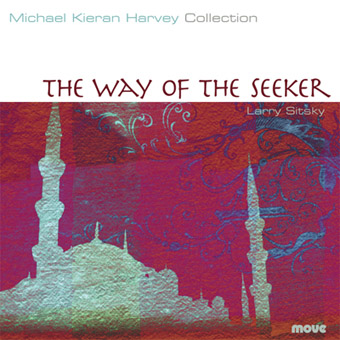 THIS IS FABULOUS MUSIC, WONDERFULLY PERFORMED. THE WAY OF THE SEEKER IS A MONUMENTAL ACHIEVEMENT, NOT ONLY IN ITS SCALE AND POWER, BUT PERHAPS ALSO MONUMENTAL IN A LITERAL SENSE. IT CAN BE SEEN AS A QUASI-AUTOBIOGRAPHICAL STATEMENT FROM COMPOSER LARRY SITSKY, A MAJOR FIGURE IN AUSTRALIAN CONTEMPORARY MUSIC FOR HALF A CENTURY, AND HE LAYS HIS MUSICAL SENSIBILITY BEFORE US.
THIS IS FABULOUS MUSIC, WONDERFULLY PERFORMED. THE WAY OF THE SEEKER IS A MONUMENTAL ACHIEVEMENT, NOT ONLY IN ITS SCALE AND POWER, BUT PERHAPS ALSO MONUMENTAL IN A LITERAL SENSE. IT CAN BE SEEN AS A QUASI-AUTOBIOGRAPHICAL STATEMENT FROM COMPOSER LARRY SITSKY, A MAJOR FIGURE IN AUSTRALIAN CONTEMPORARY MUSIC FOR HALF A CENTURY, AND HE LAYS HIS MUSICAL SENSIBILITY BEFORE US.
The work is in six movements: Prologue, Birth, The Guide, The Journey, Beyond Time, and Epilogue: the Man of Light. It maps a spiritual journey drawn from the writings of the 11th Century Sufi mystic Hakim Sanai. Sitsky has been influenced throughout his career by the mysticism of various Eastern cultures. In an interview on ABC Radio National’s Music Show with Andrew Ford, Sitsky, who grew up in China, recounts a moment in his youth when a local doctor, attending a sick neighbour, played a flute to him to heal him. This work is the latest in Sitsky’s explorations of mysticism through composition, but it is also a massive achievement pianistically, drawing heavily on the Western musical traditions.
The Way of the Seeker is a demanding work of around 50 minutes, brilliantly rendered by Michael Kieran Harvey, evoking the emotional and psychological states that envelop the novice on the path to enlightenment. It traces the progression from darkness or ignorance, represented by the heavy bass textures in the Prologue and early in the first movement, towards enlightenment in the Epilogue. In Birth, the music becomes discordant and agitated, and intense dynamics punctuate the calm. The writing is expressionistic and gestural, evoking the seeker’s tumultuous experiences. As the piano’s shadowy rumble continues, the principal voice soliloquises. A note is repeated for a few bars, suggesting a tolling bell, around which the voice dances. In his introduction on the CD, Sitsky states that the bell-like figure, which recurs periodically in different registers, represents crucial moments in the journey.
The drama ebbs and flows through subsequent movements: The Guide opens gently, becomes animatedly conversational and then regains composure. The final movement, Beyond Time, begins explosively, but calm ultimately prevails. The Epilogue is slow, gentle and introspective, concluding with a questioning, unfinished line suggesting that, although this journey is complete, a new cycle of life and searching will now commence.
Stylistically, the work recalls early 20th Century music, the music of Sitsky’s tutelage and perhaps of the beginning of his own journey. One thinks of Scriabin’s late works and his mysticism, and, more generally, of the transition from Romanticism to Expressionism and atonality. The listener senses a detailed formal structure and carefully calculated moves, but the CD liner notes suggest that the score offers limited performance directions and leaves the shaping of the dynamics to the pianist. The realisation of the work thus requires a shared sensibility—the performer also becomes a pilgrim—so as to induce this feeling in the listener. As well as the necessary technical virtuosity, Kieran Harvey brings to this music his experience of performing some of the great works of the contemporary repertoire, especially Messiaen’s Vingt Regards sur l’Enfant Jesus (1944), itself an intense expression of religious experience.
The Way of the Seeker recalls the autobiographical feel of, say, Liszt’s Years of Pilgrimage and, though very different in character, Shostakovich’s consummate 24 Preludes and Fugues (op 87). The seeker is one who sits alone at the piano to contemplate life and the universe.
See interview with Michael Kieran Harvey
Larry Sitsky: The Way of the Seeker (2004), piano Michael Kieran Harvey; Move Records, 2006. MD3309.
RealTime issue #78 April-May 2007 pg. 41
© Chris Reid; for permission to reproduce apply to realtime@realtimearts.net
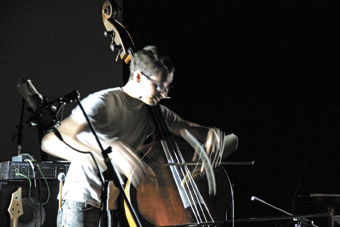
Clayton Thomas, the NOW now Festival
photo Tom Banigan
Clayton Thomas, the NOW now Festival
THE ANNUAL NOW NOW FESTIVAL WAS FIRST STAGED IN 2002 FOLLOWING THE ESTABLISHMENT OF A FORNIGHTLY CONCERT SERIES AT SPACE 3 GALLERY, REDFERN IN 2001 (IF YOU LIKE IMPROVISED MUSIC THEN WE LIKE YOU). THIS YEAR, A NEW VENUE, THE FACTORY IN ENMORE, HOSTED THE NOW NOW OVER FOUR NIGHTS. THE EVENT IS AN AMBITIOUS SHOWCASE FOR IMPROVISED MUSIC AND MUSICAL SPONTANEITY IS ASSURED BY THE FACT THAT MORE THAN 75 PER CENT OF THE ENSEMBLES PERFORMING RESULT FROM CURATORIAL INTERVENTIONS BY CO-DIRECTOR CLAYTON THOMAS. IT IS NOT UNUSUAL FOR PLAYERS TO BE INTRODUCED AT THE SOUND CHECK!
The If you like improvised music, we like you concerts through the year are focused exclusively on music but the NOW now embraces film, installation and other related events. One of these in 2007 was by Melbourne artist, Anthony Magan, a guided, Cageian sound walk at midnight through Enmore and Newtown.
The Factory is a rather vast space clearly set up for rock concerts. Much of the music in the Now now filled the room with PA sound such as the anarchic Son Of The Seventh Sister on the Wednesday night program. Other performances occurred at audience level in front of the raised stage and on Thursday night Tony Buck’s acoustic percussion could be differentiated from Thembi Soddell’s extraordinary array of sound treatments as they performed a duet in-the-round near the mixing desk.
I managed to get a seat at the front every night of the festival despite the large crowds so I was well placed to hear the nuance of Manon-Liu Winter’s festival opening solo on Wednesday with its refrains, laments and blistering interactions between prepared piano and electronics. On Friday I could hear most of the quieter interior piano manipulations during the bold duet by Winter and Jon Rose but, as with Cor Fuhler in his quintet the previous night and Anthony Pateras in a trio the following night, I often felt there was more to be heard from inside the piano during passages of group polyphony. In their duet Rose and Winter’s attention to detail constantly transformed the dynamic range as Rose’s characteristically passionate bowing was at times beautifully modulated to accommodate precise duet coordinates.
The Friday night music began with a trio of piano, bass and drums (Adrian Klumpes, Milica Stefanovic and Simon Barker respectively). I wasn’t aware of any mix problems for Klumpes as Barker crashed in with Noh-esque crescendo, maintaining the initial tension relentlessy with rolling bass drum vibrations which insisted the trio join in the anachronistic climaxes. As soon as agreements were made percussion disappeared into sparse play and the music disintegrated into fragments which took on a life of their own only to be crafted back into new moods and directions.
Ben Byrne (laptop) and Dean Roberts (guitar/effects) followed with swampy settings as creature-like utterances emerged from the clicks and drones of the machine, the piece falling into near-silence and back out again heading toward a bedlam which never quite arrived. I liked New Zealander Roberts’ work a lot but on Saturday I thought his quasi-rock ensemble Autistic Daughters was a little out of place in the NOW now. Even though this group features Vienna-based improvisers Werner Dafeldecker (bass and electronics) and Martin Brandlmayr (drums) the laments showcased here with their song structures were a rather bland juxtaposition for the complexities of the other sets on Saturday.
Jon Rose and Hollis Taylor followed, delightfully quirky, working a table of whistles, kazoos, various pitched objects and their own voices to create an array of bird impersonations with lyrebird accuracy. Then Natasha Anderson and Amanda Stewart exchanged swirls across a broad spectrum of sound framed and contextualised superbly by Louise Curham’s flashes of handpainted film projected at several levels around the players. More film (by Louis Hock) and live score followed with Robin Hayward (tuba), Cass McGlynn (tenor horn) and Simon Ferenci (trumpet) providing what must have been the most delicate sounds of the festival. Later, Carolyn Connors’ cries and ukulele and Jeff Henderson’s sax, banjo and voice were mediated by Robin Fox’s live processing resulting in a slightly disturbing trio that mixed the manic with the comedic before the floor was cleared for the finale.
Sound balances were not a problem for the closely-gathered audience at the unmiked 49 piece Splinter Orchestra whose direct line laptop players were flawlessly integrated by Richie Belkner into the acoustic set. The orchestra performed two pieces from notional scores, one of which involved alphabet display sheets held up randomly by six or so players at the front. Players remained silent until a letter from their name appeared. Proceedings were finalised with contextual screams by Jeff Henderson and only Robin Fox got a solo!
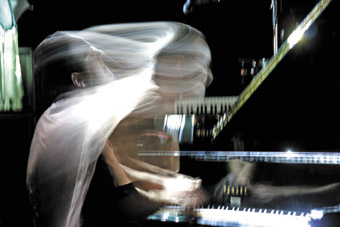
Anthony Pateras, the NOW now Festival
photo Tom Banigan
Anthony Pateras, the NOW now Festival
Saturday night kicked off with a relentless rhythmic outing from a trio hell-bent on driving syncopation. Anthony Pateras (piano), Tony Buck (drums) and Clayton Thomas (double bass) played prepared versions of their instruments and laid out some dark and persistent signatures. I never tire of the way these players extrapolate from their beginnings. On this occasion they initiated three separate hard-driving individual rhythms and within minutes the score had coalesced into some remarkable contrapuntal settings.
Jim Denley (voice, laptop and often dismantled saxophone) and Peter Blamey (mixing desk) found juxtaposition and symmetry in their explorations of the meeting points between pitch and white noise. They were followed later by a sensitive and moving trio from John Blades, Chris Abrahams and Robbie Avenaim within which the Loop Orchestra co-founder (Blades) told the inspiring story of his life-journey with multiple sclerosis.
An exhilarating performance from Embers (Adam Simmons and Kris Wanders on saxophones, Dave Brown, bass and Sean Baxter on drums) followed. They blasted out a kind of sustained crescendo—a visceral assault on the senses. The mesmeric results reduced the accompanying Aldo Tambelinni film to a rather redundant distraction from the music for me and I found myself watching the musicians more than the film.
A more successful image and sound collaboration occurred earlier in the evening when Joel Stern and Sally Golding (aka Abject Leader) converted the cinema room into an audio-visual wonderland with field recordings, electronic, percussive and pitched sound supporting images projected from multiple 16mm projectors onto a variety of surfaces. Illusions were created by images on uneven surfaces such as a gauze making hologram-like effects in the centre of the room, and from opening bird sounds through drones, beeps and whistles and finally to an accordion finale. Stern, Golding and Danni Zuvela are the Brisbane-based Otherfilm crew who fascinated and amazed us each night with an exciting range of experimental film screenings, from optical sound pieces (the sonic results of optical material shot across the sound stripe of 16mm film) to Mary Ellen Bute’s take on Finnegan’s Wake.
The festival finale was presented by Hammeriver, a Clare Cooper project which over the last four years has engaged a large group of players in explorations inspired by the music of Alice Coltrane whose death on the Friday preceding the festival imbued this set with added poignancy and meaning. With Cooper conducting proceedings from the concert harp the ensemble played an improvisation which began with a silent overture until the ensemble’s sound rolled in like a storm from the horizon. Everyone in the band seemed to follow the timbre of Cooper’s harp as a watery rumble settled in around the space with Jeff Henderson, Monica Brooks and Chris Abrahams releasing occasional splatters of nuance and spiky accents from within an eerie drone. This week of music was a great achievement from Clare Cooper, Clayton Thomas and their dedicated team, I went home every night exhausted but very satisfied.
the NOW now Festival of spontaneous music and experimental film; The Factory, Enmore, Sydney, Jan 17-20, www.thenownow.net
RealTime issue #78 April-May 2007 pg. 42
© Tony Osborne; for permission to reproduce apply to realtime@realtimearts.net
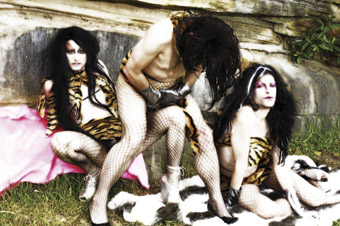
Cave 1, Wild Boys or Bust (2006)
IT’S A TRICKY VENUE, CANBERRA CONTEMPORARY ART SPACE IN GORMAN HOUSE. DESPITE SMOOTH AND SHINY WALLS, THE BUILDING EXUDES THE GHOSTLY TRACES OF SUBURBAN LIVING ROOMS PAST, AND WE MODERN ART CONSUMERS ARE CONDITIONED TO FEEL COMFORTABLE CONTEMPLATING ART IN PLACES AS FAR FROM OUR DAILY EXPERIENCE AS PRACTICABLE. I KEEP EXPECTING TO FIND MY DEPARTED GRANNY KNOTTING CAVADOLI MACRAME IN THE CORNER WHILE SHE MINDS THE EXHIBITION, PAUSING TO CLEAR HER THROAT WHEN I LEAN TOO CLOSE TO THE WORK OR LOOK AT A PAINTING WITH RUDE BITS.
Curator Amita Kirpalini harnesses rather than battles this domestic flavour in Oomph, a parodic survey of raunch culture, the new mediascape’s “bawdy world of boobs and gams” (Ariel Levy, Female Chauvinist Pigs: Women and the Rise of Raunch Culture, Simon & Schuster, 2005). We can expect a little tongue in cheek in such a show, for sure, but the sheer quotidian humdrum which these works sexualise is astounding. The Wild Boys, for example: their slides document a lewd drag music video shoot across a suburban park, abasing and debasing themselves around park benches and Moreton Bay Fig trees. In the hands of our fearless cross-dressing documentarians, the mundane objects that populate public spaces unleash unanticipated lust, fairies of an unlikely sort are lurking at the bottom of the garden, getting off in ways that you never imagined, and they are photographing it to boot. And damn, but these boys can wear a piece of polyester tiger pattern fur to its best conceivable advantage.
Sue Dodd shares the medium of video clips in this show, graciously. With all the breathless seriousness of any YouTube auteur, she has collated a rag tag selection of the icons of pop music and dumped them in an artfully incongruous heap on the gallery floor. The silver body suits, the driving pop beats, the vivid varicoloured backdrop, the diffident backup dancer Ken (is his head in an orange net?)…love it. The text that she intones in each of the three clips summarises a different scandal from a supermarket checkout celebrity magazine, enacted by a cast of celebrity puppets cut out from said gossip mags behind Dodd herself singing. The self-conscious teenage intensity and DIY flavour of it recall punk fanzines, but depict a suburban rebellion directed against no opponent more specific than the eternal vexations of a stardom that its subjects will never possess.
Pilar Mata Dupont and Tarryn Gill have very specific targets in their sights. Their photographs mash up the vocabularies of war propaganda posters and of socialist realism in a pisstake of the soft porn of girlie calendars. The militaristic theme in these images is not subtle: “Join the airforce, see the world before it’s gone” depicts a leggy paratrooper flashing her best patriotic simper for the camera as she descends through smoke machine clouds. This in an Australia where “it’s now more acceptable for…women to appear naked in a magazine than wear the hijab in public” (Gwyn Topham, “A Cultural Paradox Stripped Bare”, Sydney Morning Herald, February 27, 2006). I can hear my Gran’s discrete cough. What is our page four girl media selling us when flogging the anti-introspective eye candy of raunch culture?
I wonder, though, as appropriate as the domestic nature of Gorman House is for this show, is it not domestic enough? This is politically engaged, accessible work, it’s a lot of fun, and there is no reason—the economics of the art world aside—why some of it would not be even more effective if it were displayed somewhere still more public. Dodd’s work is a case in point, being the kind of lo-fidelity material that would weather YouTube with no ill effects. There comes a point where a show that sets out to critique has to justify the manner in which it chooses to do so. Are we sitting smug in the sanitised space of our bourgeois gallery mocking the habits of those others out there in different parts of the cultural landscape?
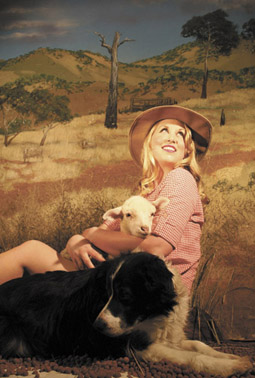
Isn’t this worth fighting for? (2006) Tarryn Gill and Pilar Mata Dupont
courtesy of the artists
Isn’t this worth fighting for? (2006) Tarryn Gill and Pilar Mata Dupont
If our artists are to be believed, the view from suburbia looking out is a dark one; Alex Martinis Roe invites us to look in at the victims of the objectifying gaze, old-school style. Her piece is a simple site specific video installation trapping a model in the two dimensional confines of the video screen. The captured figure lies in weary resignation, supporting the columns of the gallery with her hands, imprisoned by the photographic process and an unfortunate confusion of dimensionality. It would be a fun bit of visual punning on the role of spectacle in any old gallery space, but it really sets off this show, where our gaze is anything but innocuous. As gallery goers we are media consumers, as much as we are when we’re TV watchers or gossip magazine readers, however much of a pisstake we may make of it.
Oomph, curator Amita Kirpalini, artists Bianca Barling, Sue Dodd, Pilar Mata Dupont & Tarryn Gill, Louise Paramor, Alex Martinis Roe, The Wild Boys; Canberra Contemporary Art Space Gorman House, Feb 16-March 17
RealTime issue #78 April-May 2007 pg. 43
© Dan MacKinlay; for permission to reproduce apply to realtime@realtimearts.net
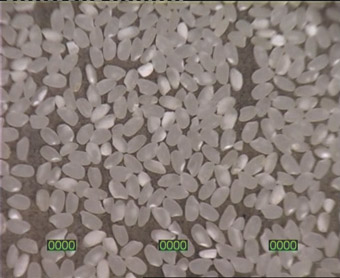
Yang Zhengzhong, 922 Rice Corns
IT’S BRISBANE’S BIG SHOW, THE APT. STARTED BACK IN 93 AND THIS TIME AROUND IT’S TWICE THE SIZE AND THE OPENER FOR THE NEW ‘WORLD CLASS’ GALLERY OF MODERN ART (GOMA). THE OPENING WAS HUGE, WITH SOME GREAT PROJECTION WORK OUTSIDE. IN THE SHOW PROPER THE OFFICIAL BLURB PUTS IT AT CLOSE TO 300 WORKS, 37 ARTISTS, PERFORMANCES, MOVIES, VIDEO, SOME OLD STUFF AND A BUNCH OF SPECIALLY COMMISSIONED PIECES. NOT A SHOW TO SEE IN ONE SITTING—THE CINEMA PROGRAM ALONE IS TOO LARGE.
There’s Jackie Chan in the GOMA cinematheque, a few dozen screens showing the rise of budgets and the progression of technical expertise. Amazing how slow the Young Master seems now. Also saw Weerasethakul’s The Adventures of Iron Pussy (2003; see page 17) which, with Sasanatieng’s Tears of the Black Tiger (2000; not at the APT), makes me keen to explore more Thai cinema in the near future.
Photography is everywhere—as object and as documentation. Along one wall are the large prints by Mu Chen and Shao Yinong of classrooms set up for a bit of mass re-education (Assembly Hall Series, Long March Project, China, 2006). They weren’t always classrooms, sometimes a bit of temple peeps in from the side. The images are formal, camera down the back of the room for a perspective shot of rows of empty desks. Up front some communist bunting and a red silhouette of Lenin, Mao and co. The tone of the photos is very flat, very ‘This is’. Similarly depersonalised, or at least without obvious intervention, are some older photos from Nasreen Mohamedi, black and white, lines in the wet road, a blobby ‘U’ that is strangely self contained. Not much, but enough.
Unsentimental is the theme for much of the show, particularly the video work. Over at the Queensland Art Gallery (QAG), Yang Fudong (Jiaer’s Livestock, China 2002-05) sets up two little cinemas side by side—in each one a bench for someone to sit on and a bit of standing room for a few others. In front of each screen, and flanked by naked fluoros, is a suitcase on a neat spread of dirt. Inside the case some little black and white handheld screens play repetitive footage that looks like it may come from the big screen footage or maybe from some outtakes. On the main screens the movies proper—short variations on or around each other. Actors, props, and scenes shuffle about. Same basic story, different outcome. There’s a guy in a suit pushing a suitcase uphill. Some people get killed for not very much. Flat observation on strange events. No idea why, but it reminds me of Polanski’s film Cul-de-Sac, which I haven’t seen for years.
More video over at the GOMA site with two works by Yang Zhengzhong. 922 Rice Corns (China, 2000) pits two chickens against each other in a race to eat rice. At the bottom of the screen the scores are kept ticking over. Voice-overs from a couple of commentators pace out the contest (shame I lack the language). The birds are devices for counting rice (Yang’s description) but I’m thinking of the nutty safety-in-numbers meaningless statistics and performance reviews that plague corporate (and bureaucratic) life in Australia. No rest until everyone is above average. On everything.
Next to the chooks is another work by Yang, and one of my favourites. As with the counting birds video, the presentation is uncoloured, without intervention. Set up the camera at a club, at a home, in the street. It’s people, one after another, looking into the camera and saying “I will die” (Do It Project, curator Hans-Ulrich Obrist, 2001). Maybe they laugh, maybe they look a little wistful, but—no dramas—that’s about it.
Yang also has some photos which for me are not so successful. He presents people, in typical urban settings, balancing the treasures of modernity on their fingertips (Light and Easy, China, 2002). A car, a helicopter, an ultra mod city. The future as a happy, lightweight trick anyone can do. Sounds okay, but years of student photoshoppery has killed the montage for me.
Others also have a light touch, particularly Korea’s Kwon Ki-soo, whose cutesy cartoon character (Dongguri) runs up and down the walls in the children’s section of APT. Kwon has latched onto a graphic character form that is perhaps even more reduced than Keith Haring’s graffiti-ism from the 80s but just as productive as a cut-out rubbery figure, a sprightly chap in some cheerful paintings, or farting away in some great Flash animations.
Wang Wenhai’s massive Mao twins (Chairman and Emperor) are also cute and cuddly, after the fashion of monumental clay-like blobs (Mao Zedong and Mao Zedong, China, 2003). Year after year Wang obsessively reproduces Mao in numerous forms. That’s it. He is not the only obsessive on show. Out the back and a bit out of the way are something akin to huge miniatures from Yoo Seung-Ho. His works appear to be large inky washes, styled after traditional brush and ink Chinese landscapes. Up close they are made from the tiniest of characters, meticulously inked in with a graphics pen. It’s strangely admirable and pointless, like crossing a large ocean in the smallest of home made boats.
Another favourite video is from Vietnamese artist Dinh Q Le. Le presents a triptych movie, The Farmers and the Helicopters (2006), a document of the history and meaning of helicopters in a rural community. There’s footage of helicopters exploding forest (thanks Hollywood), and wartime recollections like, “We’d stand very still and the helicopters would go over then come back to look. If they came back a third time you’d run.” Time lets memories and feelings update to “the helicopter is evil” and a triumphal “I could go in a helicopter now.” The post-war generation is represented by Tran Huoc Hai who pieces together a working helicopter from leftovers and what he could pick up out of physics textbooks. “We don’t have to be scared of the helicopter, I want to show that Vietnam can use the helicopter to help people too.” The content reads like decades of trauma delivering a materialist and casual cargo cult. And again, the feel is unsentimental: views are held, memories recur, events happen.
Why so many videos, so interesting and so artless? (The APT is not for the post-processing fx junkie.) Perhaps it’s the rise of cheap and ubiquitous cameras. Home cinema was meant to be 5.1 sound, deck chairs in the lounge room and a few golden oldies from the Sony back catalogue. Maybe sometimes, but more likely it’s youtubing a stranger’s home movies while back at their place they watch yours. According to the BBC, 300 is the average number of times each person in England is filmed per day on CCTV. Dress up, go out, make a movie every day. The video image comes and goes. It’s a way of keeping stuff—in the phone, just for a bit, maybe longer on a drive, no more tricky or substantial than laughing at a number plate or downloading a movie of a man shoving golf clubs in a blender. Maybe it’s a reflection on history—stand back far enough and, if you’re lucky, events will go on without you. Regardless, ‘on video’ is now nothing.
The last work is from Shien Xiaomin (The Village Cameraman and His Son, Long March Project, China, 2001). Another documentary. An old guy, crinkle cut face, box camera, wooden tripod slung over the shoulders as he wanders the province recording the big events. Families, babies, weddings. Fifty years of black and white, misty edges, someone moves. That special photo when the light is just right.
The 5th Asia Pacific Triennial of Contemporary Art. Queensland Art Gallery and Gallery of Modern Art, Brisbane, Dec 2 2006-May 27 2007
RealTime issue #78 April-May 2007 pg. 44
© Greg Hooper; for permission to reproduce apply to realtime@realtimearts.net
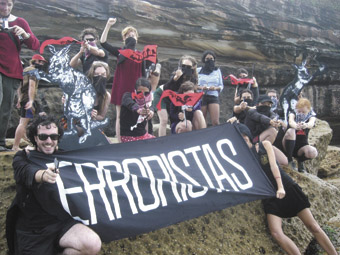
Erroristas, Group Etcétera Workshop, Sydney 2007
“WE WERE SEEING SOMETHING, FOR SURE, BUT IT WASN’T THE ‘SOMETHING’ THAT OUR GOVERNMENT WANTED US TO SEE”, CURATORS ZANNY BEGG AND KEG DE SOUZA EXPLAINED AT THE SECOND OPENING EVENT OF THEIR MULTIFACETED CURATORIAL, WORKSHOP AND PUBLICATION PROJECT, IF YOU SEE SOMETHING, SAY SOMETHING AT MORI GALLERY IN SYDNEY’S DARLING HARBOUR.
Speaking to a crowd of mainly artists and activists (and activist artists), their appropriation of a familiar anti-terrorism campaign slogan as the title of the show was clearly chosen not only to voice dissent at our government’s insidious, US-style Neighbourhood-Watch strategy, but also to confirm that socio-political change can or may occur through a discursive process. After all, to say something about something is to involve oneself in the immediacy of a moment, be it political or otherwise. This was a project about both local and global participation, political discourse, protest and activism.
The curators assembled an impressive array of artists, groups and collaborations across three main venues including the Argentinean Group Etcétera, the collaboration of German artist Dario Azzellini and the Austrian Olivier Ressler, Taring Padi from Indonesia and Contra Fil from Brazil. Elucidation of the contexts and political moments in which all of the artists variously work, was handled through a freely distributed newspaper, with texts commissioned by both exhibiting artists and external writers. Without this document I would have been lost in the complexity of such an international exchange. If You See Something, Say Something brought together provocative practices and while viewing the works in their various locations, I had to keep reminding myself that it wasn’t important that I agreed with everything I saw and heard.
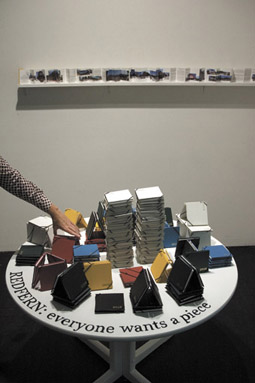
Redfern Mapping Project, Squatspace
The exhibition at Gallery 4A was split between documentary film and photography, and traditional painting and printmaking in the service of social change. Indonesian group Taring Padi’s works on paper were installed in the entrance gallery, juxtaposing sharp woodblock prints of struggle and military violence with paintings of utopian dreams in which people live collectively, in harmonious rural landscapes. Upstairs Zanny Begg had installed a series of Flemish-style portraits and a map, exchanging traditional subjects of wealthy traders or landowners for representations of young Australian environmental and political activists. Rather than depicting trade routes, the map located sites of activist movements and their connections to others around the world. While I understood the logic of this exchange, I found the representation and identification of particular people in Begg’s paintings (some were masked) to be strangely at odds with the spirit of movements that champion the cause, rather than the individual.
Reflecting this notion, opposite Begg’s paintings was a wall and shelving unit covered in printed paraphernalia relating to upcoming events and workshops connected to the project as well as propaganda, protest march details and environmental action material. Next to this was Sydney-based multidisciplinary artist David Griggs’ installation of his photographs of homeless people, youths, dogs and ephemera on The Philippines’ streets. The photographs were taken and exhibited like snapshots, scattered on a poorly made, low plywood table surrounded by totemic objects including a blackened head with a cigarette in its mouth and a black cobra poised to strike. Grigg’s combination of the quotidian image with death-metal symbolism created a potent atmosphere of everyday antipathy with a seething undercurrent of anger.
At Mori Gallery Begg and de Souza’s curatorial gambit appeared to revolve around the intersection of various artistic, research and performance practices involving public space. In one corner, local artist collective Squatspace created a playful and interactive map project about their ongoing, two-year (and counting) reality-promenade Tour of Beauty, a bus and bike excursion around the suburb of Redfern. Including a video document edited from various tours, the comfortable zone created by Squatspace enabled members of the audience to participate by drawing images from their memories and community connections onto the fabric map of Redfern that covered the floor. Rather like hobo graffiti, symbols of personal experience accumulated over time—love hearts on street corners, dogs in the park—while the Tour of Beauty video examined the broader implications of ongoing infrastructural changes to Redfern as they continue to impact upon Indigenous welfare and claims to the land as well as inner-city housing for low-income earners and families.
In the early stages of the Tour of Beauty project, members of Squatspace identified themselves to the Redfern Waterloo Authority (the NSW government agency responsible for the re-zoning and planning in Redfern) but were unsuccessful in securing a RWA spokesperson to speak as part of the tour. Despite this, the RWA used a photograph of Squatspace member Keg de Souza (wearing her Squatspace uniform) as the cover girl for their annual report, revealing an embarrassing breakdown of bureaucratic process and communication, but turning up subversive trumps for the Squatters. I found this report by chance while looking at the doodles on the map and it highlighted the fact that the most intriguing works to be found in the exhibition were examples of subversive practices that had insinuated their way into the social fabric they critiqued.
This was certainly the case with Perth-based pvi collective’s most recent performance project, Loyal Citizens Underground. Shown as a video document at Mori Gallery, the group had its members, uniformed in green and gold, handing out Code of Conduct cards and gently reprimanding unsuspecting shoppers and pedestrians in Perth’s CBD. Concerned with the effects of the Australian Government’s anti-terror legislation on monitoring civilian activity in our public spaces, pvi tested the policing of these and other behaviour-restricting laws in real time with a crack team of helpful vigilantes. The LCU not only busted grannies crossing the street in diagonal lines but assisted them to perform the task correctly. “We are holding your hand to increase your confidence when crossing the road.” The sense of familiarity I felt when viewing Australian responses of bewildered compliance to such paternalism was quickly blown away by the documentation of a “poop attack” and protest installation against the HSBC Bank performed by Etcétera, screening loudly in an adjacent room.
It goes without saying that I was instantly drawn to the work of some of the Australian artists in this exhibition. I understand the language and the context instantly, but I also understand poop. The absurdist installation of a toilet in front of the Congress building in Buenos Aires by Etcétera during a vote on the national budget in 2002 was followed by the more direct action of slinging actual shit and rotting vegetables at the building itself, attracting participation by angry members of the public. The documentation of live acts by the Brazilian group Contra Fil was less visually and symbolically accessible, requiring a (readily-available) translation. The translation publication Programme for the De-turnstilation of Life Itself was a bound collation of press material about a turnstile monument that the group initially installed in a town square. Gradually this document revealed the turnstile’s co-option as a symbol by students and other groups agitating for social change, and also its filtration into the local vernacular through cartoons and (probably not surprisingly) advertising for a banking corporation. I was unclear reading this whether it was the group’s intention to critique the diluted agency of the “movement” it initiated.
I left Mori Gallery after viewing the technically clunky, yet deeply soulful and melancholic video work of Al Fadhil from Iraq that considered the psychological terrain of his ravaged country through a photo-essay documenting empty public spaces and impoverished homes. The beseeching voiceover described scenes of suburban desolation and of families—all of whom have lost a child or another loved one—retaining only a small shred of hope for the future.
Fadhil says, “to remind ourselves that we once had a garden, we fill our houses with flowers. Plastic flowers”. This was a solemn ending to an experience of works that positively agitated for alternatives to current political and cultural situations. Fadhil’s work was a meditation on the acceptance of despair in a world that needs to open its eyes and ears to such stories.
If you see something, say something, publication, exhibitions and workshops, curators Zanny Begg, Keg de Souza, Mori Gallery, Gallery 4A, Chrissie Cotter Gallery, Sydney, Jan 26-March 3
RealTime issue #78 April-May 2007 pg. 46
© Bec Dean; for permission to reproduce apply to realtime@realtimearts.net
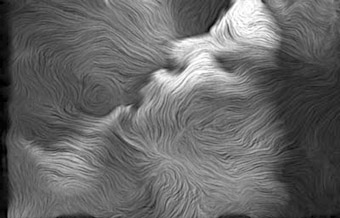
Owls At Noon Prelude: The Hollow Men
Brisbane’s IMA is showing film-essayist and media artist par excellence Chris Marker’s Owls At Noon Prelude: The Hollow Men until May 26, a unique opportunity to immerse yourself in this eight-screen video installation commissioned by New York’s Museum of Modern Art for its 2004 re-opening. The 19-minute video loop of images (black and white footage and stills), text (TS Eliot’s and Marker’s own words and digital musings) and music (Takemitsu’s Corona, for piano) figures World War I as prophetic prelude to a century of wars. On April 14 and 24, respectively, Frances Bonner and Adrian Martin will speak about Marker’s work.
IMA, Chris Marker, Bill Henson, Gavin Hipkins; Brisbane, April 10-May 26; www.ima.org.au
RealTime issue #78 April-May 2007 pg. 47
© RealTime ; for permission to reproduce apply to realtime@realtimearts.net
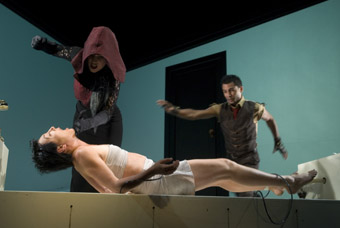
Claudia Alessi, Michelle Fornasier, Kegan Kang, BSTC, The Lady Aoi
DIRECTOR MATTHEW LUTTON’S PRODUCTION OF YUKIO MISHIMA’S THE LADY AOI OPENED THE 2007 PERTH FESTIVAL. LUTTON ONCE AGAIN DEMONSTRATED HIS COMMAND OF DESIGN, SOUND AND LIGHT, WITH ASH GIBSON’S DOUR, BASS-HEAVY STRINGS MAINTAINING A SENSE OF MENACE, WHILE SOHAN ARIEL HAYES’ PROJECTIONS CREATED A SET OF GRAPHICS WHICH MORPHED AND EXECUTED DEFT, WIPE-TRANSITIONS.
Yasuko is the deceased lover of the protagonist Hikaru. Her hair crawls about the frame before she draws him from the hospital room of his wife, Aoi, and brings him before a rippling image of the lake where he and Yasuko once wooed.
The production looked and sounded fantastic, while Michelle Fornasier as Yasuko made the most of her black, gothic dress to slink and prance about the stage. Nevertheless, Lutton is still wanting in directing actors, consequently he exacerbates the clunkiness of Mishima’s text. Passages like the nurse’s boast that the “sexual complexes” which cause illness have been cured by her regular intercourse and analysis with the doctors reads like an adolescent male fantasy, rendered all the more ludicrous by its sledgehammer Freudianism. Lutton fails to overcome such problems—Hikaru has little to do other than stare earnestly during his flashbacks. “Was that a woman’s cry?” he asks, before immediately falling back under Yasuko’s spell like a hypnotised subject from a bad Hammer horror film.
wild cursive
Taiwanese choreographer Lin Hwai-min’s Wild Cursive drew heavily upon Tai-Chi and Eastern body training, and was accompanied by a literally breath-taking score consisting of shattered, distorted field-recordings of pebbles, the sparse rumble of waves, and other materials nestled within a spacious silence which demanded deep attention from the audience. As the dance tempo rose and fell, arms windmilled in great, blurred arcs, while the undulations of the dancers’ torsos rolling up or down from deep, off-centred crouches seemed to defy gravity—as though time and physics had been stopped or stretched through their exacting concentration.
The intensity of the performance escalated rapidly, with curvilinear dancers filling the stage in a rippling mass with such speed and complexity in their indirect ‘call-and-response’ exchanges (the dancers rarely touched) that it was almost as if all structure evaporated. Having deployed this unrelenting aesthetic to deconstruct the dance’s legibility, Lin then forged deep pauses between each pyramidal sinuous pose or momentary extension upward. Gender emerged as a major organising principle. The audience was eased through the disorientation of the initial frenzy by the simpler dyad of active males dancing with reactive women. Even so, the extraordinary movements enacted in the women’s later solos—notably the one performed by associate director Lee Ching-chun—appeared to exceed human capability, with the spine rolled behind the feet so far and in such a slowly measured fashion as to surely overbalance the dancer, yet her strength and careful judging of trajectory (or flow of chi) enabling a momentary return to standing, prior to a leap—also without apparent preparation.
Lin’s aesthetic was rigorous and uncompromising, consisting exclusively of abstract dance and music—no narrative or even close adherence to the theme of Chinese calligraphy. Although couched in terms of a meditation on the individual’s harmonious embodiment of yin and yang, absence and presence, life and death, and performed using forms derived more from Eastern techniques than European and American dance, Lin’s total commitment to abstract forms produced an ambience akin to the toughest of European Modernists.
a midsummer night’s dream
Although more visibly impregnated with culturally specific signs, Korean director Jung-ung Yang’s version of Shakespeare’s A Midsummer Night’s Dream was no less modern in its fusion of theatrical styles. Compared with Japan’s Noh and Kabuki, Korea does not have a well recognised, national classical theatrical tradition performed by professionals (as opposed to semi-professional festive traditions like Sandae-togam-guk), and was strongly influenced by the Japanese occupation, 1905-45. Jung-ung claims to produce a “collision of traditional theatrical elements such as Japanese Kabuki, Indian Kathakali, [and] Korean martial arts” which are employed as “materials … from which I can freely choose.”
Jung-ung’s style suggests a pan-Asian aesthetic evocative of Herbert Blau’s notion of a universal, highly physical expressive style. Blau’s “physical hieroglyphics” are deployed light-heartedly by Jung-ung on a beautiful, raw wood stage with raised ramps on either side recalling the Kabuki hanamichi—here for the comic characters to lounge upon whilst commenting on the action or pronouncing their theories of life and leisure. A low space for instrumentalists was situated within the back wall (as in Sandae-togam-guk, Kabuki and Bunraku), yet it was the actors themselves who struck the sharply percussive, wooden blocks and drums.
Jung-ung has reduced Shakespeare’s narrative to four bewitched lovers pursuing each other at cross-purposes in the woods while local sprites—Korean dokkebi—played with the lovers’ perceptions, enacting the childhood conceit of pretending to be trees, or sprinkling magical pollen on the protagonists. As a result, this version was almost pure stage business. Interestingly, here it is the wayward faery King who is taught a lesson by his spouse in falling for Bottom (an aged, female herb collector enchanted as a pig). The King’s opening speech on the joys of womanising and laziness while jauntily perched on one leg, with a stick bearing his possessions hanging casually off his shoulder, was exquisite. Also notable was the delicate, traditional fan-dance by one of the male lovers, this gentle interlude expressing his inner distress. Jung-ung’s interpretation was short, sharp and relatively straightforward, yet no less precisely structured in its formal borrowings and arrangement—as well as being resonant with various deeper cultural allusions. Bottom’s fate for example was not a punishment for stupidity, as in Shakespeare’s play, but a blessing in disguise, hogs presaging good fortune.
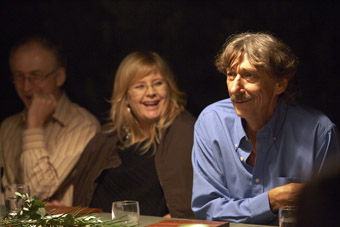
George Shevtsov & dinner guests, HOME, last seen imagining
photo Jon Green
George Shevtsov & dinner guests, HOME, last seen imagining
home
Rather than reflecting an adroit cultural fusion, Home, from writer Humphrey Bower and director Sophia Hall, dramatised the pains of cultural movement. Six actors joined 20 spectators at a catered dinner hosted at a private house. After an initial introduction to the characters’ cultural derivations, be they British or Middle Eastern, each related the events which led to their migration, traumatic journeys and initial Australian incarceration—prior to adopting what was often a highly positive view of their ostensibly peaceful new homeland.
The performers often stood to speak, sometimes with the inflections of a Thai or Croatian accent, or with the callow casualness of youth, as appropriate. Generally the dramaturgy was sparse, recalling Bower’s work on Melbourne director Robert Draffin’s “theatre as storytelling” aesthetic in The Idiot (1992) and A Thousand and One Nights (1991).
Home successfully guided its necessarily comfortable audiences (at $140 a ticket) through these stories, but it was not the first to do so. Like Bower, Alice Garner and Actors For Refugees have used detainee interviews to script verbatim theatre since 2002, while Through the Wire: The Inside Story On Refugees toured the eastern states in 2004-05. The main novelty of Home was its dinner setting, but the small, formal helpings of nouvelle cuisine were a far cry from The Idiot’s homely and culturally relevant fare of borscht and vodka, doing little to foster a congenial sociability amongst the audience or with the performers. The most interesting inclusions were tales from guards at the detention centres—notably Hall playing a no-nonsense, good-natured warden who tried to treat her charges well, yet who was acquainted with how to rush a prison riot and how this separated the camp into ‘us’ and ‘them.’ While not as striking as the artists’ previous work, Home was a fine addition to the Bower and Hall oeuvre.
2007 Perth Festival: Black Swan Theatre, The Lady Aoi, writer Yukio Mishima, director Matthew Lutton, performers Michelle Fornasier, Kegan Kang, Samantha Murray, Claudia Alessi, designer Bryan Woltjen, lighting designer Nicholas Higgins, composer Ash Gibson Greig, video Sohan Ariel Hayes, movement Claudia Alessi; Playhouse, Feb 2-17; Cloud Gate Dance Theatre, Wild Cursive, choreographer Lin Hwai-min, sound Jim Shun, Liang Chun-mei, His Majesty’s Theatre, Feb 19-21; Yohangza, A Midsummer Night’s Dream, director Jung-ung Yang; Playhouse, Perth Festival, 15-23 Feb; Last Seen Imagining, Home, senior writer Humphrey Bower, director/dramaturg/performer Sophia Hall, performers/collaborators Simon Clarke, Marta Kaczmarek, Phillip McInnes, George Shevtsov, Cara Sutcliffe, lighting Andrew Lake, sound Kingsley Reeve, various locations, Perth, Feb 12 – 24; Perth International Arts Festival 2007
RealTime issue #78 April-May 2007 pg. onl
© Jonathan Marshall; for permission to reproduce apply to realtime@realtimearts.net
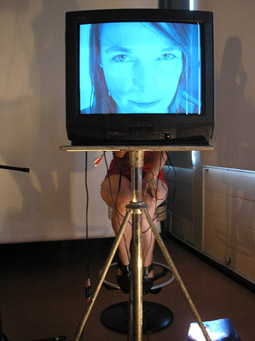
Caroline Daish, The Last To See Her Alive
UNREASONABLE ADULTS’ THE LAST TO SEE THEM ALIVE WAS SUBTITLED, LIKE A PAPER AT AN ACADEMIC CONFERENCE, “SEX, SLAUGHTER AND THE CITY.” LIKE A STRAIGHT-TO-VIDEO-RELEASE THRILLER IT WAS TAG-LINED “HOW DO YOU MEET MR RIGHT IN AGE OF SERIAL KILLERS.”
This new work is an essay of sorts, devised and realised by Fiona Sprott (texts), Caroline Daish (performance) and Jason Sweeney (music/songs/soundscapes) during and after a Month in the Country residency at HotHouse Theatre in Albury (RT75, p46). Sprott's writing tests our appetite for sex-crime fictions of the sort served up nightly on our television screens in endless seasons (or so it seems) of CSI and SVU.
Sprott's insight is to articulate these fictions as the erotic fantasy of their ideal reader—the working woman reading crime fiction while waiting on the station for her train home; the single woman at home alone in an apartment, watching CSI to exorcise the fears and fantasies, conjured and consumed daily, of falling victim to one of the city's killers.
Daish, dressed for success in a business woman's best, gives body and voice to these fantasies and fears. Seated at a long table set for a media conference, she addresses the audience through the intimate clarity of a microphone. A jug of water and a vase of flowers are set on the table; a video monitor and a technician (Sweeney) are set alongside.
Daish recalls how mothers once warned their daughters to beware axe-wielding murderers and sex maniacs. Today, she observes, the single woman fancies herself the ideal next victim of the serial killer's cold, clean and clinical obsession. With perverse technical efficiency, Sweeney aims a live video camera beneath the table, between Daish's legs, treating the audience to intimate vision of Daish's panties on screen.
In another uncannily intimate use of live video, Daish sits on a stool, her head obscured by the monitor. Only her lips are visible, enlarged upon the screen, as she divulges an erotic fantasy. The invasive intimacy of such close-up assemblage of vision and voice gives bite to the satire of Sprott's text.
The woman longs, she confesses, for a gentleman caller. She leaves her window open at night. However when her intruder arrives he is not quite the gentleman of her dreams. He is clumsy and inarticulate; he makes her wear a pillow case on her head; he ejaculates prematurely on her wool crepe skirt. Disconcerted and disappointed, She calls the police with a complaint. As gentleman rapists go, he was-well, just, “not very good.”
As a performer, Daish maintains an unsettling low-level intensity at the threshold between presentation and performance. She delivers her lines with the efficiency of a media presenter, with none of the actor's embodiment of character. I never believe she is the female subject of the fantasies she recites. She is their avid consumer instead.
Sweeney's presence onstage is also disconcerting. When he is not focused on operational tasks cueing video and sound, he stares at women in the audience, glances furtively at Daish and stage manages her wardrobe changes. He is her partner-pimp through the performance-the police detective at a victim's media conference, the backroom dealer for her corporate striptease, the floor manager of her chat show confessions.
Daish sings and she dances for us, but also for him. At one point, microphone in hand, she walks into the audience. We are seated at tables set cabaret style with flowers and red tablecloths. She flirts with a man and invites him to dance. She really wants more, she says in an aside, but she's settling for less. Her diaphragm fitted and her dress now zipped up, she sits on his knee, announcing “I'm always prepared for rape.”
The city which compels such preparation, such anticipation, is the fictional New York of television's crime shows. Sweeney's work with audio extends to the city outside. Before the show, he unobtrusively interviewed women in the foyer. “Where do you live?”, he asked them, and “How are you getting home?” The replies, some candid, some suspicious, are mostly evasive. The recordings are played quietly as the performance comes to a close.
Softness is an admirable aspect of the artistry of Unreasonable Adults. Unlike so much that is robust and loud, performance at low-level intensities can evoke in an audience a desire to lean in, to make an approach, to attend and make contact on their own ground. Quiet suspicion and seduction by stealth drew me towards this work.
Unreasonable Adults, The Last to See Them Alive, performer Carolyn Daish, text Fiona Sprott, media Jason Sweeney; Higher Ground, Adelaide, Feb 9-11
A re-worked version of The Last to See Them Alive with four performers (Caroline Daish, Fiona Sprott, Jason Sweeney, Julie Vulcan) was presented as part of the SPILL Festival of Performance, Soho Theatre, London, April 13, 14 (see preview, RT 77, p6).
RealTime issue #78 April-May 2007 pg. onl
© Jonathan Bollen; for permission to reproduce apply to realtime@realtimearts.net
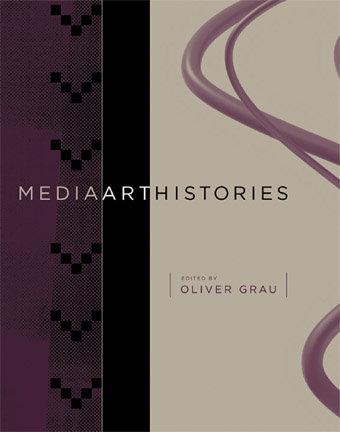
Oliver Grau’s MediaArtHistories
I was in a reviewing reverie as I embraced Oliver Grau’s MediaArtHistories, which brings together the work of media researchers who have been prolific in interpreting the relationship between new media art and art history.
In Australia, with its strong 25-year history in media art, we have witnessed an inevitable pulling back of media art into the immersive folds of traditional visual art. Grau views this process as a positive development. He also demonstrates, however, that traditional notions of visual art will have to be revised to absorb the ineluctable impact of science and technology on contemporary art practice.
Now that media art is integrated into a number of university departments across Australia, transdisciplinary approaches to art practice are demanded. MediaArtHistories provides insights and contexts for some of the theoretical and historical programs being continually revised as the area constantly reinvents itself and expands.
I’ll highlight some of the connecting threads that suggest the book’s transdisciplinary inclusiveness. Gunalan Nadarajan demonstrates that meaning is not fixed and can be recontexualised by exploring media art from different cultural perspectives which he does by exploring the genealogy of the influence of Ibn al-Jazari’s Book of Ingenious Mechanical Devices on the development of mechanical automata in Europe. Machiko Kusahara too addresses the cross-cultural implications of media art through his notion of Device Art, entailing a Japanese alternative to Western art history and an integrative view of art, technology and entertainment.
Sean Cubitt explores constructs of projection referencing the ‘Maid of Corinth’ as a fundamental influence on traditional art practice. He suggests that this traced outline of a shadow created by candlelight has played a strong role in influencing events at the very core of image science. Ron Burnett extends the projection concept to the psychology of projection, of mind as a metaphorical interfacing with technologies, and seeing as active and cultural.
This theme of the cohesiveness of art and media is also expressed in other essays focused on the role of media art as an interdisciplinary and transdiciplinary vehicle bringing together science, technology and art. In his essay, “Historicizing Art and Technology”, Edward Shanken argues for a revision “of the art historical canon…required not only because it corrects an obvious omission but because contemporary artists are increasingly employing science and technology as artistic media.”
Erikki Huhtamo suggests an archaeology of interactivity and tactility in relation to media art referencing works such as Paul Sermon’s Telematic Dreaming which explores intimacy and touch mediated by technology. Oliver Grau addresses phantasmagoria by looking at magic lantern shows in terms of telepresence and artificial life. Lev Manovich explores the effects of science and psychology on abstraction invoking a paradigm of ‘reduction and complexity.’ Dieter Daniels makes interesting parallels between the works of Marcel Duchamp and Allan Turing.
The incremental increase of technological developments makes this reinvention of art history a pressing concern, as highlighted in Christiane Paul’s essay on the role of the curator and the need for galleries to be proactive in this change. Paul expands on current ideas of how the immaterial nature of media art becomes materialised through cables, projectors and the immensely complicated process of media arts installation. She points to the possibility of user-generated and curated media shows, and considers the role of digital commons in reinterpreting the classic role of the gallery. In his essay, Andreas Broeckmann addresses the “aesthetics of the machinic”, pointing out that the ‘machinic’ controls, interprets and processes the decoding of data into the work as conspirator, collaborator or partner.
The essence of MediaArtHistories is encapsulated, in part, by Nadarajan’s essay as it re-examines, re-contexualises and re-focuses our attention on art’s global history, nowadays technologically mediated not least by media art.
The concept for MediaArtHistories as a book came about prior to the first MediaArtHistories conference, Refresh, in 2005. The book is supplemented by the online conference proceedings available as streaming video downloads. The proceedings are a tribute to the network of scholars that instigated the event but also reflect the growing interest in serious academic work being done in this area.
The essays presented in MediaArtHistories comprise a compelling addition to the bookshelf of any academic interested in art history. New media art histories need to be positioned with the growing range of books that are coming to terms with technological, scientific, philosophical and social comprehension of art practice.
Due to the immense rate of change in emergent technologies we are confronted by a continual immersion in flows of data, without the chance to reflect on what is evolving in their wake. The current art paradigm cannot remain stable in dealing with media art. MediaArtHistories allows us to make important connections and realise, perhaps too late, the possible outcomes. These scholarly essays give us some ground on which to stand and perceive emerging patterns.
I hope the next Media Art Histories conference, re:place (Berlin 15-18, November 2007, http://tamtam.mi2.hr/replace/) will spawn a publication of equally high calibre.
MediaArtHistories Archive: http://www.mediaarthistory.org/
MediaArtHistories, editor Oliver Grau, MIT Press, Mass, 2007
RealTime issue #78 April-May 2007
© Paul Thomas; for permission to reproduce apply to realtime@realtimearts.net
SO, DIMIA CHANGES TO DIC IN THE COALITION RE-SHUFFLE, FROM DEPARTMENT OF IMMIGRATION AND MULTICULTURAL AND INDIGENOUS AFFAIRS TO DEPARTMENT OF IMMIGRATION AND CITIZENSHIP. WHAT DOES THIS MEAN? NATIONALLY? INTERNATIONALLY? WITHIN EACH OF US? ARE WE MOVING FROM A COUNTRY OF MULTIVALENT VOICES CLOSER TO “ONE NATION?” (AND WHY HAS ‘ETHNIC’ REPLACED ‘MUTLICULTURAL’ IN SOME ARTS FUNDING APPLICATIONS IN RECENT YEARS?)
It’s 34 years since Al Grassby, the ALP’s somewhat rococo ethnic pin-up, tabled “multiculturalism” as a platform to which Australia should aspire. This was an attempt to overturn the so-called Anglo-conformist practices which drove our post-World War II immigration drive. Bring ‘em in, spread ‘em about, make sure they speak our language and—although it was not policy—tell ‘em off publicly if they don’t.
Multiculturalism flowered into many a folk-dancing, retsina-swilling, rice paper rolling event (with bush tucker taking much longer to catch on). Sydney’s Carnivale was launched in 1979 with sometimes acrid arguments about who had the greater right to express their sorrows—immigrant or displaced indigene. Passionate, complex, irritating. You wondered where your feet were. As the teenage child of European immigrants, I felt the stirring of complex rhythms, antagonisms, empathies.
I have sad memories of other festivals: plastic chairs in the corridors of windy malls, gaudy spectacles, shuffled performances, screeching microphones. Nostalgic serenades for the ethnic hordes; for the passive audience, a starchy tourist smorgasbord.
But Canberra’s National Multicultural Festival sparked it up (and thought things out) with an opera, physical theatre, tango in the street all day and night, a dozen international acts at the Tradies’, a night of ecstatic dance. The zeugma of the Beatles linked with Georgian chant; butoh dancers lined up in Civic Square in a kind of antipodean wailing wall. And everywhere, everywhere, people speaking language.
Tents at the day-long Greek Glendi spun with the honey-oiled kiss of Aegean vowels. Chinese new year was welcomed in in Vietnamese. The Bangladeshi Ambassador, speaking longer in Bangla than English, honoured the martyrs who fought for the right to retain Bangla as a public language in 1952. Further, he insisted that “culture is the glue of life,” and that language, song, dance need their continuity in order to honour the spirit world from which they emerge.
So, what is crushed when language, song, dance is censured or lost? Surely, just these spirits, which (as for Indigenous Australians) helped to form material worlds. Culture is the landscape that precedes song. Our ghosts already dance in the silences that precede words.
It seems disingenuous, then, of Dhafer Youssef, a Tunisian-born oud player and singer, to say (when pressed regarding the Arabic origins of his playing by Andrew Ford on Radio National’s The Music Show) that “I play from the heart…From nothing…I do what I feel, and that’s it…Before I play I have no idea what I’m going to do.”
I look at his oud, its very shape embodying specific histories, and hence delivering a very specific spirit and sound. His voice too sounds undeniable landscapes. And yet he plays up the ‘wow” factor of having players from “everywhere” whilst mocking himself as a “silly Dafher.” Hm, cheap ethnic joke. Who’s fooling whom?
I look, too, at the Western string quartet and tabla with whom he plays. Each is a synecdoche of their disparate cultures, constrained and released by their shapes and tone. This is no easy meeting. Indeed, to my ear, the group’s first set was riddled with difficulties. The strings played in (comparatively) measured harmonics and timescale, sawing (both visibly and audibly) through their notes, whilst oud and tabla rolled and flowed, a melisma of river-motion. The performers’ feet really stayed in different lands.
Later sets, however, bravely walked over a new man’s land. A special achievement was the encore-which-nearly-didn’t-happen: Jatinda Thakur (tabla) urged Youssef to bring “the girls” back on stage and gave each the chance to truly emerge from their different terrains.
What occurred here, through improvisation, was enough to make you yelp and cry. From Melissa Coleman’s opening cello solo, which worked its way from the Sistine Chapel around the whole of Istanbul, to Joanna Lewis’ violin stretching from desert to marshland pulled through the scent of an English rose, to Youssef’s wailing muezzin call, this is where the team created a very complex co-existence—a landscape of deeply bedded textures that enriched, informed and re-formed the soils and landscape of a new terrain. Genuine coalition.
By contrast, Operalab’s A Thousand Doors, A Thousand Windows sent its audience adrift. Over its 50 minutes, we heard tonalities shift incomprehensibly from Greek monody to Arabic modes, its texts move from Greek to Finnish to Farsi (and possibly more), and watched a projected Muslim script (a sacred text?) morph in so alarming a fashion that I feared the artists must be bringing on themselves some kind of curse (and somewhere crushing the spirits of the song). Although soprano Xenia Hanusiak lacked dramatic and vocal nuance there were moments of striking tonalities that turned one inside out with a sense of displacement, longing and loss. However A Thousand Doors, A Thousand Windows (works by Australian composer Constantine Koukias and Hanusiak, and Finnish composer Kaija Saarhiaho) left the ‘other’ (new music, new citizen) so unframed as to create profound impediments to reception. It is hard enough to embark on an odyssey, let alone last the distance in the face of such patent disregard.
That said, multicultural listening is always a hard task. From where do we listen, here, or there? If “there”, what helps us transpose ourselves to that other landscape, the one from which we do not come?
Curiously, Youssef’s ensemble only seemed to find true clarity following a moment where he stopped the concert, pleading for the venue’s thrumming refrigeration to be turned off. “Please, just this once—this song needs to come from silence!” The management were unable to oblige. In the end, however, he more than survived his compromise. He must have listened deeper than the ‘white noise.’ It took more than refrigeration to silence the meeting ground to which the performers had come.
The first post-war naturalized Australian citizen (1949) was made to disavow allegiance to his old country before taking oath to serve the new. I bow my head for the silences any new citizen is asked to leave behind. I bow my head for anyone whose language is silenced by neglect, indifference, or white noise. This is our nation: how well do we listen, or care? How well do we embark on that hard task to help cultures meet? How far have we really come?
See also Keith Gallasch's review of A Thousand Doors, A Thousand Windows in Ten Days on the Island.
Canberra National Multicultural Festival, artistic director Dominic Mico, Feb 5-18
RealTime issue #78 April-May 2007 pg. onl
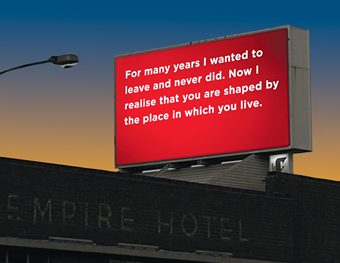
the write/here project
photo Justy Phillips, James Newitt
the write/here project
I’m walking through my city and I discover that something fundamental has changed. The jangle of multi coloured advertisements, with all of their enticements, have been replaced by personal messages, thoughts and musings. I stop and wonder at the text that I see. I find myself agreeing with “Sometimes you make your own traps” and asking myself what is referred to in “Could be magnificent.” This is the urban experience that Justy Phillips imagined when developing an idea for a short film some years ago.
What evolved from the original idea is a massive public artwork developed in collaboration with fellow artist James Newitt, transforming Hobart for just two weeks.
The write/here project strips 27 bill board spaces around Hobart and re-skins them with pieces of text shown in a white, sans serif font on a lush red background. The text originates from 1000 responses to workshops, exhibitions and individual interviews with residents of Hobart. People were asked a range of questions about the place they live in, including “What does Hobart mean to you?”, “Do you have any regrets?”, and “What are your hopes for the future?” The artists selected the final texts to provide a range of responses that retained enough ambiguity to allow viewers to establish their own interpretations.
While there is only spelling, syncopation and choice of phrase to define their voices, the text is seeded with clues that reveal the contributors as diverse in age, experience and country of origin. One board evokes the sadness of old age, “So many of my friends are dead now”, while another suggests the voice of a prisoner or care home resident: “It’s my own space but sometimes I feel I’m trapped in a cage. 6.30 is too early for goodnight.”
With the spread of boards around the city the write/here project is seen in a range of contexts that have a bearing on both the interpretation and the effect of the text. A poignant note about a highway death at the head of the Southern Outlet is likely to leave motorists pondering their own mortality and “Hobart means home, but you can’t spend your whole life at home” is a prompt for those leaving the airport to think about where they have come from or where they return. There seems to be a tendency toward texts that depict Hobart as something other than a peaceful, picturesque tourist destination and some of my friends have reflected that the overall effect is too melancholy to fit with their impression of their city.
Visually, I enjoy the aesthetic of the boards that use the colours of advertising but are stripped of any extraneous information. The clarity of this effect is pleasing, particularly when seen across a collage of windows, roofs and satellite dishes.
The write/here project is clearly a work mediated by the artists, but their touch is light enough to ensure that it is still an expression of a community. There is a lovely sense of relief in seeing meaningful, truthful statements on these boards rather than wildly exaggerated claims or threats that life won’t be complete without a particular product.
Another account by Judith Abell will appear in Landscape Architect Australia, May 2007
the write/here project, curators Justy Phillips, James Newitt; billboards around Hobart, Ten Days on the Island, March 23-April 1
RealTime issue #78 April-May 2007 pg. web
© Judith Abell; for permission to reproduce apply to realtime@realtimearts.net

the write/here project
photo Justy Phillips, James Newitt
the write/here project
I’m walking through my city and I discover that something fundamental has changed. The jangle of multi coloured advertisements, with all of their enticements, have been replaced by personal messages, thoughts and musings. I stop and wonder at the text that I see. I find myself agreeing with “Sometimes you make your own traps” and asking myself what is referred to in “Could be magnificent.” This is the urban experience that Justy Phillips imagined when developing an idea for a short film some years ago.
What evolved from the original idea is a massive public artwork developed in collaboration with fellow artist James Newitt, transforming Hobart for just two weeks.
The write/here project strips 27 bill board spaces around Hobart and re-skins them with pieces of text shown in a white, sans serif font on a lush red background. The text originates from 1000 responses to workshops, exhibitions and individual interviews with residents of Hobart. People were asked a range of questions about the place they live in, including “What does Hobart mean to you?”, “Do you have any regrets?”, and “What are your hopes for the future?” The artists selected the final texts to provide a range of responses that retained enough ambiguity to allow viewers to establish their own interpretations.
While there is only spelling, syncopation and choice of phrase to define their voices, the text is seeded with clues that reveal the contributors as diverse in age, experience and country of origin. One board evokes the sadness of old age, “So many of my friends are dead now”, while another suggests the voice of a prisoner or care home resident: “It’s my own space but sometimes I feel I’m trapped in a cage. 6.30 is too early for goodnight.”
With the spread of boards around the city the write/here project is seen in a range of contexts that have a bearing on both the interpretation and the effect of the text. A poignant note about a highway death at the head of the Southern Outlet is likely to leave motorists pondering their own mortality and “Hobart means home, but you can’t spend your whole life at home” is a prompt for those leaving the airport to think about where they have come from or where they return. There seems to be a tendency toward texts that depict Hobart as something other than a peaceful, picturesque tourist destination and some of my friends have reflected that the overall effect is too melancholy to fit with their impression of their city.
Visually, I enjoy the aesthetic of the boards that use the colours of advertising but are stripped of any extraneous information. The clarity of this effect is pleasing, particularly when seen across a collage of windows, roofs and satellite dishes.
The write/here project is clearly a work mediated by the artists, but their touch is light enough to ensure that it is still an expression of a community. There is a lovely sense of relief in seeing meaningful, truthful statements on these boards rather than wildly exaggerated claims or threats that life won’t be complete without a particular product.
Another account by Judith Abell will appear in Landscape Architect Australia, May 2007
the write/here project, curators Justy Phillips, James Newitt; billboards around Hobart, Ten Days on the Island, March 23-April 1
RealTime issue #78 April-May 2007 pg. web
© Judith Abell; for permission to reproduce apply to realtime@realtimearts.net
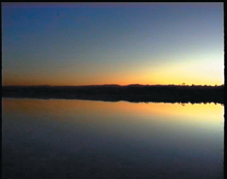
Leigh Hobba
I’m looking at Leigh Hobba’s face from 1982, the corners of his large tortoise shell glasses are rounded in the style of the time. Across five images he smiles or stares impassively. Each fragmented image is composed of squares that are cut, mixed and re-pasted to rebuild his portrait in a way reminiscent of Hockney’s collages of the same time. Combined with its title—Came so quickly from winter in Paris to Summer in Hobart that I could still feel the cold in my body—the series evokes the common sensation of arriving on another side of the world before your body has caught up. This work, mounted near the entry, seems at odds with the others at first, but on reflection, sets the scene for The Space of Presence, a retrospective of the last twenty years of Hobba’s practice.
Leigh Hobba is a prolific artist who has travelled widely, making work since the mid 70s. By the time he graduated from Elder Conservatorium in Adelaide, he was already excited by avant-garde approaches to working with sound, like John Cage’s, challenging methods for making music, embracing chance and using mechanical means to generate compositions. Since then Hobba has built a contemporary art practice utilising sound, video and performance. However for many, The Space of Presence offers the first viewing of the 12 pieces in the show.
As the first set of images suggests, a continuous thread linking all the works is the self, the body and the passing of time. The focus in Hobba’s work is the way he is affected by particular environments, from dense cities to remote Tasmanian wilderness.
This is a song about Hobart and some of the people who live here, is a video and sound work with a single, large screen display. Donning headphones, I listened to Hobba’s monotone recital of diary entries from a time in Paris. He mirrors me in the video, also wearing headphones, his stare unwavering. The monologue is a fast-spoken narration of ordinary events and acute observations, often humorous. Towards the end of the loop Hobba speeds up the recital to the point where the words take on an overlapping song-like rhythm with phrases repeated, broken down, rearranged.
I’ve seen Mycenae glistening over the wine dark sea, is a compelling, sensual installation enclosed in a dark, brick-red space dominated by a large projection of mist softly revealing and concealing a rocky outcrop. As if to emphasise its intermittent absence, a thick black line overlayed on the video provides the outline of the outcrop, even when it cannot be seen. Three small screens placed on the floor around the room show Hobba’s young, sleeping son. Lying on a black background, his pale skin and red curls angelic, the boy is so still his breathing is almost imperceptible. A long, low bench, placed diagonally in the centre of the space is covered with large rocks, each the size of a dinner plate. On three walls, door-sized panels, striped with mirrored perspex are fixed horizontally and vertically to reflect the greys of the mist and movement of visitors. The imperfections in the perspex stripes recreate the facets of the rock face. Having spent some time in the room, I come away with a sensation that is difficult to describe and the exquisite image of the boy fixed in my mind—his tiny breaths are the key here. Somehow.
There is an overwhelming sense in the gallery of time passing and the presence of a man for whom this is a preoccupation. While the works appear to be intimately connected to Hobba’s sense of self, they lack self-consciousness—there is no compulsion to be an artist of a particular time or type—and many pieces are unapologetically obtuse. He is quoted in the catalogue: “For me the act of recording is the act of documentation—a document of experience—in crafting that documentary, one might indeed create good fiction; in creating fiction one might equally create a good documentary.” Like the act of staring at rocks in the mist, I don’t think that we need to necessarily understand this exhibition, we just need to experience, to register its effect in our bodies.
Leigh Hobba, The Space of Presence, curator Craig Judd; Tasmanian Museum and Art Gallery, Hobart, March 16-April 29; Ten Days on the Island, March 23-April 1
RealTime issue #78 April-May 2007 pg. web
© Judith Abell; for permission to reproduce apply to realtime@realtimearts.net
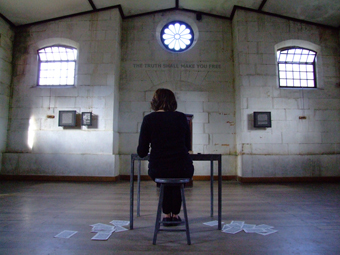
Brigita Ozolins, The Truth Shall Make You Free
photo Bec Tudor
Brigita Ozolins, The Truth Shall Make You Free
Taking my map and setting out to find the Port Arthur Project in this former penal settlement is like embarking on a treasure hunt, my first trial being to cut through throngs of tourists in the information centre and then the milling crowds waiting for guided tours. Finally I break into the open space of the foreshore lawn and my quest to find the Art hiding amongst the History begins.
Peering into the rectangular cutting of an excavation site, roped off in official fashion, I see the puzzling sight of bitumen inset with road disk markers and a drain cover. The accompanying interpretation boards displaying reproduced landscape paintings of the penal colony offer little clarification. It takes a minute and then I realise with amusement that what I’m looking at is a car parking space. Lucy Bleach titles this mock archaeological dig Reserved. It pokes fun at the visitor’s romanticised idea of history as static, and playfully queries what future generations might deem worthy of preservation from the present.
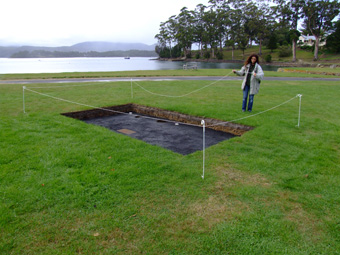
Lucy Bleach, Reserved
photo Bec Tudor
Lucy Bleach, Reserved
A few hundred metres away ten conical forms of about 1.5 metres in height, woven from tea tree and dodder vine and circled with a line of sand, are positioned in a ring. The organic material is dying and drying out; given enough time they will disappear into the earth. The shadows stretching from the work are strikingly figurative and I feel I am not entitled to step into this sacred congregation. Indigenous artists Lola Greeno and Vicki West have collaborated on Premaydena to honour the traditional owners of the Tasman Peninsula, the Oyster Bay people who were forcefully displaced by European settlement. It is a powerful representation of identity interwoven with place and environment. It’s remarkable that Port Arthur does not already have a permanent installation of this power to give due recognition to the earliest chapters of human history in this site.
In the quaint waterside Sentry Box I discover Matt Warren’s sound installation Cantus 35. A single wooden chair invites me to enter the dark cubicle and, once seated I look out to a glorious view of the sparkling sea. Around and behind me harmonic tones toll, swell and diminish, return, overlap and suspend. The soundscape is melancholy, enduring and emotive. My time with this work and this spot is intensely private. When I reluctantly draw myself out of this state of meditation I read that Cantus 35 is a response to the unforgettable sound of gunshots heard in radio newscasts during the Port Arthur massacre of 1996. Comprising 35 tones, this work pays tender tribute to each individual who lost their life. Warren is brave to have tackled this most recent dimension of the site’s tragic history, and he is the sole artist to do so.
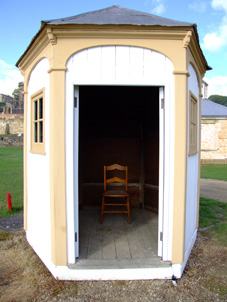
Matt Warren, Cantus 35
photo Bec Tudor
Matt Warren, Cantus 35
I climb the sandstone stairs to the cylindrical guard tower and find Anne MacDonald’s Memory no.5, a photographic installation exploring the passage of time and the inevitability of death. The word ‘memory’ is repeated in grainy black and white and I am confronted by the paradox and futility of trying to salvage something eternal in the face of mortality. Erosion has degraded the carved texts that derive from headstones. I struggle to conceive of the convict thousands who died under abject conditions here. I know that many were buried in unmarked graves on the Isle of the Dead. Each image is mounted in white and framed in apt funerary simplicity. Five works, in vertical arrangement, hang on either side of the pathway that transects the circular space, and on passing out the other side of the tower I am conscious of time sweeping me, slowly but firmly, through space.
I discover Brigita Ozolins seated at a small desk in the oppressive Separate Prison Chapel. Her feet neatly together, the artist at first appears a studious pupil. However, with nibbed pen and bottle of ink, she carefully writes over the pages of a printed book in an action reminiscent of the ‘lines’ naughty children were once given as punishment. When she fills a page she tears it out letting it drift to the floor before beginning the next. Her script repeats the statement she faces on the wall above the pulpit: The Truth Shall Make You Free. Ideas of truth and freedom must have seemed abstract for the incarcerated, especially here, where solitary confinement epitomised disempowerment and voicelessness. This defiant performance is one part of Ozolins’ tribute to inmate Henry Savery (convicted for forgery) believed to be Australia’s first novelist, who died and is buried at Port Arthur. She is writing on the pages of Quintus Servinton, Savery’s autobiographical novel. Writing ‘their truth’ must have provided precious self-affirmation and escapism for those convicts lucky enough to be literate.
Obviously not all visitors appreciate artistic intervention as part of their tourist experience. I see curiosity dissipate in a puff of annoyance for several people when the realisation hits that this is art. Cameras are lowered and retreats hastily made. However, I am impressed that most visitors are willing participants in critical analysis of the heavily mediated experience for which they have paid handsomely. Those who’ve bought Lucia Usmiani’s fold-out photographic mementos of the Port Arthur “red posts”, “pieces of ground”, “seats for sitting” etc. from the gift shop, for example, voluntarily completed the consumerist loop of the artist’s witty piece. I had a wonderful time.
The Port Arthur Project involves 25 artists working across sculpture, photography, furniture design, performance, printmaking, sound, video and other media. And there are 23 temporary, indoor and outdoor, site-specific installations distributed throughout the extensive site. Curators Noel Frankham and Julia Clark have coordinated a pluralistic reinterpretation of this complex site that is coherent and accessible—a considerable achievement given stringent heritage protocols and the minefield of this history: colonisation, Aboriginal genocide, brutal penal colony, 1996 massacre and part of the huge tourism economy in Tasmania.
Unlike the majority of visitors who will inadvertently stumble across the works in the Port Arthur Project, I was familiar with the territory and on a dedicated mission to locate these artistic treasures. I reflect now that my attempt to experience the exhibition free from ‘tourism’ perhaps made me as much a plunderer of the site as those seeking macabre thrills from Port Arthur’s tales of hardship and cruelty. I disregarded other narratives I deemed less interesting or relevant to me at that time. This is ironic given the works themselves bring to light the untold stories of convict sexuality, women and children and such under-recognised histories as those of the Indigenous inhabitants. If I were to see the show again, I think I might join the noisy guided tour group to get the full Port Arthur Project experience: contemporary site-specific art in an historic place.
Port Arthur Project: Re-interpreting Port Arthur Historic Site through Contemporary Visual Art, curators Noel Frankham & Julia Clark, artists Christl Berg, Lucy Bleach, Tracey Cockburn, Nicole Ellis, Anne Ferran, Linda Fredheim, Ruth Frost, Lola Greeno & Vicki West, Fiona Hall, Leigh Hobba, Colin Langridge, Fiona Lee, Karen Lunn & Milan Milojevic, Anne MacDonald, Anne Mestitz, James Newitt, Brigita Ozolins, Justy Phillips, Helena Psotova, Alyssa Simone, Lucia Usmiani, Matt Warren and Elizabeth Woods; Port Arthur Historic Site, Arthur Highway, Tasman Peninsula, presented by Tasmanian School of Art, University of Tasmania & Port Arthur Historic Site & Ten Days on the Island, March 16 – April 11
Bec Tudor presented a paper at the symposium Revelations… in Hobart, held in conjunction with the Port Arthur Project.
RealTime issue #78 April-May 2007 pg. web
© Bec Tudor; for permission to reproduce apply to realtime@realtimearts.net
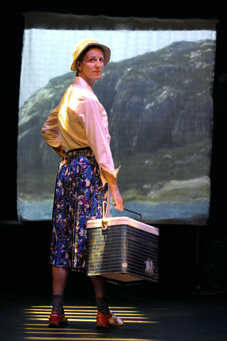
Cheryl Wheatley, Queen of the Snakepit
photo Michael Rayner
Cheryl Wheatley, Queen of the Snakepit
“Fuckin’ oath”, exclaims Lois, “Fuckin’ oath, ay?” Lois, played by Cheryl Wheatley, is our Flinders Island tour guide for the night. She is the ultimate boisterous Aussie sheila, with the broadest of accents, a passion for shandies, and she can handle a ute when a kangaroo jumps in her path. With the help of a kitsch teatowel (six bucks sixty from the tourist shop), showing a map of the Island, she takes us on a journey through the place where she was born and bred. She expertly morphs into local personalities: Queenie, Aunt Myrtle and her own mother, sharing the stories, myths and memories of some of this island’s female inhabitants.
I watch transfixed as Lois’ back slowly bends, her shoulders hunch, her face and neck contort and strain. She literally becomes Queenie, aging 30 years. Queenie’s voice is shaky and laboured as she reflects on the past: “pregnant, baby, pregnant, baby, pregnant, baby, pregnant, pregnant, pregnant, baby…“We know Lois has returned when her back straightens and she breaks into her infectious smile.
Lois also becomes Myrtle, the aunt obsessed with feral cats. A slight speech impediment, unusual body language, skirt hitched. Myrtle knows all—she warned the Island community, but no, they did nothing… so she had to take the cat problem into her own hands. Shakily, Myrtle sets up the slide projector to proudly show us the results of the cull. Wheatley effortlessly and convincingly moves between these unique characters.
As Lois she charms the audience with her familiar and friendly attitude, and I often get the feeling that she is smiling right at me; as you would expect in a small community such as Flinders Island. She shares shandies, stories and local knowledge and the audience regularly assist her with stunts or being the object of quite literal illustrations. To prove the force of the wind on the Island, a massive industrial fan is produced and then pointed directly at the audience, blowing coasters and vases off the tables, accompanied by a blustering soundtrack. We also experience “salt spray” first hand from a plastic dispenser while “sailing off the coast.”
I dreaded the prospect of audience involvement from the start of this performance when I sat down in the cabaret-style seating, observed a rubber snake coiled under the table and an empty glass on top. I never really relaxed into the show for fear of being bullied. But even in this state of tension, there was much to enjoy.
There were a few wonderful unplanned moments. Early in the show, Hobart Mayor, Rob Valentine’s hat is run over by the excited Lois and her wind machine, “Oh no, not the hat”, she shrieks (for those who aren’t locals, Valentine is never seen without his iconic wide brimmed hat). Later, on being squirted with the ‘sea spray’, one of the audience calls out “Don’t waste water”, to which Lois, retorts “Yeah, I’m not Dream Masons”; which refers to the obscene amount of water used in another Ten Days on the Island performance.
Wheatley’s one-liners were probably the most engaging aspect of Queen of the Snakepit. While some of the longer stories lost me at times (like the ones surrounding the little girl standing at the window), the vividly active were the most entertaining, such as the ride in the ute with its beautifully minimal props: two flashlights on either side of the esky, with Lois on a milk crate behind. Wheatley used mime and sound effects to evoke the experience, which was particularly funny when inflatable kangaroos were hurled at her oncoming vehicle, prompting a lesson on what to do in such circumstances.
Cheryl Wheatley is a fantastic entertainer and as a result Queen of the Snakepit is a lot of fun. I particularly enjoyed her skills in mime, her character transformations, the very Aussie sense of humour, as well as her infectious enthusiasm. The lasting image for me was of our initial introduction to Lois: a skinny woman weaving her way between the tables in a footy hat, daggy shirt and skirt, knee high beige stockings with a VB-filled esky and a wide welcoming grin.
is theatre, Queen of the Snakepit, deviser/performer Cheryl Wheatley, co-director/dramaturg Robin Laurie, writer Finegan Kruckemeyer, co-director Tania Bosak, designer Greg Methé, executive producer Ryk Goddard; The Backspace Theatre, Hobart, Ten Days on the Island, March 29-31
RealTime issue #78 April-May 2007 pg. web
© Lucy Hawthorne; for permission to reproduce apply to realtime@realtimearts.net
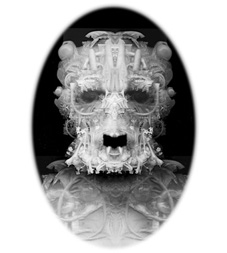
Murray McKeich, pzombie
From pre-cinema visual entertainments to the first Second Life performance art group, RealTime 77 celebrates media arts, a far-reaching field of not always screen-based and increasingly interactive works that are fast disappearing old meanings of ‘audience’, to create an arts experience that is insistently more immersive and mobile, and arts users who mutate into active participants. The new media arts domain of the Australian media arts field, although still vigorously infecting all forms and practices with its innovations, has been battered in recent years by the ill winds of artform envy, category debates, funding losses, reduction in institutional support and a consequent lessening of visibility. The ‘new’ has been struck off the new media arts label, leaving us with a looser, less troublesome, if often meaningless moniker. And yet, while some new media artists have fallen by the way, overwhelmed by costs, scared off by funding detours or exhausted by the sheer duration of working technology into form, many Australian artists and media arts organisations keep doggedly at it, as this edition of RealTime extensively illustrates. Media arts as a totality looks healthy—the history of alternative cinema is being re-explored and old devices and techniques reactivated and refashioned; video art continues to make the most of its second coming: and multimedia performance is thriving. In general, media arts (if not net art, wearables, mobiles, interactives, sound art) are ever more present in art galleries even if often problematically placed and resourced. While not a survey, our media arts feature is indicative nonetheless of the extent and the continuing inventiveness of media arts, old and new.
image: Murray McKeich, pzombie, see page 26
RealTime issue #77 Feb-March 2007 pg. 1
IN THE 2007 SYDNEY FESTIVAL WE ENJOYED AN UNUSUALLY LARGE NUMBER OF CHALLENGING AND DEEPLY SATISFYING WORKS FROM ARTISTS NOT AFRAID TO THINK BIG, EVEN IN SMALL WORKS.
Time, not merely as content (reflections, memories, forgettings, prophecies) but as form (temporal distortions and suspensions), figured frequently as we engaged with the traps of human intimacy and technological ingenuity, death and a welter of separation anxieties and fears about our future.
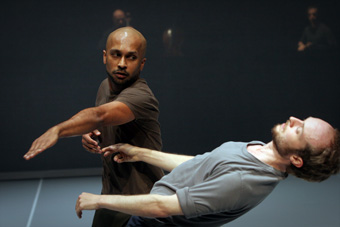
Akram Khan, Sidi Larbi Cherkaoui, Zero Degrees
photo Trent O’Donnell
Akram Khan, Sidi Larbi Cherkaoui, Zero Degrees
Akram Khan, Sidi Larbi Cherkaoui: zero degrees
Two men walk downstage, sit and address us lucidly in absolute unison of voice, gesture and mood. We see and hear them as one. In several episodes across the performance they tell us a first person story about travelling through India. There’s a border crossing, the man’s passport taken away briefly by the authorities unleashing fear and humiliation, followed by suspicion he may have overreacted. In a later episode, an old male train passenger dies and the subject of the story is advised not to help the screaming wife with the body, lest he be implicated in the death—“That’s the way it is in India.” After each telling a sustained movement passage unfolds, triggered by the idiosyncratic dance language of one of performers, the other following suit in his own way. However, as the metaphysical angst intensifies, the single being splits, each man turning to a humanoid dummy (created by sculptor Antony Gormley) which he manipulates, like a child, to fondle and assault him, to substitute for an absent other, or to use like a voodoo doll. Sidi Larbi Cherkaoui kicks the dummy and Akram Khan’s body convulses.
The story-telling becomes ragged, desperate and single-voiced, the dancing and its evasions more driven until the symbiosis exhausts the pair, one of them seemingly destroyed and carried offstage by the survivor. Zero Degrees is an intense drama of separation anxiety, of the push and pull of like but different bodies and cultures. The dance moves from intimate entwinement of intricate hand and arm patterning (perhaps stemming from Khan’s Kathak tradition and the vocabulary Cherkaoui has developed from everyday gesture) to rapid dervish twirling, to Kahn’s synthesis of Indian and contemporary Western dance and Cherkaoui’s elegant fusion of yoga, break-dance, martial arts and North African dance. These are displayed and shared. They trigger the music which is integral to them rather than the other way round, but the music stands on its own when Cherkaoui sings an exquisitely sad song.
In his program notes, Akram Khan writes about the way bodies are never truly still—breathing is constant and in death the body actively decomposes: zero degrees he defines as the point between life and death, stillness and movement, between merging and separation. Zero Degrees expresses all the pain and beauty of such a notion, with an almost insurmountable sense of loss at the piece’s end compounded by Nitin Sawhney’s elegiac composition for violin and cello. There’s no catharsis here, simply a meditative state sustained long after the performance’s conclusion.
batsheva dance company: telophaza
A company of some 40 dancers suggests all kinds of possibilities. By and large what we are delivered is a mass of movement and colour, the company intermittently breaking into very brief solos and mutliple duets and predominantly left to right waves of dancers crossing the stage. The effect was often of an abstracted chorus line, emphasised by uniform if multifariously coloured unitards. The look of the show is postmodern multimedia, the dancers’ faces initially looming large over the stage on four screens from cameras they themselves manipulate. The one memorable scene has a female dancer upstage directing a camera in extreme close-up to the foot on which her body balances and contorts but also offering a rear view of other dancers entering the space. We see the curl of the toes, the flexing of the foot, the sense of bones, then two feet working together accompanied by a thunderous, cracking soundtrack. A dance party scene with four cameras facing in as the dancers circle and take turns at soloing to a soaring rock guitar promises more point of view pleasures but rewards us with none and some indifferent dancing. In a strange ending, two members of company are caught naked upstage on camera, faces and hands in intimate contact. Another dancer steps her way across the stage lined with chairs while the male dancer from the coupling cavorts wildly around the stage to some ineffectual strobing as if to suggest that suddenly out of the mass of anonymity that the show has largely represented there has been some indecent personal moment or sleazy surveillance of it. Overall there was always something to look at in Telophaza but in terms of surveillance and the desiring gaze this was always a show in which as a last resort there was always someone to look at if never for long enough. The rule of thumb seems to be that the bigger the dance company the more limited and cliched the relationship with technology.
the holy body tattoo: our brief eternity
After an aural prelude taken from the soundtrack of Blade Runner (“Have you ever retired a human by mistake?”), Our Brief Eternity opens (and later closes) with the projected words “Somehow, continue…”, and the company cites Marshall McLuhan in their program notes—“The new integral electronic culture creates a crisis of identity, a vacuum of the self which generates tremendous violence.” You know where you are, but it doesn’t prepare you for the ear blistering steam-hissing industrial punk or the vision of compulsive machinic bodies in an ultra disciplined type of moshing and with a constant sense of impending mayhem. The dance is a kind of punk minimalism delivered by three dancers first working from flat out on the floor with rigorous single handstands and rapid rolling. Later they stand, pumping as if hydraulically driven. Rare moments of intimacy look more like manipulation and threat. The three bodies perform identical movements, often with one slipping in and out of pattern—no room for error. A film of the company dancing the same work (premiered in 2006 at the Los Angeles Center for Digital Arts) acts like a kind of mirror, but the relationship between stage and screen is not dynamic. Movement and text suggest a world on the edge of apocalypse or, more likely, rapid entropy, the latter evident not only in the choreography but in the weariness of the real dancing bodies and a certain sameness after a while. How much more can you say about the machinic body? Interesting nonetheless.
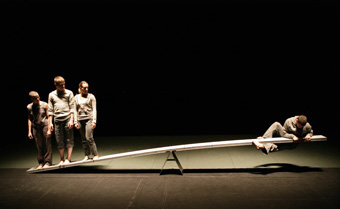
Lucy Guerin Inc, Structure and Sadness
photo Jeff Busby
Lucy Guerin Inc, Structure and Sadness
lucy guerin inc: structure and sadness
Midway through Structure and Sadness, Lucy Guerin does something very bold and it unleashes great emotion. Having created an abstract world of construction and its tensions in both the bodies of her dancers and in the creation they have just finished building, she suddenly literalises it. A woman in black listens to the radio as she washes dishes at an imagined sink. She sings along to a pop song, Crimson and Clover, which switches between tinny radio sound and full amplification, as if we are moving in and out of her head. Behind her, two other women also in black set up a wailing chorus to the song while balanced on a pliant bridge. The music is interrupted by a news broadcast and women and audience are plunged into the facticity of the 1970 collapse of Melbourne’s Westgate Bridge. Pop becomes a grieving cry, the long black dresses evoke the funereal dress of many cultures (and in the look and movement not a little of the potency of a Martha Graham dance drama). The woman sways, nearly falling, the male dancers in grey, heads hanging low, appear as if among the dead (35 men were killed). The dead weight of the men literally bears down on the women.
Structure and Sadness concludes with a long, consoling, almost courtly dance between the dead and the living, commencing palm to palm in a movement motif we’ve seen from almost the beginning of the work, in a duet where bodies test each other for weight, tension and pliability. In the first part the dancers move on to build a structure from tiny components and then larger and larger ones—into a veritable house of cards. They also balance unevenly on a large seesawing plank under which a living body lies, as if testing for endurance. This image returns in the show’s coda: four of the dancers become inert bodies with the plank laid across them. Another dancer crosses pushing down on those below, reminding us that this bridge rests on the bodies of the dead.
Structure and Sadness is a major Australian dance work (certainly punching at greater weight than its “About an Hour” festival programming) with the courage to think big and ambitiously about work, death and the traps of human ingenuity. The totality of its choreographic and theatrical vision encompasses adventurous design by Bluebottle and media (Michaela French) built into the very body of the work, the dancers, and a musical score that works through and with tension, building on the twang and buzz of wires stretched and relaxed, distorted and at the end resolving to a comforting lyrical guitar played nevertheless over a fast still twanging pulse. Perhaps there’s room for some tightening of the work in the first half and perhaps a closer view is needed for the audience of the initially small work of the dancers as they build, but Structure and Sadness deserves a long and successful life with its frank countenancing of death and grieving.
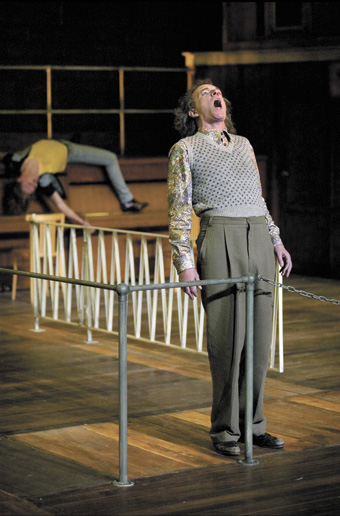
Graham Valentine, Seemanslieder
photo Phile Deprez
Graham Valentine, Seemanslieder
zthollandia/ntgent: seemanslieder
In his appreciation of the work of Christoph Marthaler, the great Swiss theatre and opera director, Benedict Andrews wrote in RealTime 76 about how “his theatre slows time to a standstill”, creating “ a time between. A time of waiting, of remaindered thoughts, leftover people and once forgotten songs.” Seemanslieder, performed by Belgium-based NTGent and ZTHollandia in a Belgian-Dutch collaboration, epitomised the Marthaler vision.
Time, space and personality are all mutable in this world; songs, narrative fragments and monologues evoking very different periods and attitudes to the sea in a small coastal community over hundreds of years. Tales of fishing, pirating, executions, drownings and yearnings, preaching and drunkenness (especially drunkenness), wives and mothers at home, men at sea, sons in fear of it, drift out into the auditorium from a stage populated by strange characters, familiar yet alien, like the drowned rising up to speak, so much of their business unfinished, wounds still open, lives drifting, memories floating, free associating, coming to the surface. There are also curious inversions—a woman sings an erotic song of seduction to another woman, a song a sailor longing for a woman would sing. Anna Viebrock and her fellow designers’ set looks totally lived in, replete with ceiling, incredibly solid, very real but oddly transcendent, phasing between terminus, ship’s deck, bar and the deep as men flip like fish across its floor. The timber wall at the back looks like an ageing dock or an old hulk from which a pipe pumps bilge.
In this floating world, amplifying the sense of it ghostliness, time frequently slows for song, solos and sotto voice choral works, folk songs, torch songs and lieder gloriously acquitted. Eruptions of farcical action intrude, sight gags out of burlesque, silly but relentlessy persistent—pratfalls, toupee jokes, a clever routine of being swept along by an umbrella in a windstorm. Sometimes the two modes merge: in a haunting rendition of a song from Ravel’s Sheherazade suite sung close to silent by the company, the drum kit player (in an unlikely accompaniment to glorious piano playing) crawls across the floor playing his sticks against it (this kind of crawling and rolling and crabbing one of the show’s swimming motifs), while a sailor taps out the beat on his rubber boot. The company all sing beautifully, their faces expressing reverie, indifference, boredom. One way or another the songs possess them.
Characterisations only slowly accumulate as you get to know these people, their quirks and obsessions like the tall Scot who looks like he’s about to sexually assault a woman (“I want…I want…I want!”) only to be rejected or assaulted in turn and then thank her for her company before disappearing into his room. Later, he surprises us with a long, grotesquely beautiful rendition of “Lowlands”, his wanting now illuminated in a very different way.
Despite death’s insistent presence in tales and songs, the universe of Seemanslieder is essentlally comic, and like most comedy rooted in hysteria and melancholia, a reminder of Marthaler’s Le Coq training. The ship’s barmaid, for example, is a kind of dramaturgical glue, serving the drinks, keeping the customers in order until she herself has too much, loses her shoes and, struggling to slip into them without using her hands, reveals herself to be quite a contortionist; her agony has all the pathos, obsessiveness and vulnerability of a drunk. This is the comedy of recurrent accidents, helpless compulsion and incapacity, which always require skill to play, everything predicated on the worst possible chain of cause and effect. It’s a world of farce—of two toilet doors through which people constantly disappear, get trapped, vomit into or or use to conceal shipboard liaisons. And of slapstick. Or the surreal—the useless bicycle that descends from above. It’s the comedy of escape from pain through alcohol or morose religiosity in hymns that pray for Jesus’ unlikely succour.
Compared with Marthaler’s Stunde Null (London International Festival of Theatre, 1997), the director’s grimly comic account of the conversion of Nazis into democratic politicians, and the only other work of his we’ve seen, Seemanslieder is a delirious reverie, an adroit cut and paste of the songs, tales and anxieties of European sea-going cultures of other times and no time in particular into an absorbing totality with its own sad comic logic.
gate theatre beckett season
In Beckett’s Eh Joe, Charles Dance (substituting for Michael Gambon) in dressing gown in a small dim room, closes the curtains over windows, cupboard and door and sits in profile to the audience. His face appears, gigantic and slowly growing, on the scrim between us, every detail of his face writ large as a female voice begins its litany of accusations—in his head, or filtering through the floorboards, in the air between us. Dance distributes the changes in his expression sparely, initially with glowering intensity and then a weakening into vulnerability as the truth, or whatever it is it, hits home and a tear falls at the end of the half hour performance. If Krapp worries at his own earlier recorded and often forgotten utterances, at least the voice is his own. Joe is like a man haunted and rendered speechless, or is the voice his own ventriloquism, the only way he can admit his doubts and crimes? Directed by Atom Egoyan, the screen device with its double view of Dance, apart and face-to-face with us, worked strongly both emotionally and as an easily accommodated theatre-cinema hybrid.
By contrast, Ralph Fienne’s performance of the novella First Love adapted for the stage was a pretty straightforward piece of telling, but I’ll Go On with Barry McGovern, a master Beckett performer, was a venture for actor and audience deep into the writer’s concerns about life, death and especially language. The selections (made with Beckett’s approval) ranged from passages of relatively broad situational humour from Molloy and Malone Dies to The Unnameable’s nightmare of our entrapment by words—never quite any speaker’s own and here delivered at terrifying pace, the essential poetry of the prose awesomely intact. In the earlier, garrulous excerpts McGovern is garbed in long black coat he reveals to be lined with The Times, while in The Unnameable he is almost naked, laid out it would seem in a mortuary.
The Beckett series was, of course, a festival hit, even though no substantial master work was included, rather an adaptation, selections and the eerie Eh Joe, and some notable star actors. Three short works on separate nights, although I’ll Go On was relatively more generous. Luxury theatre. Since the Beckett film series associated with The Gate (out of which Egoyan’s Eh Joe came) and the centenary of 2006, and perhaps something to do with the nature of the times (there was a noticeably high turnout of politicians), Beckett has regained an audience. But this series was more than a sideshow for a missing main event: Dance was courageous and subtle and McGovern’s performance was a revelatory reminder of the powerhouse that Beckett is: inherently theatrical, deeply Irish and with a glorious love-hate passion for the word.
maly drama theatre of st petersburg: uncle vanya
The Sydney audience, still bubbling with post Christmas and New Year cheer, had some difficulty settling down to this almost exhausting dose of Russian ennui. The actors play it and live it for what it is, and in very real time. Characters are just as likely to think before they speak as erupt into action. Entrances can be languorous, characters placing themselves precisely across the large stage or in small tight clusters before engaging, or moving almost farcically fast through the many doors that frame the low-walled set. As with Venia himself, so Chekov’s Uncle Vanya requires patience, which is richly rewarded.
One of the greatest pleasures of this Uncle Vanya was to be able to hear it in Russian (as it was too with the guttural, watery western-European languages of Seemanslieder), read the surtitles (good ones and the pace mostly manageable) and not infrequently register subtleties of interpretation (if still behind the Russians in the audience). To see Chekhov spoken in Russian is a double pleasure, witnessing words delivered from time to time with large gestures and intense facial expressions that yet never yielded to melodrama. There are likewise surprising moments of physical intimacy: Elena and her husband professor at odds but entwined. This heightened sense of familiarity and intimacy makes the potential for tragedy all the more felt, and the acuity of Chekhov’s quietly comic vision of lives desiring but resisting change all the more sad. As director Lev Dodin, in Sydney with his company, has argued, for all their sense of loss, failure and ennui, the characters “take up the struggle for life with vigour….here everyone wants to live.” As much as they complain, they still make a go of looking for love or, like the doctor, to saving a depleted, neglected environment. In this respect the play’s observations about feminism, environmentalism and the challenges of rural life feel contemporary in a production that, unusually for the Maly Theatre, is conventionally presented.
However, as well as the careful choreographing of the action (‘blocking’ cannot do it justice), there are aspects of the production that subtly counter the traditional costuming. Suspended over the stage on a metal grid are three huge haystacks (“chasing dreams while the hay rots”). In the last scene of the play as Vanya and Sonya work at their desks, having committed to the farm forever, the stacks are slowly lowered around them. Elsewhere a single set of french windows provides a motif for temporary relief and escape, rain pouring down them and, when opened, releasing a very loud post shower plip plop which underscores the action like a demented metronome for a very long time. The playing too was fascinating in its blend of understatement and passion, sometimes declarative—delivered to the audience without overtly acknowledging our presence—sometimes interior, always intimate and at its best in the socially uncomfortable Vanya (Sergey Kuryshev)—obsessed, distracted, out of kilter.
meryl tankard & taikoz: kaidan, a ghost story
Kaidan is a work of great beauty if little else. It is exhaustingly Japanese in style, from the story to its music (by Ian Cleworth for Taikoz, Riley Lee on shakuhachi) and its kabuki and bunraku influenced staging and movement. Looking like a fashion cross between Sofia Coppola’s Marie Antoinette and an upper class Japanese matron, a woman (a perfectly cast Sarah-Jane Howard) rids herself of a mirror not realising that it’s tantamount to throwing out her soul, with dire consequences for herself and her community. The storyline is fuzzy in the $8 program, if you bothered to get one, and even less tangible on stage. What begins with a narrative flourish or two becomes increasingly opaque.
Regis Lansac’s projections commence with a widescreen black and white misty riverside scene through which we glimpse the woman’s ghost (before she takes sudden flight in one of the show’s aerial routines) and progress through a series of exquisite, richy coloured natural images of ever changing proportions, presented Rorschach-style. In themselves these are beautiful but in the end add to a superfluity of effect. The treatment of the woman as a bunraku puppet lacks the precision of the original form (and of Theatre du Soleil’s Flood Drummers), nor is it a sustained device. The woman’s final mad dance is well executed by Howard with the requisite passion, but as elsewhere the choreography seems indeterminate.
circa: the space between
The Space Between is an exquisite physical theatre miniature focused on a series of mutating physical relationships in duos and trios with occasional solos. Bodies tangle, wrestle, caress and mutually manipulate each other well beyond the range of normal touch, but tell us much about ourselves. The show is built on close observation and fine detail and not on spectacle, comedy or sex or even conventional routines. The gravity that has to be overcome in this physical theatre is the weight of human dependency and the desire to intensify or to escape it. Every possible permutation of entanglement is entered into and every ounce of concentration is devoted to keeping that relationship balanced—always a tense, tentative affair but the drive is to do it again and again. Circa don’t rush, they enter these states slowly therefore often face more tortuous demands than usual on muscles and the sense of balance. This stress reaches a critical intensity in a late scene where all three bodies clamber up and over each other in a fluid knotting and unknotting of arms and legs.
While occasionally scenes appear perfunctory or oddly placed, and the musical selection is taxingly various (a through-composed score please!), The Space Between is a work which often demands and rewards careful attention, revealing how little real, unoccupied space there is between human bodies.
adt: devolution
Never act with children or animals. You could be tempted to add ‘or dance with robots’ after seeing Devolution. But somehow the fascinating anthropomorphic machines that so demand our attention here share a world with the humans they, and likewise we, watch with curiosity, and who are, in Devolution’s most alarming scene, becoming like them. The first bodies we see are Gina Czarnecki’s naked human apparitions floating hugely before us on a downstage scrim, twisting and turning against each other in a fluid cluster, and then in more and more clusters. multiplying into a universe of these organisms. They then fade to the live action of Devolution—leather-clad ferals peopling the stage with furious energy in brief virtuosic turns, sudden damage free Euro-crash clashes and, most striking, a recurrent creature-like clustering—heads appearing at odd angles, limbs rippling out like tentacles. Devolution offers little of the comforts of individualism.
What we witness is an ecosystem at work where humans and machines co-exist—there’s no obvious conflict, no working relationship. If the humans here once invented these robots they certainly have no control over them now and make no such attempt. They simply occupy a space with a kind of ritualistic fervour observed by the curious machine giants who appear to scan the humans, even bend down and peer at their couplings and tusslings or, in smaller versions, scurry between them like insects.
The robots too dance, in their way: the giant ‘scanner” running on a grid above reshapes its component parts with surprising variety; a row of tall robots across the back of the space undulate with a kind of showgirl finesse; two peering giants each clomp about on their four feet; a worm-like creature unfolds from above and sways about inspecting its domain. All have bright headlight eyes, some have heads that swivel, but there are no limbs that could reach out to, touch or manipulate a human body: their evolution presumably has not required it. The humans are evolving too, into machines (or have they been unwillingly co-opted?)—with horrendous long, mechanical tendrils that whip out from chests and backs. If human and tendril appear to be one organism, the issue of agency however is never clear—which part is in control? Moreover these new humans look like dangerous loners.
In an intensely dramatic passage of near contact, robots and humans move dangerously close to each other before returning to their respective stillnesses and clusterings. How long their ecological mutualism will last is an open question—the merging has begun and the meaning of the final projected image of one cluster of humans disappearing into the distance is clear enough. Obviously, director and choreographer Garry Stewart worries that what we are setting in train with technological development is regressive, a de-evolution, a departure from what it means to be human. However, with roboticist Louis-Philippe Demers, he does it with passion, precision and an escalating inventiveness that, ironically, pushes the robot cause forward with a kind of Robocop, Terminator, Mad Max fascination. It’s a reminder, too, that the work’s form is itself somewhat regressive, looking back to older forms of sci-fi, most recently reinvigorated by the Steam Punk genre evoked here in the heavy duty industrial sound score and the wonderful hydraulics of the robots. In his choreography Stewart textures his trademark high speed dance acrobatics with quivering balletic touches, suggesting finer human things too face loss. The work will tour Europe this year.
lou reed: berlin
Except for cultists, Berlin is not an album that many people, even some Lou Reed fans, seem to know. This sell-out concert version, doubtless destined for CD and DVD, will change that. It was a joyful discovery of a grim song cycle about the decline and death of a female junkie and mother in Berlin that the 1970s found unpalatable. The spare lyrics and stark compositions that foreground Reed as performance poet narrator, the shockingly disinterested observer of disaster, still hit home, the original Bob Ezrin orchestrations updated with a pervasive minimalist pulse but always with the capacity to pull back just to the voice and a lone guitar. The remarkable Steve Hunter, who appeared on the original album, shared lead playing with a very able Reed in a strong band plus a chorus (from the Australian Youth Choir) led by Antony and Sharon Jones, and three brass and three string players, these add-ons all dressed in pastel blue and placed beneath a trademark Julian Schnabel wallpaper cut and paste and a real, suspended lounge with a single strip of white paint banded across it. Less than convincing video projections of someone playing the album’s subject mingled with the imagery. The real power of Berlin was simply in the music, performed with commitment and precision but never departing from the rawness that makes it work. It sounded a lot better to me than the original. Its frankness still shocks.
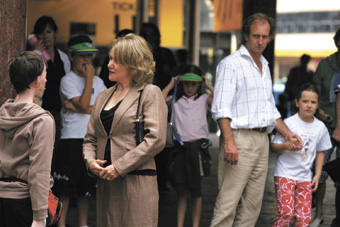
Simon Laherty & Genevieve Morris, Small Metal Objects
photo Prudence Upton
Simon Laherty & Genevieve Morris, Small Metal Objects
back to back
In the 2007 Sydney Festival Geelong’s Back to Back Theatre’s Small Metal Objects was a standout amidst standouts. Like Seemanslieder, like Structure and Sadness, Eh Joe and Uncle Vanya, Small Metal Objects took its audience into a very different time and a very different place. As with those others, the production requires a certain surrender, a giving of yourself to the time world of the subjects, here to the slow, thoughtful exchanges between two drug dealers Steve and Gary (Simon Laherty, Allan V Watt). Steve is deep in thought, paralysed with anxiety about his sexuality and his friend’s health. This state is pitched against the cajoling and panic of their bourgeois customers (Jim Russell, Genevive Morris). Other time worlds drift or hurry by as people pass or enter the Circular Quay terminal, and our head-phoned surveillance superiority makes for its own uneasy sense of displacement in this simply scripted but complexly conceived and subtly produced and finely performed work.
the big picture
Inching towards the Melbourne International Art Festival’s current pre-eminence (and likewise eschewing ballets, operas and symphonies) the 2007 Sydney Festival at last showed that it could offer more than two or three exceptional works in a program. What’s more, Sydney audiences went for it with record box office takings. And politicians past and present, mostly federal, were out in force—Whitlam, Turnbull, Coonan, Hawke, Debus and more. Let’s hope the Minister for Water made it to Seemanslieder.
A vital addition to the festival was The CarriageWorks, the new contemporary performing arts centre in Redfern which opened the festival and was in turn opened by it. Temporary seating problems aside, the venue proved remarkably attractive, the vast foyer a great meeting place. Its presence and its performance spaces also signal a great opportunity for the Sydney Festival to do what Melbourne has done ever since the Robyn Archer directorship—celebrate the art of the city, particularly Sydney’s contemporary performance and dance.
–
Les Ballets C De La B and Akram Khan Company, Zero Degrees, dancers Akram Khan, Sidi Larbi Cherkaoui, composer Nitin Sawhney, sculptor Antony Gormley, musicians Tim Blake, Coordt Linke, Faheem Mazhar, Alies Christina Sluiter, dramaturg Guy Cools; The CarriageWorks, Redfern, Sydney, Jan 5-8
Telophaza, Batsheva Dance Company; choreographer Ohad Naharin; costume design Rakefet Levi; dramaturgy, sound design Ohad Fishof, Capitol Theatre, Jan 6-10
The Holy Body Tattoo, Our Brief Eternity, choreography, concept and direction Noam Gagnon, Dana Gringas, performers Susan Elliott, Noam Gagnon, Dana Gingras, Music Jean-Yves Thériault, film direction William Morrison; Playhouse, Sydney Opera House, Jan 8-12
Lucy Guerin Inc, Structure and Sadness, choreographer Lucy Guerin, dancers Fiona Cameron, Antony Hamilton, Lina Limosani, Alisdair Macindoe, Kirstie McCracken, Byron Perry, composer Gerald Mair, motion graphics Michaela French, set and lighting design Bluebottle (Ben Cobham, Andrew Livingston); Drama Theatre, Sydney Opera House, Jan 9-12
NTGent, ZTHollandia, Seemanslieder, director Christoph Marthaler, musical dramaturgy and singing coach Christoph Homberger, design Anna Viebrock, Duri Vischoff, Frieda Schneider, costumes Sarah Schittek; Syndey Theatre, Jan 10-13
Gate Theatre Dublin, Samuel Beckett Series: First Love, director Michael Colgan, performer Ralph Fiennes; Eh Joe, director Atom Egoyan, performer Charles Dance, voice Penelope Wilton; I’ll Go On, director Colm O’Briain, performer Barry McGovern; Parade Theatre, NIDA, Jan 10-22
Maly Drama Theatre of St Petersburg, Uncle Vanya, writer Anton Chekhov, director Lev Dodin, designer David Borosky; Sydney Theatre, Jan 22-27
Kaidan, A Ghost Story, direction, choreography and design Meryl Tankard, musical direction Ian Cleworth, illuminations Regis Lansac, music Taikoz, Riley Lee; Drama Theatre, Sydney Opera House, Jan 18-27
Circa, The Space Between, direction, concept, lighting Yaron Lifschitz, performers Darcy grant, James Kingsford-Smith, Chelsea McGuffin; The Playhouse, Sydney Opera House, Jan 23-27
Australian Dance Theatre, Devolution, direction Garry Stewart, robotics Louis-Philippe Demers, projections Gina Czarnecki, costumes Georg Meyer-Wiel; CarriageWorks Bay 17, Redfern, Sydney, 24-27. See also RT72, p32
Berlin, music and lyrics Lou Reid, music producers Bob Ezrin, Hal Wilner, direction & design Julian Schnabel; State Theatre, Syndney, Jan 18-20
Back to Back Theatre, Small Metal Objects, directed and devised by Bruce Gladwin, performers Simon Laherty, Allan V Wall, Jim Russell, Genevieve Morris, sound design Hugh Covill, Customs House forecourt, Circular Quay, Sydney, Jan 8-25
2007 Sydney Festival, www.sydneyfestival.org.au
RealTime issue #77 Feb-March 2007 pg. 39
© Keith Gallasch & Virginia Baxter; for permission to reproduce apply to realtime@realtimearts.net
SPILL, A NEW INTERNATIONAL PERFORMANCE FESTIVAL IS SOON TO PREMIERE IN LONDON. IT’S THE BRAINCHILD OF ROBERT PACITTI OF THE PACITTI COMPANY, AN EXPERIMENTAL THEATRE COMPANY BASED IN EAST LONDON AND WELL KNOWN FOR ITS WORK IN EUROPE. THE AIM IS TO IMPROVE THE LOT OF PERFORMANCE IN THE UK, TO CHALLENGE LONDON THEATRICAL CONSERVATISM AND GENERATE INTERNATIONAL EXCHANGE.
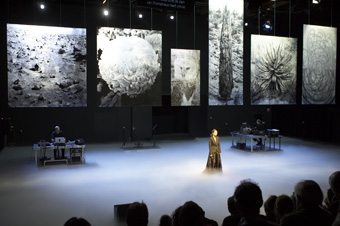
Francoise Berlanger, Penthesilea
photo Thierry Monasse
Francoise Berlanger, Penthesilea
Pacitti was one of the mentors in the very first Time_Place_Space hybrid performance laboratory held in Australia on 2002. At a meeting in London in February 2006 and then in a recent email exchange we asked Pacitti to detail his motivation for such a large undertaking as SPILL.
“SPILL is very much an artist led initiative”, he writes. “The festival has grown out of my increasing frustration that our own work and that of many peers, whilst remaining very successful overseas, still struggles to be seen and taken seriously in the UK. There are many complicated—and alas, dim-witted—reasons why radical or ideas based work is a tougher beast to place here than more traditional forms, but few of them are actually to do with what audiences seem to want. So I knew I had to do something to force change, but I also knew I would fail in that if I just tried to better my own situation. Therefore SPILL is absolutely about the company being in service to a larger context, and the implications of that are truly international.”
In the UK there’s an incredible variety of forms of contemporary performance and fluidity between the categories of live art, performance art and experimental and new theatre. SPILL exemplifies the range and diversity of practices, juxtaposing, for example, Forced Entertainment, Raimund Hoghe, Kira O’Reilly, Francoise Berlanger, Hancock and Kelly, and the Pacitti Company.
For all this plenitude, however, Pacitti describes London as being without a focal point for contemporary performance: “London really lacks any ongoing high profile, properly resourced platform for performance. The city likes to ‘big itself up’ as a wild theatre capital, but in reality it still exists within very safe territory. This is clearly evident in the current plethora of site-specific work being made by younger artists who seemingly lack any desire to present content. It’s as if the civil rights movements never happened. So to that end SPILL is deliberately a programme of volatile work shown for incendiary ends.”
grand collaboration
Invited companies and individual artists will not only appear in SPILL in their own works but will collaborate with Pacitti Company in Finale, a work based on Emile Zola’s 1867 novel, Therese Raquin. Pacitti writes that many of them already have a collaborative history of some kind with his company. Finale was originally designed for the company when touring to challenge the notion of what it means to be a visiting artist. “We do this by running a two-week workshop for up to 30 local practitioners around issues of manifestos and explicit bodies, and the local artists then become performers in the piece, presenting their own workshop material integrated with our existing images. It’s crucial that everybody has equity though, and this is always the tricky bit. It’s a risky model for us as we never know quite what we’re going to get, but it means that each performance is a unique event that starts to unpack issues around what it means to host and what the status is of the visiting artist in relation to home-grown talent.”
Now Finale will be played out on Pacitti Company’s home ground: “In SPILL we are addressing a politic of international reciprocity by inviting artists from Brazil, Belgium, France and Australia who have been through this process before, to show their own practices and then work collectively with us as an international group to end the festival with Grand Finale. It’s a new model for us, and feels very political.” Grande Finale will be accompanied by the Swiss cult electronica band, Velma.
the program: scope
SPILL includes more than 50 performances over three weeks, a two-day international symposium on sustainable models for experimental practice; a weekly banquet for audiences to sit down informally and eat with artists; a program of feature films each accompanied by contemporary performance shorts; and “a series of ‘hidden’ messages around the city, accessed only via bluetooth broadcasts and SMS.” Venues include the Barbican, the South Bank Centre and the Soho Theatre.
In London’s vast Shunt Vaults below London Bridge (where the young performance company Shunt work) SPILL will collaborate with the Live Art Development Agency on an exhibition, Future Classic, of documentation of performance activity lineages from across the visual arts, dance, civil rights movements, clubland and film. “Future Classic is a participatory exhibition that will run throughout the festival. Onto a wall map placed deep within the Shunt Vaults audiences are invited to submit key influences that they feel are important to the development of contemporary performance praxis. Over the festival period these influences will accumulate to become a new collective map charting the activities of people and times that have somehow forced change, and in doing so become pivotal to the furtherance of performance making—either deliberately or otherwise.”
the program: artists
Forced Entertainment will present their magical saga of unfinished tales, And On The Thousandth Night (seen at the 2004 Adelaide Festival), and Exquisite Pain, their performance adaptation of the Sophie Calle work (see RT 78 for a report from Christine Evans on that performance and Quizoola by the company at the PuSh festival in Vancouver and also The World in Pictures, in Dublin).
Brazil’s Andre Masseno, a dancer, actor, choreographer, costume designer and stage director, will present his solo work I’m Not Here or The Dying Swan, a dance dialogue with Fokine’s 1907 choreographic piece for Anna Pavlova. Brussels based artist Eve Bonneau interrogates her own nudity in live performance with video in Body is the First Word I Say, her practice focusing on the body as organism: “The passage of experience from the body into the performance, of an organic world becoming a social body.”
Another Belgian artist, originally from Algeria, Francoise Berlanger bases her Penthesilea on the Heinrich Von Kleist version, producing “a work about the shock of falling in love, and the subsequent violence of loss.” Working with her visual artist brother Marcel, two sound artists, and a scenographer, Francoise Berlanger “plunges us into the cruel and haunted consciousness of a woman at war with herself as her flesh and her mind falter with fatal effects. Half-woman, half-animal, the stage is her abyss.”
In Tattoo, Traci Kelly will her have her back tattooed in the pattern of wallpaper from co-performer Richard Hancock’s childhood home. The work by these UK artists is described as “a slow archaeology…The tattoo will form a permanent exhibit; a visceral exchange of memories from one body to another.” The compelling Kira O’Reilly will present a new performance, a SPILL commission, which will doubtless be as beautiful and disturbing as previous works where she’s inscribed on her body with fine blades. Live art practitioner and long-term Pacitti Company member Sheila Ghelani will explore cultural and other hybridities in Covet me, Care for me , about “dissemination, about ‘upping the value of the mongrel’, about rejoicing in cross fertilization…”
Julia Bardsley (UK) will present one part of her Trans:Acts, “an accident at the cross-roads between video and live presence—a smash up at the intersection of performance and the script—a director and actress splayed across the dissecting table, waiting for the understudy to walk on and corpse—a last supper for an audience of twelve intimates.” The complete trilogy was presented at the National Review of Live Art in Glasgow, February 2005, and the TROUBLE Festival, Brussels in November 2005.
The engagingly idiosnycratic Raimund Hoghe (Germany), former dramaturg to Pina Bausch and solo performer (2003 Melbourne International Arts Festival, RT 58, p6) will appear in Sacre—The Rites of Spring with Belgian performer Lorenzo De Brabandere, responding to the Stravinsky score with “a new, contemporary and minimalist interpretation of the ballet classic: an initiation ritual for two men.”
As well as orchestrating Grand Finale, Pacitti Company will show its video installation, Three Duets, in which Pacitti performs in duets about self, sexual identity and age with Sheila Ghelani, Juliet Robson and octogenarian Angela Rodaway. The company will also present Civil, a significant moment in Pacitti’s personal history as an artist. It is rare for performance works to be presented by anyone other than their maker. Now Pacitti is to pass on one of his best known works about his encounter with Quentin Crisp in New York in 1996 and focused on issues of disobedience and civil rights, to a younger performer, Richard Eton.
Last, but not least, emerging Australian performance company Unreasonable Adults (RT76, p25) will present Last To See Them Alive, a solo performance by Carolyn Daish to a text by Fiona Sprott with direction and sound by Jason Sweeney. In RealTime 75 (p46), Sprott detailed the workshop gestation of the piece, from which has come “a series of monologues which propose a ‘character’ of a single girl and her relationship to a serial killer, distorting the traditional romantic fantasy portrayed in romance fiction to ask: ‘How do you meet Mr Right in an age of Serial Killers?’“
With the LIFT festivals now well in the past and the new Lift moving in a very different direction (p2-4), doubtless SPILL has the potential to satisfy the urgent needs Pacitti has identified. Lke LIFT before it, SPILL may find everyday arts competition in London a considerable challenge. However, the sensible scale of the festival, a strong program and an audience Pacitti believes is ready for challenging work, could create in SPILL the performance platform he yearns for as an ongoing entity.
SPILL, Festival of Performance, London, April 2-22, www.spillfestival.com
RealTime issue #77 Feb-March 2007 pg. 6
© RealTime ; for permission to reproduce apply to realtime@realtimearts.net
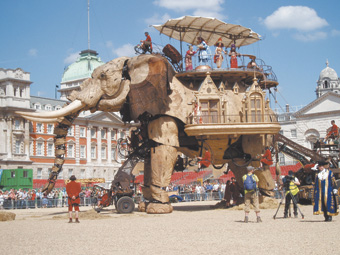
The Sultan’s Elephant, Royale de Luxe
photo Susana Paiva
The Sultan’s Elephant, Royale de Luxe
EARLY IN 2006, WE MET LIFT (LONDON INTERNATIONAL FESTIVAL OF THEATRE) DIRECTOR ANGHARAD WYNNE-JONES ON AN ICY DAY, APPROPRIATELY OVER A WELSH RAREBIT IN A CAFÉ NEAR THE LIFT OFFICE IN LONDON’S EAST. WYNNE-JONES HAS BEEN BUSY REVITALISING THE 25-YEAR-OLD FESTIVAL, RADICALLY INTENSIFYING ITS LONG-TERM LOCAL AND INTERNATIONAL FOCUS. HER ENTHUSIASM FOR THE 2008 FESTIVAL AND THE VALUES UNDERPINNING IT ARE CONTAGIOUS, HER LANGUAGE PEPPERED WITH TERMS THAT SUGGEST VISIONARY, EVEN REVOLUTIONARY ZEAL AND A REAL SENSE OF QUEST. MORE RECENTLY, IN AN EXCHANGE OF EMAILS, SHE REPORTED ON THE VISION’S REALISATION, AND CHALLENGES, TO DATE.
Wynne-Jones came to Australia as an artist. In 1994 she appeared on the cover of the very first edition of RealTime as the new director of Performance Space. During her time here she staged memorable site-specific works (like Hydrofictions) on Sydney Harbour and was part of Peter Sellars’ team for the 2000 Adelaide Festival until she left to become a mother. Despite that festival’s practical problems it’s clear that Wynne-Jones continues to be inspired by Sellars’ vision as well as the one she inherited from Lift’s founders Lucy Neal and Rose Fenton, but is doing it in her own intensively collaborative way. Lift in 2008 will be created by a large team of “Seekers”—artists and artworkers from London and the world along with representatives from around the UK and East London communities in particular.
Lift’s collaborative model is intended to engender a wider public participation where those attending become something more than an audience, and instead create a festival that is about more than art, to ensure that art is doubly valued. To enable this, Lift is creating as the hub of its festival a New Parliament.
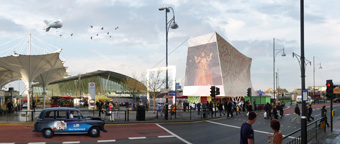
The Lift New Parliament as it might look in Stratford, East London
image AOC
The Lift New Parliament as it might look in Stratford, East London
lift new parliament
Lift has run a major architectural competition for a design for its New Parliament with a brief for a mobile structure that can hold hundreds of people and be used for performances, forums and broadcasting. The aim, says Wynne-Jones, is to place the structure near centres of power, like the British Parliament in London, where its very presence will say, “art is important.” And it can travel the country and the world. Designed by architectural practice AOC with engineers Momentum and Mark Prizeman, its “flexible membrane structure taking the archetypal form of a tent as its starting point”, the winning submission was selected by a jury from four anonymous short-listed designs (out of 56 entries) that were put to the public to have their say in an online vote. Wynne-Jones has written, “At the heart of this vision is…a new concept in performance space, where artists from around the world and the people of London can gather together to share stories, exchange knowledge, and imagine and rehearse new futures.”
constituency
Lift combines the local (East London), the national (via the tourable New Parliament), and the global (the Seekers). Long-term Lift staffer Tony Fagan is coordinating the involvement of East London communities, while the Seekers consult with their own. The Seekers met in London in May 2006 and will meet again in March this year as well as consulting online. The ultimate goal, says Wynne-Jones, is “to have Lift owned by the community by the 2012 London Olympics.”
On the local front, Lift is engaging with local boroughs and their “regenerative agendas.” To do that, says Wynne-Jones, the organisation “has had to learn the language: it was an artificial hoop to have to jump through.” Clearly, having to deal with local government and to seek funds beyond the Arts Council of England (Lift’s principal funder) is a major challenge. When we met, Wynne-Jones was by no means certain that Lift could achieve the financial goals that it had set itself. But, she said, “regeneration is vital for these communities: it is urgently needed or disaster lies ahead.”
Similarly Wynne-Jones sees it as vital that artists face the challenges of their world. Lift’s role, she says emphatically, is “to create context, to move closer to the things we fear…and to have a voice.” The New Parliament will provide a place for that voice, and hopefully its realisation will encourage potential sponsors to give, but also to enter the parliament themselves.
seekers
Asked about the choice of the term ‘Seekers’ for Lift’s collaborators Wynne-Jones explained that it “came from a desire to get away from overly academic associations with the term ‘curator’ in the visual arts world and the product oriented ‘programmer’ in performance. I have read Harry Potter, but it wasn’t a direct crib, I promise.” However, she reveals, “‘New Parliament’ is proving very unpopular with all the collaborators in East London, testament to disappointment with New Labour and indicative of voter disengagement—in the UK you don’t have to vote, so most people don’t. When the parliament does open it may well be called something else. But whatever it’s called—suggestions welcome—it will be a physical embodiment and tangible experience of peoples’ desire and capacity to engage with each other, with theatre—in its broadest sense—and with the things that matter to us most, locally and globally.”
taking it to the streets
To light the flame of its vision, Lift collaborated on a large scale public theatre event for four days in May 2006, a visit to London by The Sultan’s Elephant, a massive human-operated pachyderm created by Frances’ Royale de Luxe mechanical marionette street theatre company. Lift involved primary and secondary school students, young and emerging artists in the event, contributing objects, letters, drawings and photographs about their particular part of London or the UK. These then travel with the elephant around the world. The event also included a day of conversation, “How many elephants does it take…?”, at the South Bank Centre to explore how creative people and city infrastructures can collaborate to change the way the city is experienced.
For Wynne-Jones the estimated million people who turned out to see the elephant confirmed the need for a new public space. At the time she said: “Almost a year on from the bombings of July 7 2005, the people of London came together to celebrate and share an experience, eager to interact with each other and to be in a public space together. We saw a different London and were filled with a great sense of ownership which enabled a generosity between us. The sheer joy and enthusiasm with which the elephant [was] greeted suggests a tremendous need for a space that allows us this freedom to come together more often. One of those spaces is the Lift New Parliament.”
seekers meet
Wynne-Jones said that the meeting of the Seekers happened at the same time as the visit of The Sultan’s Elephant: “We wanted them to experience London at its most animated…We left our intense discussion many times to participate in this reclamation of the city by its citizens.” At this meeting, “the Seekers heard from us about the proposed Lift New Parliament…Inevitably we talked about money and risk. Participation is at the heart of the process and we invited the Seekers to share their experience and understanding of participative work from their very different contexts and asked if audiences can be turned into or should be participants.
“Much of the discussion centred on how individual and collective identity is constructed, how relevant that was to us now, how much of it was constructed from our individual and national histories. Questions arose to do with whether there is a sense of identity that is common to all, irrespective of context or geography. In our dreamings of the space of the Lift New Parliament as a place of cultural equity we talked about what might need to be given up, what needed to be held onto, what protocols we might establish, whether we needed a constitution.
“The Seekers spoke of their understanding of their role and how they inhabited it….They range from artists, initiators and creators to prospectors, prophets, transformers and revolutionaries to messengers and catalysts. Simply put, we got to know each other.”
next
Asked about the stages leading to Lift 2008, Wynne-Jones explains it will entail further testing of the Lift vision and the first presentations towards programming. “We begin our next meeting in March 2007 with a gathering of the Seekers along with politicians, scientists, cultural commentators and academic theorists to think about the context that we are operating in and the potential for change. Exploring the question ‘How do we live?’, we’ll use Open Space Technology (www.openspaceworld.org), a self organizing meeting and discussion tool which we hope will become one of the meeting protocols within the Lift New Parliament, to make visible the landscape we are operating in and unearth its spiritual and philosophical underpinnings as a prelude to the Seekers’ presentation of the projects they have selected.
“By the time the Seekers leave seven days later we will have a fabulous palette of proposals from existing work, new commissions and linking events between the international work and UK-made work. These will have been discussed with the programmers from our partner venues. What remains is for Lift to raise the funds to produce and present the work. The production process begins in the Autumn of 2007, with a 10-month run up to the festival and the launch of the Lift New Parliament.”
opening parliament
Wynne-Jones is programming “a number of trailblazer events leading up to the opening. These will be created by international artists in collaboration with communities and are indicative of the kind of projects we imagine will happen in and around the Lift New Parliament. In Eat London, a collaboration with Spanish artist Alicia Rios and 300 community members will create a giant three dimensional city made entirely out of food to be eaten on one glorious day by London’s citizens. Auckland’s dance company Mau, will stage Requiem [originally commissioned by Peter Sellars for the New Crowned Hope Festival in Vienna in 2006 to mark the 250th anniversary of Mozart’s birth] at the South Bank Centre, and Stan’s Café from Birmingham will create the largest artwork made of rice in the world [the company appeared in the 2006 Melbourne International Arts Festival], in which every living person is represented by one grain.
“The festival, with the Lift New Parliament as its heartbeat throughout June 2008, will begin in Stratford [East London] in collaboration with our partners. The parliament will then be packed up and transported along the river by boat and travel to the South Bank Centre. Alongside the commissioned program within the Parliament itself, there will be debates, celebrations and an exchange of ideas through a whole range of mediums, between international artists, local residents, cultural commentators, politicians and local, national and international audiences. That’s not forgetting singing, dancing, eating, and generally having fun!
“The final design for the parliament will go public in June this year and then it will take a year to tender and build it, test and open it!”
Lift’s Seekers
Caroline Calburn, theatre artist, Cape Town, South Africa; Jeremy Deller, artist, curator, London, UK; Ishrat Nishat, theatre artist and critic, Dhaka, Bangladesh; Oby Obyerodhyambo, playwright, director and writer, Nairobi, Kenya; Jonathan Parsons, director Brisbane’s Riverfestival, Australia; Roma Patel, interactive media and theatre artist, Nottingham; Menno Plukker, theatre , dance and festival producer, Montreal, Canada; Lemi Ponifasio, theatre artist, artistic director of MAU, Auckland, New Zealand; Dawn Reid, theatre director, London; Fabio Santos, teacher, choreographer, arts project coordinator, London; Jenny Sealey, multisensory theatre artist in disability arts, London; Subathra Subramaniam, dancer-choreographer and biologist, London; Lone Twin—Gregg Whelan and Gary Winters, writer-performers, directors, Brighton and Glasgow; Prasad Vanarase, theatre artist, Pune, India; Wen Hui, choreographer, Beijing, China.
Lift, www.liftfest.org.uk
RealTime issue #77 Feb-March 2007 pg. 2
© Keith Gallasch & Virginia Baxter; for permission to reproduce apply to realtime@realtimearts.net
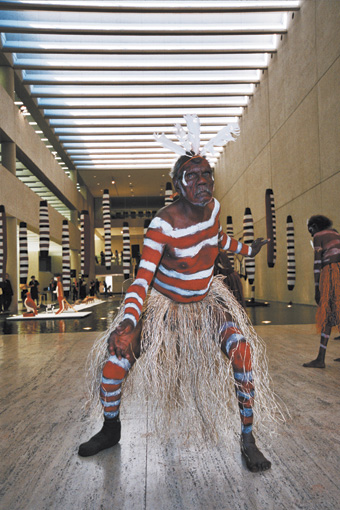
Arthur Pambegan, Jr., Aurukun Dancers
ALWAYS ONE OF AUSTRALIA’S MOST EAGERLY ANTICIPATED MAJOR VISUAL ARTS EVENTS BECAUSE OF ITS UNIQUE CULTURAL AMBIT AND THE PROFUSION OF UNFAMILIAR COLOUR, STYLE AND POLITICS THAT COME WITH IT, THE ASIA PACIFIC TRIENNIAL OF CONTEMPORARY ART (APT) WAS DOUBLY WELCOMED IN ITS FIFTH INCARNATION.
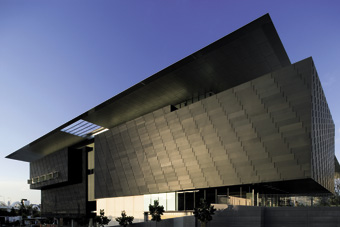
Gallery of Modern Art
The occasion for joyous and epic celebration was the opening of the magnificent five-level grand pavilion-like Gallery of Modern Art (GoMA). The superb architecture by Kerry and Lindsay Clare of Sydney firm Architectus speaks for itself with its grand halls, incredibly high ceilings, a multitude of intimate spaces, ultra-comfortable steeply raked cinemas, views within and out over the river, and a plenitude of natural light. For the artworks it is the most accommodating of Australia’s major galleries, uncluttered and offering, for example, a whole wall in APT5 to one magical work by Anish Kapoor. The wall height alone in the major spaces offers artists and curators some wonderful opportunities.
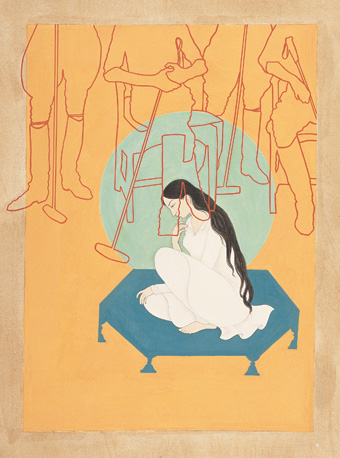
Nusra Latif Qureshi, Justified behavioural sketch 2002
It’s a mere 150-metre walk to the Queensland Art Gallery, taking you past more impressive architecture in the form of the new Queensland State Library, a facility blessed with state of the art screen and computer facilities, luxuriously furnished and very welcoming. The QAG maintains its charm with a touch of refurbishment including a new wide glass entrance facing GoMA. QAG will now focus on art up until the 1970s.
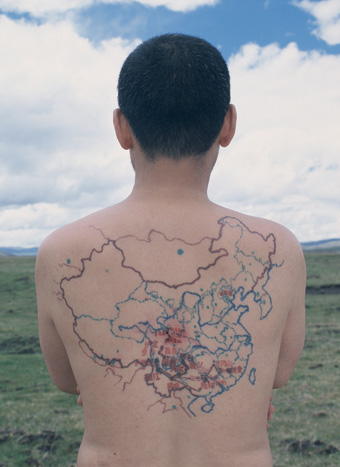
Qin Ga, The miniature long march (detail) 2002-05
courtesy The Long March Project,
Qin Ga, The miniature long march (detail) 2002-05
APT5 features 37 artists and two large scale collaborations (Long March Project, China; Pacific Textiles Project). The Long March Project is an APT5 centrepiece, a profoundly fascinating re-tracing of Mao’s 1934-5 journey undertaken by a number Chinese artists, a selection represented here, with works created at key sites (www.longmarchspace.com). Performance artist Qin Ga’s Miniature Long March was tattooed on his back as the journey unfolded. You are welcomed to the project by Wang Henhai’s two huge grey statues of Mao, side by side: Mao as Communist Party Chairman, Mao as Emperor of China. There are no illusions in the Long March project although plenty are played with. Zhou Xiaohu’s Utopian Theatre, an engrossing large scale fantasia of rallies and media surveillance with a mass of clay figurines (the artist is also an animator), sound score and video imagery evokes societies both democratic and totalitarian. There is much else to admire in the Long March Project drawing on traditional art practices with thoroughly contemporary energy and insight.
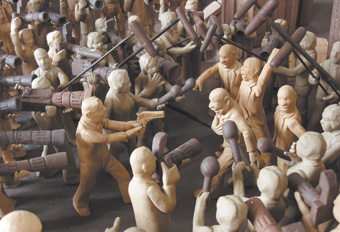
Zhou Xiaohu, Utopian theatre (detail) 2006
courtesy The Long March Project, Beijing
Zhou Xiaohu, Utopian theatre (detail) 2006
Throughout APT5 there is ample evidence of art realised through meticulous craft, delicacy and great labour from the Pacific Textile Art Project to Sangeeta Sandrasegar’s (Australia) exquisite wall-based, shadow throwing fine cut-outs of hands or her images of feet with their erotic contemporary detailing, or Nusra Latif Qureshi’s (Pakistan, lives in Melbourne) subtly ironic Mughal miniatures, Fiona Hall’s American paper money birds’ nests, Anish Kapoor’s (UK) deeply immersive wall sculpture, Justine Cooper’s eerie Saved by Science installation or Eko Nugroho’s rebellious surreal humanoids (a giant one looms over you in GoMA’s main entrance). And many more besides. APT5 is a rich visual feast with some performative elements if not quite as extensive as in previous APTs. QAG and APT have always provided well for children and APT5 is no exception.
APT5, GoMA and QAG are generous and accessible. The planning and deployment of the new building is considered and visionary, recognising the mutual needs of artists and audiences. The opening was a wonderful celebration of this. In RealTime 78 we’ll publish a full review of APT5. RT
The 5th Asia-Pacific Triennial of Contemporary Art, Queensland Art Gallery and Gallery of Modern Art, Dec 2, 2006-May 27, 2007; www.asiapacifictriennial.com
RealTime issue #77 Feb-March 2007 pg. 8
© RealTime ; for permission to reproduce apply to realtime@realtimearts.net
IN MARCH TASMANIA WILL ONCE AGAIN WELCOME ARTISTS AND COMPANIES FROM ISLANDS OF ALL SIZES AND OTHER REMOTE AND NOT SO REMOTE PLACES TO TEN DAYS ON THE ISLAND, ONE OF AUSTRALIA’S, AND THE WORLD’S, MOST IDIOSYNCRATIC ARTS FESTIVALS.
<img src="http://www.realtime.org.au/wp-content/uploads/art/2/276_kg_tendays_comp.jpg" alt="Bikini Islanders receiving gifts of chocolate
from US military personnel as a “sweetener”
to their forced evacuation in 1946, ©Smithsonian Institute;
Linda Mancini as a contestant in the “Bikini “>
Bikini Islanders receiving gifts of chocolate
from US military personnel as a “sweetener”
to their forced evacuation in 1946, ©Smithsonian Institute;
Linda Mancini as a contestant in the “Bikini
© the artist
Bikini Islanders receiving gifts of chocolate
from US military personnel as a “sweetener”
to their forced evacuation in 1946, ©Smithsonian Institute;
Linda Mancini as a contestant in the “Bikini
They’re coming from Cape Verde, Sardinia, Ireland, Newfoundland, Manhattan, New Zealand, Japan, Taiwan, Canary Islands, Denmark and the Torres Strait. Here’s a good-looking selection from the large program of acclaimed visiting works and new creations from local artists. RealTime will also be there with an intensive review writing workshop, so watch out for responses to these and other works as they go online at www.realtimearts.net.
the corn exchange, dublin by lamplight
In their first visit to Australia, this award-winning company, described as “a renegade version of Commedia dell’Arte”, present theatre magic and tough politics in the Dublin of 1904.
benjamin bagby, beowulf
In the bardic tradition, accompanying himself on six-string lyre and reciting in Old English (with Moden English surtitles), Bagby delivers a big chunk of the beautifully grim, 1000 year-old epic about the battle between a warrior and a monster.
gruppe 38, the little match girl
Denmark’s award-winning children’s theatre company perform the four-hanky children’s tale featuring three performers and innovative deployment of gadgets, projections, music and paper.
dream masons
In RealTime 72 p40, Sue Moss interviewed the makers of this new work at the first stage of their coming together. Dream Masons transforms the façade of the Salamanca Arts Centre into a theatrical spectacle in a work about survival replete with 100 Tasmanian performers, musicians, artists and technicians. Created by Jim Lasko (Chicago), Jessica Wilson (Hobart) and Joey Ruigrok Van Der Werven (Sydney).
is theatre, queen of the snakepit
Fourth generation Flinders Islander, Cheryl Wheatley performs a theatrical collage of island life in “a portrayal of longing, endurance, strength and solitude staged cabaret style in the island’s infamous ladies lounge, the Snakepit.” Deviser-performer Cheryl Wheatley, writer Finegan Kruckemeyer, director Tania Bosak, designer Greg Methé.
linda mancini, bikini
Manhattan Bessie Award-winning performance artist Linda Mancini’s one-woman play juxtaposes the destruction of the mid-Pacific Bikini Atoll by US A-bombs in 1946 with the French creation of bikini swimwear. The impact on islanders and women, respectively, is played out with slapstick and black humour.
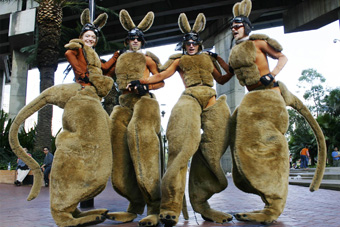
Roo’d, Icarus Performance Troupe
icarus, roo’d
Leaping two metres in a single bound, these giant kangaroos evoke at once a prehistoric Australia and a genetically engineered future, old rural toughness and urban brashness. “Always ‘Roo’d’ but never offensive”, they promise.
hsiao hsi yuan puppet theatre
For connoisseurs of traditional puppetry, in this case with its roots in the spectacle of Peking Opera, this will be a must: the puppets perform routines usually only within the abilities of the humans they mimic.
the spectre of the rose
A return season of local performer and writer Robert Jarman’s much-lauded account of the Genet autiobiographical novel directed by Franz Docherty.
back to back, small metal objects
A not-to-be-missed, never-to-be-forgotten experience from Geelong’s Back to Back played out in the street by performers and passersby in a stark tale of affection and corruption [see p39].
ihos music theatre: a thousand doors, a thousand windows
Inspired by WH Auden’s Twelve Songs, this is contemplative multimedia music theatre for soprano (Xenia Hanusiak), projections (Cazerine Barry) and a score by Constantine Koukias, staged in the beautiful early stone barn at the newly remodelled Rosny historic site.
ricky maynard, portrait of a distant land
Based on his Indigenous family background, leading Australian photographer Ricky Maynard’s new work responds to landscapes and oral histories and will appear on billboards around Tasmania.
leigh hobba: tasmanian landscapes in video and sound
Video, performance, installation and sound artist Leigh Hobba is celebrated at the Tasmanian Museum & Art Gallery in the first major survey of his work and focusing on his response to the island, 1980-2007. The exhibition includes Blues, a collaborative performance with dancer Wendy Morrow. Curator Craig Judd.
tasdance: mercy: a dance for the forgotten
In the festival’s first international co-commission, Mercy explores imprisonment and death in Tasmania’s convict past and in repressive regimes around the world. The choreography and conceptual design is by New Zealand innovator Raewyn Hill.
For more theatre, music, visual arts and special events for the mind and not least the gourmand within, go to www.tendaysontheisland.com
RealTime will be reporting each day of the festival. Go to the features section for more.
Ten Days on the Island, March 23-April 1
RealTime issue #77 Feb-March 2007 pg. 14
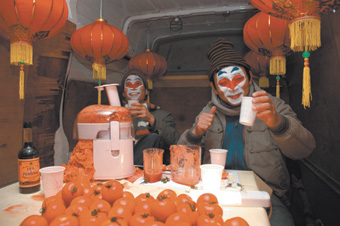
Mad for Real (Cai Yuan & JJ Xi)
photo James Champion
Mad for Real (Cai Yuan & JJ Xi)
GIVEN THE SENSATIONALIST REPORTING OF SOME OF THE MORE EXTREME EMANATIONS OF CONTEMPORARY PERFORMATIVE CHINESE ART (SUCH AS ZHU YU’S PURPORTED BANQUET OF FOETAL BODY PARTS), A FULL-SCALE FESTIVAL OF CHINESE LIVE ART CALLED VITAL ALWAYS CARRIED WITH IT THE VEILED POSSIBILITY OF AN OUTPOURING OF VISCERA AND BODILY FLUIDS. BUT IN THE EVENT, VITAL 06 AT MANCHESTER’S CHINESE ARTS CENTRE FOUND A POWERFUL PULSE WITHOUT RECOURSE TO BLOODLETTING.
Hong Kong artist Leung Po Shan set a contemplative tone in her opening durational performance, Hammering-In-Time. Illuminated by a single candle, a broken tree branch in the centre of the small studio space cast its looming shadow across the walls. In the gently flickering half-light, the diminutive figure of the artist, in a diaphanous gossamer skirt, attempted to nail down the shadow. Following the edges of the silhouette, Leung Po marked out the outline of the tree shadow in a trail of copper tacks, pursuing the shape with the aid of a ladder where the shadow crept over her head until it spilled out of reach across the ceiling.
Hour after hour, she tap-tap-tapped with a dainty hammer, the meditative rhythm interrupted only by the occasional plink of a tack slipping through her fingers to the wooden floor. Post-performance, the course of the shadow survived as a raised dotted line branching across the white walls in an installation viewable throughout the festival. The intangibility of light and shade had been temporarily translated into palpable metal. However, the broken outline hinted at the incompleteness of the picture: a metaphor for everything that is un-pin-downable in live art. From a lived moment, rich with human breath, flame-warmed in the wavering light and a room vibrating as echo dissolved into echo, all that remained was a scantly delineated after-image.
Gamine and slight-framed, with cropped hair, Leung Po also goes by the name of Anthony, thereby injecting a little gender ambiguity into her next multi-sensory performance, an intimate one-on-one interaction called Itchy Scratchy.
The pungent smell of eucalyptus and wintergreen seeps down the corridor. A glass bottle of Chinese White Flower Oil is slipped into my hand with the invitation to enter the studio and rub the embrocation into the artist’s body. Anthony Leung Po kneels naked, on a small wooden platform, staring straight ahead at the incoming visitor. The furled bloom of a white rose pokes out from her silent lips.
A mirror offers both a reflection of the artist’s slender back, and the incomer’s own awkward gaze. Feeling exceptionally ungainly and over-clothed, I drip a few drops of oil onto my palms and try to decide how and where to start anointing this boyish body. Tentative massage of a smooth brown thigh evokes an immediate response as the artist unfurls gracefully, bending to follow the touch, revealing toes tied together with red ribbon. A metronome ticks insistently by her side as a reminder of the present passing moment. I conclude my session too hurriedly, and sense too late that I’ve made the wrong choices, and haven’t allowed this encounter to play to its full flirtatious, sinuous, potential—damn, I’m feeling irritated with myself now. As Anthony takes the rose from her mouth and pins it to my jacket, I realise I’ve misinterpreted the performance title. Itchy Scratchy isn’t the action of the white flower oil on bared skin: it’s the tantalizing mental discomfiture of laying your hands on that proffered body, and all the niggling anxieties it incites.
VITAL interspersed new commissioned live work with a number of documentary presentations, showcasing artists from mainland China and across the diaspora. Patty Chang (USA) introduced films of herself sucking her reflection from a water-covered mirror and travelling to China to reconstruct a plywood and sponge cake Shangri-La. A weather-beaten He Yung Chang (China) reminisced about his days spent incarcerating himself inside concrete. Ying Mei Duan (China/Germany) hid behind a cupboard door whilst screening an intriguing set of performances: accident-prone in gawky dresses and over-sized glasses, sleepwalking, or stranded on top of a high wall, wriggling tummy-down like a stranded insect.
Marcus Young (USA), serene and monkish in pale floor-length robe, and carrying a huge sky blue umbrella, passed daily along Manchester’s busiest shopping streets, gliding at a snail’s pace and smiling beatifically amidst the urban bustle. Lisa Cheung (Hong Kong/UK) created a performative installation, filling the darkened gallery with a confusion of shadows. Kinetic lamps, part child’s nightlight, part lighthouse, flashed rippling texts around the walls—“water sinking…sinking water”. The familiarity of the words began to sink in—these were the last desperate phone messages of the 23 illegal Chinese immigrants recently drowned in the winter darkness while picking cockles in nearby Morecambe Bay.
Exuding menace, in the red and white face paint of legendary Chinese troublemaker the Monkey King, artist duo Mad for Real (Cai Yuan and JJ Xi) invited passersby to join them in the back of a white van. Armed with a juicing machine and a mountain of tomatoes, the pair slammed the van doors locked and held their human cargo hostage until enough tomatoes had been pulped and drunk. Just a few uncomfortable, airless minutes in which to contemplate the unimaginable horrors of an illegally trafficked journey to the UK.
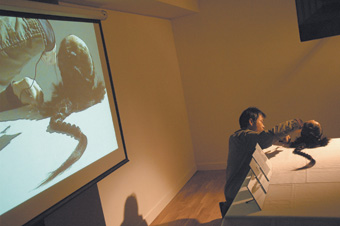
He Cheng Yao, Auction of Very Personal Possessions, bidder Cai Yuan
photos James Champion
He Cheng Yao, Auction of Very Personal Possessions, bidder Cai Yuan
He Cheng Yao (China) provided VITAL’s finale with an “auction of very personal possessions.” The nature of the lots on offer remained a mystery even as we queued to register for a numbered bidding card. A shiver of unease crept up on the crowd, jostled and crushed at the back of the room, peering round shoulders and under elbows, as we gradually made out the viewing table and the artist herself, utterly still, kneeling beside it. The event’s organiser, Sarah Champion, took to the podium as auctioneer and lit a tiny birthday candle. We would be bidding on He Cheng Yao’s hair, and the winner would be the last bid received as the flame went out.
A live video feed projected onto a big screen kept in view the ever-shrinking candle and He Cheng Yao with her head tilted uncomfortably backwards and her gaze tilted up, her hair braided into a long black plait stretched out behind her along the white tablecloth.
The severance of hair, whether involuntary or self-imposed is always a potent symbol, simultaneously evoking subjugation and sacrifice, modernity and emancipation. Here was a 10-year personal-history, 112cm of hair, offered willingly for sale, yet in a scenario that evoked an execution. At this time of meteoric escalation in the economic value of contemporary Chinese art, we were invited to question the role of the artist in the art marketplace. Auctions usually unite art objects and buyers without the inconvenient intrusion of artists. No need to think about the unpalatable lives that give rise to the works. He Cheng Yao’s performances are slow-growing and deeply personal. Her work has consistently drawn on intimate, often painful biographical experiences; they do not emerge lightly, and are not performed without emotional consequence. Was her hair just another decorative commodity?
While the ethical considerations of buying part of someone else’s body began to percolate through the room, along with questions about racial and gender power relationships and all the cultural and historical implications of hair-shearing…the first bidder was already marking out his territory with an assertively high offer. Participation in the sale had been swept imperiously out of most people’s reach. Heads craned to spot the big-money investor, and discovered artists Cai Yuan and JJ Xi bidding determinedly until emerging victorious to the tune of £325.
The Chinese-born, British-based duo have made a habit of intervening in other artists’ work since 1999: holding a pillow fight on Tracey Emin’s bed and pissing on Duchamp’s urinal. Was this to be another artistic hijacking?
Perhaps the high bidder was expecting simply to snip off the pigtail and hold it aloft triumphant, for Cai looked uncharacteristically gobsmacked to discover that, like Shylock, he was required to claim the entirety of his prize clean to the scalp. For ten long minutes, He Cheng Yao stared unflinchingly into the eyes of her new collector as he struggled to scissor his investment free. So whose was the crowning glory?
VITAL 06, Chinese Arts Centre, Manchester, UK, Nov 2-5 2006. VITAL 07 takes place October 2007. www.vitalfestival.org
RealTime issue #77 Feb-March 2007 pg. 4
© Judith Palmer; for permission to reproduce apply to realtime@realtimearts.net
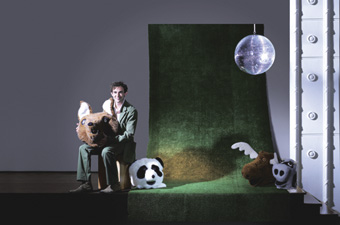
Michael Kantor
photo Garth Oriander
Michael Kantor
“When we stand at the edge of the sea, or lift a child high against the sky, or look deep into the eyes of another—with love or sadness or just pure fascination—we are giving ourselves leave to experience what is outside of time. This is precisely the gift of theatre. To give us the extended moment to know what we think and what we feel. It gives us leave to know the beautiful, the disturbing, the unspeakable strangeness of our selves.”
Michael Kantor, Introduction, Malthouse Season One ‘07
Artistic director Michael Kantor is in his third year with the company he and Stephen Armstrong transformed from Playbox into Malthouse. We met in Sydney to discuss the company’s first 2007 season and in particular how the company works, the kinds of theatre it embraces—from plays to intimate performative installations, music theatre and dance—and the aesthetic and political challenges for theatre as concepts of form, of ‘mainstream’ and aesthetics undergo significant change.
malthouse at work
While I’m technically the Artistic Director and Stephen Armstrong is technically the Executive Producer, we work alongside Catherine Jones who’s our Associate Producer and Maryanne Lynch, our Dramaturg in Residence. We’re all very involved in the programming. We can all bring things to the table to be considered. If one of us has seen a show that is interesting because of the particular artists in it or its writing, we quickly attempt to all see it to keep the discussion going. Sometimes this is hard when a lot of the stuff is interstate. But we think it’s important that there’s not a single voice or a single command system. So we work very collaboratively on each season. Of course, the lead-time means that many projects are decided a good 18 months ahead of their premieres. Then it becomes incumbent, particularly on Maryanne and myself, once something has been conceived or a project may have been commissioned, to see it through and to give as much feedback and follow through and help as possible.
Because of our limited resources we can’t really afford to commission a lot. We can’t do that kind of seeding, that ‘well-let’s-just-see’ kind of process, which I’d love to do because I think that allows for a different type of liberty for artists. But I’m finding that what we can do best is support work coming out of the Melbourne independent theatre scene, for those artists to grow into larger theatre spaces because if they don’t get the experience through Malthouse, they won’t get it at all. Then we’ll be in an awful position in 10 or 15 years where there will be no artists who have the training to conceive and understand what it means to put a large show on in a large space. So we like to give opportunities to those artists but also to expose audiences to work which I think is leading the theatre into a new and exciting territory.
whose theatre?
I had to make a choice quite early on. Was this going to be the Michael Kantor Theatre Company, which was an option. The board were quite willing for me to do that. In that guise it would have been four shows a year from Michael Kantor and collaborators, with two or three other things. But I thought, with a lot of consultation, that would be an inappropriate use of this resource—this fabulous theatre building that is really important in the ecology of Melbourne theatre [as] a crossover point for artists to be able to merge with what one may call the mainstream. But the mainstream in itself is indefinable now. It’s changed. So, it’s really about achieving a point of professionalism for artists that leads to greater visions, greater dreams being reached on stage and greater audiences for that work. While the Melbourne independent scene is booming, it’s booming to small audiences. Shows sell out to 60 people a night. And that’s great but we need those artists to be exposed and creating work that can attract 200 people and then 300 and ultimately 500, and fill the Merlyn. Now that’s a struggle for anyone, I might say, at the moment. But it has to be like that because it’s not actually sustainable on a small level—not if those artists want to work all their lives in the theatre.
There are about three or four new commissions a year. There’s no time-line for when they’ll be realised although there’s a broad belief that if it’s taking more than two years to get to the stage there might be something wrong and we’d better think about it. In some cases, a work may be quite well formed. It just needs the injection of rehearsal time, which can be short actually. Some shows have had ‘boutique’ seasons in Melbourne’s smaller spaces, so we invest to bring them to a level and scale that can work in the theatre we’re proposing for them. And hopefully this way we allow those artists to further develop the work and refine it and see it complete, or as complete as theatre can ever be. A lot of these works are small; a lot are solos. Some are four-handers. It’s been rare that we’ve been able to invest in anything larger than that. I dream of a day in which it is possible that a great Chekhov production or a new work created by a group of artists in a warehouse can be taken up, professionalised and attract 500 people a night. Be it a Chekhov or a new work, I don’t have a big hang-up about how many shows are ‘new’, how many are ‘reinventions.’
Right now The Tower is the most likely venue for our support for independents, for financial reasons, although in our first season for 2007 we have The Pitch, Peter Houghton’s very funny solo in the Beckett for the Comedy Festival. It’ll do very well and it can work in that theatre. And Uncle Semolina and Friends will perform OT in the Beckett too. Nowadays there are more options for independent artists through FULL TILT at the Arts Centre, Arts House at North Melbourne Town Hall and what we’re doing at Malthouse.
the director directs
In my first year here I did three plays, the next year I did two. This year I’m only going to direct one. But I have plans for about seven in 2008! But that can’t happen. I think three would be the maximum and they can’t all be large. That’s to do with our finances but also to make sure that I’m accessible and not just in a rehearsal room all the time. Artists find conversations, even if they don’t lead to work with us, are important. We like to keep the door open. We have a process where anyone can submit anything as long as they’ve had a professional engagement of some sort and they can describe their work in two pages.
the german connection
One of our dreams for 2008 is a new work by writer Marius von Mayenburg and director Benedict Andrews [Andrews directed von Mayenburg’s Eldorado for Malthouse in 2006, RT 74, p42]. It’s dependent on a certain amount of funding which is currently beyond us, but we’re very hopeful. We’re simply calling it “The Secret Project” at the moment. Benedict and Marius spent a few weeks last year working on it with a great group of actors. We hope to extend and develop that process over this year. I’ll be able to say more in about a month. But I’m very keen to continue our collaboration with Benedict Andrews: he’s a fabulous director and it’s very important that Melbourne gets past its, “Oh, that’s just some Sydney director” parochialism—it means nothing. He’s just a fabulous director.
open to all the senses
Theatre can work so well as a simple voice under a spotlight in a darkened room, but it’s not the only form and it’s not the form that gets me closest to my subconscious, which is where I want to go. I always worry about the writer’s preoccupation with the word and its central focus in theatre. It can be. But it’s not the only way. I believe that theatre needs to be open to all the senses especially through potent visual imagery. The backhand response can be that such work is overproduced or ‘all style, no substance.’ To me that’s discounting the potency of the image in the first place. As if it had only ever meant to be there as wallpaper for the actors.
catharsis optional
There’s an assumption that every strong piece of theatre will take you on an emotional journey that will be cathartic. It’s a rear-guard action that Melbourne keeps throwing up at me: ‘Where’s the catharsis? Where’s my big, you know, my tearjerking moment?’ Theatre is about rhythms, that’s where a director’s vision or voice or collaborative process with others can be so distinctive. Benedict Andrews has a completely different sense of stage time to me. So do Barrie Kosky and Neil Armfield. I’m always beguiled by it. Mine’s very short, I should say. It’s like bang, bang, bang. Whereas I’m so impressed by the kind of control that can come from slowing time down and allowing that space of dream to open up for an audience. Robert Wilson does it—not always but sometimes fantastically.
outside ourselves
I’m not a great lover of theatre that reminds me of who I am, really. I prefer to be shocked, to imagine that I’m a little bit like something else. A lot of theatre has traditionally, particularly in Australia, attempted to show us ourselves simply, confirming our sense of ourselves. And I’m not convinced we need any more confirmation of ourselves as content and calm, fair and balanced, when clearly we’re not.
one day an ensemble
A company can have so many different ways of being. And there’s a great other model, which is the ensemble model. Ultimately, if I can’t achieve it at the Malthouse, one day that’s what I want. I want to work with an ensemble of actors and creative collaborators on a body of work. Barrie Kosky and Tom Wright’s The Lost Echo (RT 76, p36) would not have happened without the Sydney Theatre Company’s Actors Company. They needed to have worked together in the six months leading up to the work with Kosky for it to get anywhere close to where it got, which was a great distance. You would never expect a string quartet to play a concert without having rehearsed together for nine months. And like finely tuned instruments, actors need that. They feed off working together. In the meantime and for the first time at Malthouse we’ve added to the number of artists working daily with the company by having designer Anna Tregloan and lighting designer Paul Jackson as artists in residence. They’ll work on shows and get to understand the budgeting process and all of the rigour that needs to take place to make a theatre company work. They’re people who might one day want to run a company.
<img src="http://www.realtime.org.au/wp-content/uploads/art/2/280_kg_malt_black.jpg" alt="Black, Anna Tregloan, collage
with text excerpts from the Black Dahlia”>
Black, Anna Tregloan, collage
with text excerpts from the Black Dahlia
courtesy of the artist
Black, Anna Tregloan, collage
with text excerpts from the Black Dahlia
first 07 season
Like all our seasons, I hope there’s something old, something new, something borrowed, something blue. There’s a sense of bricolage about it. You’re not going to see six like-minded events.There is no unifying theme, but all these projects seem to sit perfectly together—they’re wry, they’re whimsical, all quite quirky in spirit—some of them unsettlingly so. Deep inside, all plays are united by a sense of paranoia and a fear of death. They’re also strongly fuelled by a libidinous urge, that’s theatre—the theatre that I like.
It felt like a strong, simple, bold first choice to open the season with Tom Healey directing Melissa Reeves’ The Spook, about Australia and Communism in the 50s. It cried out to be performed in Melbourne, and while ASIO is out there recruiting ‘spooks’ right now. It’s an interesting moment, a merging of our paranoia about terrorism simultaneously with paranoia about the dangerous words of the artist. Up in the Tower Anna Tregloan’s making a performative installation piece, Black, around the very gruesome Black Dahlia story told by James Elroy. She’s exploring themes around the female body in relationship to glamour and the hard boiled detective narrative but all fused in Anna’s special way with fragments of text. For me she’s designed The Odyssey and The Ham Funeral—big plays—but her mind is much more active than that and she’s simultaneously been doing durational installation works (RT 57, p40). Black runs for three hours but you can come and go, watch and read. The performers include Caroline Lee and Moira Finucane and the lighting is by Paul Jackson.
Ionesco’s Exit the King is the big show in the season. Three years ago I read it with Geoffrey Rush and we both agreed it was fantastic and he said he’d actually read it with Neil Armfield so a conversation developed and now it’s a co-production with Company B with a great cast: Bille Brown, Julie Forsyth, Gillian Jones and David Woods who’s from Ridiculusmus, the fantastic English avant-garde comedy group. We follow up with OT (as in Old Testament). Uncle Semolina (& Friends) is a wonderfully inventive and intriguing group who did a series of works initially in a shopfront and have worked a lot with puppets, dolls and toys but doing elaborate, unsettling, big, mythic stories with them. That grew into a piece called Gilgamesh, which was very successful and is going to The Barbican in London. We commissioned OT from them last year. Christian Leavesley and Phil Rolfe have devised a piece that has a little tribe of Israel, a very jealous God (performed by Peter Snow) and it’s performed on a very simple, strange set. What I love about their work is the enthralling sense of miniature. There’s also Chunky Move’s Tense Dave in a return season—it was one of the favourite shows I’ve worked on as a director.
inspirations
In the third year of the company I always think we can do better. We’ve planted a lot of seeds and they’re growing. Some need a lot of watering. Some of them will be beautiful and some will wither. That’s what keeps me going, the conversations that surround the creation of a work of theatre. But I also get a thrill like no other when a performance works. And particularly when you’ve been involved in helping collaborate with a group of artists to get it there. I’ve got three kids—six, nine and eleven. They keep you going because there are times in life when work just has to stop. There’s just no chance of that conversation continuing when really there’s something much more interesting taking place on a trampoline. That’s really good for me.
* * *
Michael Kantor’s enthusiasm for innovative Melbourne theatre and the Malthouse vision is palpable, energetic and eloquent (a trait he shares with the likewise lanky and indefatigable Stephen Armstrong). Long may Malthouse seed and grow.
Malthouse, www.malthousetheatre.com.au
RealTime issue #77 Feb-March 2007 pg. 10
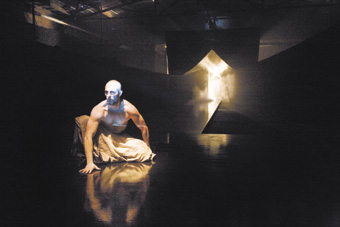
Alan Knoepfler, The Damask Drum
photo Kat Soutar
Alan Knoepfler, The Damask Drum
LIMINAL THEATRE’S THE DAMASK DRUM IS THE SECOND OF DIRECTOR ROBERT DRAFFIN’S INVESTIGATIONS INTO THE WORKS AND WORLD OF JAPANESE WRITER YUKIO MISHIMA. HERE, DRAFFIN AND HIS COLLABORATORS HAVE CREATED A NIGHTMARE FROM WHICH I DIDN’T WANT TO WAKE: A VISION WITH AN EXCORIATING EMOTIONAL BLEAKNESS VERGING ON THE UNBEARABLE, BUT REALISED IN SUCH AN ASTONISHINGLY ORIGINAL AND COMPLETE WAY THAT I COULDN’T HELP BUT BE TRANSFIXED.
Mishima’s story, adapted from a Noh play by one of the form’s originators (Zeami), is of a narrative simplicity that belies the deeper emotional resonances it eventually generates. A man, Iwakichi, is tricked by a cruel woman who gives him a drum and tells him that, should he beat it loudly enough that she hears it from her bedroom, she will be his. The drum’s skin, he discovers, is made of damask, and no matter how hard he beats it no sound can be produced. Despairing, he kills himself but the weight of his anger and desire transforms him into a demon, the literalisation of the woman’s crime, haunting her for all eternity.
It is through the stunning precision of both production and performance that The Damask Drum sounds so loudly for its audience. Light is tangibly, if sparingly employed to both illuminate and limit our senses. Beginning in near total darkness the imposing figure of Alan Knoepfler, a naked and muscular torso emerging from a cloud of billowing skirts, slowly seems to coalesce before us. A pale wraith writhing, seething, spitting his story and gripped by forces beyond our ken, he holds our focus with an almost alarming vocal and physical confidence. The unfolding tragedy he relates is scored by Jethro Woodward’s effects-laden live guitar, like a heavy and mordant Neil Young on a very bad trip, and elliptical and uncertain snatches of grainy film drifting across suspended panels.
When the object of the ill-fated Iwakichi’s desires finally joins him in his half-death, she comes as the kind of oni or spirit entirely appropriate to Japanese mythology, her kimono eventually expanding to cover most of the visible playing space, an ogrish empress who has become, very literally, her victim’s world. But his haunting subsumes her, too, and the endless dance of death and yearning between the two makes for unforgettable theatre.
requiem for the 20th century
The scale of ambition behind Theatre @ Risk’s Requiem for the 20th Century is either its triumph or its unmaking, depending on where you stand. In a sense, any project which seeks to survey and represent an entire century (or even, in this case, only its first half) is a monumental folly. But I found in this case a work whose internal logic seemed aware of its own insufficiency, and which utilised this as a source of motive power.
There are two competing narrative forces driving the work. The first is a love story in the classic realist mode: Cassandra and Red, kept apart by history’s vicissitudes, personal failings and tragic misunderstandings, chart a course that ends in a small moment of reunion by telephone across the oceans.
Against this narrative, driven as it is by the logic of conventional drama, is the historiographic stream of the work, which seems to work against it. Requiem doesn’t engage in capital-H history as an exercise in sense-making, producing a narrative development to very real events matching the fictional drama. Instead, it offers history as iconic moments with little, well, point. Figures from Archduke Franz Ferdinand to Walter Benjamin, along with Brecht, Hitler, Rasputin, Dali, Nellie Melba and many others crowd in only to disappear as quickly. It’s history as catalogue, not story. They’re shown, but not explained. They’re often cartoonish or badly drawn. Which, to me, seems an aesthetically appropriate choice.
History-making, as any half-alert Australian is aware, is an ideological practice, and in choosing a kind of picaresque, even carnivalesque approach to history, Requiem problematises such official histories without denying the possibility of historical understanding. It’s a deeply dissatisfying work, in this way, setting itself a task it cannot achieve; and this is exactly its strength.
apolitical dance
Not Yet It’s Difficult’s most recent work seems diametrically opposite to Requiem. Where the latter work is a taxonomy of historical detail that revolves around a hollow centre, NYID’s Apolitical Dance is abstracted to the extreme. It purports to examine the effects of conservative power on real bodies, but it does so in a purely physical, decontextualised manner. The performers are bodies without identity, in a space without location or time. They are beaten or electrocuted, they march drills, they dance to moronic music, they abuse themselves and each other. But unlike earlier NYID productions, the work doesn’t add up to more than the sum of its parts.
Some elements seem recycled from earlier works—the extended sequences in which performers throw one another head-first into large padded panels was employed to far greater effect in the company’s exquisite Blowback from 2005. Where that piece was a complex and imaginatively assured meditation operating on numerous ontological levels, Apolitical Dance seems rarely to connect itself to anything beyond the moment of performance. Or it does so in a disappointingly restricted way. I found the final sequence, in which a game of Aussie Rules football is enacted while a Nazi anthem provides a musical backdrop, almost laughable. Perhaps, given the work’s title, this is all intended: movement as an ironic retreat from politics. Then again, given the company’s history of highly sophisticated and engaging work, I expected a little more. (See also Christopher Scanlon, “Lost in Translation “, p43.)
for samuel beckett
I’ve long been a bit of a skeptic when it comes to productions of Beckett; not that I dispute the mastery of his rich and very entertaining writing, but it seems his legacy has often been so strong as to offer a hindrance to new, more relevant forms of theatre. The milieu of Beckett’s postwar Europe provided the fundament for a mode of writing which commented on the world in new and urgent ways, but that Beckettian silence and all it entails seems less appropriate now that it has become canonical. I’m all for messy, polyphonic theatre, which says too much rather than too little, which forges through postmodern chaos rather than looking back to the cresting wave of High Modernism which is Beckett.
Eleventh Hour Theatre’s For Samuel Beckett is as fine a production as I’ve seen. The bulk of the evening is a performance of Endgame, preceded by a series of texts which either inform or were informed by Beckett’s developing aesthetic (a reading from Joyce’s Ulysses; a Bach violin solo; a Buster Keaton film he penned entitled One Week). But these contextualisations don’t really add to the evening in a vital, necessary way. Interesting, but more along the lines of Further Reading or a disc of DVD extras. It’s a relief that the ensuing Endgame is of such an impressively high calibre. The cast, especially Peter Houghton as Hamm, are all able to draw out the subtlest connotations of the writing. Best of all is the way directors William Henderson and Anne Thompson have keyed up the comedy in Beckett’s writing, which is often dependent on finding a rhythm much snappier than that usually effected by those distracted by the pauses.
Eleventh Hour have forged an outstanding reputation for keen-eyed adaptations of classics, and with the exception of the seemingly extraneous additions bookending the evening, this Endgame had me thinking that perhaps there might still be many reasons to pay Beckett that occasional visit.
The Damask Drum, text Yukio Mishima and Zeami, adaptation, direction Robert Draffin, sound design Jethro Woodward, performers Alan Knoepfler, Mary Sitarenos, film Ivanka Sokol, Liminal Theatre, Abbotsford, Melbourne, Nov 15-26; Theatre @ Risk, Requiem for the 20th Century, Volume 1, writer Tee O’Neill, director Chris Bendall, set & costume design Isla Shaw, sound design Kelly Ryall, lighting design Richard Vabre, musical director Victor Bizzotto, New Ballroom, Trades Hall, Melbourne, Nov 17-Dec 3; Not Yet It’s Difficult, Apolitical Dance, direction David Pledger, Arts House, Meat Market, North Melbourne, Nov 28 – 2 Dec 2; For Samuel Beckett: Endgame, writer Samuel Beckett, directors William Henderson, Anne Thompson, Theatre, Fitzroy, Nov 25-Dec 9, 2006
RealTime issue #77 Feb-March 2007 pg. 41
© John Bailey; for permission to reproduce apply to realtime@realtimearts.net
<img src="http://www.realtime.org.au/wp-content/uploads/art/2/283_reck_matasaburo.jpg" alt="Yusuke Mori, Yoshinao Kobayashi,
Masayuki Sato, Hidekatsu Yamamura,
Chiaki Kato, Matasaburo”>
Yusuke Mori, Yoshinao Kobayashi,
Masayuki Sato, Hidekatsu Yamamura,
Chiaki Kato, Matasaburo
photo Anton Honda
Yusuke Mori, Yoshinao Kobayashi,
Masayuki Sato, Hidekatsu Yamamura,
Chiaki Kato, Matasaburo
THE FIRST SIGNS OF A DANGEROUS DRAMATURGY IN SHINJUKU RYOZANPAKU’S MATASABURO—ANGEL OF THE WIND EMERGE WITH THE APPEARANCE OF SEVERAL KAMIKAZE PILOTS SITTING IN A CLASSROOM AT A FLIGHT INSTRUCTION SCHOOL. THIS SILENT MILITARY PRESENCE AND THE SUGGESTED FUSION OF CONTEMPORARY JAPANESE SOCIETY WITH THE WARTIME RUPTURES OF ITS RECENT PAST IS REMINISCENT OF THE PLATOON IN POLISH AUTEUR TADEUSZ KANTOR’S WIELOPOLE WIELOPOLE. BUT PLAYWRIGHT KARA JURO (CREATOR OF JAPAN’S RADICAL RED TENT THEATRE) AND DIRECTOR KIM SUJIN ARE LESS INTERESTED IN THE INTIMACY OF THE PERSONAL-POLITICAL AND MORE INCLINED TOWARDS CONVEYING THE KALEIDOSCOPIC PATHOS OF CONTEMPORARY JAPAN’S EAST-WEST SCHIZOPHRENIA. EXPRESSED VIA A COMPLICATED NARRATIVE It THREATENS TO BRING THE PERFORMANCE CRASHING TO THE GROUND.
The Shinjuku Ryozanpaku ensemble embodies ‘Angura Engeki’ (underground theatre). Its twin characteristics of ‘kerenmi’ and ‘kabuku’ (adventurous directing and acting designed to attract attention) propel the action forward through a vertiginous array of vaudevillian scenes. A character named the Night Man ritually slaughters others with a chicken and three performers dressed as vultures (their anuses decorated with plastic daisies) brown-eye the audience before sequentially taking symbolic ‘dumps’ centre stage.
Matasaburo is scatological, scatterbrained and spatially dispersed, using the entire stage and the space behind the audience in its purple tent. But it is also a serious and disciplined performance, all the more beguiling because it is directed and performed in such a manner that makes it appear a sham, if not shambolic. But always lurking beneath the apparent madness on stage is a clear directorial hand fully aware of the subtle meanings embedded within Kara’s text: post-World War 2 Japan, a dynastic society haunted by the memory of atomic obliteration; a society defeated and colonised, only to emerge as an East-West economic ‘wonder child’ until recent more anxious times. In Japan, like so much of the West, all seems lost once again.
This tragedy is revealed via a tale of a former mental patient, minus an ear, and a cross-dressing woman descending into an Orphean underworld in search of a trainee pilot who has stolen an aeroplane and subsequently disappeared. The plot suggests a question essential to Japanese and Australian culture: do we feel inexplicably guilty because we lack a clear sense of identity as the consequence of a befuddled and secretive history?
But playwrighting is only part of what is realised as a visual tour de force. The performers propel Matasaburo—Angel of the Wind onto a transcendental plane. They sweat, scream, dance and sing. They hurl their bodies through the space, wearing heavy costumes in 35 degree heat. They slash throats and spurt blood in a 360 degree arch, and do this with a lack of inhibition made compelling because it is disguised as raw and chaotic. The visual language of Matasaburo inundates and disassembles the senses, but at the show’s end reconstitutes them in a powerful image. The rear wall of the tent collapses, revealing a full-scale Japanese war plane and the Rising Sun, suggested by stunning lighting, with the entire spectacle backdropped by evening traffic on Melbourne’s Exhibition Street. You are witnessing an event that will linger in the mind for an eternity.
Finally, its propeller spinning, the turbocharged engine humming thunderously, the warplane is hoisted out of frame by an unseen mobile crane. Yes, it actually appears to fly away into the distance! The performers, composed, beaming, choosing not to bow, re-enter the space receiving adulation from the audience. In the end it is we who are humbled by the utter virtuosity of this astonishing ensemble.
Matasuburo—Angel of the Wind, writer Kara Juro, director Kim Sujin, performers Shijuku Ryozanpaku Ensemble, lighting designer Tsugo Izumi, choreographer Taeko Okawa, composers Yoshio Anbo, Takashi Onuki, costumes Yuka Kondo, set design Satoshi Otsuka, Melbourne producer Matt Crosby, Soupad; 2006 Australia-Japan Year of Exchange; Birrarung Marr, Melbourne Dec 21 – 23, 2006 www.soupad.com/ryozanpaku.html
RealTime issue #77 Feb-March 2007 pg. 42
“IF YOU CHANGE THE GOVERNMENT, YOU CHANGE THE COUNTRY”, PAUL KEATING DECLARED IN THE LEAD UP TO THE 1996 FEDERAL ELECTION. KEATING OVERESTIMATED THE ROLE OF THE GOVERNMENT IN DETERMINING THE CULTURAL CLIMATE; IT WOULD HAVE BEEN MORE ACCURATE TO SAY THAT THE COUNTRY HAD ALREADY SHIFTED AND KEATING AND HIS ADVISORS WERE SLOW IN REGISTERING IT.
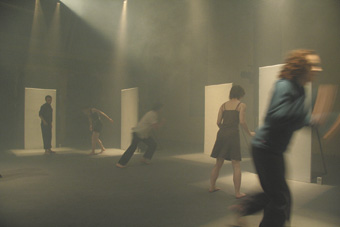
Apolitical Dance, NYID
Not Yet It’s Difficult’s Apolitical Dance addresses the impact of such changes, exploring how 10 years of neo-conservative government, along with contemporary social and cultural conditions, have changed our minds and manifested in our bodies.
Five dancers move slowly through a thick fog, four encircling a fifth and central figure. In the distance, the sounds of football commentary waft through the fog. It’s reminiscent of Saturday afternoons in suburbia.
These familiar sounds soon give way to the five bodies convulsing as if pregnant with Ridley Scott’s Alien, readying for its unholy birth and suggesting that neo-conservatism is an alien entity, lodged in the host body politic.
The performers move into increasingly alienated and individualised states, launching their bodies with mounting violence against walls to the strains of The Seekers. The juxtaposition of innocent music and violent movement evokes the unsettling ear-cutting scene in Reservoir Dogs, where Stealer Wheels’ “Stuck in the Middle with You” provides a bizarre soundtrack to mutilation. Contemporary life here is anomic and traumatic.
But there is another, perhaps more widespread experience of conservatism that embraces it as pleasurable. For many, as the electoral success of Howard’s Government testifies, these changes are experienced not as traumatic but, on the contrary, as comforting as a pair of old slippers or an episode of Dancing with the Stars.
The roots of this conservatism, moreover, are indigenous to the body politic itself, rather than some imported, alien ideology that has implanted itself in the host culture.
Apolitical Dance never really ventures down this path, only hinting at the pleasures of conservatism through a momentary dip into high camp as the dancers perform to a German folk tune. However, camp suggests a knowing, playful attitude towards its subject, which can be a way of engaging with the unfamiliar while simultaneously holding it at a distance.
In other ways too, the performance shied away from the contemporary conditions of conservatism, opting instead for unpersuasive parallels between contemporary social and cultural life with conservative forms of the past.
The playful Leni Riefenstahl-style climax, in which the performers strike a series of heroic poses in mock glorification of the athletic body before exiting into a blaze of lights, was a good example. A more promising approach might have been to explore the particular relationship of sport and authoritarian politics in contemporary culture, rather than a rather obvious reference to fascist propaganda of the 1930s. The reversion to stereotypes of authoritarianism blunted the potential force of Apolitical Dance’s commentary.
This is not to question the integrity or the urgency of the work. Indeed Apolitical Dance seeks to grapple seriously with contemporary issues, taking inspiration from the works of anthropologist Ghassan Hage, Nikos Papastergiadis, the author of Stasiland, Anna Funder and Samuel Beckett’s The Lost Ones
The challenge of working with such a diversity of influences and styles is how to translate them into a performance work. These influences were sometimes lost in translation from the page (or the stage) to the bodies of the performers, the vocabulary of movement and gesture straining to articulate the influences, or interrogate them on a fairly equal footing. Contorted bodies, writhing and struggling out of their skin, lacked the nuance to fully realise the potential insights offered by such influences. The problem was particularly acute for a work concerned with the way ideas manifest themselves in bodies: movement and gesture tended to be relegated to the backseat, far behind the intellect.
Apolitical Dance is nevertheless an ambitious work, with a welcome sense of urgency about contemporary political and cultural conditions. However, it too is produced under the same conditions which it seeks to address, developed in a crushingly brief three weeks—perhaps a statement about how a decade of conservative government manifests itself in the body.
Not Yet It’s Difficult, Apolitical Dance, director David Pledger, dramaturg Peter Eckersall, performers Sara Black, Martin Hansen, Todd MacDonald, Carlee Mellow, Ingrid Weisfelt; Arts House, Meat Market, North Melbourne, Nov 28-Dec 2, 2006
See also John Bailey’s response on page 41.
RealTime issue #77 Feb-March 2007 pg. 42
© Christopher Scanlon; for permission to reproduce apply to realtime@realtimearts.net
<img src="http://www.realtime.org.au/wp-content/uploads/art/2/286_kg_adfestcentre.jpg" alt="Lara Tumak, Amelia Best, Roderick Cairns,
Katherine Tonkin, Austin Castiglione,
Grant Cartwright, Jet of Blood, InSpace”>
Lara Tumak, Amelia Best, Roderick Cairns,
Katherine Tonkin, Austin Castiglione,
Grant Cartwright, Jet of Blood, InSpace
photo Ponch Hawkes
Lara Tumak, Amelia Best, Roderick Cairns,
Katherine Tonkin, Austin Castiglione,
Grant Cartwright, Jet of Blood, InSpace
THE SYDNEY OPERA HOUSE’S STUDIO, DRAMA THEATRE AND PLAYHOUSE SPACES ARE INCREASINGLY SITES FOR THE UNEXPECTED, THE POPULAR AND THE CHALLENGING IN THE ARTS. MELBOURNE’S ARTS CENTRE IS NOW PROMISING SOME OF THE SAME WITH ITS FULL TILT PROGRAM. IN RECENT YEARS THE ADELAIDE FESTIVAL CENTRE’S INSPACE PROGRAM HAS FROM TIME TO TIME SUPPORTED EMERGENT AND INNOVATIVE ADELAIDE PERFORMANCE, BUT NOW THE WHOLE CENTRE LOOKS SET FOR MUCH NEEDED AND ADVENTUROUS PROGRAMMING THAT COULD ALTOGETHER REVITALISE IT.
The Centre has enjoyed some wonderful times in the 70s and 80s but outside the biennial Adelaide Festival, the annual Cabaret Festival and now Wagner’s Ring Cycle (which led to the rejuvenation and substantial improvement of one of Australia’s few great large scale theatre spaces) it had fallen into cultural torpor, its theatres in the dark for up to 40% a year. The new CEO, Douglas Gautier is determined to wake the slumbering giant into new life. We asked Gautier about his memories of the Adelaide Festival Centre when he worked there as an actor in the 1970s. Wagner’s Ring boomed from his adjoining office.
1970s
I remember it as it was when I first came here as a young actor when George Ogilvie was directing the State Theatre Company. Anthony Steel was running the place. He had the joint title the way I do; he ran the place artistically and administratively. I think that’s important. I remember lots of wonderful things happening here, musically and in theatre and dance. I remember people being around a lot, and Come Out and all those sorts of things. There were lots of ideas, lots of “mulch.” There was excitement and engagement—people coming here locally, nationally, internationally. There was a good sense of aspiration and a wonderful set of venues. And I still think we do have them, but it’s more about what goes in it than the buildings themselves. So, I remember that and I always counted myself fortunate to be part of it. It gave me great confidence when I started to look at other things elsewhere. I went from here to the UK to work with the BBC as a music and arts producer. I found some interesting things there but I also found a lot of it quite boring in contrast to some of the things I’d seen here in Adelaide. The mix here was good. Justin Macdonell was doing his stuff with New Opera and Myer Fredman; Wal Cherry was ‘going crazy’ up the hill at Flinders University; Robyn Archer was here doing stuff with Wal; George Ogilvie with Rodney Fisher and Helmut Bakaitis … all of that was a really good mix and there was a political commitment to it.
leading with programming
When I was tapped on the shoulder for this job, I said, well look, as far as I’m concerned, the best arts centres in the world are the ones that are program-led. If you look at BAM or the Barbican, Sydney Opera House and others we could name—the Kennedy Centre—there’s no question what the driving prerogative is. It’s programming and the centre itself has strong curatorial control, it works with home companies but it has a very large say in the programming that it does. Without that, you don’t have anything. You become like a garage or a hall for hire. So you’ve got to have a program as a start. And from that will come audience development, box office, sponsorship, the fusion, the yeast, all of that… Without it, you’re gone.
the content
On the one hand, it comes from the home companies. There’s a very strong commitment to have the State Theatre Company in here. It’s their home. State Opera do studio productions. All of that is with us, and their Ring Cycle. The Adelaide Symphony Orchestra plays here more and more, especially for the big works. The Town Hall is fine for Mozart or whatever but if you’re going to do Mahler or Missa Solemnis or some of the big stuff, Brahms’ German Requiem, Elgar symphonies, this is where it ought to be. Increasingly, we’re doing that. I want to bring ADT and Leigh Warren back in here, Windmill and some of the small and medium companies. The home companies are important. But, at the same time, it seemed to me that we needed to have some real curatorial say about our own destiny. [Gautier exits momentarily to turn down the Wagner.]
seasons
So, we have looked at doing three genre seasons. One is Pivotal: World’s Best Dance. Essentially what we’re doing with that program is joining the dots. Australian Ballet is here (The Nutcracker), ADT (Devolution) and Leigh Warren (Wanderlust). So what else can we put in between? We’re bringing Sydney Dance Company’s Grand and Cloud Gate’s Cursive, from Taiwan (see p38). I had all three parts of Cursive in my Hong Kong Arts Festival program this year. This is the first part. It’s an extraordinary work about the company’s founder, Lin Hwai-Min, taking Chinese calligraphy and ‘moving’ it. It’s had a 30-year gestation and it is just astounding. Quantum Leap is in there too, the Australian Choreographic Centre’s youth ensemble from Canberra.
We want to make the program quite eclectic. It’s got to have some solid backbone for audiences we know we can count on for dance. But what we’re saying to that audience is, look you’ll come along to the Australian Ballet, why not try some other things? And we’re also trying to cross-market to our theatre audience by saying, “Dance covers myriad forms—take a look at what’s there.”
We also wanted to look at international theatre. In our CentreStage program we’re hosting A Midsummer Night’s Dream by Yohangza Theatre Company from Korea. You couldn’t get a ticket for it last year at Edinburgh. There’s a wonderful resurgence in Korean performing arts. We’re also doing Krishnan’s Dairy from New Zealand by a wonderful Indian family who live in New Zealand. It interweaves a story of the Taj Mahal with that of a New Zealand dairy. We’re bringing Theatre des Bouffes du Nord’s production of Athol Fugard’s Sizwe Banzi is Dead, directed by Peter Brook. We’re doing Hamlet with State Theatre, which they wouldn’t have been able to do normally—you know what the deal is these days, no cast greater than six or whatever, And, of course, we’re presenting Snugglepot and Cuddlepie with Windmill.
On the music front we have the Sunday Spectrum series in the Artspace gallery—all crossover music; some of it is classical. I feel pretty strongly that we’ve got to get music into the mix. Womadelaide is a good example. But Womadelaide only happens four days of the year. We think there’s a big audience there. We’ve just got to tap it through our trans:mission program with New York guitarist Kaki King, oud player Dhafer Youssef from Tunisia, the Soweto Gospel Choir, the great jazz pianist Herbie Hancock, and sitar player Pubayan Chatterjee.
desination adelaide
Then there’s a whole summer program. For the last four or five years I’ve been coming back from Asia and sitting on the Tourist Board here and find the place dark over summer and Christmas. I hate that! Sitting on that Tourist Board I was thinking about how you brand—terrible phrase—a destination. I still believe the strong points of difference for Adelaide are probably wine and the arts. It’s also that sort of second city thing, like Chicago, or Edinburgh or Kyoto or Barcelona. That’s the thing we ought to really seriously go for. And if you’re going to do that, you’ve got to find points of difference. You have to make sure that the work is really first rate. You’ve got to have some ideas, which make for national leadership.
the asian connection
One of these ideas is the Ozasia Festival. Look, Australia and Asia are having all sorts of dialogue in terms of business and politics and what have you. Interestingly, I think in the visual arts there is some organised interaction, for example in Brisbane [in the Asia Pacific Triennial, see p8-9]. You can see it in the acquisitions policy instituted at the National Gallery in Canberra, first with Myer and then Ron Radford. But I couldn’t see any systematic approach to it in terms of showcasing and contrasting as far as the performing arts are concerned.
What I’m most interested in is where Australian and Asian artists collaborate and the work of Asian-Australian artists like William Yang, Lindy Lee…ADT, Leigh Warren and Flinders Drama Centre have had connections with Korea and Japan. We want to explore that systematically. Ozasia will happen in October with the Lunar Autumn Festival right smack in the middle of it. So we’re going to do a massive lantern festival that anybody can participate in.
guitar, guitar
Then we’ll have the Adelaide International Guitar Festival in November-December. The guitar is to the 20th and 21st centuries what the piano was to the 19th…The guitar has made its way into just about every kind of music; West Africans have made it their own and the Cubans. The idea started from discussions with David Spelman and his New York Guitar Festival (www.newyorkguitarfestival.org)—we’re going to bring all the festival’s artists out and add all the fine guitar players in Australia in a program ranging from classical guitar and orchestra to a final night tribute to Jimi Hendrix out here on the lawns with lots of musicians interpreting his work, and who are not necessarily rock ‘n roll players at all. We’ll have a battle of the bands. It’ll be a two-week festival: 20% content imported, the rest Australian.
inspace
The final piece of the jigsaw is InSpace, which we’re ramping up several notches. Why are we doing that? Well, I walked the city for the first couple of months and looked at all the other places where performance is happening in this city. And, with all due respect to those venues, I just don’t think there is an alternative performing arts centre in the way there is in Sydney or Melbourne, There isn’t one with any real firepower. So I said to Nick Skibinski, who runs InSpace, look, why don’t we take The Space here and rethink it and make it possible for the best of those small and medium-sized companies and individual artists whom we think should be seen by a wider audience and make sure that they have a home. There should be some kind of consistency, an audience thinking if I want to see some cutting edge work, something a bit different, something that’s going to really smack me between the eyes, I know if I go down to The Space most nights, there’ll be something on. So that’s what we’re going to do.
hong kong festival
It was a wonderful experience being Executive Director of the Hong Kong Arts Festival [Gautier was appointed 2002]. I’ve been associated with it since the late 70s when I first went to Hong Kong [to work for Radio Television Hong Kong; later as Director of Corporate Affairs for STAR Television; and then Deputy Executive Director of the Hong Kong Tourist Board] and I’d directed opera for it and some music theatre works in the late 70s and early 80s. I served on the program committee and subsequently the board. The festival has done some fabulous things: commissioned an opera from Tan Dun (Marco Polo); Chinese composers like Bright Sheng had their first major performances at that festival. While I was there we formed an Asian Arts Festival Association. The executive board was Shanghai Festival, ourselves and Singapore Festival and most of the festivals around the region, a crucible for commissioning new work. We commissioned work from China National Theatre which, despite its name, is probably one of the most interesting young companies in China today. That work ended up playing in Singapore, Hong Kong, Beijing and Shanghai. Choreographers and composers from Korea, Thailand, Singapore, India, China and Japan came to work together. And the Hong Kong Festival was very much in the thick of that. The most interesting thing about the performing arts in Asia is that there is great confidence in their cultures because they’re all so deep-seated.
Adelaide Festival Centre, www.adelaidefestivalcentre.com.au
RealTime issue #77 Feb-March 2007 pg. 47
© RealTime ; for permission to reproduce apply to realtime@realtimearts.net
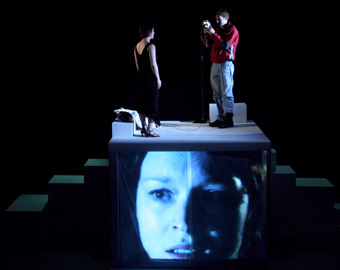
Antje Guenter, Nathan O’Keefe, Norway.Today
photo Nic Mollison
Antje Guenter, Nathan O’Keefe, Norway.Today
NORWAY.TODAY PREMIERED IN DÜSSELDORF IN 2000. THIS ENGLISH LANGUAGE PRODUCTION, DIRECTED BY JUSTIN MCGUINNESS FOR imaGEN AT BAKEHOUSE THEATRE IN ADELAIDE, RETRACES THE PLAY’S SCRIPTING OF NET-MEDIATED ROMANCE. IN THE OPENING SCENE, A YOUNG EUROPEAN WOMAN NAMED JULIE ANNOUNCES TO AN INTERNET CHAT ROOM THAT SHE INTENDS TO COMMIT SUICIDE.
Norway.Today is by Prague-born playwright Igor Bauersima. With actors Pascal Ulli, Alexander Seibt and Ingrid Sattes, Bauersima founded a theatre company called Off Off Bühne in Zürich in 1993. For a decade, they worked at producing ‘Filmtheater’, blending video screening and live performance for a new generation of theatregoers reared on the intimate realism of screen drama.
In the Adelaide production, seated at one side of the stage, Julie (Antje Guenther) speaks what she types and her face is projected onto a screen centrestage. As audience members, we are ‘lurkers’—the internet term for those in a chat room who read but don’t type. Julie is ambivalent about our presence; she turns at one point to address us directly: “Please don’t be upset if I just behave as if you’re not here.”
A young man responds. August (Nathan O’Keefe) has been lurking in the chat room on the other side of the stage—indeed, on the other side of the world because, in this production, August lives in Adelaide. Like Julie, August wants to commit suicide too. And like the summer romance conjured by the cute coupling of their names, they flirt as they chat and swap photos, plan to meet and then suicide together, in a secret location.
A swift video montage from Nic Mollison uses the global imaging resources of Google Earth to transport the couple to an icy cliff top in Scandinavia, overlooking a fjord. The actors climb a white box set, its front face serving as both the cliff and a surface for projections. There are some farcical moments on the cliff top. Each character, at different points, slips on the ice and almost falls over the edge. But it’s never quite the right time to jump.
Despite its initial appeal to the culture of the net generation, the play’s romance narrative is recognisably ensconced in two grand European philosophical traditions: as their relationship develops, the romanticism of sex in the wilderness triumphs over the existentialism of net-induced alienation. Perhaps in multilingual Switzerland and in the European Union this dialogue between (German) romanticism and (French) existentialism would sustain an intellectual tension.
In this production, the talk of suicide seems really just a cypher: deep and meaningful disclosures are a young person’s way of getting close. Why else would an eager Aussie backpacker fly across the world to hook up with a sophisticated European woman? When the couple see the Northern Lights and manage to capture that spectral display with their video cam, suicide slips down the agenda, readily displaced by sex.
As the suicidal Julie, Guenther is cheerful, smart and bossy. Her character tells us several times that when it comes to suicide she is very serious and completely sane. As the hapless August, O’Keefe is often breathless and easily outsmarted. August is talkative as a character and O’Keefe’s words sometimes run ahead of the character’s thoughts. Guenther, by contrast, speaks with precision and with her character’s determination and control. There is easy humour in this inverted portrayal of gender relations: the slightly older woman is rational and commanding, the somewhat younger man emotional and easily swayed.
There is also humour drawn out of their attempts to each record on video a suicide note for their families. But each time one of them records a message and reviews the take, it seems fake, too staged, too unreal. August records a speech that seems authentic, until he reveals that he is quoting from a self-help book. As their attempts on video multiply the singularity of suicide, the playwright revels in the irony of performance: “That was a fake”, complains August. “But it looked real”, counters Julie.
We may learn from this—from the dependence of their actions upon the tools of domestic media production—something of the difficulty of dying in the age of digital replication. And from this production, which was unremarkably effective in its smooth enrolling of video mediation within its live theatricality, we may learn that what was once an experiment in performance innovation is now so fluent in its conventions that it can deliver classic European romance with charm.
Image: Antje Guenter, Nathan O’Keefe, Norway.Today, photo Nic Mollison
imaGEN, Norway.Today, writer Igor Bauersima, translator Marlene Norst (commission, Goethe Institut Sydney), director-designer Justin McGuinness, performers Antje Guenther, Nathan O’Keefe, lighting designer Nic Mollison, sound designer Peter Nielsen; Bakehouse, Adelaide, Nov 4-18
Norway.Today is touring through Critical Stages (www.criticalstages.com.au) 2008-9. Directed by Glenn Terry working with a national advisory panel and supported by Arts NSW and the Theatre Board of the Australia Council, Critical Stages organises and manages tours of independent theatre productions that have achieved successful initial seasons.
RealTime issue #77 Feb-March 2007 pg. 43
© Jonathan Bollen; for permission to reproduce apply to realtime@realtimearts.net
AT LONG LAST, DVDS OF CONTEMPORARY PERFORMANCE AND INTERVIEWS AND DOCUMENTARIES ABOUT OR WITH THEIR MAKERS FROM THE LAST 50 YEARS ARE BECOMING AVAILABLE TO DEVOTEES OF ART THAT CHALLENGES AND INSPIRES AS IT TURNS YOU UPSIDE DOWN AND SOMETIMES INSIDE OUT. ON THE DOWNSIDE, THE DVDS ARE EXPENSIVE COMPARED WITH FEATURE FILM AND DOCUMENTARY RELEASES AND NOT ALWAYS EASY TO ACCESS. THEY EMANATE FROM SMALL-SCALE PRODUCERS AND DISTRIBUTORS IN BERLIN, NEW YORK, TOKYO, and ALSO FREMANTLE WHERE AUSTRALIA’S CONTEMPORARY ARTS MEDIA HAS A LARGE CATALOGUE RANGING FROM GROTOWSKI TO JENNY KEMP AND FORCED ENTERTAINMENT. REALTIME WILL REVIEW NEW DVDS AS THEY BECOME AVAILABLE.
Foreman Planet
Interview with Richard Foreman
Director Kriszta Doczy
DVD, 2004, recorded 2003, 75 mins
Private $65; Schools $AUS200; Tertiary education $AUS250
Plus GST, packaging and post
Contemporary Arts Media
www.hushvideos.com
Foreman Planet is a 75-minute documentary DVD on the life and work of Richard Foreman—10 time OBIE award winning writer, director, designer and founder of his own influential Ontological Hysteric Theater, in New York.
“Consciousness… spiritual consciousness… to know the unknowable other…” is what Richard Foreman describes as the foundation and ultimate subject of his life and work. His is an investigation of the unconscious that is outside of culture and conditioning which is part of the world that we can understand. To achieve this his theatre attempts to dismantle all “reference points.”
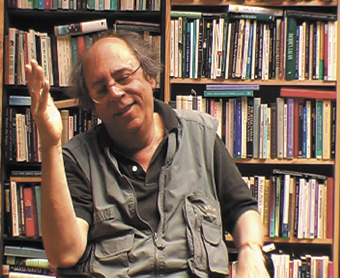
Richard Foreman, Foreman Planet
Foreman equates his own investigations with what he calls a “negative theology,” which is to know God or the Other by knowing everything that is not God or the Other. His two roles of writer and director encapsulate this binary—as director he embodies the ego and performance of being in the world, while the writer remains in the realm of the unconscious. Foreman states that his talent is for “sensing this underlying, unattainable, continual eruption of new things from different directions that are constantly colliding… sensing a rhythm… sensing a responsiveness.” Finally, concerning both the language of his theatre and the language of the world, Foreman articulates that language is, for him, “a statement that is as if dropped to the bottom of a well, where its statement hits, and reverberates…” The language of his theatre attempts to deal with such reverberation.
The style and presentation of this DVD document—and the nature of the questions from interviewer Kriszta Doczy—amounts to more an introduction to the man and a little of his work than an in-depth study. Foreman describes in detail his creative impulses, defines his methodologies and talks about psychic freedom, realism, objects and influences. The sun slowly fades from afternoon to evening as Foreman sits talking in his New York loft. The high quality of Paula Court’s photographs of his productions give the DVD an elegance otherwise lacking. Sadly, for whatever reason, no filmed examples of his work are shown.
In response to the interviewer’s somewhat basic questions, Foreman’s discourses (sometimes rants) are full of linguistic colour and energy. The questions are often used as section titles, giving the DVD the feeling of an educational aid rather than an imaginative response to Foreman’s work. Nevertheless this DVD is a very valuable introduction to the thinking if not the work of an important American contemporary artist.
Max Lyandvert
John Cage Performs James Joyce
Takahiko Iimura
DVD, 2005, recorded 1985, 15 mins, B&W
Private $US100; institutions $US400
www.takaiimura.com/home.html
Taka Iimura is a senior figure among contemporary Japanese artists and has been working with film, sound and video since the 1960s. He was one of several Japanese who, coming from a 20th century tradition of avant-garde intervention, contributed to the Fluxus (NYC) group in the 60s. As a senior figure (1912-1992), active experimentally since the late 30s, John Cage is the subject of a video portrait shot by Iimura in 1985, released in 1991 and made available on DVD in 2005.
Like many media artists, Iimura made recordings of contemporaries and their work. Alongside his making of artworks, portable video enabled documentation (and general note making) more economically than film. As the cycle of experimentation moves through another generation, glimpses of precursors through archive recordings of this kind help ground artists’ surviving words and artworks.
Cage had a long-standing fascination with the work of James Joyce, Finnegans Wake, forming the basis of many works, the best known of which is the Roaratorio—an Irish Circus on Finnegans Wake. Commissioned by German radio and IRCAM in Paris the sound recording was completed in 1979, lasted about an hour and was a 62 track mix of the sounds referred to in the text, the text itself as prepared (using a mesostic system) and read by Cage, together with music by the traditional Irish musicians of the day.
Roaratorio is one of the classics of Cage’s oeuvre and in Iimura’s 15 minute recording Cage presents the core of the spoken part of the work. Its composition, like many of his other works, is aided by the I-Ching. Here he briefly explains that none of the sentences (sic) in Finnegans Wake are selected, only words, syllables and letters from different pages according to the chance decisions made by consulting the I-Ching and its representational hexigrams. In this way the 624 pages of the book are compressed into 12 pages of text, and it is one of these pages that we see him holding. He reads from it, sings it, then hustling close to the camera and its microphone, whispers it. At the bottom of the screen are superimposed, each time, two lines of sub-titling synchronised with the text he is using.
Iimura’s presence is felt but not seen, though we hear him responding to Cage’s explanations at the outset. Cage’s voice is not strong (he is in his seventies) and we strain to hear him against the noise of New York traffic in the background coming through the window of a sunlit room. His demeanour remains buoyant, at one point making light of a fumble he makes with a watch he is holding, an event incorporated into the flow of the tape. Like so many of his initiatives, the line between the artwork and its making is blurred, a state aided and amplified by Iimura’s collaboration in its making.
Mike Leggett
This review first appeared in Leonardo Vol 40, No 1, 2007.
Fluxus Replayed
Takahiko Iimura
DVD, 2005, recorded1991, 30 mins, B&W
Private $US100; institutions $US400
www.takaiimura.com/home.html
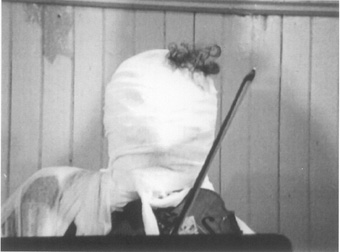
oko Ono, Skypiece for Jesus Christ (1965)
In Fluxus Replayed, Taka Iimura documents an event in 1991 held to reproduce historical performances by NYC-based Fluxus artists of the 1960s. The S.E.M Ensemble together with some of the Fluxus artists themselves, perform works by Nam June Paik, Yoko Ono, Dick Higgins, George Brecht, Allison Knowles, Ben Patterson, Jackson Mac Low and Emett Williams. Iimura has edited together the sounds and images captured by two cameras as raw evidence of the goings-on with scant regard for the conventions of continuity editing, thus maintaining the document in the space between the moment of recording and that of viewing. Time compression is only obvious in Ono’s SkyPiece for Jesus Christ (1965) as the baroque instrumental ensemble are wound around with white paper, accumulated as a series of jump cuts to the point where their music is reduced to a series of bumps and scrapes before being man-handled off the stage, still attached to their chairs and instruments.
Again, Iimura gives some idea to younger generations of how these early precursors to contemporary performance art appeared to audiences, in a setting typical of the genre—church hall ecclesiastical architecture, painted walls, wooden floor. Though much of this work was sound-based, produced collaboratively for group performance using chance determinations and framed with a sense of the aesthetics of noise, the written scores or instructions for each piece may well have satisfied many members of the audience. Glimpsed in the background, some walking around, others squirming in their seats, the probably overlong evening has been bravely foreshortened into a useful 30-minute document by the man with the video camera.
Mike Leggett
This review first appeared in Leonardo Vol 40, No 1, 2007.
RealTime issue #77 Feb-March 2007 pg. 48
© Max Lyandvert & Mike Leggett; for permission to reproduce apply to realtime@realtimearts.net
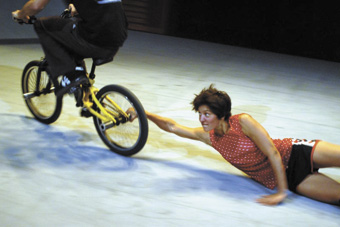
Alexandra Harrison, Paradise City
photo Heidrun Löhr
Alexandra Harrison, Paradise City
IN BRANCH NEBULA’S PARADISE CITY, AN INTENSELY ABSORBING, LYRICAL, NIGHTLIFE STREET CULTURE FANTASIA, A YOUNG MALE TEASES HIS SKATE BOARD INTO AROUSAL. BATHED IN BLUE MOONLIGHT, OTHER FIGURES GRADUALLY ENTER, KEEPING THEIR DISTANCE, CIRCLING SLOWLY UNTIL, LIKE SOME EMERGENT LIFE FORM THEY BECOME ONE, AN ORGANIC BLEND OF SKATEBOARDER, BMX-BIKER, B-BOY, DANCER AND A RISK-TAKING ACROBAT FURIOUSLY SWEEPING AROUND THE PERFORMANCE SPACE.
The whole then quietly dissolves into a series of virtuosic solos, individuals filling in very real time in which slowness is as great a challenge as speed. The bike rider (Simon O’Brien) in near zero motion lifting his bike and himself into slow turning one-wheel stands. The skateboarder (Michael Mulhall) accelerates, riding the ramps at either end of the stage diagonal, hanging above them in long split seconds of suspension.
The board and the bike are prostheses with which their owners are utterly at one, while the vehicles of the dancers’ (Kathryn Puie and Anthony “Lamaroc” Lawang) are their bodies, every walking step fine tuned into subtle moves, precise articulations and sensual ripplings—life is dance. They all intersect and the mood grows playful and then risky as the trickster (Alexandra Harrison) instigates a series of interruptions—leaping onto the moving bike, letting it run her over—and takeovers. Her talent lies in plundering from others the tools of their talent, cruelty delivered with a wry grin as she orchestrates the almost surgical removal of board and then bike from their owners whose deprived bodies, frighteningly limp, slide slowly down ramps, emptied of life and meaning. She likewise removes and wears the clothes of a melancholy singer (Inga Liljestrom) leaving her only her voice and perhaps offering something else as suggested by the langorous mood of the pair’s final moments on the ramp.
<img src="http://www.realtime.org.au/wp-content/uploads/art/2/290_kg_paradise2.jpg" alt="Inge Liljestrom, Kathryn Puie, Michael Mulhall,
Anthony “Lamaroc” Lawang, Paradise City”>
Inge Liljestrom, Kathryn Puie, Michael Mulhall,
Anthony “Lamaroc” Lawang, Paradise City
photo Heidrun Löhr
Inge Liljestrom, Kathryn Puie, Michael Mulhall,
Anthony “Lamaroc” Lawang, Paradise City
Life returns, individuals kick into action, reclaim the tools of their being and their lone, ego-less virtuosities until the street gradually empties in a kind of entropy, the energy of the night wound down in a wave of defeats and little resurgences that mean nothing compared with what has been. Begin again. Branch Nebula’s Lee Wilson and Mirabelle Wouters have created a work of poetic intensity out of everyday play, dance and physical theatre, making the most of oscillations between stillness and action and, above all and magically, of the strange time-space in between. It’s not a big picture work, more a moody, romantic portrayal of a small, intense cosmos. Characterisation is minimal, the bodies do the speaking, though Alexandra Harrison’s devilry benefits from pleasure visibly felt, and Bob Scott’s sound score is satisfyingly enveloping. The ‘paradise’ of the title is at first glance ironic but, despite their occasional falls from grace, this street in this city is mostly heaven for its denizens and for those who espy them. More and more audiences should be invited into this strange paradise.
the whistling man
PACT’s imPACT ensemble production for 2006 bristled with young confidence—strong collective playing, a stark, demanding political vision and a thoroughly integrated design. The effect, economically achieved, was of entering the huge white cube of a conference centre replete with lectern, mike, big screen and mysterious logo, with elaborate media operations boothed to one side. In the squared seating layout came the gradual realisation that people mingled with in the foyer and now sitting next to us were performers, suddenly very edgy citizens not at all happy with, deranged even, by the state corporation merger being sold them in words aptly borrowed from PM Howard. Formalities are constantly interrupted by people who insist on dancing, dropping their trousers, making embarrassing confessions or deviant political commentaries. Audience members are sometimes asked to give up their seats as crowd control swings into action and dissidents are relocated by an apparently benign but increasingly brutal organiser.
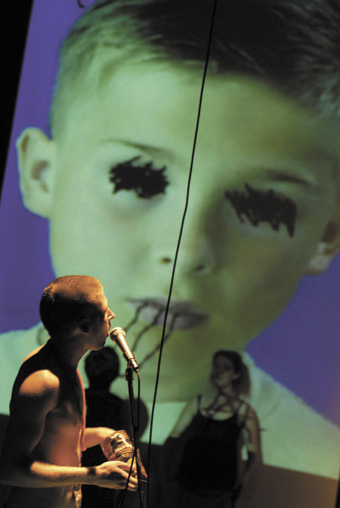
PACT, Whistling Man
photo Heidrun Löhr
PACT, Whistling Man
What played out well in The Whistling Man was a suspenseful sense of impending chaos and the ever increasing vulnerability of those who object to an indiscriminate and irrational application of power, responding with their own apparent madnesses. Bizarre moments of uniformity erupt—sudden line dancing. Abstracted, pixelated faces on the screens gradually form the recognisable shapes of those around us heightening our sense of identification but also the paranoia induced by surveillance, including the spotlight that picks us out from time to time. Where The Whistling Man took us in the end I’m not sure, a climactic rebellion or a collapse into all-dancing dysfunctionality? Had the state’s induced madness destroyed it? Although the overall escalation of intensity was keenly felt, the framing of the corporate gig/conference/rally seemed, its desperately growing oppressiveness aside, to lose its shape and meaning. Perhaps that was the point but it left the performance without the charged political dynamic it initiated. Nonetheless, The Whistling Man had many strengths, not least a much more contemporary multimedia design than usual for PACT, one thoroughly pertinent to the performance’s concerns.
Branch Nebula, Paradise City, co-creator, director Lee Wilson, co-creator, designer Mirabelle Wouters, Sydney Opera House commission, produced by Performing Lines; The Studio, Sydney Opera House, Nov 30-Dec 10, 2006, www.branchnebula.com
PACT Youth Theatre, The Whistling Man, performers 2006 imPACT Ensemble, media designers Spat+Loogie, Teik Kim Pok, sound designer James Brown, set designer Kenzie McKenzie, design mentor Imogen Ross, lighting designer Clytie Smith, movement consultant Chris Ryan, director Regina Heilmann, dramaturgy Bryoni Trezise; PACT Theatre, Sydney, Nov 29-Dec 10, 2006
RealTime issue #77 Feb-March 2007 pg. 44
© Keith Gallasch; for permission to reproduce apply to realtime@realtimearts.net
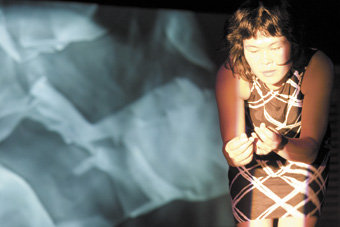
Yumi Umiumare, Impro-lab
photo Mayu Kanamori
Yumi Umiumare, Impro-lab
ALTHOUGH MUSICAL IMPROVISATION CONTINUES TO BE A STRONG PRESENCE IN SYDNEY, THE PHYSICAL AND VOCAL WORK THAT HAD ITS HOME IN THE DEPARTED OMEO STUDIOS IN RECENT YEARS IS NOW LESS VISIBLE. THEREFORE THE IMPORTANCE OF IMPRO-LAB, WHICH FUSES MUSICAL, PHYSICAL AND MEDIA IMPROVISATIONS CANNOT BE UNDERRATED, NOT LEAST FOR ITS INTERNATIONAL CONNECTIONS EMBODIED IN THIS MOST RECENT OUTING WITH THE REMARKABLE VOICE OF VISITING JAPANESE VOCALIST AMI YOSHIDA AND THE SINE WAVE SOUNDS OF SAMPLER ARTIST SACHIKO M.
With these artists, Jim Denley (wind instruments), Chris Abrahams (keyboards) and Amanda Stewart (voice) completed the often dense if subtly realised aural dimension of the second of the Impro-Lab evenings at the Studio. The quiet presence of video artist Samuel James, sitting on the floor of the performance space with cameras, yielded some high impact imagery on two large screens.
Training his camera on small details of the space and slowly manipulating focus and intensity, James created transfixingly radiant abstract images that appeared to have organic lives of their own. They became doubly potent when performers entered their aura: Tess De Quincey locked into a scarily intense quivering, Tony Yap into tight sinuous revolutions, Yumi Umiumare richly expressive against James’ film noirish transformation of the Studio wall slatting into venetian blind-like shadows.
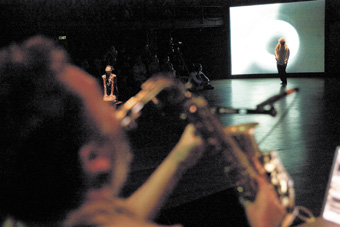
Jim Denley, Yumi Umiumare, Tess de Quincey, Impro-lab
photos Mayu Kanamori
Jim Denley, Yumi Umiumare, Tess de Quincey, Impro-lab
In the bravest flight of the night, Umiumare, like a figure straight out of Magritte, danced at length with a boot placed on her head. Of course, improvisation is by nature a hit and miss affair: the night’s two performances had their fine moments, mostly appreciated in the detail rather than as a large scale collaborative venture, with some occasional turn-taking tentativeness evident. Yoshida aside, whose croakings and squealings emanate alarmingly as if from a body possessed or diseased, the musicians were in danger of appearing to be playing an accompanying role. Jim Denley nonetheless provided a rich and vivid continuo. Although greedy for something more palpable from Abrahams and Stewart, I was nourished by many moments in the performances and was particularlytaken with the successful integration of live video.
live cinema
I asked Sam James to describe his approach to working on Impro-Lab. He wrote that he used three live cameras attached to a vision mixer which could mix between any two found images. He “wanted to keep it all analogue” to be authentic to the environment and to the improvisation: “Because of the difficulty or the vulnerability of using three lenses with different qualities and without effects there was a truthfulness to the space and the performance.” James prefers doing what he calls “live cinema” instead of working with a laptop and pre-recorded imagery, where he sees an “artificial impression of realtime image creation.”
James clearly enjoys the spontaneity of his approach: “With the live camera, as something happens the camera operator’s response is immediate and sometimes impulsive, and often much of the strain of the work is controlling the immensity of the outcome. It’s a very sensitive medium to use for live projection…there’s a visceral response with camera movement, control of focus, exposure and zoom to the immediate sound and physical environment…I see what’s there with each of the cameras and the images begin to feed off each other, creating a kind of transcendence, of the sum of the space.” James is determined to continue working this way after a year of part-time development of the approach and working with experienced improvisors.
Improvisation sometimes seems to come out of nowhere. However, at its best it’s the expression of relationships between artists who have worked together for extended periods and are highly reponsive to each other. Impro-Lab came of out of such contact with an intensive program of laboratories and residencies held in Japan and Australia in 2006 involving Asialink’s Neon Rise program, Perth Institute of Contemporary Arts and Critical Path in Sydney.
DeQuincey Co and Machine for Making Sense, Impro-Lab: Transparencies, dancers Tess de Quincey, Peter Fraser, Yumi Umiumare, Tony Yap, musicians Chris Abrahams, Sachiko M, Jim Demley, Ami Yoshida, Amanda Stewart, video Samuel James, lighting Clytie Smith; Australia-Japan Year of Exchange; The Studio, Sydney Opera House, Nov 25
RealTime issue #77 Feb-March 2007 pg. 45
© Keith Gallasch; for permission to reproduce apply to realtime@realtimearts.net
<img src="http://www.realtime.org.au/wp-content/uploads/art/2/294_inhouse_claire_sean.jpg" alt="Primary Producers, Sean Cordeiro and Claire Healy’s
oyster shucking picnic
“>
Primary Producers, Sean Cordeiro and Claire Healy’s
oyster shucking picnic
courtesy of the artists
Primary Producers, Sean Cordeiro and Claire Healy’s
oyster shucking picnic
ON FEBRUARY 25 PERFORMANCE SPACE BEGINS A NEW LIFE, SINGING ITSELF INTO BEING IN ITS NEW HOME AT CARRIAGEWORKS WITH A FREE PROGRAM, “A CHORAL HOUSEWARMING TO CALL IN THE NEXT ERA.” THE WELCOMING WILL MAKE THE MOST OF THE NEW SPACE, INCLUDING THE MASSIVE MAIN FOYER WITH ITS HIGH BALCONIES AND MACHINE RELICS FROM ITS RAILWAY DAYS.
The opening performance season is a strong one featuring William Yang’s latest work, China, acrobat’s Smaller, Poorer, Cheaper (RT 76, p42) and Martin del Amo’s new work, Never Been This Far Away From Home. The visual arts program likewise promises much with new works by installationists par excellence Sean Cordeiro & Claire Healy (a site-specific work onsite at CarriageWorks) and media artist Denis Beaubois.
martin del amo
Of German and Spanish heritage and trained in Japanese dancing arts of Butoh and Body Weather, Martin Del Amo has become a key figure in the Sydney dance scene. He was part of the 2006 Breathing Space tour of the UK and recently returned to the UK to perform again at Arnolfini in Bristol. Any del Amo work is bound to impress with its blend of intimate direct address and compulsively expressive dance propelled by an autobiographical impulse. For Amanda Card, writing about the dancer for Performance Space, he summarised his recent works: “My three earlier solo pieces investigated the direct physical and psychological impact of certain forces…In Unsealed (2004) I explored the destructive potential of loneliness. The threat of physical extinction was a theme in Under Attack (2005) and the relationship between trauma and obsession was key in Can’t Hardly Breathe (2006).”
We asked del Amo to reflect on the motivation for his new work. He wrote back, “Early in 2006, when starting to think about ideas for a new solo show, I found myself in the UK. It was very cold while it was very hot here. I was missing out on Sydney summer and I wasn’t happy about that. Feeling rather melancholy and slightly homesick, I went into a Virgin Megastore in Manchester. The song that was playing when I entered was extremely insistent and impossible to ignore as it repeated over and over: “Oh my God, I can’t believe it—I’ve never been this far away from home.” (Later I learned the song was Kaiser Chiefs’ “Oh My God.”) …Somehow the line not only reflected what I was feeling at that moment but also seemed to encapsulate the thematic territory I wanted to explore in my new show. My personal circumstances in the last five years (relocating from Berlin to Sydney, touring nationally and internationally) have heightened my awareness of notions of ‘home’, not only as a geographical location but also as an emotional and psychological state.”
The opposite to home is the unknown. But, what, wonders del Amo, is unknown these days: “All the blank spots that once existed on maps have been filled.” However, “Outer space, the ocean floor and underground are the new frontiers. And then of course there has also been the advent of what might prove to be the ultimate, uncharted territory—cyberspace, an incomprehensibly vast, inexhaustible playground for all intrepid adventurers and tireless explorers.”
Venturing into the unknown, says del Amo, “almost always means …one is soon faced by situations and conditions previously unimagined and unexpected. New rules apply, and formerly trusted survival strategies are no longer valid. What happens then?”
Just what unknowns del Amo and his audience will face in Never Been… remain to be seen, but the artist gives us some clues: “Spoken texts featured in the show include musings on the impenetrability of borders both real and imagined, a story about a mysterious white room in which objects appear according to rules unknown to the storyteller, and advice on how to escape from crocodiles.”
The other dimension to this unknown is, of course, making and showing the work. Del Amo commented to Amanda Card that “The very act of making a solo takes you ‘far away from home’, out of your comfort zone. Each new work and each performance must establish a relationship with a new place or a new audience…A solo work is the most direct and undiluted way of making work. The contract between a solo artist and their audience is very clear. …(You) are asking your audience for their undivided attention, but this attention has to be earned.”
For Never Been This Far Away From Home, Martin del Amo will be joined by regular collaborators Gail Priest (composer and live musician), Clytie Smith (lighting designer) and Virginia Boyle (costume designer) with Branch Nebula’s Mirabelle Wouters joining the team as set designer.
and much more…
Sydney rock oysters are still one of the city’s great pleasures although these days harvested far away. The first settlers found on arrival mountainous middens of shells left from hundreds of years of Aboriginal feasting, the lime from which soon became the mortar that long cemented the growing city’s buildings. Sean Cordeiro and Claire Healy will, with helpers at a picnic at CarriageWorks on February 24, begin to shuck into shape a sculpture evoking this history in their new work, Primary Producers. It’s the first in a series of site-specific works curated by Performance Space Associate Director Sally Breen. There’s certainly a lot of site at CarriageWorks to get specific about in the future.
In Denis Beaubois’ The Terminal Vision Project the artist screens images from a small wireless camera dropped from a tall building: “The work explores the links between remote viewing and physical reality (passive consumption and experience).” Beaubois’ previous creations have included witty and insightful takes on surveillance as in his In the Event of Amnesia.
In his latest work China photographer-performer William Yang, born and raised in Australia, visits his cultural homeland, narrating the encounter to a score for erhu played live by Nicholas Ng. Smaller, Poorer, Cheaper offers a rare opportunity for Sydneysiders to see the famed acrobat with their highly skilled, stripped back performativity. The launch of media arts DVD label, demux, plus the first of a series of short works showings, Night Time #1, along with a number of residencies signals a fully functioning Performance Space, home at last.
The first Performance Space program at CarriageWorks provides a brisk, strong start to a new beginning with inventive, accessible works. This will doubtless be a period of adjustment: for artists and PS audiences one of new comforts, the opportunity to really focus on the work and also to reach out to many newcomers. RT
Performance Space, www.performancespace.com.au
RealTime issue #77 Feb-March 2007 pg. 13
IN THE MANY WARS OF THE LAST HUNDRED YEARS—FROM WORLD WARS TO COLD WARS TO CULTURE WARS TO WARS ON REFUGEES, ON TERROR AND IRAQ—HOW HAS PERFORMANCE RESPONDED TO INTERNATIONAL AND CIVIL CONFLICTS? WHEN WAR USES THE TERM ‘THEATRE’ TO DESCRIBE ITS AREA OF OPERATIONS AND EFFECT, HOW MIGHT THEATRE EXAMINE THE FALLOUT OF WAR?
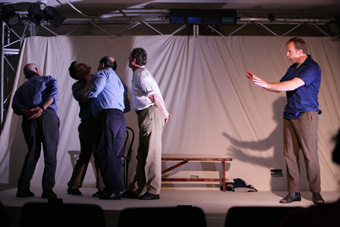
Chris Pitman and cast, Maralinga
photo Dawne Fahey
Chris Pitman and cast, Maralinga
Fallout, a day-length symposium investigating the intersections of theatre and war, aimed to analyse a range of performance practices operating within this territory, framed by questions of the ethical imperatives, political efficacy, logistical challenges and the aesthetic innovations of these practices.
Originally convened as an opportunity to reflect on Maralinga, a long-term interview-based verbatim theatre project by Paul Brown and collaborators, Fallout was expanded to draw together artists and scholars from Australia and the UK to discuss and debate a number of artistic projects in both countries that take war as their subject. These ranged from Australian works like Ngapartji Ngapartji, Through the Wire and The Wages of Spin, to the work of British companies such as Ice and Fire and The Exodus Project, sound artist Louise Wilson’s atmospheric audio interventions into abandoned military research sites in Scotland and the work of the Manchester University-based research project In Place of War, now in its third year.
“That Maralinga should be classed as a war zone struck me in the face”, said Paul Brown in his introductory remarks, but that it made sense as a “Cold War zone.” Far away, on the fringe of its former Empire and thanks to meek Australian compliance, Britain was able to flex its nuclear muscles, to demonstrate that it too was a force to be reckoned with in the new world order. Maralinga, recently shown as a work-in-progress at the Ettalong Beach War Memorial Club on the NSW Central Coast, confronts official blanket secrecy and denial by seeking unofficial, often anecdotal accounts from ordinary soldiers in extraordinary circumstances. The play distills interviews with a large number of British and Australian servicemen who worked on the tests between 1952 and 1967, most often young men off for the adventure of a lifetime, who had no notion of what they would be exposed to, and whose primary function in many cases seemed to be as guinea pigs—to discover not only the health effects of the tests, but also how soldiers might psychologically cope with and begin to normalise the atomic battlefield of the future. Fallout convenor James Arvanitakis remarked of Maralinga that it was an act of “highlighting broken bodies, and how they broke.” Not being the bearers of stories of glory and triumph, atomic test veterans have faced painfully extended battles with military and government authorities that continue to deny claims for compensation, partly on the basis that the soldiers were not deemed to have served in a war.
James Thompson, Alison Jeffers and Jenny Hughes discussed the work of In Place of War, appearing live from Manchester via video streaming. The project examines performances that occur within war zones, triggered by Thompson’s experience of working in war-torn Sri Lanka, where anthropological literature declared that no performance was occurring, despite this clearly not being the case. Much of the work of In Place of War examines performance being created by and for survivors of civil strife, both within the war zones themselves and in countries of refuge such as the UK. There were obvious links here with the recent explosion of refugee-themed ‘verbatim’ or ‘documentary’ theatre in Australia, explored elegantly by Caroline Wake. While Alison Jeffers’ paper focused on the performances that refugees themselves must produce in order to be recognised by state authorities as legitimate refugees, Wake focused on the ways in which refugee witnessing has been redeployed in recent examples of Australian theatre. As Paul Brown noted cautiously, “truth surrounds verbatim, but it would be a mistake to think that verbatim theatre is any more truthful than any other form of theatre.”
2006 marked the fiftieth anniversary of the Maralinga tests. As the United States agrees to provide India with nuclear technology, covers munitions with radioactive ‘depleted uranium’, and begins developing a new range of ‘safe’ battlefield nukes and while Australia scrambles to satisfy China’s appetite for uranium and actively courts nuclear power as a ‘realistic’ and ‘clean’ answer to global warming, it is difficult to ignore the spectre of the Maralinga tests and the death, dislocation, and destruction they produced. As such, forums like Fallout act as both timely reminders of buried histories of injustice and as opportunities to gather critical mass to resist such atrocities recurring.
Fallout: A Symposium of Politics and Performance, convenor James Arvanitakis, School of Media, Film and Theatre, University of New South Wales, Nov 22 2006; Maralinga. www.nucleartheatre.org; In Place of War, www.inplaceofwar.net
RealTime issue #77 Feb-March 2007 pg. 46
© David Williams; for permission to reproduce apply to realtime@realtimearts.net
CHOREOGRAPHER/DANCER EMIO GRECO AND DIRECTOR/DRAMATURG PIETER C SCHOLTEN HAVE A CREATIVE CHARTER THAT LOOKS TO THE BODY AS THE PRIMARY SOURCE FOR DRAMATURGICAL CONTENT. DOUBLE POINTS: ONE & TWO IN THE SYDNEY OPERA HOUSE’S ADVENTURES IN THE DARK PROGRAM WAS INDEED AN EXCITING EXAMPLE OF DANCING BODIES TAKING CENTRESTAGE, AND IT WAS SURPRISINGLY NOVEL TO SEE A MAJOR DANCE PERFORMANCE IN SYDNEY THAT CONCENTRATED ITS FOCUS ON CHOREOGRAPHY. MINIMAL DESIGN ELEMENTS, WITH THE EXCEPTION OF STRIKING SCORES AND KNOCK OUT LIGHTING DESIGN, PROVIDED JUST THE RIGHT SUPPORT FOR GRECO’S SOLO AND A DUET BY SUZAN TUNCA AND VINCENT COLOMES.
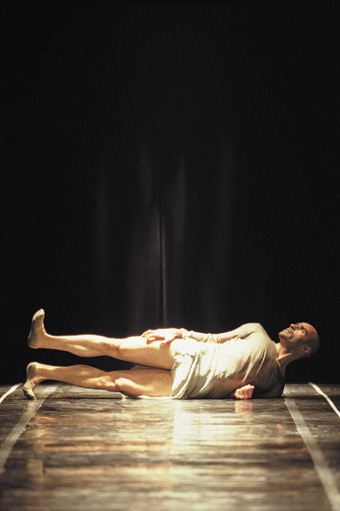
Emio Greco, Double Points: One
photo courtesy Sydney Opera House
Emio Greco, Double Points: One
The medium-sized stage space of the Playhouse, with wings open, was modelled by light and finely articulated dance, the direct address of the performance fiercely established by the first solo. Greco appears upstage at the end of a corridor of light, like a straight stretch of highway connecting dancer and audience. The pathway is marked off with white lines so that the dancer’s movement outside this, when it inevitably comes, is somehow shocking as if he is moving into a void. Pools of light travel down the corridor to Greco who plays with the light, thrusting an arm to be seen.
The score, Ravel’s Bolero, doubles the visual thrust of the stage design. Greco’s slow build is hypnotic, the slithering and contained movement centring in the pelvis then with ballet arms and legs that can’t quite find the position, deep and somehow threatening second plies and rushes forward to the audience. I can’t help recalling Sylvie Guillem’s ridiculous performance to the same score at another Sydney festival with choreography by Maurice Bejart and the Australian Ballet male corps circling the ballerina high on a rostrum and thrusting their pelvises to the beat. The sexual intensity of Greco’s performance is both central and undermined; the end of the Bolero score is suspended as silence interrupts the climax and the sound of violent fireworks fills the space.
After the final, delayed notes of Bolero, Greco leaves the light to sit on a chair in a dark corner and Tunca enters at the back, loitering, facing upstage and off-centre. A sumptuous amber swimming pool of light forms, shifting and pulsing in dramatic contrast with the formal and ‘masculine’ lighting of the first state, the hard corridor rippling up and down the stage. The lighting prepares the space for a complete change in choreographic mood. Tunca balances on one leg, shifting the other around in the air. Greco cuts wildly across the stage, ‘upstaging’ her in the most blatant way, then leaves. Another male dancer, Colomes, enters and the duet begins.
The two dancers move together with the precision of birds in flight and this metaphor is cemented by bird-like gestures and calls in the score. The twitching, erratic, intimate movements shift into frenetic phrasing or mad spectacles—arms swinging around like synchronised motors. Then they seem suspended together downstage, as if the air has been sucked up and out of them. But there is constant movement in any of these states and the unison is breathtaking given the general fever pitch of their delivery and the physical differences between the two (Tunca towers over Colomes).
These works are some eight years old and yet seem so incredibly fresh, combining an intensely passionate delivery with wonderfully precise form. It has been a long time since I have seen a dance performance conjure such a rich world of invisible desires, forces and impulses, with so few exterior cues and such genuine physical bravado. Here’s hoping the Adventures in the Dark in dance continue.
Emio Greco | PC, Double Points: One & Two, choreography, direction, lighting, set and sound concept Emio Greco and Pieter C Scholten, dancers Emio Greco, Suzan Tunca, Vincent Colomes; Playhouse, Sydney Opera House Nov 21-Dec 2, 2006 www.emiogrecopc.nl/public
RealTime issue #77 Feb-March 2007 pg. 37
© Erin Brannigan; for permission to reproduce apply to realtime@realtimearts.net
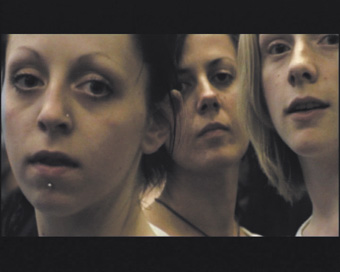
You Made Me Love You
A TREND TOWARDS THE CONCEPTUAL AND THE INFLUENCE OF PRACTICES ASSOCIATED WITH THE VISUAL RATHER THAN THE PERFORMING ARTS WAS EVIDENT THROUGHOUT DANCE ON SCREEN, THE PLACE’S FESTIVAL OF SCREEN-BASED MOVEMENT, MIRRORING A SHIFT WITHIN THE SCREENDANCE WORLD AS A WHOLE.
The festival’s core programme of International Screenings was co-curated by Videoworks manager Gitta Wigro and Sarah Wood, with the latter having moved to screendance from a background in programming moving image works by visual artists.
As the festival last appeared in 2004, the two-year hiatus provided the opportunity for the screendance community in Britain to see how the form has progressed by reflecting on the range of activity on offer at this year’s event.
The six day programme of events opened with a masterclass screening, showcasing work created in a single week under the guidance of director Katrina McPherson, winner of the IMZ Dance Award, Monaco. McPherson emphasised the creative potential inherent within an improvisationally slanted approach and the desirability of placing movement content at the heart of dance work created for the screen. These thematic concerns were particularly well served in the ambitious layering of movement material and dialogue in Jemima Hoadley’s Red/White (2006). McPherson’s own work was also present throughout the week in the form of the ultra high concept Move-Me booth, co-originated with Simon Fildes, and co-produced by Ricochet Dance Productions, where anyone brave enough to venture inside could create their own recorded interpretations of choreography by, among others, Rafael Bonachela; Deborah Hay and Stephen Petronio.
Away from the main screening space, engagement with the conceptual was strongly in evidence as a strand of festival programming with installations in the form of choreographer/director Heather Eddington’s precision editing projected against Nyanda Yekway’s stark white sculptural environment in Curious, and Mark Dean’s Goin’ Back (The Birds/The Byrds x 32 +1, UK, 1997). In this hypnotically minimalist reworking of a close-up from Hitchcock’s The Birds, Tippi Hedren’s horror-stricken face moves continuously forwards then backwards from a barely perceptible rocking breath rhythm to an anguished semaphore of self-protective arm waving. Another striking convergence of the choreographic and the conceptual was evident in 365 Days—Reijo Kela’s video diary of 1999. The eponymous Finnish director/choreographer recorded his physical journey through the frame for (almost) each day of the year, playfully exploring and developing a movement vocabulary of hopping, rolling and running through a variety of locations and settings, involving a range of good-natured, if somewhat bemused, bystanders.
The festival’s Living Room area provided a library facility to view all submitted works, catch up with familiar faces and watch the One Minute Wanders program, with each piece rising to the challenge of time constraint to deliver a series of small marvels. Claudia Kappenberg’s Long Wave (UK, 2006) made use of archival footage projected on to the single female performer’s naked back. The simplicity and economy of the idea allowed access to an intimate world of texturally layered and body-based memory and association, with the undulatory movement of the figure echoing the journey of a giant sphere as it hugged the curve of a hip and rolled along the length of the spine. Mavin Khoo (UK, 2006), directed by Hazuan Hashim and Phil Maxwell and choreographed by Khoo himself, made strong use of a range of compositional elements. With the lone performer in silhouette against a riverscape location, the framing emphasised the verticals of the moving figure and the skyline set against the constant horizontal of the river and interweaving the peal of city bells with the ethereality of a counter tenor’s voice. In Caps (France, 2006), directed by David Olivari and choreographed by Karl Paquemar, a trick of perspective is played on the viewer. A seemingly flat, graffiti-covered surface is revealed as a space housing concealed entrances and exits and a frame-within-a-frame as two men enter, playing out an intense encounter using the movement language of supported fall and recovery with sudden shifts of positioning and dynamics visible against the outer and inner edges of the screen space.
Within the festival’s International Screenings, the trend towards the conceptual was particularly apparent in Miranda Pennell’s You Made Me Love You (UK 2005) in which a group of teenage performers are filmed as a sea of faces, filling the frame, locked on to and following the single take, studio set, stop-start journey of the camera like a shoal of particularly attentive fish. The piece’s minimalist movement vocabulary of walking, stopping, turning and swaying is suggested mainly by the sound of moving feet and sudden silences as the striving to maintain an unbroken relationship of performer gaze to camera/viewer becomes the central focus of the work.
Catherine Maximoff’s interpretation of Russell Maliphant’s choreography in Voyage (France, 2006) demonstrated that the particular skills necessary to translate stage-based dance work to screen require to be categorised as a specific choreographic practice in their own right. The work achieves a balance between the use of wide shots to reveal the whole body, thus recreating the live viewing perspective, interspersed with more intimate closeups, providing a sense of quietude and interiority. Sequences are filmed from alternating perspectives, contrasting front and back views, and music with ambient sound. A contact duet is filmed from above, intercut with extreme closeups of near abstracted torsos and arms, punctuated by the sound of the dancers’ breath.
In Match (Ireland, 2006), directed by Dearbhla Walsh and choreographed by Fearghus O’Conchuir, the camera functions almost as an extra performer, transforming an intensely physical contact duet into a trio by the extent of its choreographic engagement. Location is also used to strong effect, as Ireland’s (deserted) national stadium provides an epic spatial arena and a charged cultural context for a male-to-male encounter exploring combat and competitiveness, with moments of tenderness and physical intimacy ultimately transcended by the will to win. The camera work mixes aerial shots with extreme close-ups, capturing an interlocked grappling of arms from beneath and following the trajectory of a movement arc with as much physical intensity as the performers themselves.
The festival concluded with Next Up, curated by Wigro and IMZ winner Rachel Davies, presenting a new generation of screendance practitioners and where conceptually driven work again left the strongest impression. Maya Deren wrote that reverse motion can be used to convey the impression of “an undoing of time”, and in Jan Steinum’s Highway of Love (Norway, 2006), a patterned tracery of footprints visible on a flat, snow-covered rooftop were gradually and magically erased by the backwards journey of a single male performer wearing red patent thigh boots and little else, carefully cradling a dance partner in the form of a blow-up doll. In Philippa Thomas’ Electric Desert (UK 2006) the superimposition of motion-blurred Las Vegas neon over black and white footage of a young male transvestite created a memorable and otherworldly visual landscape. Manipulating a Loïe Fuller-like outfit of billowing white sheets, the central figure’s face, revealed in extreme close-up, appeared to follow the progress of the coloured lights, and the absence of sound served to place the work outside of a conventional linear timeframe, drawing the viewer into a heightened experience of visuality.
Bill Viola wrote of the shift in popular perception accompanying the realisation that “the twentieth-century artist is not necessarily someone who draws well, but someone who thinks well.” Dance On Screen 2006 provided ample evidence that in the 21st century the screen can function as a site of expression for dance film practitioners who think well too.
Dance on Screen Film Festival, The Place Videoworks, London, Oct 30-Nov 5
www.danceonscreen.org.uk
RealTime issue #77 Feb-March 2007 pg. 35
© Chirstinn Whyte; for permission to reproduce apply to realtime@realtimearts.net
IN NOVEMBER OF 2006, I FOUND MYSELF IN AN EXTRAORDINARY PLACE. I WAS STANDING ON A DUSTY MOUNTAINSIDE IN NORTH WEST ARGENTINA, AND I WAS PRACTISING LOOKING. THERE WAS A HUGE VIEW AHEAD OF ME: LAYER UPON LAYER OF MOUNTAINS, THE FURTHEST PEAK CAPPED WITH SNOW. I WAS TINY, LIKE A SPECK OF DUST. THE SKY WAS FALLING AND AS I LOOKED, I FELT I WAS RISING AND NOTHING MATTERED. AND EVERYTHING MATTERED.
I could feel the wind on my skin, and hear the silence, and taste the salty tears that were suddenly running down my face. This was one moment in a month-long screen dance research period. I’ll rewind a bit and tell you how I got there.
Exactly one year earlier, I had visited the Festival Internacional de Videodanza de Buenos Aires, to teach a workshop and to present my work. On arriving back in the UK, I was offered the opportunity to return to Argentina on an Arts Council of England international research fellowship. The fellowship was supported by two organizations—South East Dance Agency based in Brighton, England (my home town), and VideoDanza BA in Argentina. They decided to extend the project by offering research time to two Argentinean artists, filmmaker Alejandro Areal Velez and choreographer Sophia Mazza, who both worked on separate research projects. We all came together to share our experiences during the 2006 Videodanza festival in Buenos Aires (Nov 28-Dec 3). These discussions were mentored by Brighton-based screen dance artist Magali Charrier.
At the outset I was asked to write a statement of intent regarding the parameters of the research and it seemed vital that I should engage with something in Argentina that I could not have access to in the UK. Coming from the cluttered and crowded environment of South East England, I proposed going to the huge, open, empty spaces of Argentina. I wanted to explore the possibility that my own creativity could be affected by unfamiliar textures, colours and scale, and that my own sense of real space and time, and recorded space and time, could be influenced by the geographical space that I work in. This was the starting point from which I wanted to explore a sense of the macro and micro, in terms of landscape, body in landscape and movement in relation to distance. This is how I found myself on this incredible mountainside.
Silvina Szperling, director of the Videodanza Festival, found me two perfect travelling companions—photographer Alejo Schatzky and dancer/videomaker Paula Zacharias, and together we travelled through salt fields, across mountains, through forests of giant cacti, over vast plains and past enormous, crumbling glaciers.
Some of the research that I undertook investigated my physicality in relation to the environment, and how awareness of it could affect my camera practice. My interest in combining video and dance practice is informed by a physical curiosity. I had questions regarding vision and habits of looking. How long can I look before I look for something, before I make judgements based on taste and aesthetics? By paying attention to my looking, will I see more? Will I see differently?
Then I found myself searching for the work that was specific to each particular environment. Dance (in its formal and theatrical sense) can seem inappropriate when placed within a non-theatrical setting. Yet in some spaces, we would chance upon happy accidents, when Paula would move and the light and the heat and the dust and the camera settings would combine with that movement to create dances in which the lines between the body and its surrounding environment became porous.
The movement that I requested from Paula was based around quite practical tasks. For example, “Move the dust with your feet and hands”, and Paula would interpret as she saw fit. Now I have this material in an edit suite, I find that the answer to my questions to do with placing the dancing body in a landscape is to remove the body entirely, and just leave the dust mysteriously lifting and falling. I look at footage of Alejo swimming in a roadside pool. I made a choice to shoot it out of focus. It looks smudged and although it is clear that something is disturbing the landscape, it is impossible to identify exactly what landscape and what is disturbing it. Instead we see an abstract dance of colours and flecks of light.
It remains a puzzle to me—the invention and placing of dance in the landscape—yet I am interested in some of the footage that resulted from the attempt to solve the puzzle for myself. I hope that the footage will be showing up in some form at screen dance festivals in 2007.
On returning to Buenos Aires, it became clear that Alejandro, Sophia and I had all approached this question of research in very different ways. Alejandro had set up a video shoot in order to explore questions of “connection and disconnection” in human relationships. He will edit his footage into a 12 minute film. Sophia was working with filmmaker Cayetana Vidal to explore a narrative they had invented that was set in a swimming pool. We found ourselves discussing the nature of research. How do you know when you have stopped researching and started doing something else? When does that ‘something else’ become ‘production’?
Maybe in an ideal world we could all place our work in the context of research, all of the time, in order to give ourselves the safety net of failure. On the occasions that I have not named my work ‘research’ I can find myself disappointed by the outcome. I take fewer risks, because of my perceived need to succeed, and therefore the work can fail to surprise or delight me.
Our conversations spilled out into the public domain of the festival, as all three of us were asked to make presentations on the work that we had undertaken. I realised that it is rare to have showings of work in progress or discussions regarding research or process at screen dance events, although these are common within live dance contexts. In screen dance it can all seem set and final. Done and dusted.
The value of a trip such as this is clear—if art imitates life, then it is essential that artists have a life for their art to imitate.
If you engage with travel, you will arrive.
Ibn Arabi
To view an online blog from the artists and organisers of this project visit http://southeastdance-buenosaires.blogspot.com/
RealTime issue #77 Feb-March 2007 pg. 36
© Becky Edmunds; for permission to reproduce apply to realtime@realtimearts.net
Dear RealTime,
I just wanted to let you guys know that The Fromagerie will be closed after the end of February, and that The Old Flour Mill Building as it is will be no longer after March 15. We will be running a 3-night extravaganza March 1-3 to celebrate what the space was and mourn its passing. It’s called Past, Present, Future (one for each night).
Rosalind Crisp founded the space as Omeo Dance Studio in 1996, and after her move to Paris, The Fondue Set took over in late 2005 renaming it The Fromagerie. I think the closure will come as a big loss to the Sydney dance scene. The list of people who have worked in the space over those 10 years is massive. It has always served as a place where people can practice or perform works without curation or application forms. I suppose I'm also wondering about how the loss of a space like The Fromagerie impacts on the huge deal of the CarriageWorks.
The Fondue Set are going to attempt to look for another space, but we think it will be difficult to find somewhere so local, big and cheap and with a similarly lovely and supportive landlord. We will try! I was recently in Berlin (through a Goethe Institut Stipendium), where I attended a forum on studio spaces for dance in which people were lucky enough to be able to talk about an ideal. I came back full of enthusiasm for what our space could become, only to be faced with our eviction notice… This is the reality in Sydney! We will send on further information about Past, Present, Future very soon with open invitations for everyone who has ever performed there to be a part of it.
Jane Mckernan
for The Fondue Set, Sydney
RealTime issue #77 Feb-March 2007 pg. 36
© Jane Mckernan; for permission to reproduce apply to realtime@realtimearts.net
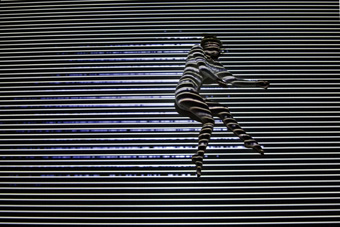
Kristy Ayre, Glow, Chunky Move
photo Rom Anthonis
Kristy Ayre, Glow, Chunky Move
“Utilising the latest in interactive video technologies a digital landscape is generated in real time in response to the dancer’s movement. The body’s gestures are extended by and in turn manipulate the video world that surrounds it, rendering no two performances exactly the same.” Chunky Move
Glow is an intimate, 26-minute virtuosic solo dance work that excited Melbourne critics and audiences with its magical ‘biotech’ evocation of the human body as an evolving creature. The work, created for Chunky Move by artistic director Gideon Obarzanek and German interactive software creator Frieder Weiss with music and sound design by Luke Smiles, offers audiences, looking down on the dancer, the chance to experience the very latest in the perceptual interplay between artist, technology and audience. Glow is part of The Studio’s program for the first half of 2007 which also includes Meow Meow, Unreasonable Adults, Yumi Umiumare and Antje Pfundtner.
–
Chunky Move, Glow, The Studio, Sydney Opera House, March 21-25
RealTime issue #77 Feb-March 2007 pg. 36
© RealTime; for permission to reproduce apply to realtime@realtimearts.net
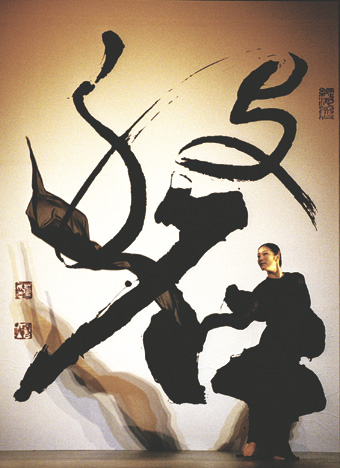
Cursive, Cloud Gate
photo Liu Chen-hsiang
Cursive, Cloud Gate
TWO TERMS EMERGE WITH PARTICULAR PROMINENCE WHEN TALKING TO CHOREOGRAPHER-DIRECTOR LIN HWAI-MIN ABOUT HIS TRILOGY DEALING WITH CHINESE CALLIGRAPHY, CURSIVE, CURSIVE II AND WILD CURSIVE. THESE ARE “BREATH” AND “SPACE.” THE EXPANSION AND CONTRACTION OF THE BODY AND OF SPACE, OF VESSELS FILLED WITH ENERGY AND EMOTION AS THEY SWELL TO THE POWER OF PROPULSIVE RHYTHMS OR MEDITATIVE PAUSES—THESE ARE THE THEMES OF LIN’S THREE-PART WORK WITH TAIWAN’S CLOUD GATE DANCE THEATRE.
Cloud Gate has toured the Australian festival circuit several times (Adelaide 1998, the Olympics 2000, Melbourne 2003 and Brisbane 2006) and is returning in 2007 to present Cursive (Adelaide Festival Centre) and Wild Cursive (Perth International Arts Festival). Lin’s conceptualisation of the trilogy is broadly Expressionistic. Rather than “imitate the shape” of various calligraphic characters using “gestures and movements”, Lin’s approach is based on “the essential thing which the aesthetics of Chinese calligraphy and movement share.” This essential, expressive character is to be found in a particular sense of energy and how this energy is channelled and manipulated—as in calligraphy and the physical training method of Tai-Chi Dao-Yin.
Calligraphy and much of Chinese courtly aesthetics developed in conjunction with the religious and philosophic systems of Daoism, Confucianism and Buddhism, in which calligraphy and landscape painting were designed to complement and encourage a meditative state comparable to that of Tai-Chi itself. Where Lin speaks of energy, he is referring to the Chinese concept of chi, in which the exchange of force between objects, individuals, spaces, and regions of the body must be in a harmonious state of dynamic flux for true beauty and mastery to be realised. Painting, writing and dancing become, in a sense, a form of meditation. The most visible manifestation of chi within the body is breath. As a result, much of Tai-Chi and Lin’s choreography revolves around different forms of embodiment produced through inhalation, exhalation and sustained breath—including the dancers’ vocalisations for the final, freest work in the trilogy, Wild Cursive. Lin notes that this piece is “about calligraphy, but perhaps in the end, it is even more about breathing. The whole stage is breathing.”
This model of the universe in a state of dynamic flux also influenced Western aesthetics. John Cage developed his approach to chance and silence after consulting the Daoist I Ching (The Book of Changes), a text which both Merce Cunningham and Lin drew upon for their dance. Lin’s reference to “the stage breathing” also allies his style to associated trends such as Performance Art and Actionism. In all of these forms, art became increasingly associated with a sense of process—with a form of cosmic evolution or immaterial, temporal development which could only be fully manifest through durational activities—rather than with a more contained concept of art such as that represented in a completed painting.
In language reminiscent of the Happenings of 1960s New York, Lin explains that “The set of Wild Cursive is like an installation. There are 10 reams of white paper. They take turns being lowered in or taken out.” Ink-dispensers are located above each sheet so that “the audience sees how the ink travels down the paper. It took almost 10 months to develop, because with ordinary rice-paper, with gravity, ink will take only 30 seconds to travel through 10 metres of paper. We had to create a special kind of paper which makes it harder for the water and ink to travel, so that it would produce these different kinds of shading. We also use different mixtures of water to make it come out light or black.” Just as the dancers’ sinuous, abstract movements create a dynamic interaction between the empty spaces on stage and those which the bodies occupy, so the falling ink produces a complicated interplay of positive and negative space. It is in this sense that “the whole stage is breathing.”
Lin notes that “in Chinese landscape painting, the blank space is just as important as the spaces occupied by the ink. So there are gaps or empty spaces between the movements, and empty spaces on stage”—just as there are aesthetically significant regions of white on the abstract, inked sheets hanging into the venue. Lin observes that Wild Cursive is particularly concerned with the calligraphic style of Kuang Chao or “what is considered the pinnacle of all forms of calligraphy, in which the writer does not have the mission of conveying a meaning through the characters. Instead, they are distorted into an individual expression. They are abstract, almost like a Jackson Pollock painting.” Like Pollock’s 1950s works, the choreography and the ink mediate between the charged void of the blank canvas, brimming with potential, versus powerful marks of personal expression.
Given Lin’s interest in creating evocative gaps between an affectively resonant stage space and equally emotive moving bodies, it is unsurprising that—like Cunningham—Lin draws on the aesthetics of John Cage. Cursive II is accompanied by Cage’s recordings, while Wild Cursive is performed to various sampled sounds (“ocean waves breaking onto a rocky beach, wind, cicadas, temple bells”) which Lin claims is “even more organic than Cage’s own music.” Many of Cage’s works include lengthy periods of near or total silence, as well as unusual timings and extended pauses. “The reason I chose Cage,” Lin explains, “is because of his energy. His breathing is so long. So we found a very comfortable stream in his music: long breathing. It goes on, and on and on. There is no metric form, as in 1,2,3, 1,2,3, that kind of rhythm. In the wait, you observe and you approach the music, just as you do in calligraphy—which is really an expression of how you feel. So we can draw things out. Cage’s music allowed us that space.”
Some critics have suggested that modern art should be read as reflecting an interplay between the so-called “unformed” and actual form itself, between a chaotic dissolution of art and an attempt to clearly delineate abstract shapes, lines, colours and aesthetic approaches (as proposed by the curators of the 1996 Pompidou exhibition Formless: A user’s guide). Given Lin’s interest in the dynamic relationship between those lines created by bodies and by brushstrokes and those empty spaces between these lines, one must ask if there is in fact a particular aesthetic form at play in these pieces, or if Lin’s choreography also dissolves into a kind of irresolvable haze of ink and paper akin to Pollock’s densest stains. Lin is however adamant that there is a recognisable form governing the trilogy. Viewing Cursive II, it is apparent that, for all of Lin’s interest in calligraphic abstraction and Tai-Chi, he remains committed to those classical forms which he was trained in—notably ballet and various styles of Asian courtly dance. While Lin Hwai-min is reluctant to describe his aesthetic in terms of such bodily shapes and poses as one finds in classical dance, he nevertheless concedes that his choreography is concerned with “the spiral. Even in ballet, while it’s very straightforward and direct, when you are lifting up an arm, the energy starts from a circular movement, and you come out with a spiral inside—just like a bullet comes out from a gun.” It is this sense of spiralling energy that underpins Lin’s aesthetic vision.
Cloud Gate Dance Theatre, Wild Cursive, His Majesty’s Theatre, Perth Festival Feb 19-21; Cloud Gate Dance Theatre, Cursive, Festival Theatre, Adelaide Festival Centre, Feb 13-14 www.cloudgate.org.tw
RealTime issue #77 Feb-March 2007 pg. 38
© Jonathan Marshall; for permission to reproduce apply to realtime@realtimearts.net
AS I SIT IN MY BRIGHT-BOX, DAY-LIT ROOM, LOOKING OUT ON THE GREENERY OF THE GARDEN, I DO WHAT ALL REVIEWERS DO: REFLECT ON THE SPACE BETWEEN THE LIFE WE LIVE AND PERFORMANCES WE SEE. LIKE ALL THINGS OF SIGNIFICANCE, THE PIECE I’VE SEEN ALMOST BY CHANCE, BY A RARE ACT OF GRACE AT THE AUSTRALIAN CHOREOGRAPHIC CENTRE, QUESTIONS AND SEWS STITCHES BETWEEN ONE PLANE AND ANOTHER, BRIGHT-BOX TO BLACK, OUTSIDE TO INSIDE HOURS.
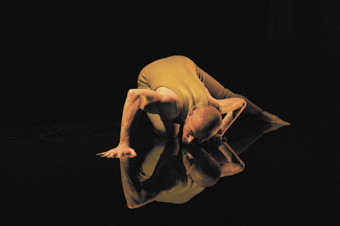
James Cunningham, Mirage
photo Suzon Fuks
James Cunningham, Mirage
I remember Mirage as an act of bravery, which begins with the challenge of remapping the scope of movement after serious injury. It ends as a gift—a message of potentials and transformations. A deep reflection on human re-creative capacity.
James Cunningham, a dancer who initially trained in Adelaide in the late 1980s, almost totally paralysed his left arm in a motorcycle accident in 1992. In many ways, Mirage is the culmination of his search to restore both self-identity and movement capability, but as a theatrical experience it amounts to much more than this narrative journey.
The company Igneous, formed in 1997 by the partnership of Cunningham and Suzon Fuks, a Belgian multi-disciplinary artist, has produced several major works and showings. Moving from their pivotal productions, Body In Question (1999) to Thanatonauts: Navigators of Death (2003-4) and Liquid Skin (2005), dance video works and international workshop collaborations, Mirage bears witness to an evolution and maturing of their practice, and the transformation of the idea of “the body” as a singular site and subject.
Body In Question housed the emotionally moving narratives of accident and recovery. Cunningham’s personal story was written like a diary on the video-screen. His manouevrings of a life-sized puppet, unfolding from his knapsack, seem now to be preliminary investigations into the way mind and body form and re-form through processes of mirroring, unfolding and re-patterning.
Mirage takes those ideas into a more abstracted realm that is paradoxically even more immediate for the viewer. This is the extraordinary contradiction of arts practice: the deepest re-patternings, interior to the body are individual yet also profoundly transcendent of personal story.
Alison Ross’s installation design houses a mirror-pool. Cunningham’s body and joints kiss water as his movements recount the journey from paralysis through mirroring back into movement. This is the principle of the mirror-box, a discovery of neurologist Vilayanur Ramachandran: through mirroring what still moves, the body can unparalyse. This restorative process both questions the “reality” of permanent injury, as well as the “reality” of the body. If an act of looking can re-move permanent paralysis, is the body’s self-identity thus also an illusion, a mirage? Glimmers in the water multiply the performer, but also catch the lookers looking. The meshed pyramid which Cunningham lifts and manoeuvres is a strange prop—a prophylaxis, rather, serving as screen for projected body-images, sometimes also a hiding-cave, also an MRI machine, but always more than any of these. Critically, the multiplied images reflect on another of Ramachandran’s discoveries: that the capacity to reach across sense-impressions (synaesthesia) is the very element that helps humans to evolve, to move beyond what is. This is where Mirage critically, joyfully perhaps, reflects on the deepest artistic and neurological recognitions.
There is thus a significant transformation of the dualistic self/other, puppet/dancer relationship of Body In Question to a triangular relationship between I/you/the transcendent or in-between. Sound artist Andrew Kettle points to hermetic traditions (specifically, the Tabula Smaragdina: “The Stone is One . . . out of one substance the Sages obtain our remedy”) and the significance of metaphysics to his compositional process. His contribution is “a tonal meditation on anatomical measurements of the dancer’s body transmuted through prayer.” No sound is literal, and yet one senses the bodily form out of which the composition has evolved. Visually, Morgan Randall’s lighting design allows the performer’s body to dissolve and re-solve. Alchemical re-making.
At its heart, this is a work that actually cares for and about the body, for and about the performer, but also the spectator/audience, and in a larger sense, the human condition, allowing for the fact that seeing, listening, witnessing, are themselves alchemical processes. I felt an exhilaration in watching this work.
And that rare experience: what it costs to watch, and think and be in watching, is rewarded by a message much larger than the performance.
Igneous, Mirage, dance performance and installation, directors Suzon Fuks, James Cunningham, performer, choreographer James Cunningham, video artist Suzon Fuks, set design Alison Ross, sound artist Andrew Kettle, lighting Morgan Randle; Australian Choreographic Centre, Canberra, Nov 16-18, 2006. www.igneous.org.au
RealTime issue #77 Feb-March 2007 pg. 37
© Zsuzsanna Soboslay; for permission to reproduce apply to realtime@realtimearts.net
QUÉBEC ARTIST DIANE LANDRY’S WORK INVOLVES EVERYDAY OBJECTS AND GADGETS, BUT SUGGESTS A LONG-HELD INTEREST IN THE ORIGINS AND POWER OF MOVING PICTURES, AND EXPOSES THE WAY CINEMA HAS CHANGED THE NATURE OF PERCEPTION.
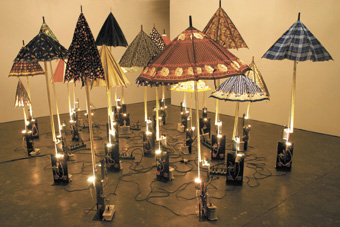
Ecole d’aviation (Flying School), Diane Landry
photo Tim O’Donoghue
Ecole d’aviation (Flying School), Diane Landry
For her performance, Morse Alphabet Soup, at RMIT University Union, Landry set up two turntables in front of the stage. Each is a large, slowly revolving pizza tray, on which she places a variety of objects in a planned sequence. A single bright light located behind each turntable projects a silhouette of the otherwise innocuous object on the turntable onto the auditorium’s blank cinema screen, creating a shadow puppet theatre. The objects—stencils used for lettering, egg-timers, drinking glasses, toy buses, dolls, a tiny bicycle and toy animals including rats positioned to suggest copulation—are selected for their symbolic power. Placed on the trays for a few seconds to a minute in a series of shifting superimpositions and juxtapositions, they create a darkly symbolic language addressing broader social realities.
Each turntable is equipped with a handmade phono arm and a stylus as large as a sewing needle in contact with the turning tray, sending a scraping sound through a multi-channel mixer to the auditorium’s PA. Landry complements the imagery by varying the sound-mix from screeching to moaning—it’s as if society is grinding itself to death. Parodying a DJ or a VJ, she blends objects, light and sound into a powerful cinematic experience. In her artist’s statement she discusses how projecting a silhouette to enlarge an object amplifies its presence and meaning and prompts a re-evaluation of the material world. She coined the phrase ‘oeuvre mouvelle’ to describe her work, noting that, like a piece of music, the work unfolds over a period of time and cannot be absorbed quickly.
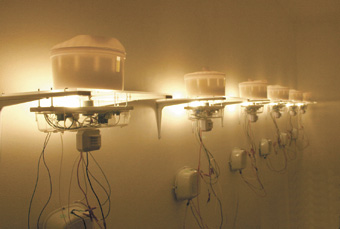
Je ne trouve pas ma montre, elle ne s’est pourtant pas envoiée’ (I can’t find my watch yet it hasn’t flown away)
photos Tim O’Donoghue
Je ne trouve pas ma montre, elle ne s’est pourtant pas envoiée’ (I can’t find my watch yet it hasn’t flown away)
Landry’s exhibition at Bus included three works that further attest her passion for robotics but also explore the nature of perception. Ecôle d’aviation (Flying School) comprises 20 umbrellas that open and close, the lights beneath them casting shadows like slow-moving clouds on the white gallery ceiling. Accompanied by a gentle sighing from the little electrically driven air pumps that activate each umbrella, this slow, mechanical unfolding of silhouetted forms projected into the room becomes a metaphor for our programmed, repetitive lives.
Je ne trouve pas ma montre, elle ne s’est pourtant pas envoiée (I can’t find my watch yet it hasn’t flown away) comprises 6 electrically-driven salad spinners mounted chest-high on a wall, each activated by a movement sensor and revealing, through a tiny aperture, glimpses of fragments of photos of someone going about her daily routines. In her notes Landry refers to the early 19th century parlour device, the Zoetrope, which preceded the birth of cinema and which demonstrated persistence of vision, or how the eye is tricked into seeing movement in a rapidly changing sequence of still images. The viewer gleans a ‘story’ from the imagery in the salad spinners that, ironically, is only triggered by the movement sensors. Landry’s use of vernacular found objects such as toys, salad spinners, surveillance devices and umbrellas, reconnects us to the everyday world and also shifts the work away from high art and cinematic traditions.
But perhaps Diane Landry’s most engaging work is Le bouclier perdu (The lost shield), a video of a woman (the artist) apparently tossing and turning in disturbed sleep on a couch. The video is constructed from a series of still photographs shown in a sequence of superimpositions and dissolves that disrupt the normal cinematic illusion of seamless movement. This artificial portrayal of broken, dreamy sleep becomes a metaphor for the inauthenticity of photography and cinema.
By recalling the work of moving picture pioneers such as Muybridge and the Lumière brothers, Landry’s work reveals how the moving image has been used to structure our perceptual awareness and understanding. Her work questions the impact of the persistence of vision to address the nature of visual comprehension and its relationship with emotional memory, highlighting our tendency to imbue the imagery that flashes before our eyes with narrative meaning and intent. By showing us how easily illusions can be created, we are prompted to see through our visual world and to acknowledge that the ‘truth’ we deduce from what we see may be a trompe l’oeil, a projection of our emotional state or a figment of our imagination.
The RMIT evening also included a performance by sound artist Ernie Althoff, a sound/video performance by Snawklor and Dale Nason, and the screening of Pia Borg’s great new video, When Objects Dream, all of which, with Landry’s work, neatly complement each other.
Diane Landry, Morse Alphabet Soup, RMIT University Union Kaleide Theatre, Dec 9; Bus, Melbourne, Dec 12-23 Dec 2006 www.clic.net/~dilandry
RealTime issue #77 Feb-March 2007 pg. 54
© Chris Reid; for permission to reproduce apply to realtime@realtimearts.net
ash keating
<img src="http://www.realtime.org.au/wp-content/uploads/art/3/301_vb_ashkeating_.jpg" alt="Ash Keating, Work in Progress—
interception of PVC sticker waste, 2006 “>
Ash Keating, Work in Progress—
interception of PVC sticker waste, 2006
courtesy of the artist & Dianne Tanzer Gallery,
photograph Russell Kitchin
Ash Keating, Work in Progress—
interception of PVC sticker waste, 2006
Melbourne visual artist Ash Keating integrates his commitment to environmental issues with his art strategies. These vary from process-based projects, public art and performance to murals and installations. His stoush with Juliana Engberg early last year over the artist’s aesthetic “interception” of black and white sticker and vinyl text waste from ACCA’s Barbara Kruger exhibition (“an attempt to draw attention to the collusion of artists and art institutions in our environmental crisis”, according to Keating) chalked up some column inches. Grist for the mill for the artist who, as it turns out, recycles newsprint creatively too, finding a use (where no other can possibly exist) for copies of the Murdoch freebie, mX (30,000 of them) in yet another performative installation (250 Hours Work for One Person) in which he cut out the shapes of 6500 Australasian gannets from their pages to later release in a gallery.
The video of the performative removal of the ACCA waste—now officially a work in progress—has been exhibited on a monitor placed within the pile. Adding Commonwealth Games detritus to the mix, Keating later materialised as a performative waste creature within it. Documentation of this incarnation was exhibited in January in the Dark Portraiture exhibition at Perth’s Centre for Contemporary Photography’s curated by Kieran Stewart in an enterprising strategy to show the work of Melbourne artists in the first three years of their practice outside their state of origin.
Ash Keating recently joined 11 other Australian & New Zealand artists in Trans Versa at the Museo de Arte Contemporaneo in Santiago, Chile, as part of The South Project—a Craft Victoria based initiative. As well as releasing his newsprint gannets in the gallery he also collaborated with local artists in creating an installation protesting the proposed relocation of the Pascua Lama gold mine.
In his new work, Parched, Keating has painted a wall of water on the timber panels erected on the site of Melbourne’s Mockridge Fountain, de-activated due to current water restrictions. The artist intends to regularly revisit the site over the three months of its installation (Jan 6-March 31) to record the falling water levels by over-painting with lime paint, “evocative of the mud of drying dams” and reflecting the depletion of Victoria’s precious water reserves over the summer period.
“In a subtle, understated way Parched aims to remind us of our precarious relationship with nature. We may be able to paint water, but we can not conjure up the real thing.”
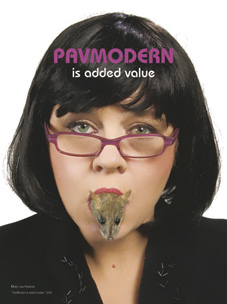
Rat Woman from Pavmodern is Added Value
photo Mary Lou Pavlovic
Rat Woman from Pavmodern is Added Value
mary lou pavlovic
Always interesting to receive a missive from Mary Lou Pavlovic announcing her latest guerilla artwork. Pavlovic has used billboards and skywriting and staged performances outside several of Melbourne’s leading art venues questioning the relationship between art and sport. In 2001 she famously recreated, amongst a series of ironic works, the execution bed of Timothy McVeigh and encased the structure in tiny, hand-painted balls to resemble hundreds and thousands. Having decided to include this work in a segment on the artist, ABCTV then took a swift detour and censored it. In retrospect, says Pavlovic, “I couldn’t believe when I got back to Australia after living ten years abroad what passed for serious political art in the commercial scene here. If it was genuinely confronting it didn’t get a look in (Andre Serrano at the NGV being closed down a good example.) But if it was aestheticised in some way—watered down—then middle-class people seemed to be genuinely moved because they could cope.” Pavlovic also organised the 2004 Jake Chapman Lecture tour after the National Gallery of Australia’s refusal to take the Sensation Exhibition in which Chapman’s work featured.
In January Pavlovic’s Pavmodern Museum launched its brand, taking a full-page advertisement in the January-March edition of Australian Art Collector magazine, the issue, which annually features “Fifty Most Collectable Australian Artists.”
“The work is an artist’s comment about outside systems that place value on artists and their work, on artworld hierarchies … dodgy art world politics…” Pavmodern Museum is an attempt to define a space where these sorts of issues can be raised. A museum without walls.” (Pavmodern press release)
Apparently, there has been an unprecedented demand for the Collector since investors got wind you could pick up a Pavlovic for $18.95. RT
RealTime issue #77 Feb-March 2007 pg. 52
© Virginia Baxter; for permission to reproduce apply to realtime@realtimearts.net
FORMALLY TRAINED AS A COMPOSER AT ADELAIDE'S FLINDERS STREET SCHOOL OF MUSIC, TRISTAN LOUTH-ROBINS WENT ON TO COMPLETE AN HONOURS DEGREE WITHIN THE ELECTRONIC MUSIC UNIT (EMU) AT THE UNIVERSITY OF ADELAIDE. DURING THIS TIME HE GREW INTERESTED IN PHASE RELATIONSHIPS AND THE IMPACT OF PLAYBACK TECHNOLOGY ON COMPOSITION. HE CITES THE ALBUM ZAIREEKA BY THE FLAMING LIPS AS THE INSPIRATION FOR HIS THESIS RESEARCH.
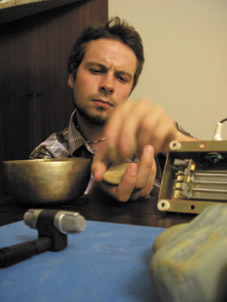
Tristan Louth-Robins
Created by playing four CDs simultaneously, Zaireeka, he explains, is a generative composition “utilising the technical features and potential of the technology—CD players—in order to create phase relations: either by accident or the inherent characteristics of the technology.”
This fascination with ‘accidental’ music and phase relationships led to a creative partnership with sound-artist Sebastian Tomczak. Together they formed The Glitch Collective, a loose ensemble of sound artists and musicians gathering to produce a series of spontaneous compositions using pre-recorded material: “We wrote the first couple of scores very much in the vein of the early Fluxus scores of the 1960s; very text-based. The first one we did was Glitch: a free-for-all which lasted an hour, where we were each assigned to write one minute of any sound material we wanted.” The result surprised its makers: with contributions variously at high pitch or low frequency ranges and with multi-tracking of all the sounds there was “a wonderful fullness [that] coloured the environment…We found that each of the sounds would fall in and out of synch with each other because the repeat times on the CD players are different. So that’s how you create phase relationships.” He thinks that general listener finds the result pleasing “because it’s made up of these little musical ostinatos.”
The basic principal of phase relationships used in Glitch, he notes, was also the one employed by Brian Eno to produce Music for Airports, composed from phasing loops of pre-recorded material on magnetic tape, cut to different lengths and therefore cycling at different rates. Eno created the piece in order to counter the impersonal nature of airports. Environments, whether built or natural, and their sound qualities and aural ecology, is a growing interest for Louth-Robins.
In a recent collaboration with the SHOOT collective, Louth-Robins produced the sound score for their video installation, Sounds from Level Four, an ominous piece about paranoia and social confinement using the central motif of an elevator to induce the feeling of claustrophobia and controlled movement. The sound moves from complex rhythms of cut-up vocals through to hydraulic elevator sounds, blistering glitches and sweet machine-like harmonics.
“The conceptual process…took quite a long time…probably close to three to four months developing an idea of how we would marry the visual and sound elements. I didn’t produce any sound per se until two months before it was first exhibited. I wasn’t necessarily gathering lots of audio samples and sticking them together and seeing how that sounded. If anything I was just writing down words that I would associate with the video and trying to find some kind of parallel to a sound or particular atmosphere.” On the issue of ‘machine aesthetics’ he was particularly pleased that he had created the score without relying on reverb. “I’d grown to hate an over-reliance of reverb in order to create the impression of space. I think there are other ways that you can evoke space.”
I had always attributed this penchant for reverb to the ‘wall of sound’ introduced by Phil Spector. Louth-Robins claims a later, far more sinister origin: “I think it’s partly to do with Phil Collins inventing the drum reverb in the 1980s. It’s that snare reverb. You listen to anything from the 1980’s and it’s there in some capacity.”
Louth-Robins is currently extending his interest in environmental sound design, using composition as a way of crossing over into ecology, influenced partly by his meeting with environmental musician and sound artist Robin Minard: “I was fortunate enough to meet Robin at the start of 2006 when I was involved with Michael Yuen’s Project 3, and spent some time with him setting up his Silent Music installation. My current interest is in natural phenomena and sound’s relationship to them, which is inextricably tied to the work of Alvin Lucier and Rolf Julius.” It also relates to the ideas of sound theorist and ecologist R Murray Schafer.
“Schafer looks at the particular characteristics of a natural environment, referring to these as sound marks: sounds that characterise the environment in a particular way. If you were to go down to a lake and hear the continuous sound of crickets and the intermittent chirps of birds, the water [lapping], they are always going to be there to a certain extent. What Schafer did was to start mapping these things out over the space of a year, so he could track the migratory patterns of the birds, or if the wildlife was diminishing or moving somewhere else.
“I’m specifically interested in the relationship between natural and industrial sounds. Such investigations involve making field recordings of various environments and assimilating excerpts into a collage, installation or [other] context. They stem from two main sources: the continuum of ambient sound—such as wind sounds and machine drones—and more instantaneous sounds which are characteristic to an environment, such as the croaking or frogs or a passing tram. This creates an interesting juxtaposition of sound sources and evokes a sensation, what writer David Toop [citing Schafer] describes as ‘schizophonia’, essentially sounds displaced from their point of origin. This is nothing new in terms of hearing transmitted or recorded sounds over the radio etc, but the displacement and juxtaposition of environmental sounds can significantly alter a listener’s perception. I am looking to apply this idea in an installation sometime over the course of the year.”
While interested in the objective appreciation of environmental sound, Tristan Louth-Robins says he is “still keen though on the idea of putting some kind of subjective intention into my work. I think maybe I’m just a little too much of a traditionalist. But if you put too much subjectivity into a piece—particularly a site specific installation that articulates a particular environment—then you can cloud the audience response with too much musical information.”
Glitch Collective archives: www.geocities.com/glitchtogether/
RealTime issue #77 Feb-March 2007 pg. 50
© Samara Mitchell; for permission to reproduce apply to realtime@realtimearts.net
THE ADELAIDE-BASED ZEPHYR QUARTET IS CARVING A NAME FOR ITSELF WITH AN AMBITIOUS PROGRAM OF PERFORMANCES THAT INCLUDES A FEW STAPLES OF THE STANDARD REPERTOIRE, A LOT OF NEW MUSIC MORE OR LESS TRADITIONALLY CONCEIVED FOR QUARTET, AND WORKS INVOLVING ELECTRONICS (RANGING FROM TECHNO TO EXPERIMENTAL), IMPROVISATION AND FORAYS INTO VARIOUS ETHNIC AND POPULAR GENRES.
<img src="http://www.realtime.org.au/wp-content/uploads/art/3/304_whittington_zephyr.jpg" alt=" Belinda Gehlert, Emily Tulloch,
Anna Webb and Hilary Kleinig, Zephyr Quartet”>
Belinda Gehlert, Emily Tulloch,
Anna Webb and Hilary Kleinig, Zephyr Quartet
photo Steven Donovan
Belinda Gehlert, Emily Tulloch,
Anna Webb and Hilary Kleinig, Zephyr Quartet
In the world of classical music the string quartet has accumulated more intellectual prestige than any other genre. Invented by Haydn and perfected by Mozart, its primal form was the perfect musical embodiment of Enlightenment ideals. Abandoning Baroque rhetoric of public address, the quartet became the intimate conversation of equals in which rational argument and wit were the principal virtues. The equality of the four instruments accorded with the emerging ideals of liberal democracy, representing a condition that all might aspire to, given the appropriate education—that of the cultivated, enlightened individual, engaged in harmonious social intercourse with like-minded equals.
The 19th century hijacked this ideal in the name of Romantic individualism, giving it an altogether more emotional hue. The Romantic cult of Beethoven did much to place the string quartet at the pinnacle of the musical pantheon. Beethoven’s late quartets became a cornerstone of the myth of the heroic, misunderstood artist that Beethoven personified. And the quartet has remained, essentially unchallenged, at that pinnacle ever since. In Australia, the string quartet has flourished under the patronage of Musica Viva, an organisation largely founded by post-War refugees from central Europe, with a subscriber base drawn from the professions, the educated middle classes and a wealthy elite. Most quartets touring the country under the Musica Viva banner are imported; Australia has rarely, if ever, managed to support more than two full-time, professional quartets at any given time. Even now, following the Byzantine intrigues that have led to the former Australian String Quartet becoming the Grainger Quartet and the former Tankstream Quartet becoming the Australian String Quartet, it is by no means certain that both ensembles will survive for the long haul.
Traditional classical ensembles of all kinds from the orchestra down face a struggle for survival, and are trying in many cases desperately to re-invent themselves for a cultural landscape that has radically changed in the past couple of decades. A significant broadening of the repertoire—some would call it dilution—including a rapprochement with popular music, has been the most popular survival strategy. Australia’s newly privatised symphony orchestras provide good examples of this process at work.
Zephyr Quartet consists of Belinda Gehlert and Emily Tulloch (who rotate as first and second violins), Anna Webb (viola) and Hilary Kleinig (cello). At least two of the players (Gehlert and Kleinig) have also composed for the ensemble. In the course of 2006, the Quartet has shown itself to be as inventive with its venues as it has with its programs, appearing at a commercial art gallery, an inner-suburban pub, a city club, a bar in Adelaide’s sin strip and the rehearsal studio of a contemporary dance company.
The biggest challenge facing classical ensembles who want to embark on this sort of path is that nothing in their training has really prepared them for it. The road to becoming a quartet is difficult enough, given that much classical musical education is predicated on the paramount importance of the soloist; a deep understanding of the essence of chamber music is often relegated to a relatively minor part of the curriculum. Beyond that, few institutions would give classical string players any more than token exposure to jazz or popular music, teach them anything more than the most rudimentary techniques of composition, train them in any form of improvisation, or equip them with skills to handle new technologies. Poorly served by an educational ethos inherited from the 19th century, young musicians of the 21st century are compelled to find their own way.
Michael Nyman’s String Quartet No.2 was the major work in Zephyr’s Musica Viva Menage Concert Series outing, From Tango to Techno, in the Leigh Warren and Dancers Studio (Sept 14). It was the only work on the program to involve dancers, and was performed in the round, with the Quartet also changing positions for each movement. The choreography of dancers and musicians formed an intriguing, visually engaging counterpoint to the characteristically frenetic music of Nyman. The quartet playing was rhythmically strong though a little wayward in intonation.
A couple of techno pieces in that program (by Gehlert and Kleinig) set the scene for a more extensive collaboration with electronics when Zephyr appeared at the Rocket Bar in Hindley Street in their Electro-Acoustic Project (Sept 29). The composers this time included Zoë Barry, Cameron Deyell, Fiona Hill, Stefan Panczak, Brendan Woithe, Michael Yuen and Kleinig. The music was stylistically diverse, ranging from a strongly conceptual piece by Yuen through to a techno-influenced work from Stefan Panczak. The use of technology was well short of what is currently possible, particularly in terms of interactivity and real-time processing. The players were also obliged to listen more closely to the electronic tracks they had to play with than to one another. As so often happens (from Kronos Quartet to pop-classical girl group Bond, the story is much the same) the ideal of chamber music as an intimate discourse between individuals was largely lost when amplification, technology and the performance practice of popular music took over.
That ideal made a bit of a comeback at Zephyr’s next appearance, Generation Next, at the Jade Monkey (Oct 19), a rather pleasant little club in a quiet side street in the city centre. A diverse collection of works by Adelaide composers Jamie Messenger, Anne Cawrse, Melisande Wright, Angus Barnacle, Luke Altmann and Tristan Coleman provided an opportunity to ponder different contemporary approaches to the medium. Young composers seem to regard the quartet as a palette of sounds rather than a social microcosm and the dynamic potential of the quartet medium was only superficially explored for the most part. Nonetheless, it was an interesting evening, with solid performances and a few pieces—such as that by Luke Altmann—that sought to probe some emotional depth.
Zephyr Quartet is an adventurous young ensemble, though there are limits to their adventurousness, and I don’t expect to hear them playing some genres of highly demanding and complex contemporary music. They are more at home in the world of minimalism, neo-tonality and crossover genres. They are certainly performing a valuable service for Adelaide composers, and are providing audiences with varied and at times provocative listening experiences as they explore possible directions for classical music’s most venerated ensemble.
Zephyr Quartet’s 2007 program includes: Homegrown—The Music of Annne Cawrse a celebration of music composed by Cawrse for Zephyr, Carclew Arts Centre, March 30; between music, place, memory and emotion: folk songs and new compositions by Hilary Kleinig and Belinda Gehlert inspired by the work of Adelaide-based Iraqi-born poet Yahia Al-Samawy, with percussionist Tim Irrgang, Nexus Cabaret, Lion Arts Centre, July 6; Sight Specific Music: Phillip Glass String Quartet No 2 and new commissions composed by Graham Dudley and James Cuddeford, Greenaway Art Gallery, Oct 26, 28 www.zephyrquartet.com
RealTime issue #77 Feb-March 2007 pg. 49
© Stephen Whittington; for permission to reproduce apply to realtime@realtimearts.net
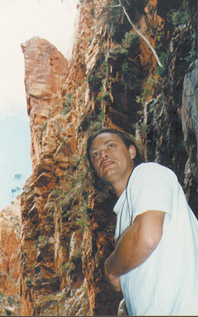
Michael Riley
MICHAEL RILEY IS PRIMARILY KNOWN AS A PHOTOGRAPHER, SO IT’S NO SURPRISE THAT HIS BEST KNOWN FILM, EMPIRE (1997), IS ALSO THE ONE MOST OBVIOUSLY ALIGNED WITH THE STYLE OF HIS LATE STILL PHOTOGRAPHY. YET IT IS THE LESSER KNOWN HALF-HOUR DOCUMENTARIES RILEY MADE FOR SBS AND THE ABC THAT HAVE HAD THE MOST SIGNIFICANT IMPACT ON THE DEVELOPMENT OF AUSTRALIAN INDIGENOUS FILM.
The Australian National Gallery retrospective, Michael Riley: sights unseen, provides a rare opportunity to consider Riley’s screen work alongside his stills and brings to light some surprising correlations. Both his films and photographs employ a broad spectrum of styles, but the exhibition reveals no clear cut division between his work in the two mediums. Rather, it creates the impression of two distinct strains that cut right across Riley’s entire artistic output. On the one hand his portraiture and documentaries rely primarily on the camera’s relationship to the physical reality before the lens—the look in a subject’s eyes, the way they hold themselves, and the stories they relate to the camera. On the other hand, Riley’s more overtly abstract work relies heavily on the relationship between deliberately ambiguous images, the symbolic resonances of collected objects and the formations of the natural world.
Empire (1997) epitomises the latter strand of Riley’s oeuvre. Originally commissioned for the Festival of the Dreaming program in the lead up to the 2000 Sydney Olympics, the film went on to appear in exhibitions and arts festivals around the world. Opening with a giant eye superimposed on a cloud-specked sky, Empire unfolds as a series of images depicting the Australian landscape as a parched country devoid of human presence. Animal skeletons lie stripped and scattered on the ground; an echidna’s corpse is beset by swarming ants; a windmill spins forlornly beside two water tanks, incongruous in a land without moisture. Towards the end of the film remnants of a decaying colonial dream appear: a weather-beaten Union Jack flutters across a blue sky, a mirrored crucifix reflects passing cloud, and a burning cross evokes the dark side of the colonial project. Finally, the camera rests on a tacky ‘noble savage’ figurine of an Aboriginal man. A disembodied voice from a newsreel or ancient radio broadcast crackles in a polite British accent that belies the culturally genocidal implications of the words: “Keeping untouched natives away from white settlements where they would perish like moths in a light, replacing…their ancient beliefs…with a higher faith—the Christian faith. Training them in a benevolent segregation…gradually to make them fit into an Australian community.”
Like the concomitant photographic series, Flyblown, Empire explores the impact of European invasion on the Australian continent and its people, but unlike the photographic series, the film also illustrates the way in which Riley’s more symbolist tendencies could become heavy-handed when rendered on screen. A series of photographs can be viewed, digested and returned to in any order, creating between them a site of floating exchange crucially informed by the viewer. In Empire the images are inevitably fixed; their interpretive potential can feel foreclosed. However, it is the film’s overbearing and self-consciously ethereal music that does most to make Empire’s air of mystery feel laboured, reinforcing the sense that for all the images’ indeterminate nature, our reading is being firmly guided.
For me, Riley was more effective as a filmmaker when exploring his documentary bent in films like Blacktracker (1996), Tent Boxers (1998) and Quest for Country (1993). These typify the rehabilitative historical impulse underlying much of Riley’s documentary work. In different ways, they all seek to unearth the buried threads of Indigenous experience woven into Australia’s social, cultural and political history.
Blacktracker was made for ABC TV and examines the life of Riley’s grandfather, who served in the NSW police force from 1911 to 1950. Rising to the rank of sergeant, Alec Riley became one of the best known trackers in the country. He was instrumental in solving at least seven murders and located many people lost in the bush during his time on the force. Despite relying a little too heavily on re-enactments to make up for an absence of relevant historical footage, Blacktracker succeeds admirably in bringing Alec Riley’s story to life and portraying a warm and sensitive man who “achieved in a time of extreme adversity.” It is a positive story, but one tempered by the times in which Alec Riley lived. According to his descendants, for example, he was never awarded a police pension, despite making contributions to the pension fund throughout his working life.
The prejudices Tracker Riley encountered also adversely affected others, a point tragically illustrated by the case of a two-and-a-half-year-old boy named Desmond Clarke who went missing in the Pilliga scrub in the early 1930s. Riley was summoned to assist in tracking the boy down but his grandfather “didn’t want any blacks on his property.” Consequently the search party was unable to find the missing child. A year later the boy’s grandfather passed away and Riley returned to the area; within 12 hours he had located Desmond’s remains in a chalk pit 500 metres from the family homestead. This story later provided the inspiration for Rachel Perkins’ film One Night the Moon (2000).
Two years after Blacktracker, Michael Riley made Tent Boxers for the ABC, another film looking at Indigenous men working in a time of institutionalised racism. The boxers of the film’s title were amateur fighters who until the early 1970s toured with country fairs, slugging it out with any locals willing to take them on. Inevitably many of the boxers were Indigenous youths looking to make some money and escape highly segregated country towns. They were expected to participate in up to fifteen fights a day in large circus tents strewn with sawdust and jam-packed with onlookers. In return they received some money and the rare opportunity to travel Australia. As one pair of fighters fondly recall, there was also the attraction of ardent female fans. Riley interviews a range of former boxers, intercutting their recollections with archival footage of the fairs and the fights, creating a vivid portrait of a distinct social and historical milieu shot through with humorous tales and memorable characters. The film exemplifies documentary’s ability to bring to light prosaic, small scale stories bypassed in ‘big picture’ social histories, revealing much about the everyday minutiae of a particular period.
Both Tent Boxers and Blacktracker remain within well established television documentary forms, but the earlier Quest for Country (1993) provides a rare example of Riley pursuing a degree of formal experimentation in one of his documentaries. Quest for Country is structured around Riley’s journey to the areas his father and mother are from around Dubbo and Moree. Like Empire, the film explicitly explores an Indigenous way of viewing the land and the stories the land holds. It begins with Riley driving through and observing the streets of Sydney before he passes out of the city, over the Blue Mountains and across the western plains. His gaze is intercut with a jarring visual and aural montage of sirens, screams and photographs of smug colonial settlers staring resolutely from fading 19th century photographs. Paintings of massacres cut across apparently empty tracts of western NSW, short-circuiting whitewashed accounts of our colonial past. Interspersed with his historical ruminations, Riley presciently describes a country facing ecological disaster, explicitly linking environmental ruination with European denial of Indigenous knowledge. Throughout we constantly return to Riley’s gaze reflected in his car’s rear-vision mirror. It’s a gaze that looks both forward and back in time, anchoring the film’s perspective while also turning Riley’s stare back on the viewer. Through this subtly reflexive device, the filmmaker quietly but forcefully asserts his presence, and the presence of the stories he tells, in the country through which he passes.
The late Charles Perkins famously commented, “We know we cannot live in the past, but the past lives with us”, and it is Michael Riley’s pioneering exploration of this theme in documentaries like Quest for Country that is his most lasting influence on the current generation of Australian Indigenous filmmakers. Ivan Sen’s work in particular displays a strong thematic kinship with Riley’s films. It is through the work of artists like Riley and the filmmakers he has inspired that non-Indigenous Australians might begin to understand something of our country’s deeply repressed Indigenous history and what this history means for our contemporary situation. Until these stories are heard and acknowledged, and their implications understood, we’ll forever be like two-year-old Desmond Clarke stumbling around, lost in the Pilliga scrub, unable to make sense of the land in which we live.
–
Michael Riley: sights unseen, curated by Brenda L Croft, National Gallery of Australia, Canberra, July 14-Oct 16; Monash Gallery of Art, Vic, Nov 16 2006-Feb 25 2007; Dubbo Regional Gallery May 12-July 8 2007; Moree Plains Gallery, May 19-July15 2007; Museum of Brisbane, July 27-Nov 19 2007; Art Gallery of NSW, 22 Feb 22-April 27 2008
Part 1 appears in RT76
RealTime issue #77 Feb-March 2007 pg. 15
© Dan Edwards; for permission to reproduce apply to realtime@realtimearts.net
For their latest program of new music Dead Horse Productions have moved from the carparks, warehouses and Meat Market of previous outings to the old Forum cinema (formerly the 1929 State Theatre, more recently a Christian Revival Centre) on Flinders Street with its Moorish Revival exterior (a style resurgence rather than a religious one) and neo-classical interior. Dead Horse Productions, who brought Melbourne audiences the adventurously programmed Concave City and New Works for Music and Film, now present Ground Elastic Sound.
The Dead Horse Ensemble, conducted by the globe-trotting Ben Northey, will play compositions by David Chisholm (from his score for balletlab’s Origami, now out on Move Records), Biddy Connor (vocalist, instrumentalist and accomplished composer for film), Wally Gunn (composer for visual arts, theatre and film and instrumentalist commissions), Peter Knight (composer and trumpet player with his own jazz quartet) and Kate Neal (composer and artistic director of Dead Horse Productions), fresh from her artist-in-residence stint in the US working with acclaimed US composer Syd Hodkinson and writing material for Ground Elastic Sound.
Ground Elastic Sound promises “to appeal to fans of rock, jazz, electronica and classical music.” The ensemble, with elements of laptop and pre-recorded sound, will feature leading players in classical and jazz, including Tristram Williams (trumpet), Miki Tsonuda (violin), Adam Simmons (sax) and Anita Hustas (double bass). RT
The Forum Upstairs, Melbourne, Feb 23, 8pm
RealTime issue #77 Feb-March 2007 pg. 50
© RealTime ; for permission to reproduce apply to realtime@realtimearts.net
IN DEATH 24x A SECOND, SEMINAL 1970S FILM THEORIST LAURA MULVEY RE-THINKS THE VIEWER’S RELATIONSHIP TO THE MOVING IMAGE IN THE DIGITAL ERA. SHE DESCRIBES A NEWLY EMPOWERED GAZE THAT NAVIGATES WITH UNPRECEDENTED FACILITY THE DETAILS OF INDIVIDUAL FILMS AMID AN INCREASINGLY AVAILABLE CINEMA HISTORY.
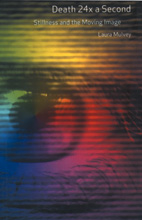
the digital gift of death
As DVD releases continue the vast rollout of the 20th century’s image history, Laura Mulvey begins her new book with the idea that cinema can be seen as increasingly peopled by spectres. Increasingly we watch characters on screen played by deceased stars and see films by seminal directors whose collected works are being re-born into digital life after they are themselves long gone. Celluloid itself is fast facing extinction; hence ‘cinema’ in its century-long incarnation is dead or dying. From these ashes Mulvey describes the ramifications of new ways of watching and conceiving films since the advent of domestic VCRs, a process intensified by DVD. Dead film meets new technology, “bringing, almost incidentally, new life to the cinema and its history.”
More precisely and theoretically, Mulvey is very interested in the way the new technologies enable and even encourage the remote control-wielding viewer to see figurative death in the form of the still or slowed image extricated from narrative movement. Replaying sequences and freeze-framing particular shots, for Mulvey, enable a significant re-making of the film away from its original organisation towards a more malleable, stretched and fragmented form that opens up a new engagement with “the presence of death.”
The new viewer-image relationship in this analysis enhances our perception of cinema’s rendering of the irrational and the pre-modern. This opens the way for Freud to be introduced into the story, a theoretical commitment Mulvey has maintained since the 1970s despite the extensive critiques of psychoanalytic theory in Film Studies over the last two decades. She starts with a telling early 20th century opposition that she suggests comes tellingly unstuck in the 21st: while Freud himself was dubious about cinema for celebrating modernity’s “novelty, speed and glamour”, to present-day eyes “the cinema [now] seems closer to Freud’s uncanny of the old and familiar, and … the archaic.”
back to the archaic
A chapter on Hitchcock’s Pyscho (1960) overcomes the reader’s initial we’ve-been-here-before scepticism serving well Mulvey’s argument that cinema’s predilection for irrationality, the archaic and death is all the more noticeable for the 21st century viewer. Treated as aesthetically ‘modern’ compared to Hitchcock’s previous melodramatic and theatrical presentation of murder, the famous shower scene’s primary importance here is in conceptually killing off the fashionable, sexualised female body, and hence the modernity Freud dismissed, instead enforcing the ‘dead’ body of the mother whose archaic psychic power persists beyond death. Mulvey therefore emphasizes at length the elaborate post-murder camera manoeuvre—from the modern woman’s naked body, accoutrements (and money) in the motel room, up to the old house—as inaugurating a circular movement away from civilisation’s straight lines and linearity seen earlier (notably with the highway sequence), back into primal darkness.
The connection with post-celluloid technology is then addressed via a discussion of Douglas Gordon’s art installation 24-Hour Psycho (in which the original film is ‘stretched’ over 24 hours), illustrating how the trajectory away from movement and towards death is made all the more palpable when the film’s narrative momentum is subverted. The point is fair, and Psycho shows the trajectory as already present in the original; nevertheless, the vast majority of viewers are still likely to first watch feature films at home, not in galleries, in real time and linear form.
Roberto Rossellini’s Journey to Italy (1953) proves almost equally viable for discussing cinema’s tendency towards death and the archaic. However I think Mulvey (like many leading film scholars) overstresses the generative tension caused here by confused Hollywood actors in a relatively ‘plotless’ European art film. The ancient religious rituals practiced by people of the Pompeii area in which the film is set are presented as having a magical, positive effect on the ennui-ridden bourgeois couple so that the reconciliatory final kiss is justified as Hollywood and the folkloric coming together. The turn to religion and ritual at the heart of what is claimed here as “the first modern film”, suggests a reactionary or escapist strain in the fascination with the archaic, irrespective of the ills of a jaded modernity.
outside the narrative
A chapter on the seminal contemporary art cinema of Abbas Kiarostami develops the idea of film as proffering epistemological doubt and non-narrative interest. This is refreshingly argued without the mystical and ethically affirmational interpretations of the Iranian master’s work favoured by many western critics. A discussion of his ‘Koker trilogy’ (1987-94) emphasises the increasingly reflexive nature of the films through which Mulvey seeks to expound cinema’s tendency towards the labyrinthine . She then sees the reflexivity of the video coda of Taste of Cherry (1996) as providing an elegy for cinema (the rest of the film is 35mm) at its centennial ‘death’ while also offering “a possible resurrection and return, phoenix-like, from the ashes.” Though a familiar reading, her analysis is less romantic and willful than most in concluding with a point apposite for the book’s argument about video re-activating cinema as a death-inscribing form—Kiarostami’s fond backward glance, she suggests, reflexively dramatises a “dead love.”
re-thinking the gaze
Mulvey eventually comes face-to-face with her own hugely influential 1970s thesis of the gaze, encouraged then by classical Hollywood cinema and reconsiders it in the wake of the viewer’s new agency where she says subjectivity, gender and ideology are less prescriptive. The radically reconfigured cinema and viewing relations Mulvey advocated back then (broadly, politically informed avant garde cinema) she now suggests have, in a different sense, come about not through the ‘content’ of the films but as a result of their new carrier medium. Thirty years ago Mulvey was criticized by many for being too deterministic in her denigration of Hollywood cinema’s spectatorial regime; perhaps now she is rather too uncritically invested in the liberating potential of the new technologies.
At its most pragmatic, the book’s argument is based on the idea that the democratizing of control over the image enables and encourages amateur textual analysis, which is thereby returned to “its origins as a work of cinephilia” rather than as an elite academic enterprise. Mulvey elaborates on this by showing how slow motion and freeze-frame allow an unprecedented essaying of every frame and editing correlation in a scene from Douglas Sirk’s Imitation of Life (1959), effectively disabling protagonists, story and movement as central to classical narrative film; for example, extras at the edges of the quickly moving frame previously impossible to see are now thematically telling. This emphasis on stilled and repeated “fragments” and “tableaux” pushes cinema towards an “extra diegetic mode of address”, all encouraged by the technical control enabled by DVD and the medium’s breaking of movies down into ‘chapters.’
a new revolution
Mulvey’s argument asserts a new viewer-film relationship—a technical, hermeneutic and sensual access to films in all their aesthetic minutiae—rather than cinema per se, which has always contained such elements even if shrouded by narrative action and linearity. This allows a newly multi-dimensional understanding of “the internal world of cinema.” Taken as a whole, the book effectively, if idealistically, essays this newly empowered gaze as a revolution in our knowledge of the increasingly important image world she says is equivalent to 19th century photography transforming “the human eye’s perception of the world.”
Laura Mulvey, Death 24x a Second, Reaktion Books, London, 2006, ISBN 10: 1 86819 263 2
RealTime issue #77 Feb-March 2007 pg. 16
IN QUEER SCREEN’S 2007 MARDI GRAS FILM FESTIVAL, GERMAN WRITER AXEL SCHOCK WILL APPEAR AT QUEER KINO: A HISTORY OF QUEER GERMAN CINEMA. IN THAT PROGRAM SCHOCK WILL SHOW OUT IM KINO, A 110 MINUTE DOCUMENTARY HE’S MADE WITH MANUELA KAY TRACING THE PATTERNS OF GAY FILMMAKING FOR OVER 100 YEARS FROM EARLY CLASSICS TO HOLLYWOOD AND THE NEWEST GENERATION OF GAY FILMMAKERS.
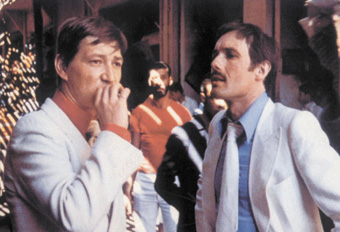
Fox and his Friends
A magazine and newspaper writer, Schock has collaborated on fun publications (in German) like The Queer Quiz Book (eg “Who was allowed to shave kd lang for the cover of Vanity Fair?”), Out! 800 Famous Lesbians, Gays & Bisexuals; Out Takes: The Encyclopedia of Lesbian and Gay Useless Knowledge, and, more to the point here, Out in the Cinema: the Lesbian & Gay Film Encyclopedia. Doubtless Schock’s film will combine serious study of this history with an apt embrace of both the high and low cultural dimensions central to gay film.
The Queer Kino program of eight films includes one regarded to be the first gay feature, a drama about a concert pianist in love and blackmailed, Different from the Others (director Richard Oswald, 1919, 50 mins). The film was destroyed by the Nazis but a copy was found in 1976. Carl Dreyer’s 1924 classic, Michael (79 mins), also about an artist and lost love, and possibly based on Rodin will also be screened.
There’s epic lesbian campery in the shape of Madame X: An Absolute Ruler (1977, 141 mins, Ulrike Ottinger). Possibly a nice antidote to Pirates of the Caribbean male antics, “Madame X, the irresistibly cruel and uncrowned pirate ruler of the China Seas, lures women away from their ordinary lives to gather aboard the ship Orlando for adventures at sea…Yvonne Rainer plays an artist, while underground icon Tabea Blumenschein tackles both the spike-fisted dominatrix queen and the ship’s leather-clad figurehead.”
Rainer Werner Fassbinder’s Fox and his Friends (1975, 117 mins) makes a rare cinema appearance (the Fassbinder oeuvre is to be released on DVD here) and a rare feature role for the writer-director himself in a tale of spiralling class, financial and sexual betrayal. The film was once called “The Blue Angel done in drag” and has sometimes been regarded as homophobic, but its complexity belies the charge. It’s certainly one of Fassbinder’s classiest looking films with cinematography by Michael Ballhaus (who has since worked extensively with Scorsese) and should be a real treat on the big screen.
Another rarity is Coming Out (Heiner Carow, 1989, 110 mins) regarded to be the first East German gay film, and the last because the Wall came down shortly after the film’s making. A young man represses his attraction to his best friend, finds love with a woman, but a journey into the gay underground…
The Oswald, Dreyer and Fassbinder features and Shock’s documentary history collectively make Queer Kino a seriously attractive proposition. It’ll be interesting to see if Shock’s encyclopaedic vision will put the German films in context. RT
Queer Kino: A History of Queer German Cinema, Chauvel Cinema, Mardi Gras Film Festival and Goethe Institut, Feb 15-March 1, www.queerscreen.com.au
RealTime issue #77 Feb-March 2007 pg. 20


















 write/here project curated by
write/here project curated by

























































 THIS IS FABULOUS MUSIC, WONDERFULLY PERFORMED. THE WAY OF THE SEEKER IS A MONUMENTAL ACHIEVEMENT, NOT ONLY IN ITS SCALE AND POWER, BUT PERHAPS ALSO MONUMENTAL IN A LITERAL SENSE. IT CAN BE SEEN AS A QUASI-AUTOBIOGRAPHICAL STATEMENT FROM COMPOSER LARRY SITSKY, A MAJOR FIGURE IN AUSTRALIAN CONTEMPORARY MUSIC FOR HALF A CENTURY, AND HE LAYS HIS MUSICAL SENSIBILITY BEFORE US.
THIS IS FABULOUS MUSIC, WONDERFULLY PERFORMED. THE WAY OF THE SEEKER IS A MONUMENTAL ACHIEVEMENT, NOT ONLY IN ITS SCALE AND POWER, BUT PERHAPS ALSO MONUMENTAL IN A LITERAL SENSE. IT CAN BE SEEN AS A QUASI-AUTOBIOGRAPHICAL STATEMENT FROM COMPOSER LARRY SITSKY, A MAJOR FIGURE IN AUSTRALIAN CONTEMPORARY MUSIC FOR HALF A CENTURY, AND HE LAYS HIS MUSICAL SENSIBILITY BEFORE US.

























































